

MIM/PIM FEEDSTOCKS
• At RYER, all our feedstocks are manufactured to the highest level of quality, with excellent batch-to-batch repeatability.
• RYER is the ONLY commercially available feedstock manufacturer to offer all five debind methods.
• RYER offers the largest material selections of any commercially available feedstock manufacturer.
• RYER offers technical support for feedstock selection, injection molding, debinding and sintering.


CataMIM®
• A direct replacement for all current commercially available catalytic debind feedstocks
• Improved flow
• Stronger green and brown parts
• More materials available and better surface finish
• Custom scale-up factors available
• Faster cycle times
• 65°C / 150°F mold temperature
AquaMIM®
• Water Debind
• Custom scale-up factors available
• Large selection of available materials
SolvMIM®
• Solvent, Super Critical Fluid Extraction (SFE) or Thermal Debind methods
• Hundreds of materials available
• Custom scale-up factors available
Publisher & Editorial Offices
Inovar Communications Ltd

11 Park Plaza
Battlefield Enterprise Park
Shrewsbury SY1 3AF
United Kingdom
Tel: +44 (0)1743 469909 www.pim-international.com
Managing Director & Editor
Nick Williams nick@inovar-communications.com
Group News Editor
Paul Whittaker paul@inovar-communications.com
Deputy Editor
Emily-Jo Hopson-VandenBos emily-jo@inovar-communications.com
Assistant Editor
Charlie Hopson-VandenBos charlie@inovar-communications.com
Advertising Sales Director
Jon Craxford, Advertising Sales Director
Tel: +44 (0)207 1939 749 jon@inovar-communications.com
Digital Marketer
Swetha Akshita swetha@inovar-communications.com
Production Manager
Hugo Ribeiro hugo@inovar-communications.com
Consulting Editors
Prof Randall M German
Former Professor of Mechanical Engineering, San Diego State University, USA
Dr Yoshiyuki Kato
Kato Professional Engineer Office, Yokohama, Japan
Professor Dr Frank Petzoldt
Ingenieurbüro Dr. Petzoldt, Geestland, Germany
Dr David Whittaker
DWA Consulting, Wolverhampton, UK
Bernard Williams Consultant, Shrewsbury, UK
Subscriptions
Powder Injection Moulding International is published on a quarterly basis as either a free digital publication or via a paid print subscription. The annual print subscription charge for four issues is £150 including shipping.

Accuracy of contents
Whilst every effort has been made to ensure the accuracy of the information in this publication, the publisher accepts no responsibility for errors or omissions or for any consequences arising there from. Inovar Communications Ltd cannot be held responsible for views or claims expressed by contributors or advertisers, which are not necessarily those of the publisher.
Advertisements
Although all advertising material is expected to conform to ethical standards, inclusion in this publication does not constitute a guarantee or endorsement of the quality or value of such product or of the claims made by its manufacturer.
Reproduction, storage and usage
Single photocopies of articles may be made for personal use in accordance with national copyright laws. All rights reserved. Except as outlined above, no part of this publication may be reproduced or transmitted in any form or by any means, electronic, photocopying or otherwise, without prior permission of the publisher and copyright owner.
Design and production
Inovar Communications Ltd.

ISSN 2050-9693 (Print edition)
ISSN 2050-9707 (Online edition)
© 2022 Inovar Communications Ltd.
GETPDF
For the MIM, CIM and sinter-based AM industries
Binder Jetting: The race is on, but there’s a lot to do
I recently posted on LinkedIn about the evolving Binder Jetting industry. The question that I led with was “Is the metal Binder Jetting race finally on?” This was in response to two industrial powerhouses of manufacturing, GE and HP, finally confirming the commercial release of their new machines after a long beta phase.
There are now some impressive runners lined up, all with machines ready to order. GE Additive and HP join a field that includes Desktop Metal (incorporating ExOne), and Markforged (having acquired Digital Metal). And more are to come, with the likes of Ricoh watching developments whilst evolving its own technology. In reality, a smaller race has been running for some time – but now that the field is expanded, the starting pistol can be considered fired.
But what was revealed in the lively discussions that followed my post was something that doesn’t seem to be talked about enough: the importance of sintering. Whilst all those who engaged with the post had some level of interest in Binder Jetting, the huge variability in knowledge of debinding and sintering, and what kind of parts can be delivered, exposes the reality that, for newcomers to the science of sintering, a lot of learning is necessary.
Creating high-quality sintered parts at volume is as much about the debinding and sintering process as it is about the forming process itself. No longer can you rely on the composition of your starting powder to guarantee the metallurgy of your final parts – debind and sinter parts well and you can get truly amazing results, but do it badly and the metallurgy of your part won’t even pass muster as a paperweight.
Nick Williams Managing Director & EditorCover image
HP collaborated with Schneider Electric and GKN Additive (Forecast 3D) to produce a new filter using HP Metal Jet technology (Courtesy Schneider Electric)

The Shop System™
Now offering an expanded lineup of the world’s best-selling metal binder jet machine
Shop System
The original plug-and-play solution from Desktop Metal to get started 3D printing metal parts fast - no prior binder jetting experience required
Everything you need at an affordable price. Intuitive software drives a complete system, from 3D printer and depowdering station to an industrial-grade furnace
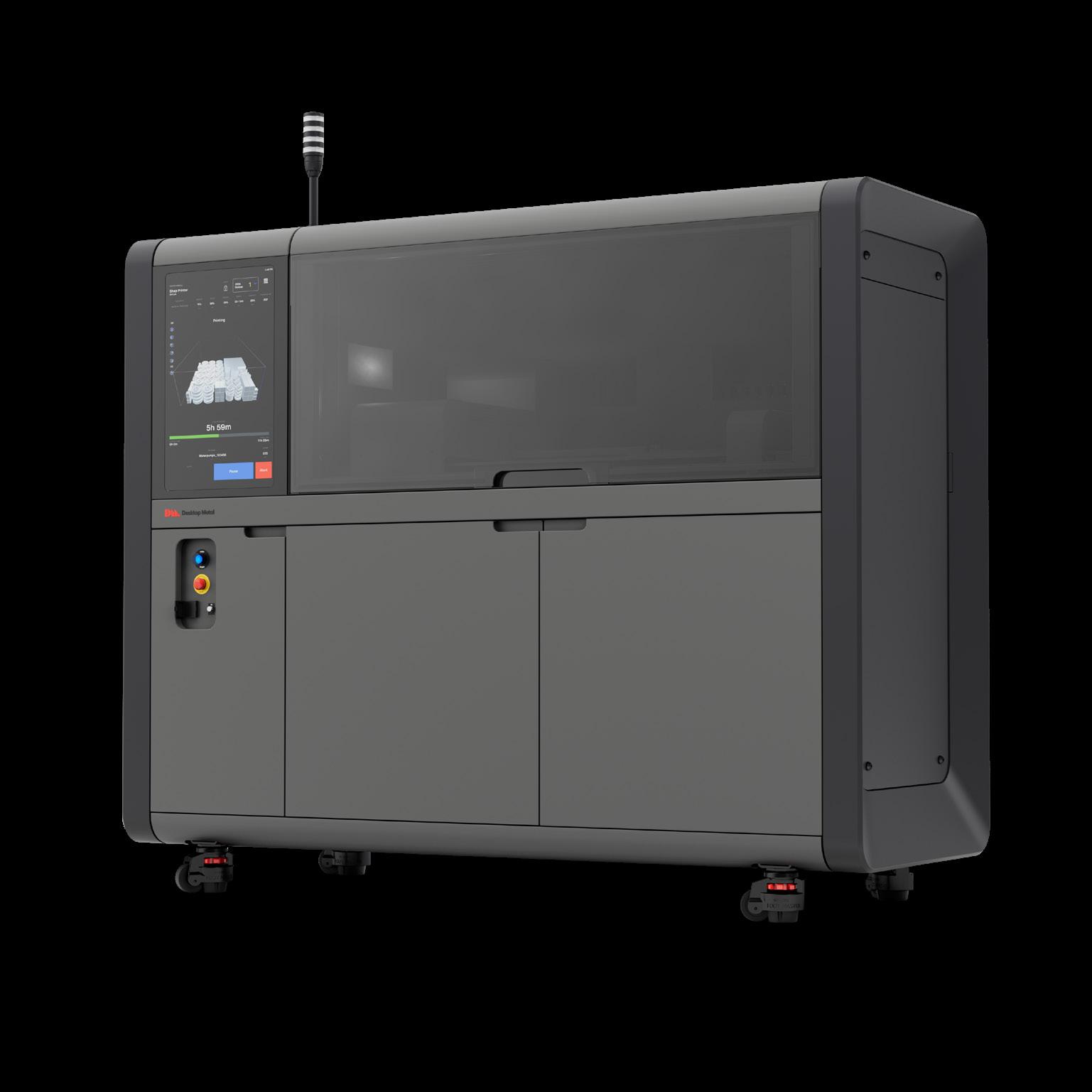
Shop System+
A more economic solution for high-power customers to reduce operating costs with locked in discounts on DM powder and binders
Lower the cost of additive operations and improve part costs to drive faster ROI with the same plug-and-play experience and materials as the base package
Shop System Pro
A more flexible solution for customers with powder metallurgy experience that unlocks custom printing and sintering process parameters
Expand beyond DM-supplied alloys to new applications or reduce operating costs through the use of third-party or proprietary powders
Learn more by downloading the Shop System specifications teamdm.com/ShopPackages
55 Global Markets for Metal Injection Moulding: Data and insight from World PM2022 and beyond


How has the global Metal Injection Moulding industry weathered the most turbulent years in recent history, and what has the impact been on MIM’s key markets worldwide?
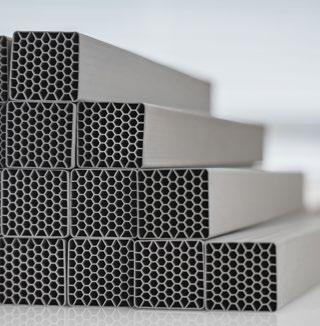
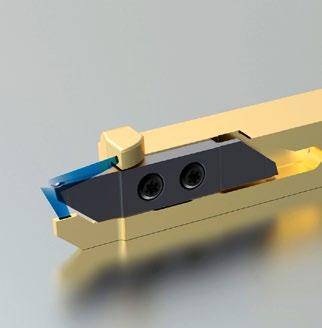

In this overview, PIM International’s Nick Williams reports on market data presented at World PM2022, the first Powder Metallurgy World Congress since the COVID pandemic, held in Lyon, France from October 9-13.
This is supplemented by other available data sources and insight from conversations with industry leaders at the event. >>>

65 HP Metal Jet: Growing momentum and new applications as Binder Jetting comes of age
HP’s Metal Jet has undergone significant refinement in the years since it was first unveiled in 2018. Now, by incorporating nearly the whole Binder Jetting workflow in one solution, HP hopes that the Metal Jet S100 – commercially launched at IMTS 2022 and showcased at Formnext 2022 – will tempt the wider manufacturing community into the world of AM.

As Binder Jetting’s evolution moves from the intricacies of process optimisation to real application development and growth, Emily-Jo Hopson-VandenBos reports on a recent visit to HP’s Barcelona 3D Printing campus and the company’s progress and growing momentum since 2018. >>>
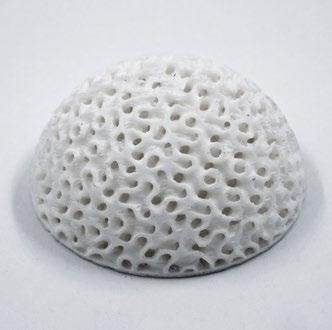
The future has arrived
The DMP/PRO is here: a fast, accurate and versatile 3D printer that uses binder jetting technology, enabling volume production of everything from industrial components to medical and consumer products.
•Groundbreaking 3D printhead
70,400 print nozzles ejecting 2 pL droplets, delivering speed and precision.
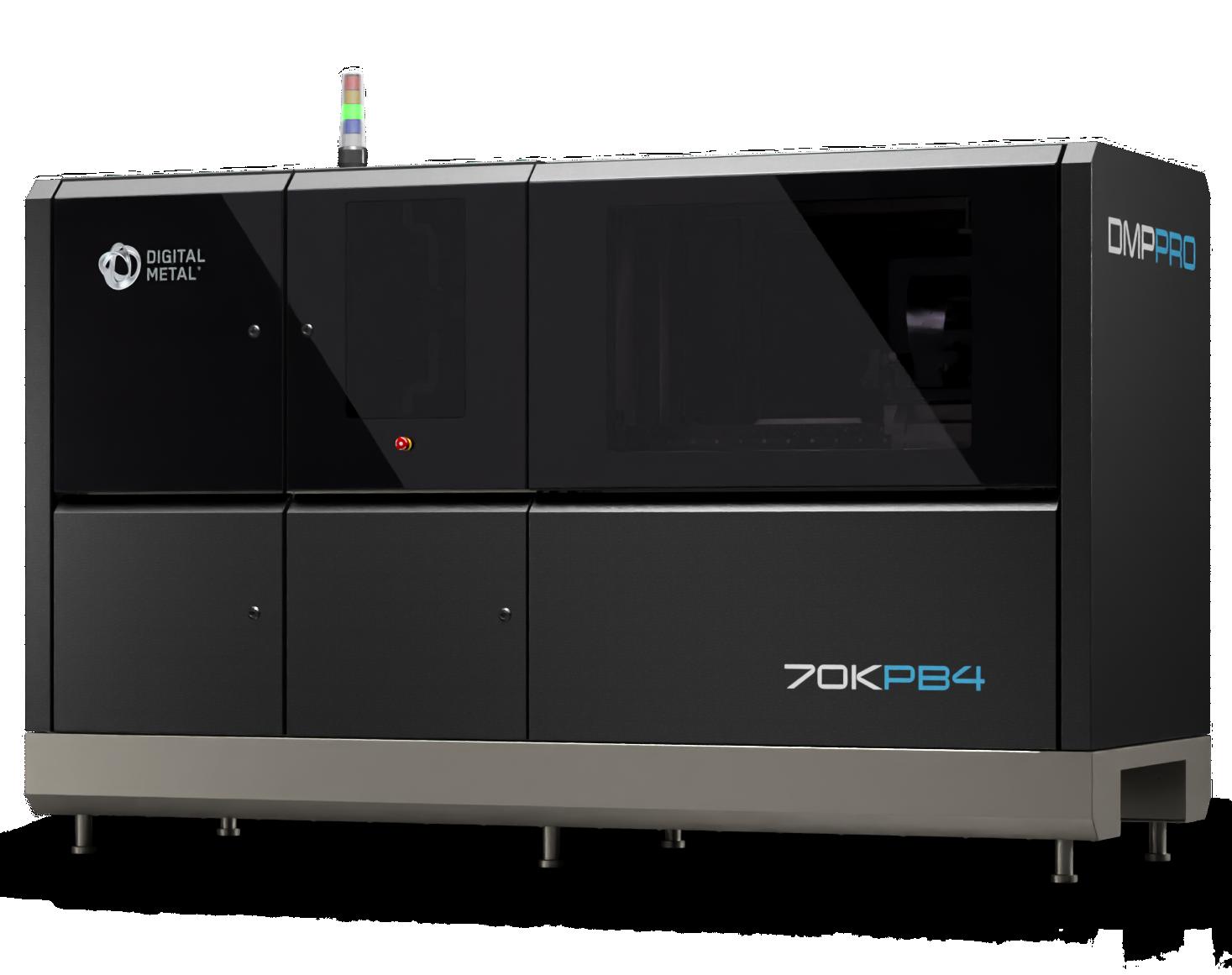
•Repeatable and reliable

Linear motors, air bearings stable, and robust diabase platform for high accuracy and tight tolerances.
•High productivity
Capable of printing 1,000 cm3 per hour and managed via a custom-built software platform, the DMP/PRO is designed for unbeatable productivity.
Check out all the benefits at digitalmetal.tech/dmppro
79 Sintex: Exploring the full flexibility of metal powder-based processes for corrosion-resistant applications
Founded as a press and sinter PM parts maker, Denmark’s Sintex has proactivity in its DNA. Having establishing itself in this field, the company initially expanded into MIM in order to meet customer demand for more complex geometries. In recent years, to be able to meet the need for mass customisation, it has explored metal Binder Jetting. In addition, custom alloys have been optimised for applications that require excellent corrosion resistance.
Peter Kjeldsteen, Peter Valler and Poul Søgaard offer insight into the history and future of innovation within the company. >>>
85 Tritone’s MoldJet: The definition-defying AM technology advancing steadily toward commercialisation
Tritone’s MoldJet is unique as an Additive Manufacturing process – not Binder Jetting, Material Extrusion, nor Material Jetting, the MoldJet process involves a number of steps that share features with common sinter-based AM technologies, but don’t quite fall under their definitions. But this isn’t simply a novel fringe technology: Tritone’s founders have drawn on extensive experience within Israel’s 2D and 3D printing ecosystem to build a robust AM platform that is very simple, yet highly sophisticated.
Joseph Kowen visited Tritone and here reports on the MoldJet process and its potential applications. >>>
Regular features...
123 Advertisers’ index & buyer’s guide
Discover the leading suppliers of materials and equipment for MIM, CIM and sinter-based AM, as well as part manufacturing partners and more. >>>
126 Events guide
View a list of upcoming events for the MIM, CIM & sinter-based AM industries. >>>
95 The metal powder-based processing of titanium: MIM and AM-related highlights from the PMTi2022 conference

Since the very first PM Titanium conference in Brisbane, Australia, in 2011, the PMTi series has been the essential meeting point where technical and commercial advances in the powder-based production of titanium parts are discussed. Encompassing production technologies from Metal Injection Moulding to Additive Manufacturing, this year’s event was no different. As Dr Thomas Ebel reports, the technologies involved have moved significantly towards production readiness, but with the ever-present playoff of non-negotiable performance goals against the drive to reduce cost. >>>
117 Opening the door to MIM parts: A case study on the conversion of die cast door hinges
Die casting is a widely used process for the production of Metal Injection Moulding-sized parts, but its application is typically for components with lower strength requirements. When the mechanical performance specifications for a die cast component increase, opportunities arise for alternative processes such as MIM to step in. In this case study, Ecrimesa’s Manuel Caballero reviews such a conversion process in which a zinc die cast hinge set is redesigned for production by MIM in 316L stainless steel in order to significantly improve mechanical properties. >>>



Industry News
AFT celebrates over 180 million MIM automotive turbocharger vanes
AFT, based in Rétság, Hungary, a member of ARC Group Worldwide, recently celebrated the production of 183 million turbocharger vanes manufactured using its Metal Injection Moulding technology. AFT has produced these parts since the company was first established in 2001, and recognises MIM as the key to its success.
Built for its customer Garrett Motion, a global manufacturer of turbocharger systems, the turbo vanes are used in turbochargers destined for final customers such as Audi, Hyundai, Kia and Volkswagen. The turbocharger vanes must be able to withstand operating temperatures of 600–800ºC, as well as be able to function at -30ºC. To meet these
AFT utilises Metal Injection Moulding to make parts such as turbo vanes for the automotive industry (Courtesy AFT)
specifications, the vanes are made from HK30 steel alloy. In addition to the speed of production offered by MIM, the use of this process is also a benefit in its ability to manufacture with minimal material loss.
As well as turbocharger components, AFT’s MIM facility also manufactures other automotive components such as parts for fuel
BASF releases new Catamold THOR feedstock for Metal Injection Moulding
BASF SE, Ludwigshafen, Germany, has added a new material to its Catamold® feedstock range for Metal Injection Moulding. Called THOR, this new material addition is a maraging ultra-high strength steel suited for parts that require the combination of strength and ductility/toughness.
Target applications include MIM hinges and other high-performance structural applications. MIM hinges are seeing widespread adoption in the consumer electronics industry, in particular for laptops and folding smartphones, where the unique combination of component complexity, high production volumes
injectors and sensors. The final customers of these parts include brands such as Caterpillar, BMW, Citroën, Ford and Tesla. Utilising Metal Injection Moulding, these parts can be produced 20% cheaper – on average – than with precision casting, which represents a very serious price advantage, explains AFT.
www.afthungary.com
and demanding tolerances play into MIM technology’s strengths.
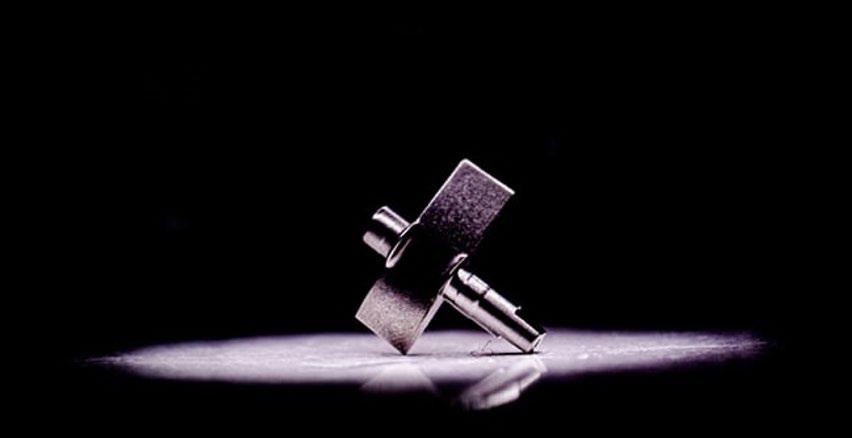

Typical properties of heat-treated parts are given as: density 7.7 g/cm 3 , yield strength RpO.2 1600 MPa, ultimate tensile strength Rm 1850 MPa, elongation A10 5%, and hardness 51 HRC or 530 HV10.
It is expected that Catamold THOR – which stands for Tough, Hard, Oriented, Resistant – will continue to drive the adoption of MIM into increasingly demanding applications.
www.catamold.com

Ecrimesa announces new US Metal Injection Moulding operation Mimecri
Ecrimesa Group, based in Santander, Spain, has announced that it will be opening a new Metal Injection Moulding facility in the USA. Operating with a new brand, Mimecri USA LLC, the 2,300 m 2 facility will be located in Thomasville, Georgia, USA. This announcement follows the company’s strong recent growth trajectory, coming after the expansion of the company’s MIM operations in Spain.
Mimecrisa, the Group’s Spain-based Metal Injection Moulding business, is one of Europe’s largest and oldest MIM operations. Mimecrisa was the first MIM producer in the world to install a continuous debinding and
sintering furnace in the 1990s and today the company is recognised in particular for its ability to produce components that push at the upper limits of MIM’s size range.
Through Mimecri USA, the Ecrimesa Group will focus on serving US customers and further expanding its presence in the region. The Thomasville facility is expected to be fully operational in summer 2023.
Eduardo Valenzuela, Head of International Market, Ecrimesa, stated, “We are excited about this wonderful project, a great milestone for our company.”
www.ecrimesagroup.com
Gasbarre expansion to triple size of its St Marys facility
Gasbarre Products Inc is reported to be expanding its facility in St Marys, Pennsylvania, USA, with an investment of some $5.8 million. The company has leased a 14,000 m 2 facility in St Marys, which will triple the size of its current location and create sixteen new jobs, while retaining its 156 employees across four locations statewide. Gasbarre also plans to relocate operations from Plymouth, Michigan, to the expanded facility.
As part of its expansion project, the company has committed to creating new jobs at its St Marys facility within three years.
CeramTec plans extension at Marktredwitz manufacturing facility
“Our investment in the new facility in St Marys provides an opportunity for Gasbarre to continue to grow and flourish where we have manufactured for nearly fifty years,” stated Alex Gasbarre, CEO. “The work ethic and skills provided by past, current, and future Gasbarre team members provide a strong base for this move. We look forward to adding new team members in the coming months when the move process is completed. The people of Elk County and St. Marys will be key to our success.”
www.gasbarre.com
Japan’s Micro MIM expands EU base
Micro MIM Japan Holdings Inc., headquartered in Osaka, Japan, has expanded its presence in Europe with the formation of Micro MIM Europe GmbH, located in Düsseldorf, Germany. The new subsidiary is said to represent an upgrade and expansion of the company’s regional office in Offenburg, Germany.
By establishing Micro MIM Europe and expanding the team, the company aims to better serve its customers in Europe and North America. Micro MIM Europe’s CEO, Hideaki Tanaka, also expressed plans for the company to further expand in these regions, bringing its micro MIM technology to a wider market.
www.micro-mim.eu
CeramTec GmbH, headquartered in Plochingen, Germany, has announced plans to expand its manufacturing facility in the Bavarian town of Marktredwitz. The development is set to include a further production hall and, subject to official approval, the company hopes to begin construction in 2023.
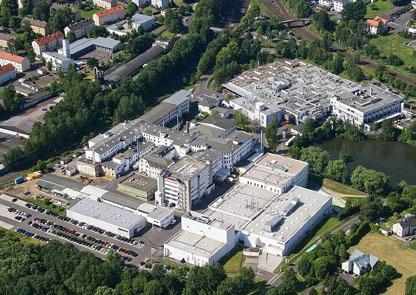
“Our well-filled order books make it necessary for us to expand capacities,” stated Dr Hadi Saleh, Chief Executive Officer. “At the Marktredwitz site, we have already been able to count on an extremely reliable and sustainable network of employees and partners in the past. We are therefore pleased to be able to further expand our presence in Marktredwitz and thus also play an even more important role as an employer in the region in the future.”
The new building is to be designed with a focus on sustainability. “In the CeramTec Group, we introduced measures for an even more conscious use of energy some time ago and have already implemented various projects and measures. The new building offers us excellent opportunities to produce even more energy-efficiently and sustainably in the future and thus make an important contribution to the energy transition in Germany,” added Dr Saleh.
www.ceramtec-group.com
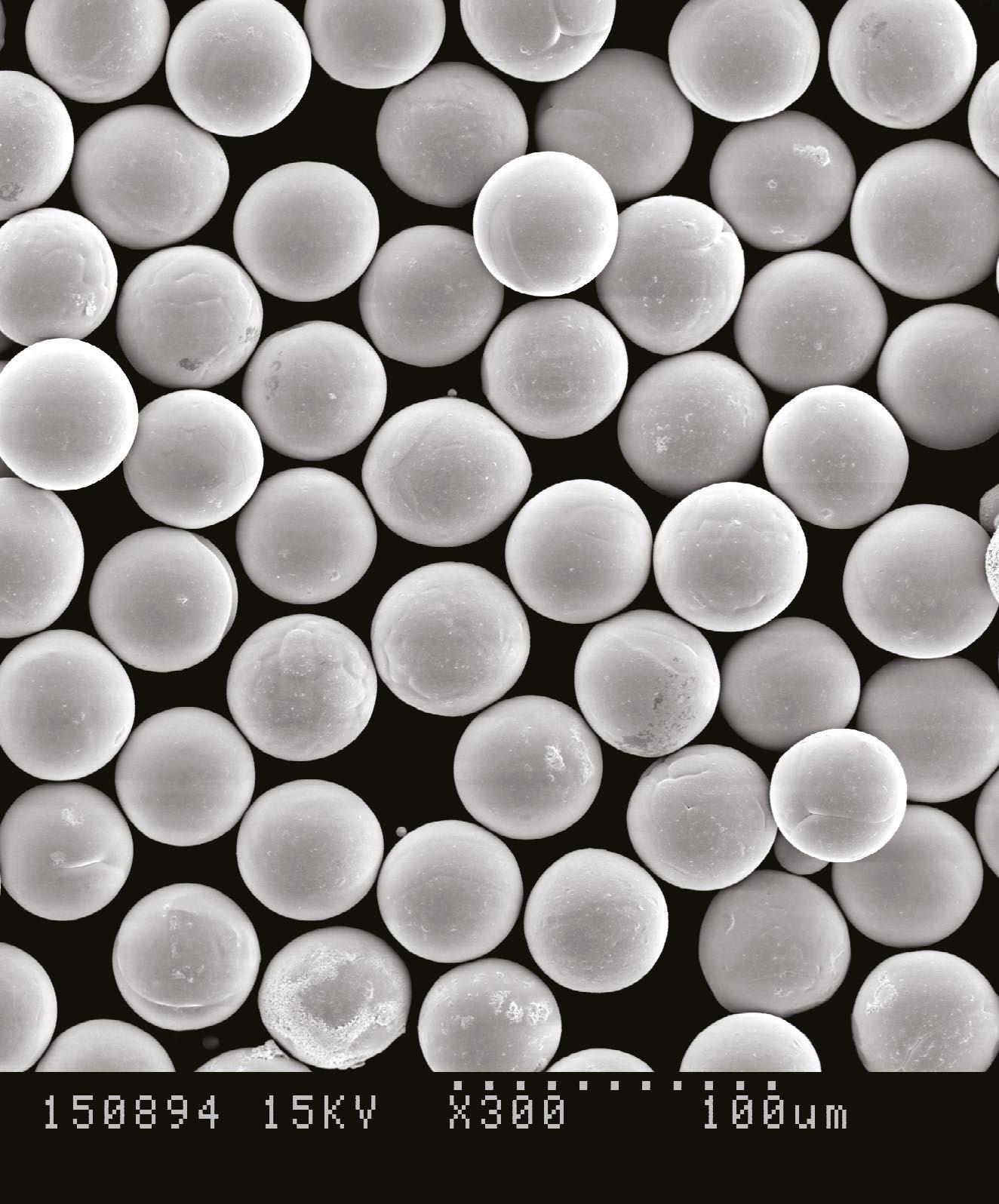

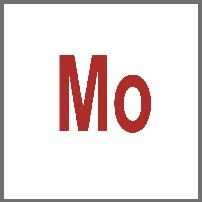





Quality, Experience and Customer Relationships
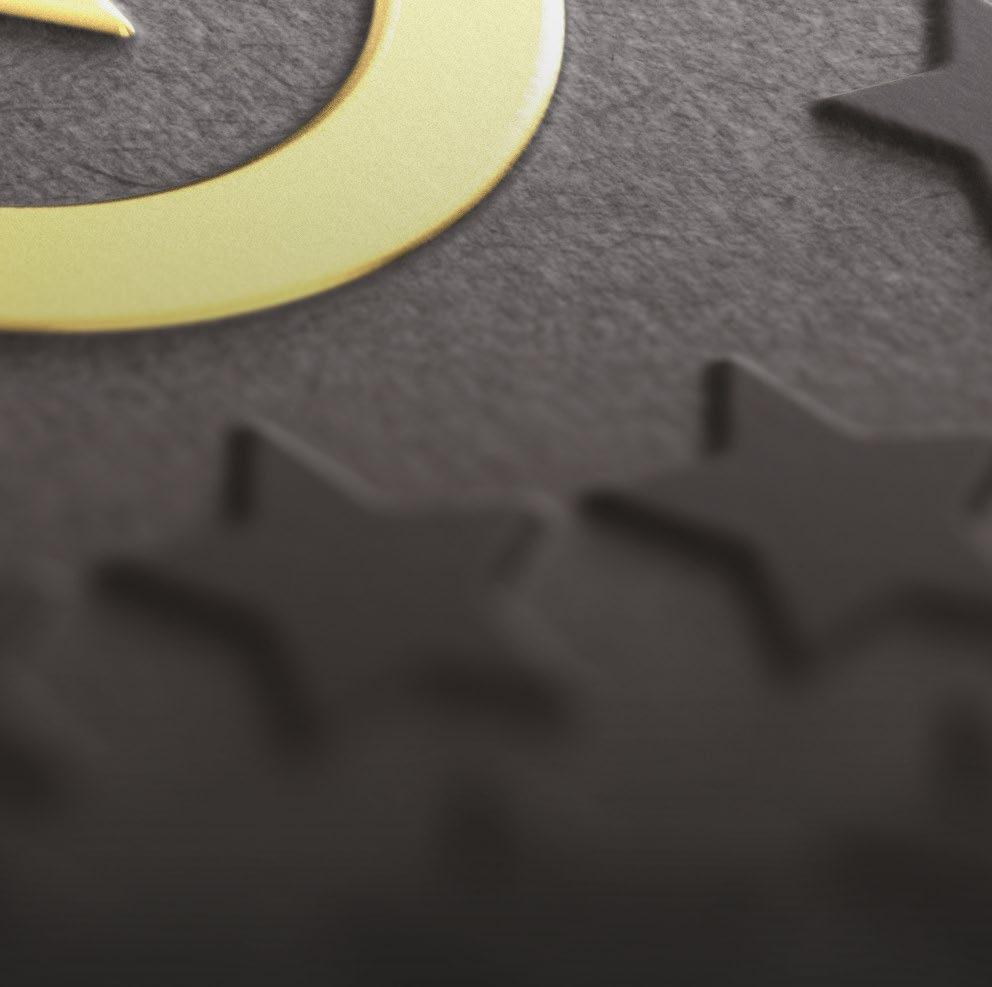
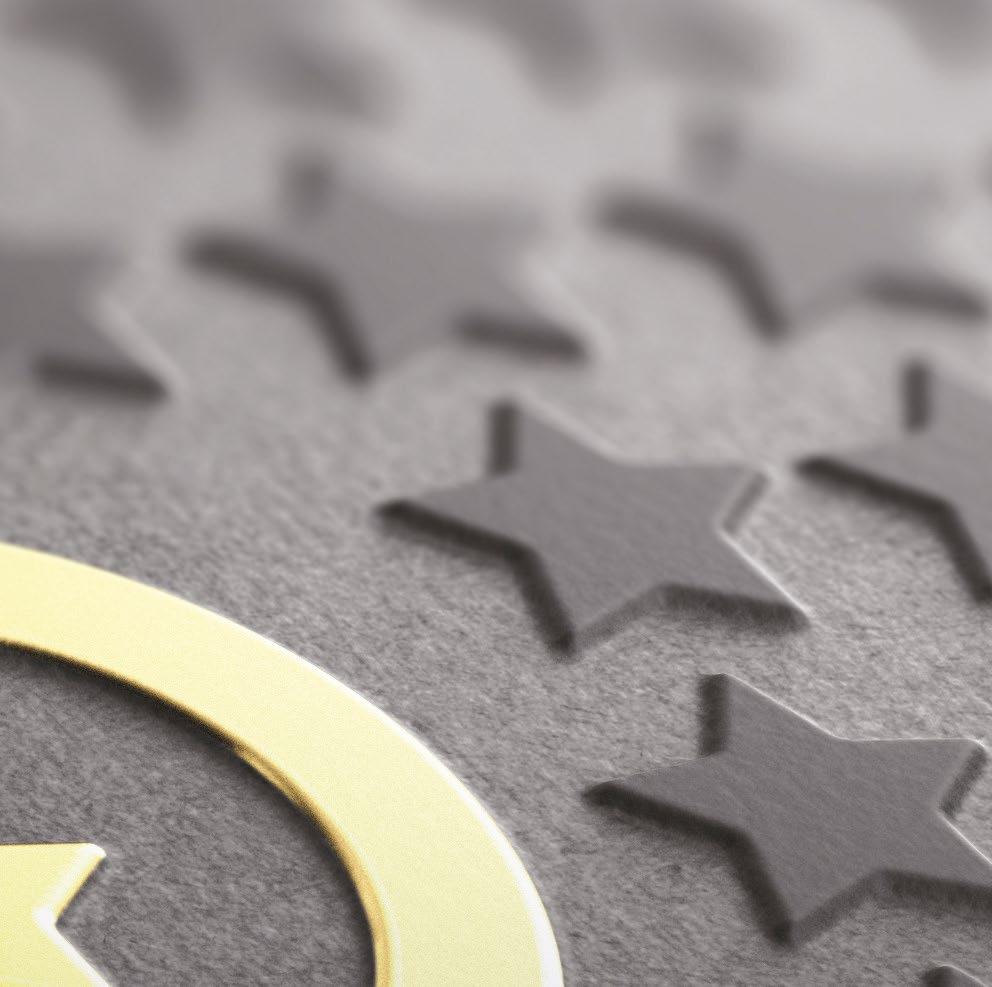

Elnik’s innovations and experiences in all areas of temperature and atmosphere management have led us to become the leaders for the Batch-based Debind and Sinter equipment industry. We have applied these core competencies across a wide variety of industries through our 50 year history and look forward to the emergence of new technologies that will continue to drive demand for new innovative products.

We offer:
First Stage Debind Equipment (Catalytic, Solvent, Water)
Debind & Sinter Furnaces (All Metal or Graphite)


Elnik’s experienced team is driven to be the only partner you need for all your MIM and Metal AM equipment for 2022 and beyond.

We are driven by these values.
GE Additive introduces its Binder Jet Line AM solution
GE Additive has announced more details of its much-anticipated Binder Jet Line and Series 3 AM machine. With production deliveries expected to begin in the second half of 2023, the release of the machine follows a four-year phase of customer discovery, collaboration and testing in an effort to ensure that the system is ready for high-volume, serial production environments.

The Binder Jet Line Series 3 is said to be capable of producing small or large complex parts repeatably and reliably using Binder Jetting (BJT) Additive Manufacturing, with material properties that exceed casting equivalents, and can achieve through-hole diameters and wall thicknesses less than 500 μm.
According to the company, its Binder Jet technology has proven the ability to successfully produce large parts which meet dimensional and feature resolution tolerances for production, with demonstrated capability in (but not limited to) parts up to 25 kg in stainless steel, and no known limitations on maximum wall thickness.
The Binder Jet Line also enables the user to depowder intricate parts without damaging fine features. Parts can be sintered within desired tolerances, enabled in part by GE Additive’s Amp™ software’s distortion prediction and compensation capability.
Manufacturing cost
Production $/cm 3 produced is said to be a critical driver of the Binder Jet Line’s development. The further the cost of a final part can be driven down, the more application space is available for the technology.
Part of this calculation includes cost comparison against conventional manufacturing technologies, in terms of tolerances and cost, from incoming raw material, to the final part in hand, therefore taking into account the total cost of ownership –not just the cost of the BJT machine.
Cost-efficiency benefits include less spent on raw materials by recycling unused powder and using less expensive materials compared to other powder bed technologies. The system also enables the utilisation of the entire build box, top to bottom, edge to edge, with no need for supports.
Developed in partnership with GE Additive customers
During the Binder Jet Line’s fouryear development period, a group of strategic partners have contributed to the development of GE Additive’s BJT technology.
Speaking on this strategy, Brian Birkmeyer, product line leader for Binder Jet at GE Additive, stated, “During the Series 3 and Binder Jet Line’s development phase, we sought out customers who could
give us honest, real-world insights from their high-volume manufacturing environments. We have taken their insights to complement our hands-on knowledge and experience of scaling additive production.”
“The result,” he concluded, “is a modern, modular industrialised additive system – developed by additive users, for additive users –that delivers quality parts, at cost, at scale, and safely.”

Scalable Additive Manufacturing
Based on the input from customers and partners, GE Additive focused on enabling the eventual deployment of installations comprising fleets of forty to fifty to 100+ machines, which it believes will drive repeatable process quality.
The Binder Jet Line can also be installed and operated without hazard zoning required and has been designed for minimal operator contact with the machine and metal powders. The machine will be UL-listed and CE-certified, has a 100% inert and sealed environment, a fully closed-loop powder-free exposure, and is designed for compatibility with reactive and flammable powder and binders.
Other safety benefits include a fully independent and real-time safety system on board, constantly monitoring machine conditions, and real-time OPC UA data streaming for integration into factory MES and safety systems.
www.ge.com/additive
Equispheres launches NExP-1 non-explosible aluminium feedstock
Equispheres, Inc, Ottawa, Ontario, Canada, has announced its development of a non-explosible aluminium alloy feedstock for Additive Manufacturing that reduces the hazards associated with the dayto-day handling of metal powders. Known as NExP-1, the material is designed for the production of additively manufactured aluminium parts.
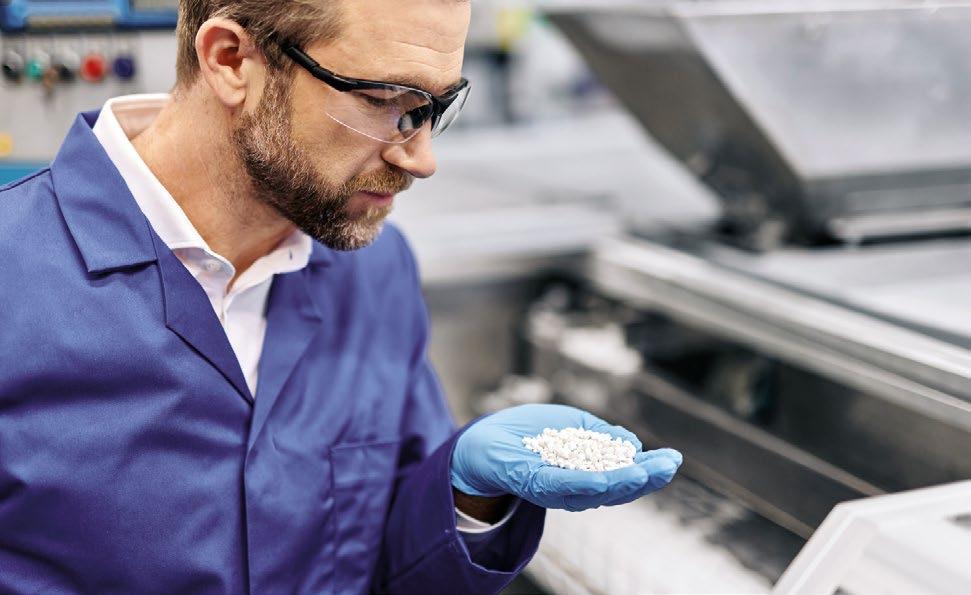
The company explains that NExP-1 maintains the ability to produce high-quality builds at high throughput rates, but, unlike other metal powders for Additive Manufacturing, it is dust-free and characterised as non-explosible as per ASTM E1226, Standard Test Method for Explosibility of Dust Clouds. The material is also
CLEVER SOLUTIONS WITH CUSTOMIZED COMPOUNDS
KRAHN Ceramics is your innovative project partner for your individual ceramic and metal injection molding process.
For the production of your compounds, we got our specially made kcmix® additives and binders which can be debinded aqueously, with solvents, catalytically or purely thermally. Get
non-combustible as per the UN Manual of Tests and Criteria, Part 3, Subsection 33.2.1. for flammable solids.
“We have achieved these key safety properties without altering the quality of our material nor the chemical composition. In printing, this material performs just as well as our other aluminium powders, but it has the added benefit of being non-explosible and non-combustible,” stated Evan Butler-Jones, vice president – Product & Strategy for Equispheres.
“It would almost be inaccurate to even call this a powder,” ButlerJones continued. “It is almost totally free of dust; it flows like water and it is easy to clean off of equipment surfaces. It is a completely unique printing media for production Additive Manufacturing.”
The NExP-1 material is currently available in AlSi10Mg and the company has developed recommended parameters for additively manufacturing the new material, targeting several end-use applications.
Kevin Nicholds, CEO of Equispheres, commented, “We are applying our technology to empower innovation in Additive Manufacturing. We anticipate this new safer aluminium material will be embraced by companies using AM in a production setting. This new breakthrough is a result of our ongoing efforts to make 3D printing more accessible and competitive with other manufacturing methods.”
Equispheres has a core team of metallurgists actively engaged in R&D and continues to develop processes and products to advance the technology of AM. The company’s Performance and Precision lines of aluminium powder demonstrate marked improvement in build speed and part quality, resulting in lower per-part costs. NExP-1, an addition to Equispheres’ Production product line, relies on a technological breakthrough to address the handling properties of AM powders.
www.equispheres.com
Sandvik to offer online metal powder ordering from Q1 2023

Sweden’s Sandvik has pre-launched a new online ordering ‘webshop’ for its range of Additive Manufacturing metal powders. Announced at Formnext 2022, Osprey® Online is expected to be fully launched in Q1 2023, and plans to offer a forty-eighthour turnaround service as well as 24/7 technical support.
With more than 160 years of materials expertise and forty-five years of


experience in powder atomisation, Sandvik is a leading provider of gas atomised metal powders for MIM, Additive Manufacturing and other metal powder-based processes. The company offers a wide range of alloys.
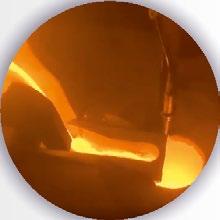

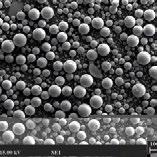
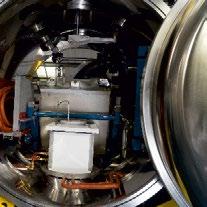
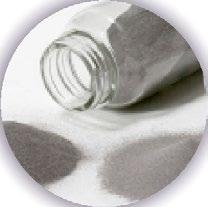


By registering interest via the Osprey site, customers can receive a 5% discount on their first order. www.additive.sandvik
Praxis Technology relocates in expansion plans
Praxis Technology has announced plans to expand its business, moving its two facilities in Queensbury, New York, USA, to a larger site in Pruyn’s Island, Glens Falls, New York, reports Glens Falls Business Journal
“We purchased the building and are relocating both of our facilities that are currently in the industrial park by the airport,” stated Joseph Grohowski, founder and president of Praxis Technology. “We’re doing it for a number of reasons. One is that we want to have all of our operations under one roof. Two is that we need room to grow. We are pretty much out of room in our current two facilities. It’s a great opportunity for us to lay the foundation for future growth as well as to create a really nice environment for our employees. It’s very important to us that Praxis is a great place to work.”
According to Grohowski, Praxis will invest approximately $1 million to reoutfit the Pruyn’s Island facility. The process will begin as soon as possible and the company is expected to be relocated by the middle of 2023.
Praxis currently employs fifty people, and staff levels are expected to increase. Grohowski said the company’s growth is being fuelled
by its flagship Metal Injection Moulding technology for titanium.
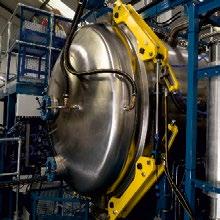

“The technology allows us to form titanium in a very similar way to injection plastic,” added Grohowski. “It gives our customers lower manufacturing costs as well as increased design flexibility. We have seen rapid growth in the adoption and acceptance of the technology. We see this being a big part of our future. We are planning on commercialising some Additive Manufacturing technology for our markets, as well.”
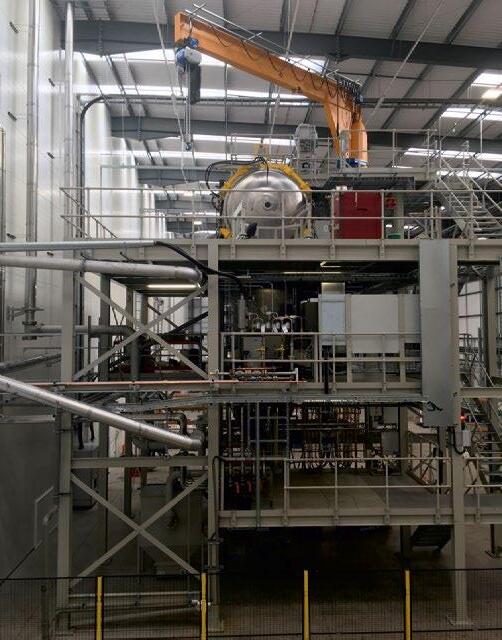
Many of the implant-grade titanium parts that the company manufactures are used in hip, knee, and spinal surgeries; Praxis has manufactured over 250,000 implantable devices. In addition to being used in the medicine and aerospace, the company’s components are also used in the auto, marine, and sporting goods industries.
“We’re excited to continue growing in the community,” Grohowski concluded. “The Glens Falls area has been a great place for us to be because of the strong medical device manufacturing base. We’re looking forward to making our company even stronger.”



www.praxisti.com


Aubert & Duval announces new metal powder brand and relocation of Irun production site
Aubert & Duval, a subsidiary of the High Performance Alloys Division of the Eramet Group, based in Paris, France, has launched Stellar®, a new metal powder brand dedicated to Additive Manufacturing and announced plans for the relocation of its Irun, Spain, production site.
“These two announcements reflect our belief in the growth potential of the metal Additive Manufacturing market,” stated Eric Caridroit, president of Aubert & Duval Irun.
The Stellar brand is intended to embody all of Aubert & Duval’s
ambitions in the AM field, boosting its offer in a fast-growing market, with the rise of space applications and challenges of decarbonisation. The new range of high-temperature alloys Stellar ABD®-900AM, Stellar MHA3300®, Stellar AD730® are intended to represent a solution to enable the space, aeronautics and energy industries to develop new generations of turbines offering better energy and environmental performance.
Aubert & Duval is also moving to a new stage of its growth with a
relocation project of its metal powder production factory, scheduled for summer 2023. The new industrial site, with a planned 50% capacity increase, will be located in Oiartzun, Spain, 6 km away from its Irun factory. With this new industrial base, Aubert & Duval plans to increase its metal powder production to develop and produce customised AM alloys.
Adeline Riou, Global Sales Manager for metal powders at Aubert & Duval, concluded, “Through the combination of freedom of design and innovative materials, this technology offers great opportunities for weight reduction and high temperature performance. This value proposition is at the heart of our new Stellar brand.”
www.aubertduval.com
EPTAM Precision Solutions, headquartered in Northfield, New Hampshire, USA, has acquired a new sintering furnace to support its move into Metal Injection Moulding and metal Binder Jetting technology.
EPTAM is a manufacturer of medical device components, implants, single-use medical disposables, biopharma and diagnostic devices, as well as other high-precision surgical device components. It has experience with polymer machining, precision metal machining, laser cutting/ welding and Metal Injection Moulding,
which the company states it targets to begin in the near future.
Commenting on the news, Mark Kemp, Chief Executive Officer of EPTAM Precision Solutions stated that this was an, ”exciting milestone for our MIS [minimally invasive surgery] and robotic-assisted surgery growth strategy.”
Robotic-assisted surgery offers surgeons enhanced precision and control in complex surgeries that may otherwise be considered incredibly challenging and/or impossible to perform. EPTAM supports this
Digital Metal introduces H13 powder for its BJT machines
Digital Metal, a Markforged company, has announced the availability of H13 metal powder for all Digital Metal Binder Jetting (BJT) Additive Manufacturing machines. The powder will go under the name DM H13 and is a hot-work tool steel that can maintain its strength and hardness when exposed to high temperatures.
It also exhibits good resistance to thermal fatigue and abrasion. H13 is commonly utilised in tools such as extrusion dies and injection moulds. Adding this metal to the company’s portfolio is intended to expand the number of missioncritical applications that can be solved on location and on demand.
evolving industry with skilled precision machining of components and subassemblies, as well as product development for a wide range of surgical instruments and medical devices for industry-leading minimally invasive, orthopaedic and medical device companies.
EPTAM has made a number of acquisitions in recent years, expanding its offering to include EPTAM Precision Metals (formerly Relius Medical), EPTAM Precision Molding (formerly Micro Molding Inc. and MedConnection LLC), and EPTAM Precision Micro-Machining (formerly Mendell). The company has over 500 employees with operations in New Hampshire, Colorado, New Jersey, Minnesota, Connecticut, and Michigan. www.eptam.com
Highly complex H13 parts can be additively manufactured with properties tailored to application-specific requirements through post-sintering heat treatments.
While final properties vary depending on heat treatment conditions, the ultimate tensile strength of the as-sintered metal is 1350 MPa with a yield strength of 800 MPa. The as-sintered material achieves a 97% relative density at 40 HRC.
www.digitalmetal.tech
EPTAM Precision Solutions acquires sintering furnace as part of move into MIM and metal Binder Jetting
largest manufacturer of MIM feedstock in the United States



in custom solutions & special alloys
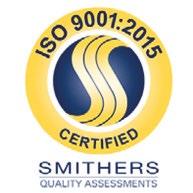
PROPRIETARY BINDER SYSTEMS
Wax Polymer Binder System
High material utilization rates of 20+ cycles
exclusive supplier of MIM feedstock in the world batch-to-batch consistency

Catalytic Debinder System
Available in the typical 1.1669 & 1.2160 oversize factors as well as custom oversize factors.
supplying MIM feedstocks for mission-critical precision parts

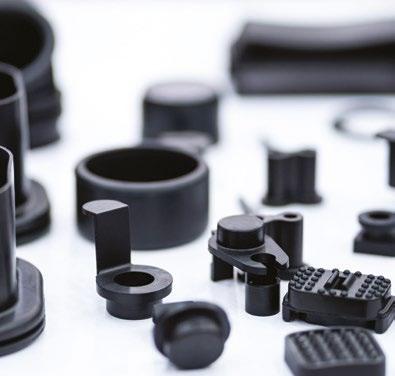

Advanced Metalworking Practices (AMP) manufactures and supplies a wide range of both standard and custom-configured MIM feedstocks for your application. Contact Chris Chapman at cchapman@ampmim.com or 724-396-3663. www.ampmim.com

 Firearms Medical
Firearms Medical
Lithoz acquires CerAMing, expands ceramic AM technology
Lithoz, Vienna, Austria, has acquired Germany-based CerAMing, the patent holder of the Layer-wise Slurry Deposition (LSD)-Print ceramic Additive Manufacturing process. The company is a spin-off of the German Federal Institute for Materials Research and Testing (Bundesanstalt für Materialforschung und -prüfung – BAM).
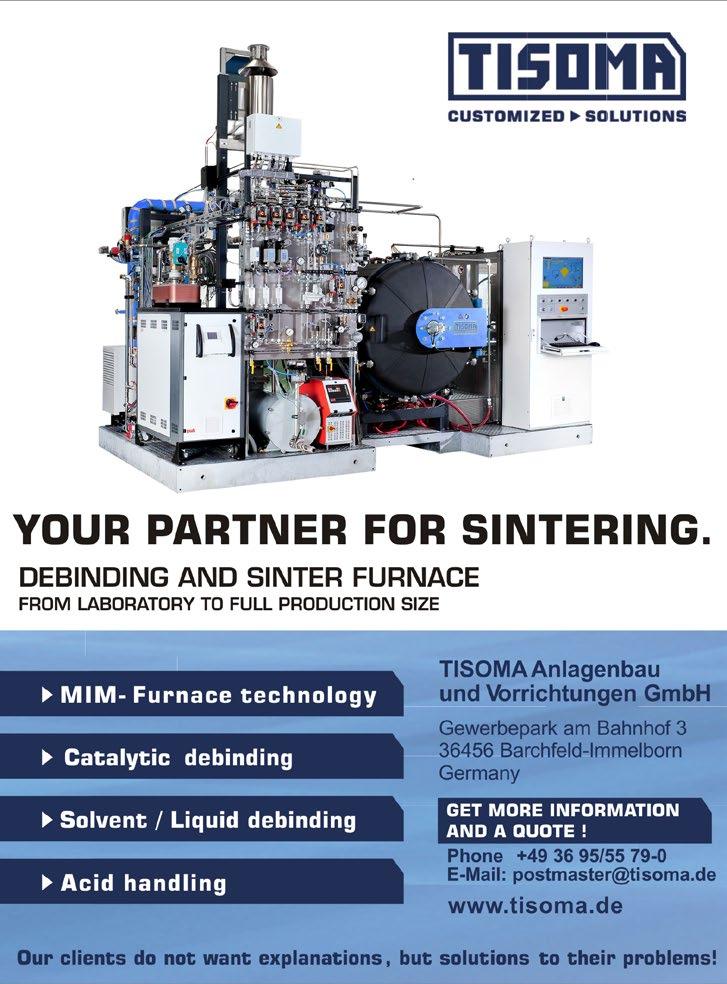
This acquisition means that Lithoz now has a complete “all from one source” portfolio of market-relevant processes in AM for advanced ceramics that include LSD-Print, Lithography-based Ceramic Manufacturing (LCM), a Vat Photopolymerisation (VPP) process, and the company’s Laser-induced Slipcasting (LIS) technology.
Lithoz has until recently focused on ultra-precise resolutions and highly complex internal structures in the case of LCM, and on particularly high wall thicknesses and the largest possible volumes with complete density in the case of LIS. The acquisition of CerAMing and the associated expansion of the technology portfolio to include layer-by-layer slurry disposition means that Lithoz can
now cover a broader range of applications in ceramic Additive Manufacturing with LSD-Print technology covering the area between the LCM and LIS processes. These three processes share extremely high densities and excellent material properties, as well as the freedom of design that comes with additively manufactured parts. Lithoz states that, depending on the specific strength of the respective technology, even the most diverse customer requirements can now be fulfilled from a single source.
“With the acquisition of CerAMing, Lithoz is expanding its technology portfolio through strategic acquisition for the first time,” commented Dr Johannes Homa, CEO. “We see this technology as another key pillar in the realisation of our vision to enable geographically independent, yet fully digitally connected, global serial production in the ceramics industry. We have already been able to realise this with our market-leading LCM technology, and along with LIS technology we will soon also be able to further our goals with LSD printing as complementary technologies with the same high quality and without compromising on results.”
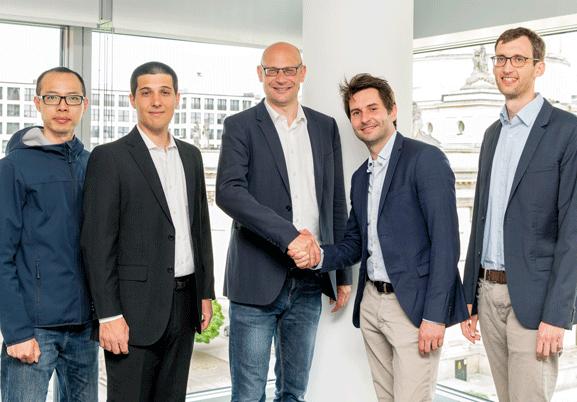
Sebastian Walzel, co-founder of CerAMing, stated, “When we started our journey as entrepreneurs in 2019, we were particularly inspired by the success story of Lithoz. It fills us with pride that CerAMing will now become a part of this success and that the fruits of our labour will contribute to its progress.”
Prof Dr Ulrich Panne, president BAM, added, “Spinoffs like CerAMing make an important contribution to technology transfer, which is one of the central tasks of our research. There are many excellent scientists with innovative ideas at BAM. Our BAM Startup-Slingshot initiative supports them with scientific know-how and our excellent laboratory equipment on their way to entrepreneurship.”
www.lithoz.com
TO MAKE A MATERIAL DIFFERENCE THE RIGHT PARTNER IS EVERYTHING
We have been driving the materials evolution for more than 160 years and offer the widest range of metal powders on the market – including Osprey® titanium, super-duplex stainless steel, copper, and nickelbased super alloys. Atomized in-house and optimized for advanced and sustainable manufacturing technologies such as additive manufacturing and metal injection molding, our metal powders are highly consistent and carefully tailored to your process.
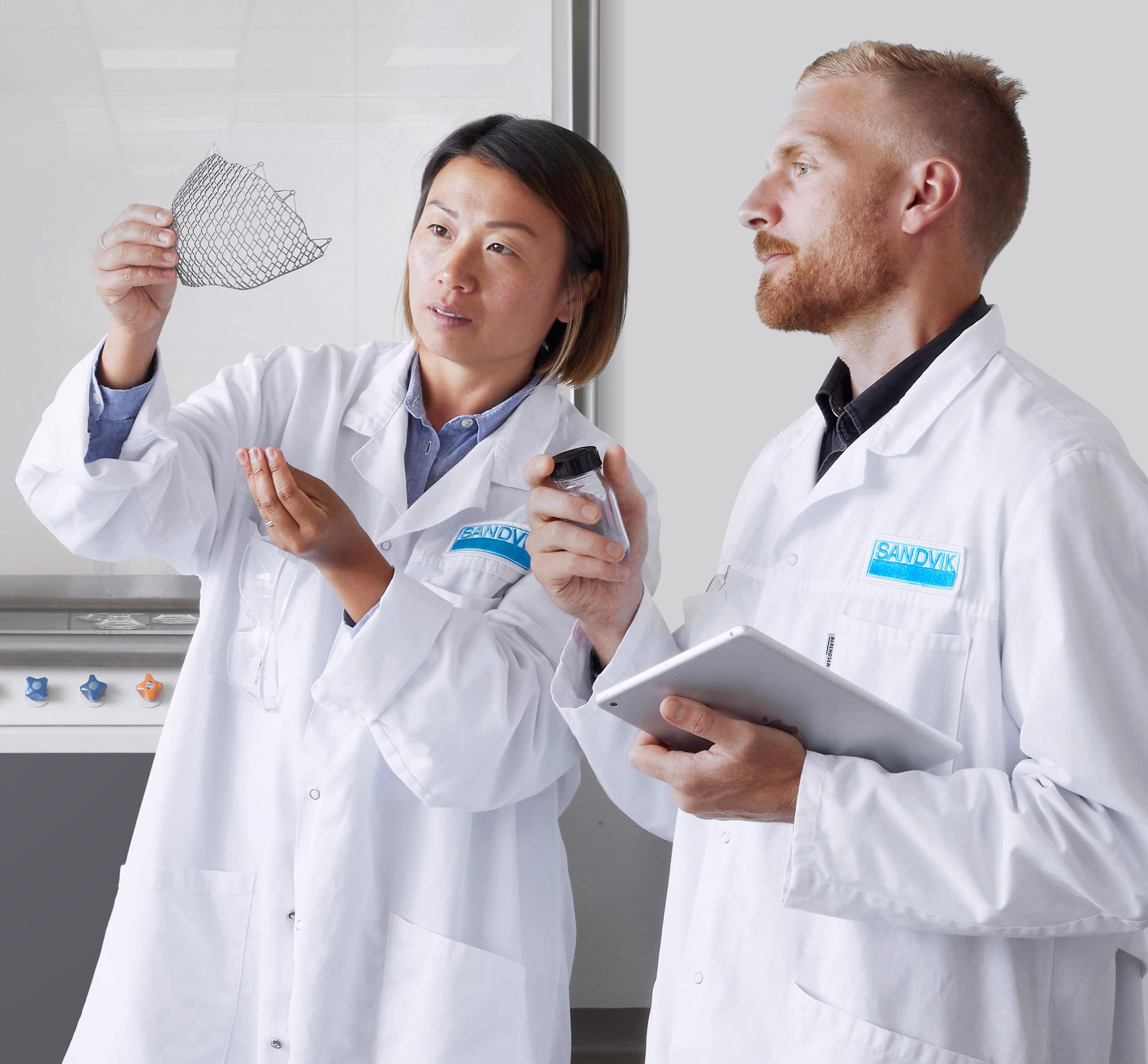
DISCOVER OSPREY® ONLINE – THE METAL POWDER WEBSHOP
Imagine being able to access premium metal powders for additive manufacturing directly from the source, from any device, at any time. Introducing Osprey® Online – the metal powder webshop stocked with powders and expertise. Just add to cart and we'll ship your order within 48 hours! Scan the QR code to register today, and enjoy 5% off your first order with us.

Rapid sintering of lithography-based additively manufactured ceramic components
Researchers from Montanuniversität Leoben, Austria, and Jožef Stefan Institute, Ljubljana, Slovenia, have published research in the journal Additive Manufacturing on strategies to achieve, and benefits of, faster sintering times on complex additively manufactured ceramic components. The paper ‘High-strength lithography-based Additive Manufacturing of ceramic components with rapid sintering’ details how this quicker sintering process might enable the creation of highly dense ceramic architectures with tailored microstructure and properties.
Until this point, densifying AM ceramic parts was done in conventional furnaces under typical conditions, making it difficult
to manufacture pore-free, finegrained ceramics. In this research, the authors utilised a radiationassisted sintering (RAS) method for quick sintering at ~300—450°C/ min using lithography-based Additive Manufacturing of alumina ceramics. The team showed that RAS could successfully sinter lithography-based additively manufactured alumina ceramics in a matter of minutes as opposed to hours. A Spark Plasma Sintering (SPS) setup was modified to enable the sintering of complex geometries (e.g., a turbocharger engine rotor) without the need for direct pressure or current on the ceramic part.
The reported sintering process also produced fine-grained micro -

structures of 1 μm with densities of 99%, sintered at an energy input of 1 MJ as opposed to the 25 MJ of traditional sintering. In comparison to traditionally sintered reference parts, the high mechanical strength of ~810 MPa and toughness of ~4.3 MPa m 1/2 of AM alumina sintered at 1600°C within two minutes was also superior.
These results are hoped by the researchers to open the use cases of RAS to control the microstructure of additively manufactured parts, thereby enhancing their mechanical and functional properties. This could, in future, be applied to biomedical, magnetic, optical, catalytic, thin films and electroceramics.
The full paper, authored by AnnaKatharina Hofer, Andraž Kocjan and Raúl Bermejo, is available from ScienceDirect.

www.sciencedirect.com
www.unileoben.ac.at
www.ijs.si
Registration opens for hybrid MIM2023 international conference
The Metal Powder Industries Federation (MPIF) has announced that registration is now open for the 2023 International Conference on Injection Molding of Metals, Ceramics and Carbides. The event is scheduled to take place February 27-March 1, both in person and online at the Hilton Orange County in Costa Mesa, California, USA.

All aspects of the processing of components produced by Metal Injection Moulding, Ceramic Injection Moulding and sinterbased Additive Manufacturing will be covered. There will also be a tabletop exhibition featuring leading international industry suppliers.
A Powder Injection Molding Tutorial, presented by former MIMA president Matthew Bulger, will be held on February 27. The course is intended to give attendees a solid grounding in PIM, including:
• Introduction to manufacturing processes, including feedstocks, moulding, debinding, sintering and finishing
• Definition of what constitutes a viable PIM component

• Selection of materials based on component expectations and required properties
• Assessment of the critical features of dimensional accuracy and material performance
• Comparison of PIM to competing technologies
• Review of the economical advantages of PIM
• New applications, emerging markets and examples of products thought impossible to manufacture before the use of PIM
As well as attendance to MIM2023, registration also includes $200 worth of MPIF e-publications, including ‘MPIF Standards 35 – MIM Materials Standards for Metal Injection Molded Parts – 2018’, ‘Metal Injection Molding A Comprehensive MIM Design Guide’ by Randall M German and ‘Injection Molding of Metals and Ceramics’ by Randall M German and Animesh Bose.
Copies of PIM International magazine will also be distributed to participants.
www.mim2023.org
www.mpif.org
Registration is now open for MIM2023 which is scheduled to take place at the Hilton Orange County/ Costa Mesa Hotel, California, USA, on February 27–March 1 (Courtesy Hilton Orange County/Costa Mesa Hotel)

THE PERFECT HEAT TREATMENT SOLUTION FOR THE PIM INDUSTRY
Wide range of standard and customized VACUUM FURNACES for INDUSTRY and R&D LABORATORIES.

Our vacuum furnaces solutions:
- HIGH TEMPERATURE VACUUM SINTERING
- DEBINDING & SINTERING
- DEBINDING/PRE-SINTERING
- HIGH PRESSURE SINTER-HIP
Vacuum thermal technologies: MIM, CIM, HARD METAL
AIM3D’s Voxelfill principle overcomes












inhomogeneous strength issues with cross-layer filling strategy



















AIM3D GmbH, Rostock, Germany, has developed a new process for sustainably improving the strength properties of an additively manufactured component. The company’s patent-pending Voxelfill technology is said to overcome inhomogeneous strength issues of the layer-based build process, increasing the cost effectiveness of its Composite Extrusion Modelling (CEM) AM process, a form of Material Extrusion (MEX).
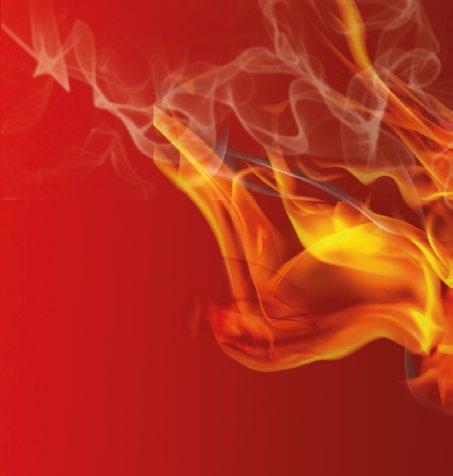









Voxelfill can be used for multi-material components and is suitable for constructing AM components using plastics, metals and ceramics. With the Voxelfill approach, components are no longer created exclusively in layers, but utilise cross-layer filling by using so-called voxels as volume areas. To do this, the component contour is first created as usual as the basic structure using one or more webs of the extruded material. A lattice pattern is created inside the component, which defines the boundaries of the volume elements to be filled, similar to cavities.
This structure of voxels to be filled is said to resemble the honeycomb in a beehive. The Voxelfill strategy comprises two process stages. First, generation of a lattice structure: the CEM system repeats this structure up to a defined height of the volume elements, then at this point, the previously created cavities (voxels) are filled by injecting thermoplastic material with the extruder. The second stage is the filling of the voxels; however, when the volume areas are filled this does not include filling all voxels in one plane. By shifting the volume elements halfway up the voxel, a kind of ‘brick-like bond’ is created in the component, resulting in the yield line being offset.

This reportedly results in a large increase in strength and also improves the elasticity of the components in the Z direction. In addition, the introduced volume elements greatly reduce the Additive Manufacturing time for fully filled components and thus significantly increases the costeffectiveness of the CEM process.
Variations of the Voxelfill strategy with the CEM process enable the use of various materials, where hybrid multi-material solutions with different Voxelfill materials and different materials for the contour/structure of the inner walls become possible. This way, the material properties can be customised, explains AIM3D. Defined component weight, damping properties, elasticity or changes to the centre of gravity can be tailored to the application. By selectively filling only certain volume chambers (selective densities), component properties could be influenced in a targeted manner on the basis of FE simulations.
With Voxelfill it is possible to only fill the areas of a component that are absolutely necessary for the flow of forces. As a result, from the outside, these components look like conventional parts, and can also benefit from applying finishing processes. At the same time, however, the AM process is carried out with reduced material and weight.
Clemens Lieberwirth, CTO at AIM3D, stated “Of course, the Voxelfill process is particularly suitable for 3D printing of plastics and fibre-filled plastics, but it is also suitable for 3D printing of metal and ceramic components using the CEM process. In general, there are advantages due to the higher build speed and cross-layer filling.”
www.aim3d.de

















































Ricoh expands UK Customer Experience Centre with metal Binder Jetting
Ricoh Company, Ltd, headquartered in Tokyo, Japan, has announced plans to expand its Customer Experience Centre (CEC) in Telford, Shropshire, UK. This expansion is intended to accelerate co-creation with customers and partners in the Additive Manufacturing industry, particularly those considering using metal Binder Jetting (BJT) for electric vehicles (EVs) and aircraft.
Ricoh hopes to help customers understand the capabilities of its technology while deepening its own understanding of customers’ potential pain points through activities at its CEC. The company will further contribute by providing Additive Manufacturing machines and a total solution for production workflow.
Ricoh stated that its BJT technology is well suited to the

manufacture of aluminium parts. The company can utilise its AM technology to produce aluminium parts with complex shapes that cannot be made using existing manufacturing methods, producing lightweight parts, high-performance heat exchange parts, and other components. In addition to heat exchangers, Ricoh has stated that it will explore further applications for aluminium BJT technology with customers.
Ricoh has positioned the ‘realisation of a zero-carbon society’ as one of its key goals. As such, the company is aiming to achieve zero GHG emissions throughout its entire value chain, enabling customers to develop highly energy-efficient products by using Ricoh’s Additive Manufacturing machines.
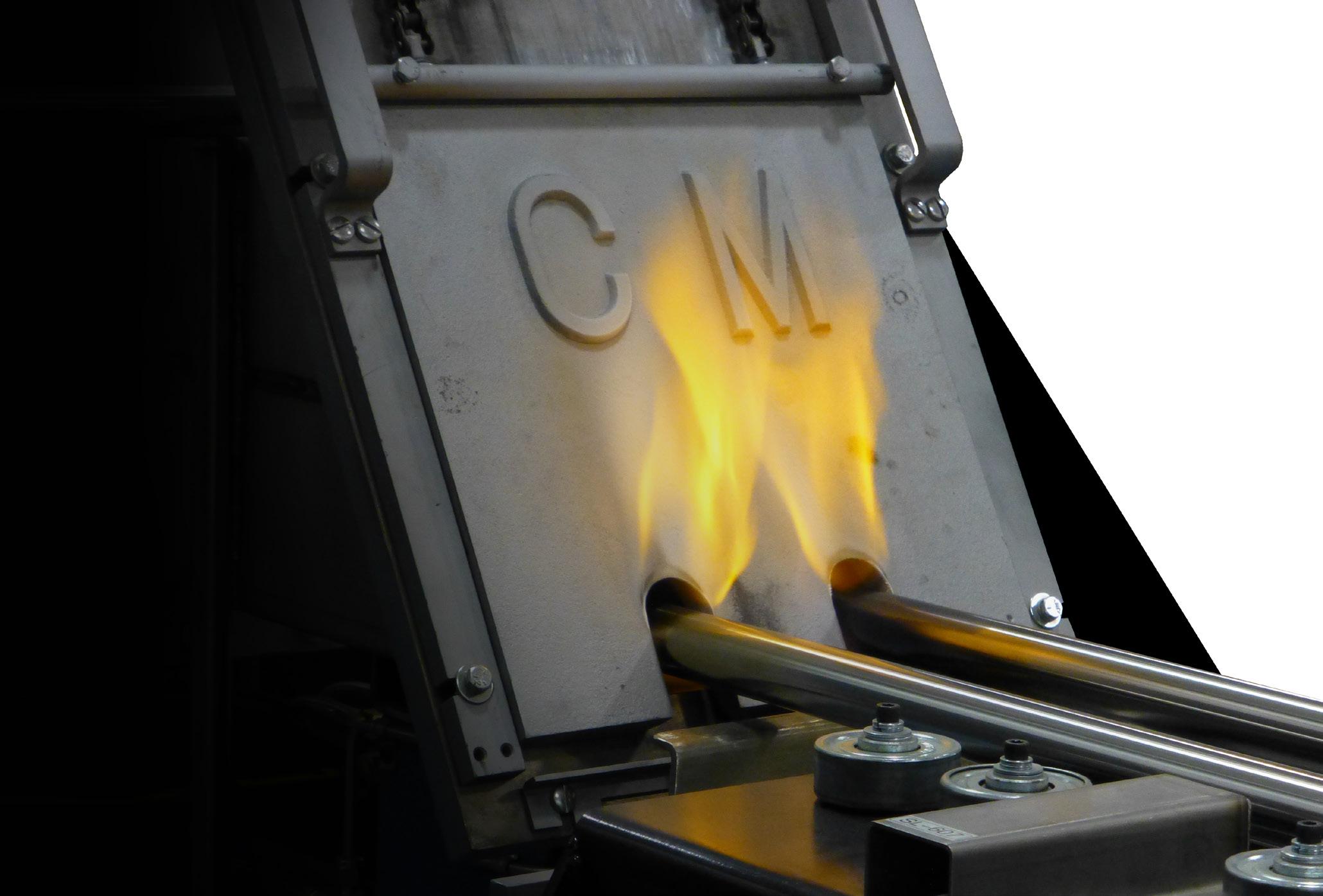
“There are technical issues with many products where they cannot fully perform due to heat problems or limitation of weight reduction. We are confident that Ricoh’s unique aluminium [BJT] technology will significantly contribute to solving these issues our customers face,” stated Tokutaro Fukushima, General Manager of Additive Manufacturing Business Center, Ricoh Futures Business Unit. “With the opening of the CEC, we would like to accelerate co-creation with our customers to realise additional value for customers’ clients.”
“Furthermore,” he continued, “we would like to actively promote collaboration with technical partners who have unique technologies. We hope to welcome partners who support our vision to ‘Make a significant contribution to a zero-carbon society and lead to the realisation of a wonderful future for children’ through co-creation activities.”
www.ricoh.com

For improved sustainability, variety and performance, choose forAM®
In the world of metal powders, Höganäs is always at the forefront of innovation. From more sustainable production processes to new and patented powder compositions, we are dedicated to offering you the optimal solutions while reducing environmental impact. With forAM ®, our range of metal powders designed for additive manufacturing, we can offer powders designed for any application.
The forAM ® range includes nickel, iron, cobalt, copper, titanium and aluminium powders in a variety of grades and compositions. Combining optimal powder performance with improved sustainability is a priority for Höganäs. In addition to our material innovations, we have also committed to Science Based Targets and are founding members of the Additive Manufacturing Green Trade Association, demonstrating our ongoing committing to leading sustainable transformation in our industry.

Zircoa releases first Mg-PSZ feedstock for Ceramic Injection Moulding
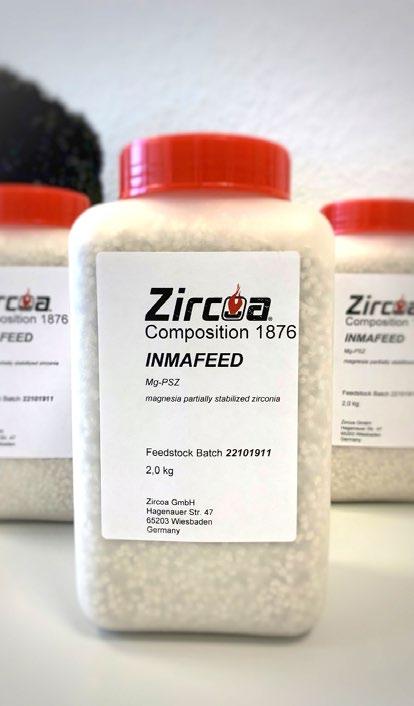
Zircoa GmbH, a German subsidiary of US parent company Zircoa Inc based in Wiesbaden, has released its first feedstock for Ceramic Injection Moulding. While the company primarily manufactures zirconia refractory products used in high-temperature applications, it also has a well-established portfolio of advanced zirconia ceramics. The engineered ceramic components – based on Zircoa’s own, in-house manufactured zirconia powder – are said to have several beneficial characteristics, including wear, corrosion, impact and fracture resistance, as well as the ability to withstand high temperatures and harsh liquid/gas environments.
Parts in which zirconia powder is utilised include:

• wear parts
• battery tools fluid flow control oil field supply electrical
• machine parts
• grinding blanks for machinery
• sensors
• spray nozzles
• valve linings
Zircoa’s raw materials are the ceramic basis for the company’s latest ceramic feedstock development. The first of these is magnesia-stabilised zirconia (Mg-PSZ) Composition 1876. The Mg-PSZ feedstock was produced together with Inmatec Technologies

Desktop Metal qualifies Inconel 625 for its Shop System
Desktop Metal, headquartered in Boston, Massachusetts, USA, has announced that nickel alloy Inconel 625 has been qualified on its Shop System metal binder jet machine. This marks the material’s qualification across Desktop Metal’s entire portfolio, spanning Production System and X-series models, as well as the Studio System.
“Manufacturers looking to produce complex geometries in IN625 now have a one-stop shop for efficient Additive Manufacturing
2.0 production,” stated Ric Fulop, founder and CEO of Desktop Metal. “IN625 is a very difficult material to machine, but our technology truly makes it easy. We are proud of the work our world-leading material and process teams have done ensuring that this popular material can be offered across our portfolio.”
IN625 is a high-performance nickel alloy known for high levels of strength, temperature resistance, and corrosion resistance — making it a popular material choice for appli -
GmbH, with the thermoplastic binder being Inmafeed. This binder system, which is already established within the industry, is reputedly easy to inject and enables environmentally friendly debinding.
The company added that its other zirconia compositions may be used as a basis for future CIM feedstocks.
www.zircoa.de
cations in the aerospace, chemical processing, and offshore energy industries.
However, IN625’s strength is what makes it a difficult and expensive material to machine into complex shapes. The process typically requires a skilled machinist and special CNC cutting tools, strategies and coolants to shape –and it’s not uncommon for cutting tools to be broken or deformed when milling Inconel stock, or for the material to deform when the outer layer hardens too quickly in response to machining, explains Desktop Metal.
www.desktopmetal.com
Kistler updates sensor technology for injection
moulding
Contact-free cavity pressure measurement with piezoelectric sensors is said to be the most sophisticated of the three measurement methods used in injection moulding, with the other two being direct and indirect measurement. The contact-free method is mainly used where high quality and process requirements have to be met (e.g., products for automobile interiors, high optical quality, or situations where very compact injection moulds are used).
Using a new PiezoStar crystal, the 9239B miniature longitudinal measuring pin from Kistler Group. Winterthur, Switzerland, is said to have achieved almost five times the sensitivity of its highly ranked predecessor. The company has also introduced the updated 2205B thermocouple amplifier to integrate temperature sensors more efficiently into the measuring chain for high-grade metal and plastic injection moulding.
The 9239B miniature longitudinal measuring pin is a cavity pressure sensor that is reported to take up 2.5 mm when installed and is able to perform its task without contacting the melt. It is mounted directly
behind the cavity wall in the mould structure or the embossing die, where it measures the pressure-induced compression of the mould during the injection and holding pressure phases.
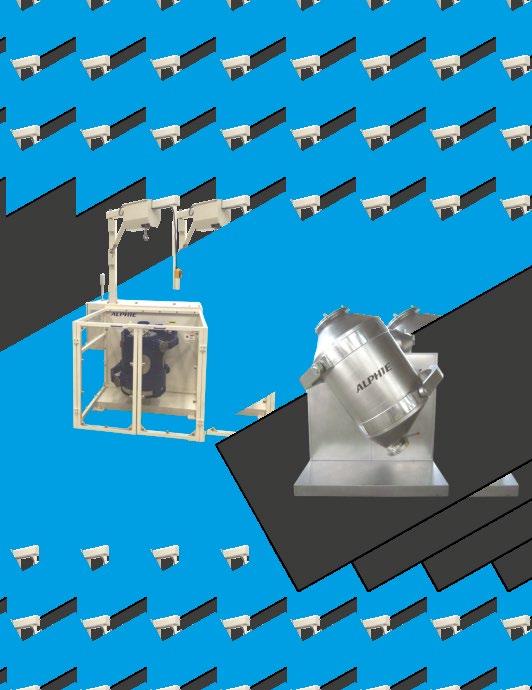
“Thanks to its compact dimensions for optimal installation, the 9239B gives mould makers more freedom when positioning it in smaller moulds or multi-cavity moulds with more complex structures,” stated Marko Marceta, Product Manager Plastics at Kistler.
The 9239B miniature longitudinal measuring pin is said to represent a major advance on its predecessor model: it features a PiezoStar crystal grown by Kistler, which reportedly increases the sensitivity many times over – to no less than 27 pC/N. Kistler has stated that this new measuring pin elevates contact-free cavity pressure measurement to an unprecedented level of accuracy. The mounting method is intended to eliminate the possibility of marks on the part, and the sensor is not exposed to abrasion or corrosion. And because the measuring pin is installed in the preloaded state, it is reported to capture both compression and tensile forces with very high accuracy.
The updated 2205B multichannel amplifier converts signals from temperature sensors installed in the injection mould into standardised voltage signals (thermocouples). Compared to the 2205A predecessor model, the improvements include channels for up to eight thermocouples. In addition, it is now possible to simultaneously connect different types (K,J,N). Type J thermocouples can now also be used at 400°C and the uniform measurement range (0-400°C) reduces the number of variants.
Measuring the mould temperature is intended to widen the scope for process monitoring & control of injection moulding with thermoplastics and other applications. The 2205B has a standard operating temperature range of 125-195°C with additional housing. The temperature sensors are connected using the cut-and-grip method to avoid the need for connectors and tools.
www.kistler.com
World PM2024 dates confirmed
Japan Powder Metallurgy Association (JPMA) and Japan Society of Powder & Powder Metallurgy (JSPM) have announced that World PM2024 International Powder Metallurgy Congress & Exhibition will take place October 13-17, 2024, in Yokohama, Japan.
World PM2024 will include presentations on the latest metal powder technologies, from press and sinter PM to metal Additive Manufacturing. An exhibition will introduce the latest products and technologies from the industry supply chain. In addition, various social events and special programmes will be prepared.
www.worldpm2024.com

Inmatec’s ceramic feedstock used for advanced extrusion applications
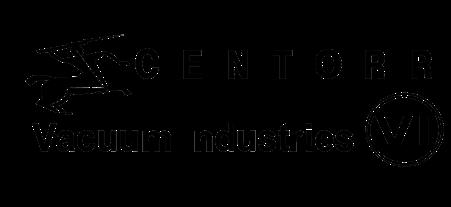
Inmatec Technologies GmbH, Rheinbach, and Fraunhofer IKTS, Dresden, Germany, have partnered to test the extrusion of rods and pipes from Inmatec’s INMAPOM K3012
Ceramic Injection Moulding feedstock. The test results reported that the extruded green parts were extremely dimensionally stable and can be mechanically processed in various ways. The testing showed that even advanced extrusion applications are possible with the ceramic feedstock INMAPOM K3012.
Round rods of solid material up to 15 mm in diameter can be extruded to lengths of 4000 mm. The extrusion of pipes with 1 mm wall thickness and the same outer diameter is also possible over this length. The rods and tubes can also reportedly be easily mechanically machined: cut to size, but also modified by drilling, milling, turning and thread cutting.
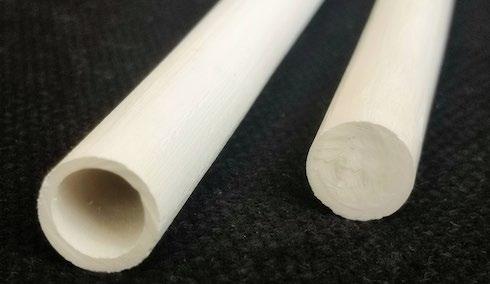
The variety of finishing options enables the production of more complex ceramic components from the long, uniaxial green bodies. For example, the blanks can be provided with cross or oblong holes and graduated axles, feed screws and screw flights can be turned in. Sharp-edged spigot ends can also be produced. This way of manufacturing is particularly suitable for smaller series, but, if the batch size is so small that costly tool design is not worthwhile, mechanical machining of the extruded green parts is thought to offer an efficient and economical alternative.
The use of INMAPOM K3012 is said to not only open up possibili -

ties in green machining but also offer good properties for the finished parts. Zirconia components can be produced from Inmatec’s standard feedstock that is resistant to high temperatures, aggressive atmospheres and extremely durable. Ceramic axles, augers or spindles can be used in environments where other materials might fail; they also outperform some superalloys in terms of wear resistance.
Green parts from INMAPOM feedstocks are catalytically debound in just a single step. The POM-based binder developed by Inmatec can be completely removed within twelve hours in a nitric acid atmosphere. The subsequent sintering is carried out at a temperature of 1500°C. To further improve the mechanical properties of the components, additional densification by Hot Isostatic Pressing (HIP) is also possible, enabling them to withstand high loads.
www.inmatec-gmbh.com
www.ikts.fraunhofer.com
MIM debind and sinter vacuum furnaces



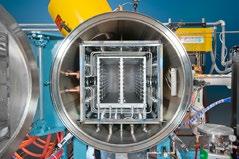
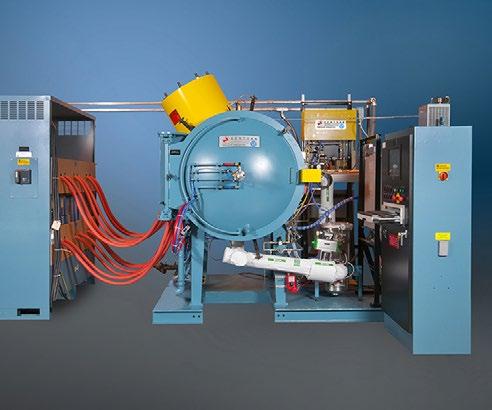
Over 6,500 production and laboratory furnaces manufactured since 1954
• Metal or graphite hot zones
• Processes all binders and feedstocks
• Sizes from 8.5 to 340 liters (0.3–12 cu ft.)
• Pressures from 10-6 torr to 750 torr
• Vacuum, Ar, N2 and H2
• Max possible temperature 3,500°C (6,332°F)
• Worldwide field service, rebuilds and parts for all makes
Rapidia showcases its two-step metal AM process to European market
Exhibiting at Formnext for the first time in 2022 was Canada’s Rapidia, bringing its two-step metal extrusion Additive Manufacturing technology to the European market and launching its Advanced Vacuum Sintering Furnace.
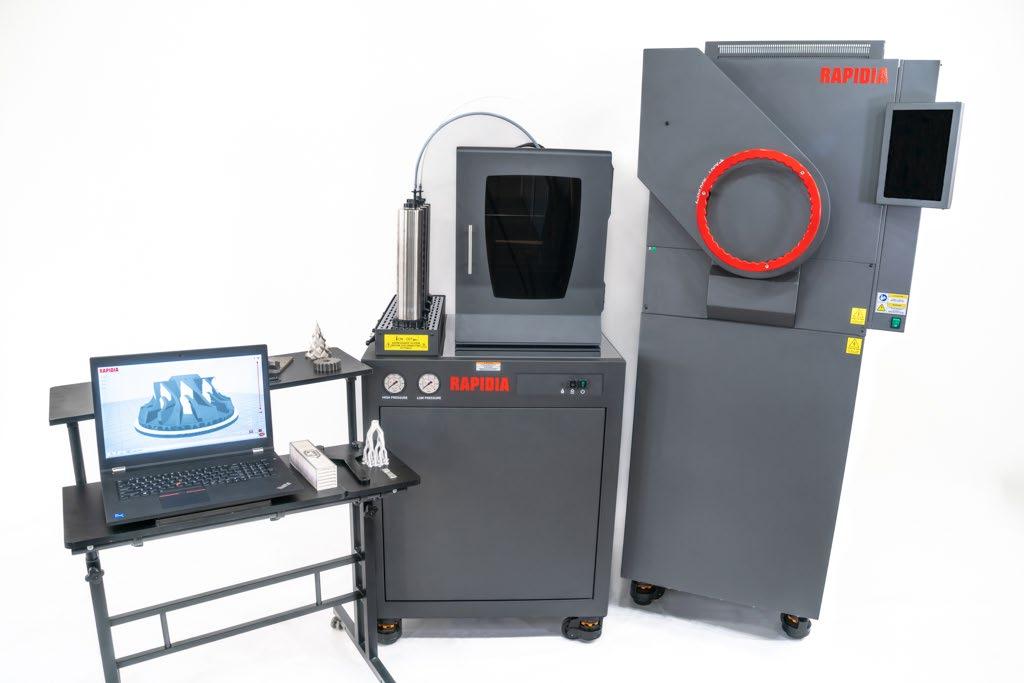
Established in 2016, Rapidia has developed what it claims is a simple, fast, and accessible method of Additive Manufacturing metal, centred on a water-based feedstock. In 2020, the company partnered with ExOne to establish the Metal
Designlab, complementing ExOne’s Binder Jetting product line. Following ExOne’s acquisition by Desktop Metal in late 2021, that partnership ended and Rapidia has returned to independent distribution of its hardware and feedstock.
Rapidia’s two-step AM technology, first revealed in 2019 and since refined, sees water-bound metal and ceramic parts go directly from the build stage into a furnace, without a debinding stage. The process is made possible by HydroFuse, a water-based
Incus and Micro MIM sign reseller agreement
At Formnext 2022, Incus GmbH, Vienna, Austria, and Micro MIM Japan Holdings Inc., headquartered in Osaka, Japan, signed a sales representative agreement which will expand Incus’s offering into Japan. With a detailed knowledge of the debinding and sintering process, Micro MIM is ideally positioned to support customers of Incus’ sinter-based Additive Manufacturing machines.
Incus provides solutions for the Additive Manufacturing of high-performance metals via a lithography-based metal manufacturing (LMM) technology, defined as a Vat Photopolymerisation process (VPP) by ISO/ASTM. This process is said to produce parts with high surface aesthetics and similar material properties found in Metal Injection Moulding.
paste containing metal or ceramic powders, which does not require debinding before final sintering.
Along with the AM machine and feedstock, the company has also launched its Advanced Vacuum Sintering Furnace. This furnace offers partial pressure sintering in argon and is said to yield excellent metallurgy. Non-flammable forming gas mixtures are also compatible.
Parts can be sintered directly from the AM machine in approximately twelve hours, meaning components can be available within sixteen to twenty-four hours from the start of a build.
Leveraging the open architecture of the technology, research partners have formulated specialised pastes with Rapidia materials and have developed their own sintering cycles for the furnace, the company has stated. The research community has said that the straightforward system allows them to focus on these new materials and techniques.
Off-the-shelf materials from Rapidia include stainless steels 316L and 17-4 PH, offering corrosion resistance and strength, along with Inconel 625 for high-temperature performance and enhanced corrosion resistance.
The team is currently engaging with European customers to bring the first system to the market in Q1 of 2023.
www.rapidia.com
Micro MIM Japan Holdings Inc is a MIM parts manufacturer specialising in the mass production of metal parts up to 30 mm in all dimensions.
In 2021, the companies entered into a partnership which provided an Incus Hammer Lab35 metal Additive Manufacturing machine to enable Micro MIM to produce functional prototypes and offer small runs of parts to its customers.
www.incus3d.com
www.micro-mim.eu
Unique inert gas atomizing technology produces highly specified, spherical metal powders for MIM and AM applications. Team with history of developing and producing fine gas atomized powders since 1990.
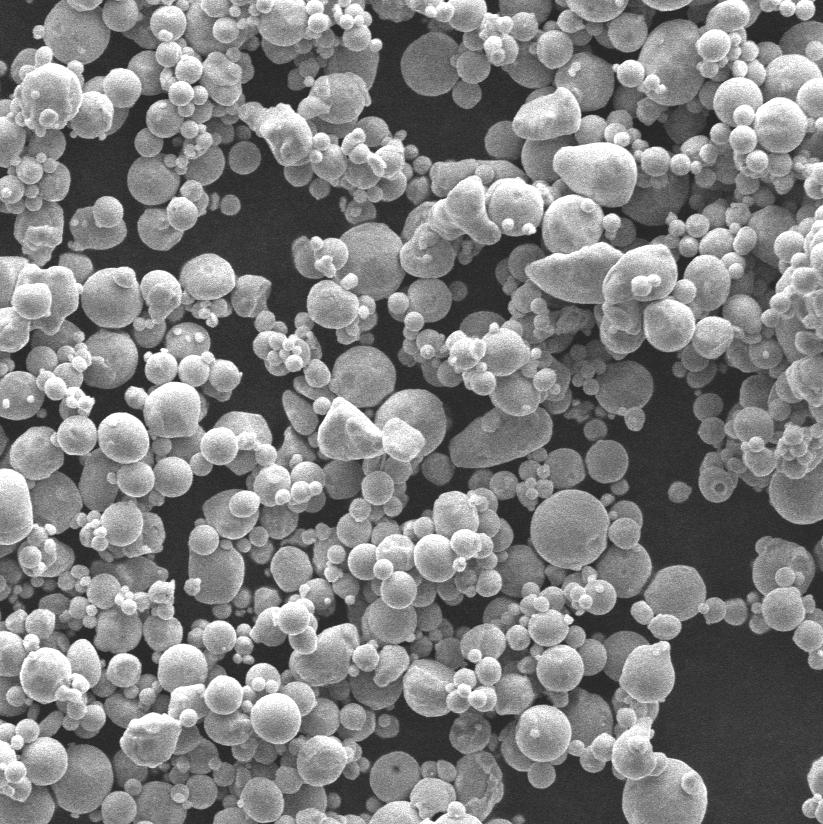

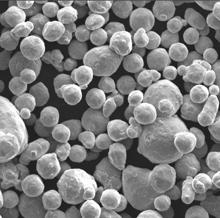
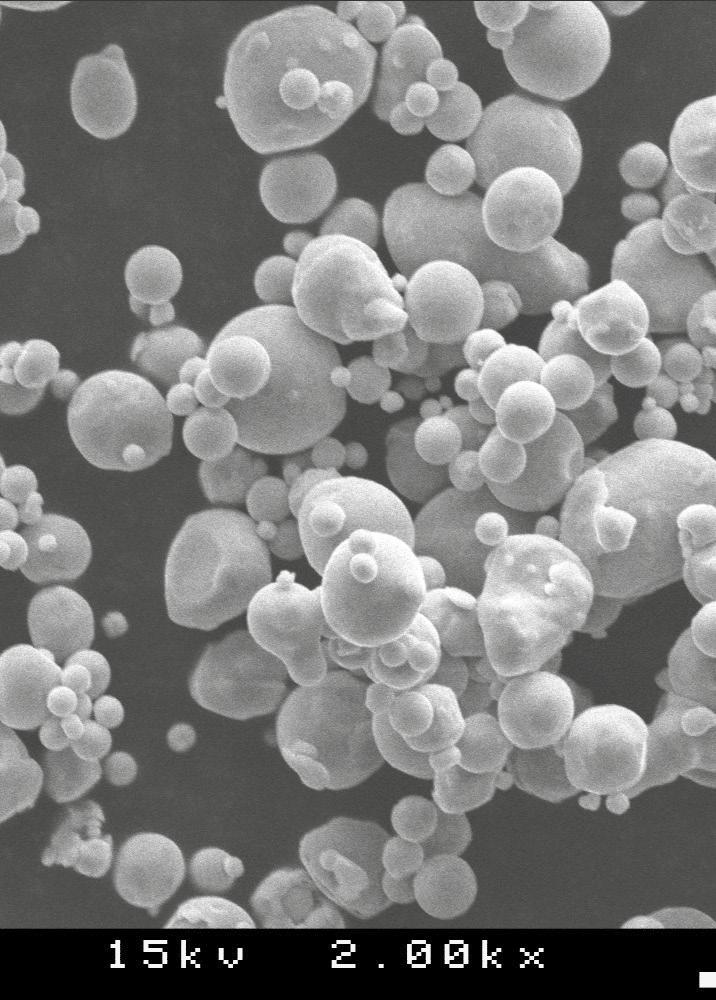
Specializing in sub 30 micron powders, Ultra Fine has the technical capability to work with you to develop and produce the powder to suit your application. Ultra Fine offers flexibility and quick turn-around times.

With partner Novamet Specialty Products Corp., Ultra Fine provides various after treatments, coatings and other capabilities using Ultra Fine’s high quality powders.

PM Tooling System
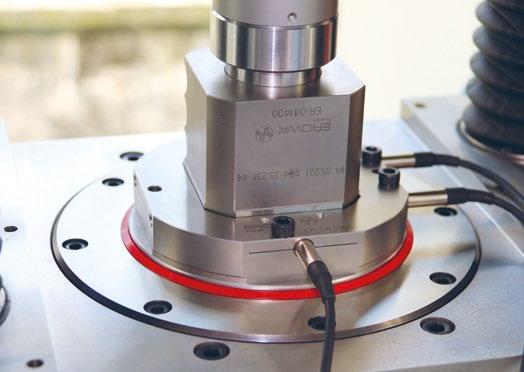
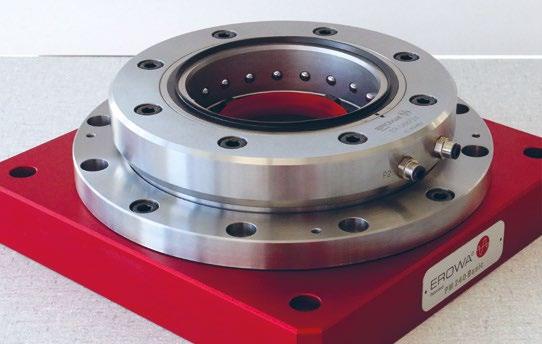
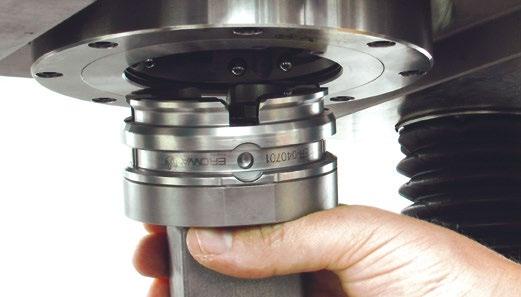
Formnext 2022 attendance back to pre-pandemic numbers
Over the course of four days, Formnext 2022 once again brought the global Additive Manufacturing industry to Frankfurt, Germany. With attendees from ninety-six countries, the high proportion of international visitors (51%) and exhibitors (58%) demonstrated its status as the leading international trade fair for industrial Additive Manufacturing and advanced production technologies.
Now in its eighth year, the event included 802 exhibitors, up from 606 in the previous year, and over 51,000 m 2 of booked exhibition space. With attendance reported to be 29,581, up by 65.6% compared to 2021 (17,859), Formnext 2022 was virtually on par with pre-COVID levels.
“We are proud of the fact that Formnext has returned to its impressive pre-Covid level,” stated Sascha F Wenzler, VP – Formnext event organiser Mesago Messe Frankfurt GmbH. “We have once again demonstrated the importance of Formnext as the world’s premiere AM platform and the vital role of face-to-face interaction at Formnext for the further development of this highly innovative sector.”
The numerous world premieres and developments included novel AM technologies and new and improved AM machines, as well as new materials ranging from wood to ceramics, software solutions, service offerings, post-processing solutions, and much more.
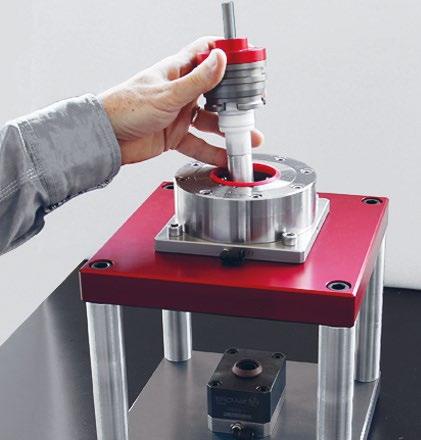
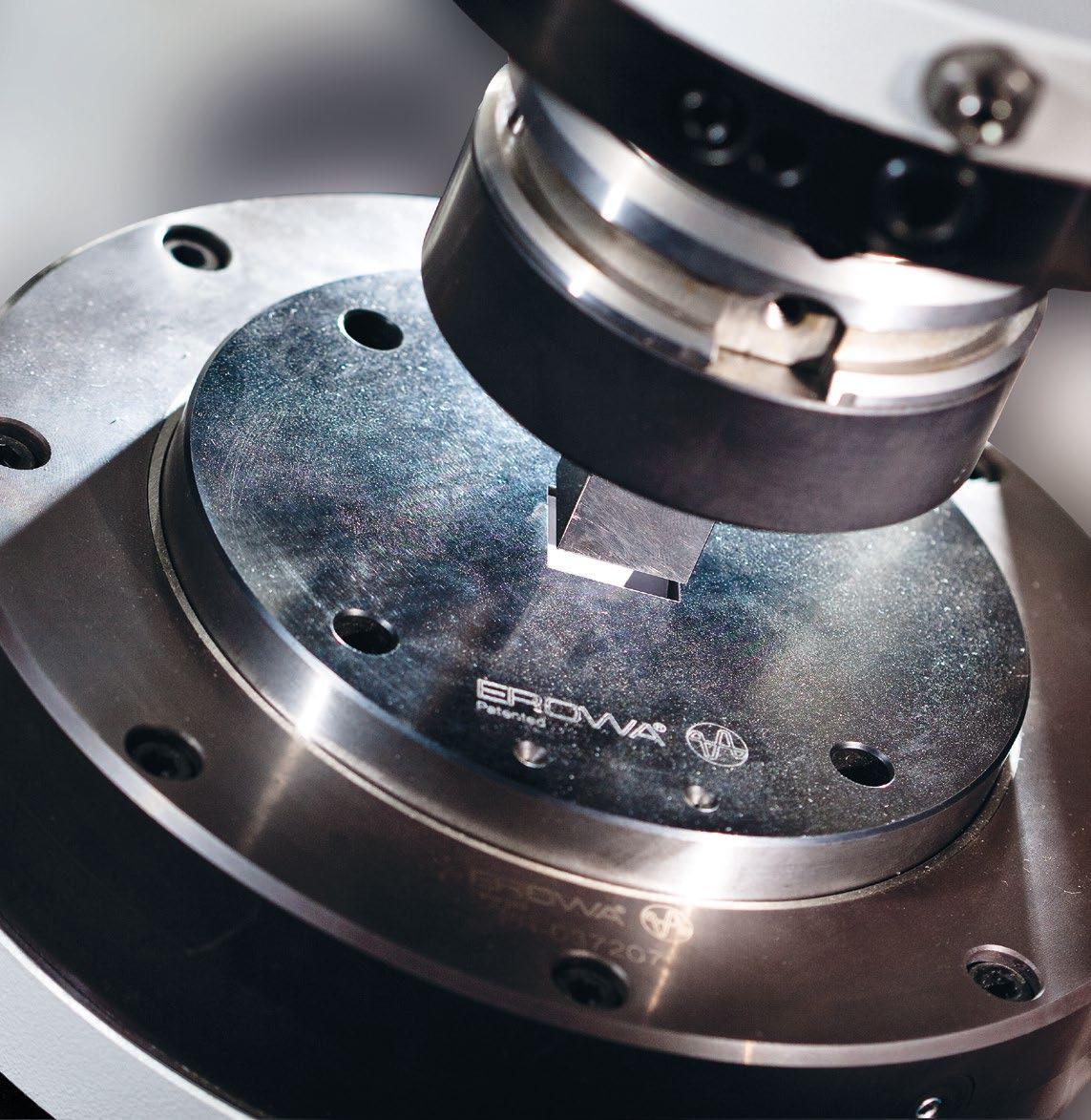
The programme of supporting events at Formnext 2022 was broader and more varied than before, leading visitors through the world of innovative startups, additively manufactured houses, and cutting-edge applications in medical technology. Recurring themes included the implementation of decentralised AM, the promotion of sustainable manufacturing solutions, and the growing maturity of industrial AM.
For the eighth time, the international Formnext Start-up Challenge recognised young companies from the world of AM for their business ideas and technical developments. Visitors once again enjoyed the Pitchnext event, where start-ups competed for the attention of investors. The purmundus challenge competition celebrated its tenth anniversary, with a reception and a showcase of winners from the past ten years.
The Discover3Dprinting seminars were another popular event during the exhibition, especially for newcomers to AM. The seminars are set to continue at various locations throughout 2023.
On November 14, the day before the start of the exhibition, the ASTM Standards Forum focused on the importance of standards and standardisation for Additive Manufacturing. On the same day, the Wohlers Report LIVE at Formnext 2022 event celebrated its debut.
Next year’s edition of Formnext is scheduled to take place on November 7–10, 2023.
www.formnext.com
The EROWA PM Tooling System is the standard interface of the press tools between the toolshop and the powder press machine. Its unrivalled resetting time also enables you to produce small series profitably.
EPMA announces annual Sustainability Award
During World PM2022 in Lyon, France, October 9–13, the European Powder Metallurgy Association (EPMA) announced its intention to present an annual Sustainability Award. This will see six companies recognised for their sustainability efforts each year: one gold winner, two silver and three bronze.
The award will take into account sustainability as it relates to the environment (CO 2, energy, water and LCA), to people (equality, diversity & inclusion, and safety) and to society (local community, ethics). Winners will be selected based on the EPMA Sustainability Survey. www.epma.com
Desktop Metal appoints Jason Cole as Chief Financial Officer
Desktop Metal, Boston, USA, has appointed Jason Cole as its new Chief Financial Officer. Cole joins the company from Analog Devices, a provider of signal processing technology used in electronic equipment, where he worked for eighteen years in financial leadership positions across several business units.
“Jason is a highly accomplished financial executive, who worked his way up to division CFO at a $10 billion technology company over two decades,” commented Ric Fulop, Desktop Metal founder and CEO. “We’re very excited to have him join our family, and we’re confident he is going to help us get the company to the next stage and execute our financial goals. He has a lot of experience in M&A integration and improving costs and efficiencies. We’re very excited to have him join Team DM.”
GPCMA – MODIFIED ATMOSPHERE CHAMBER FURNACE
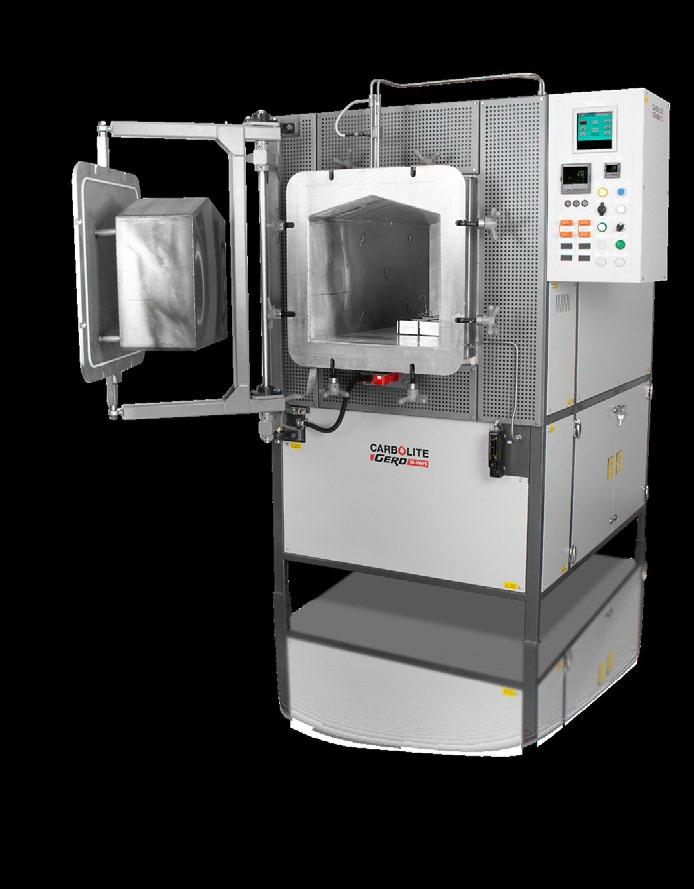
Cole’s most recent position at Analog Devices was as Division CFO, Global Operations and Technology, which he held from January 2018. Prior to this, Cole worked for Arthur Andersen LLP in the High Technology Audit practice from 1997 to 2001. He is a Certified Public Accountant and holds a BS in Accountancy from Bentley University, and an MBA from Cornell University’s Samuel Curtis Johnson Graduate School of Management.
“I am excited to join Desktop Metal, and help deliver on the vision of bringing 3D printing to mass production,” Cole stated. “I look forward to working with Ric and the leadership team to aggressively pursue our greatest opportunities, while driving continued revenue growth and optimised profitability.”

www.desktopmetal.com

Utilis AG, MIMplus and Headmade develop tool holder with 185% performance increase
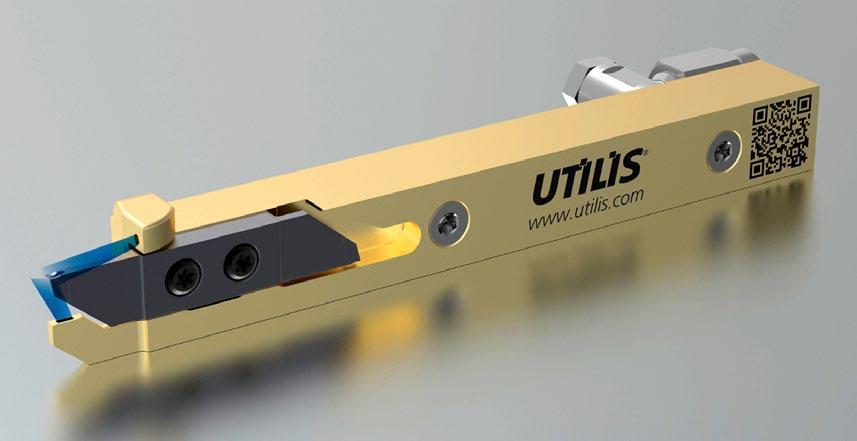
Utilis AG, Muellheim, Switzerland, has worked with German companies MIMplus Technologies GmbH & Co KG, Ispringen, and Headmade, Unterpleichfeld, to co-develop a cutting tool holder with a reported 185% performance increase.
This multidec® tool holder was specially developed for efficient grooving and longitudinal turning on sliding headstock automatic lathes
and can enable increased productivity in manufacturing. Via a new integrated cooling system, customers now have the opportunity to double the service life of their cutting edges or increase their cutting values without experiencing higher wear.
The tool holder is also said to benefit from Headmade’s newly developed M2 tool steel, which exhibits ultra-high wear resistance
Registration opens for AMUG Conference 2023
The Additive Manufacturing Users Group (AMUG) has announced that online registration is now open for its 2023 AMUG Conference, which is scheduled to take place in Chicago, Illinois, USA, March 19–23. The event is open to owners and operators of industrial Additive Manufacturing technologies used for professional purposes.
The AMUG Conference is a gathering of Additive Manufacturing users, of all experience levels, that meet to provide and share valuable insights and experiences. Through dialogue from the stage and conversations during breaks, meals and
networking activities, AM users share expertise, best practices, real-world results, challenges and application developments. With a programme that encourages participation from early in the morning to late at night, attendees can interact with their peers for over fifty hours over the five-day event.
“The AMUG conference is all about the users of Additive Manufacturing equipment,” stated Mark Abshire, AMUG president. “What makes it unique is that the users plan, organise, and manage all aspects of the conference, making it truly ‘For Users, By Users’.”
and hardness. The very narrow additively manufactured cooling channels will result in a tool holder with ultra-high performance and a lifetime increase of up to 185%. These channels were reportedly made possible by utilising the ColdMetalFusion process, as the extremely small diameter of the cooling channels needed to be depowdered without damaging the green part. ColdMetalFusion is a sinter-based Additive Manufacturing process that reuslts in parts with properties similar to Metal Injection Moulding.
The partners set up two identical machines at both MIMplus and Headmade’s locations to jointly develop and quickly compare results across locations. This allowed for the effective and straightforward parameter development and verification of the M2 tool steel for the tool holder across locations. The three companies eventually reached a part density of 98% and resulted in a superior mechanical performance.
Headmade Materials has launched the M2 tool steel with Utilis as its lead application. It is now available to the general public.
www.utilis.com
www.headmade-materials.de
www.mimplus.de
“Our conference fills education, training and networking gaps with experience and knowledge shared by users of a broad range of Additive Manufacturing technologies,” Abshire continued. “And, while highly skilled users attend the conference, first-time attendees new to the technology are embraced, welcomed, and encouraged to engage in information exchange.”
The AMUG Conference will include keynotes, panel discussions, technical sessions and hands-on workshops designed to help users get more from, and do more with, their AM solutions. The conference agenda is expected to offer nearly 150 presentations and workshops.
www.amug.com
STOCK CODE:000969
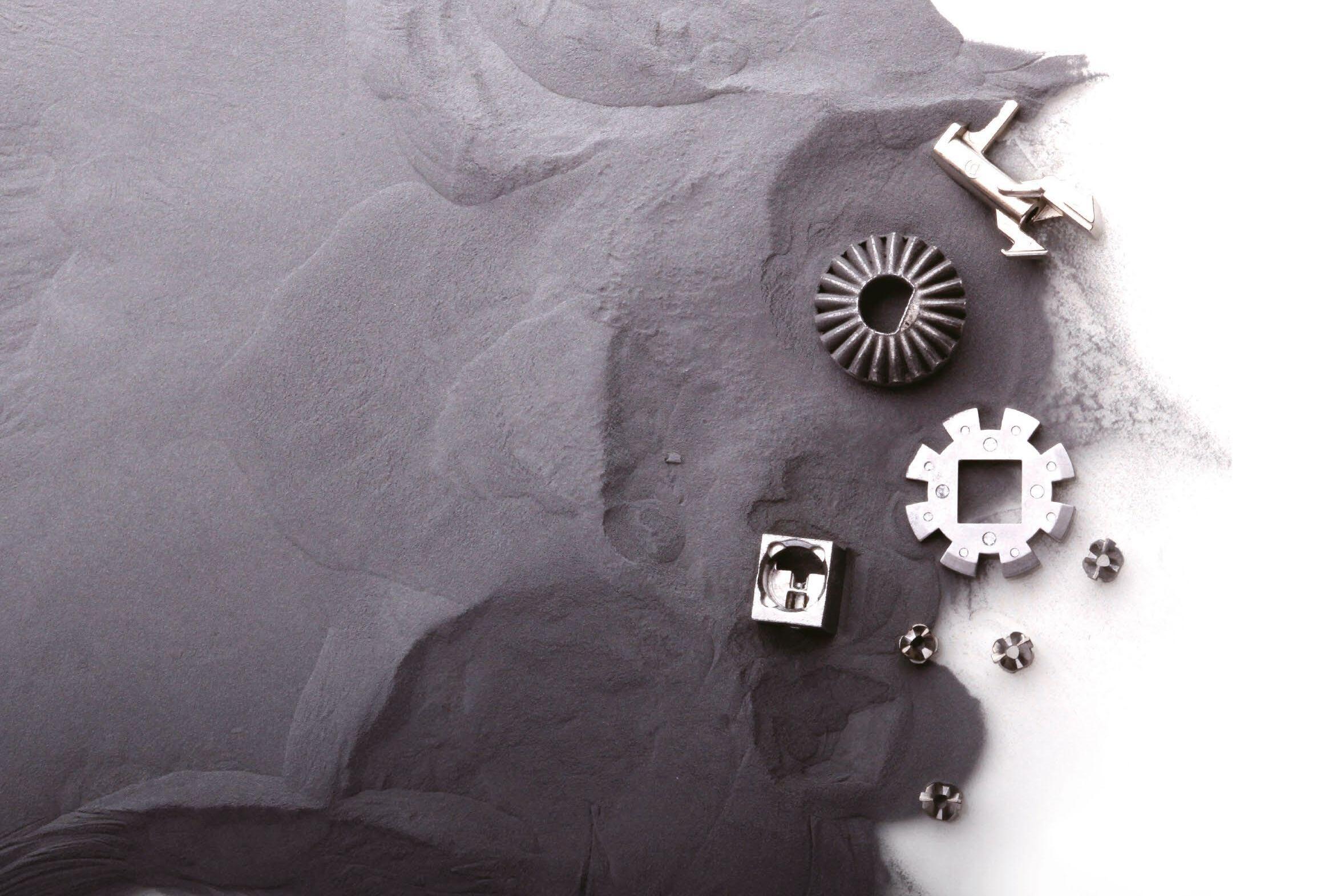
SINCE
•
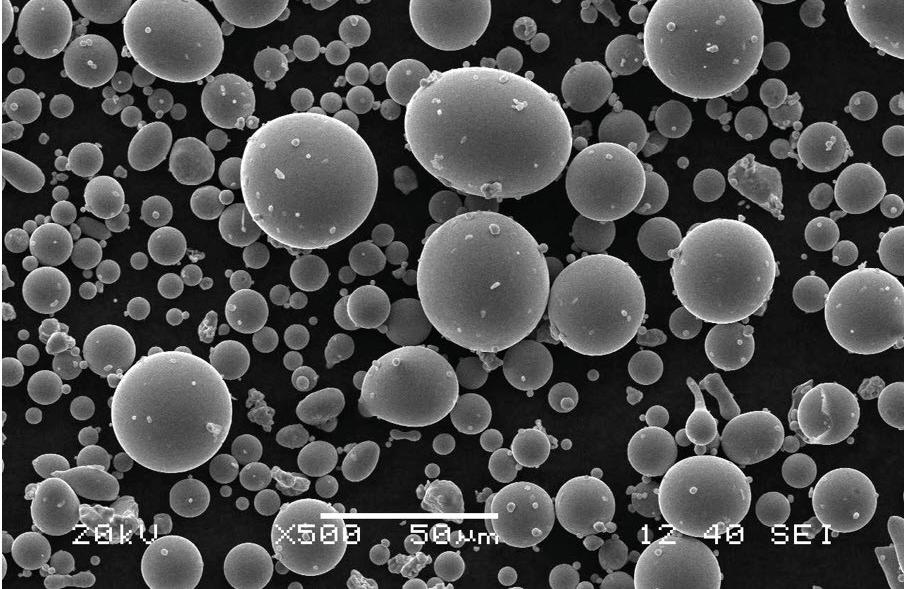
Lithoz presents improved ceramic AM bone replacements
Lithoz, based in Vienna, Austria, has announced LithaBone HA 480. The human bone-like ceramic material was developed via cooperation with users of earlier bone substitute materials for ceramic Additive Manufacturing, with the end goal of making this material more economically viable.
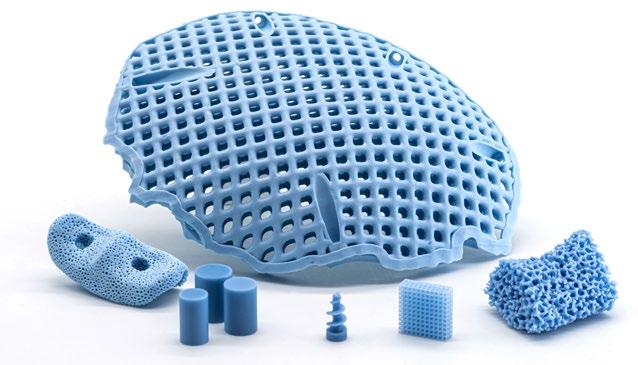
In medicine, ceramics can be considered ideal materials for devices and implants due to their biocompatibility, low thermal conductivity, and lighter intrinsic weight. Most importantly, however, certain ceramics can be resorbed by the body, eliminating the risks connected to second surgeries. The wide range of bone structures in the body necessitate that ceramic materials for bone replacement fully cover this range and are biocompatible and resorbable. The planned interaction of the bone substitute material with adjacent bone and tissues depends on the optimised design of geometries which – accordingly – determines clinical success, as bone regrows along the material’s guide structures and the ceramic dissolves in the body.

KLS Martin, a German medical technology company, has been a highly important user of additively manufac -
tured bone substitute implants since 2015. LithaBone HA 480 and the specification of the development goals were ultimately a direct outcome of customer feedback from this collaboration.
“We at KLS have been producing CMF implants for human use on our Lithoz CeraFab printer since 2015, with excellent results in terms of accuracy of fit, tolerability and healing success,” stated Adem Aksu, Director Development Biomaterials at KLS. “We already have had the chance to work with HA 480 and the results are outstanding: from mechanical properties over higher wall thickness to size and lattice structures, LithaBone HA 480 has convinced us of a considerable improvement compared to its predecessor.”
Lithoz’s new ceramic bone replacement material
LithaBone HA 480 offers several improvements from earlier iterations, including:
• Significantly higher wall thicknesses – a key requirement for versatility reasons. With LithaBone HA 480, previous maximum wall thicknesses of < 1.6 mm (LithaBone HA 400) have been increased to 10 mm, while minimum wall thicknesses required have been reduced even further, expanding the range of applications
• More precise imaging accuracy of fine structures. In line with the strengths of LCM, one clear goal was to offer a higher level of ultra-precise resolutions and highly complex structures when working with hydroxyapatite. LithaBone HA 480 shows strongly reduced overpolymerisation with a simultaneously improved depth of cure, resulting in a simpler selection of build parameters and a significantly more stable manufacturing process
Ten-fold longer shelf life, which eliminates the obstacle of previous materials’ short shelf life impacting on availability required for urgent surgical interventions
• Parts are significantly easier to clean, making up valuable time during often vital medical interventions. Experienced users have confirmed significantly faster and easier cleaning processes thanks to an improved binder composition.
www.lithoz.com
Emery Oleochemicals launches LOXIOL metal filament
Emery Oleochemicals, Düsseldorf, Germany, launched its new LOXIOL metal filament products for Additive Manufacturing at Formnext 2022. The LOXIOL metal filament products expand the company’s offerings to the AM market for Fused Filament Fabrication (FFF), a Material Extrusion (MEX) process.
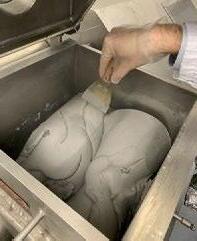
LOXIOL metal filament products eliminate complicated powder management issues, and enable 100% of the metal powder to be converted to the final part as support structures can be recycled. The FFF process itself, complementary to MIM, also offers quick and cost-efficient part production.
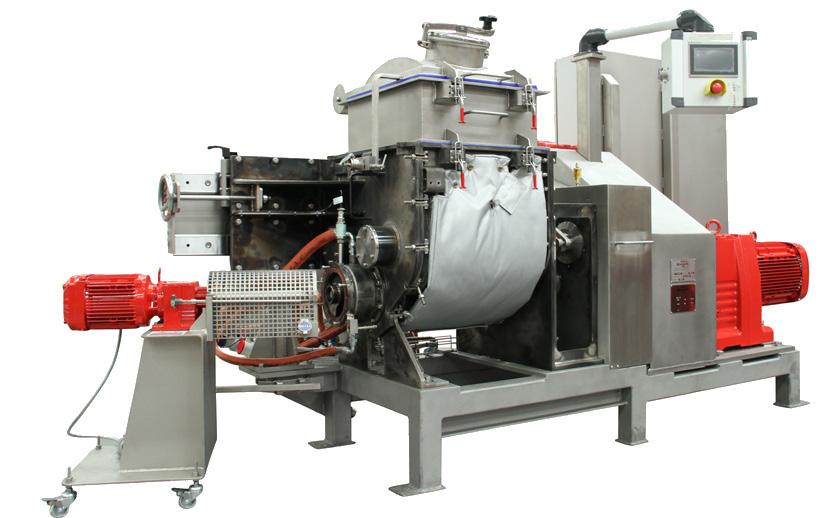
Emery’s LOXIOL metal filaments portfolio is comprised of five mate -
rials and each will be available in diameters of 1.75 mm and 2.85 mm. The materials include the following:

LOXIOL 316L: The parts exhibit high corrosion resistance, toughness, and ductility, as well as high acid resistance. This combination is said to be well suited to a wide range of applications in aerospace, automotive, energy, jewellery, medical, marine, and other industries.
LOXIOL 17-4 PH: The components made of LOXIOL 17-4 PH material have high corrosion resistance and high strength, a combination well suited to medical applications such as surgical instruments.
LOXIOL 718: The nickel-chromium alloy is suitable for use with high temperatures and corrosive conditions. Components additively manufactured using LOXIOL 718 have good tensile, fatigue, creep and fracture strength at temperatures up to 700°C, making them suitable for many high temperature applications such as gas turbine parts, medical instruments or parts for the power and process industries.
LOXIOL Copper: This high-purity copper offers good electrical and thermal conductivity making it suitable for a wide range of applications.
LOXIOL Ti-6Al-4V: TI-6Al-4V is a well-known light alloy, which is characterised by excellent mechanical properties and corrosion resistance combined with low weight and biocompatibility.
www.emeryoleo.com
More companies join ColdMetalFusion Alliance as turnkey JobShop and LabSystem solutions announced
The ColdMetalFusion Alliance has announced that a number of companies have now joined, offering a range of services to users of the technology. The alliance also announced two turnkey solutions are now available for those looking to establish either an Additive Manufacturing production line or bring AM product development and small-series production in-house.
The ColdMetalFusion Alliance is a consortium of companies with experience in the fields of sintering, Additive Manufacturing, and tradditional industrial manufacturing. Together, the alliance’s members provide services, equipment, material, software, and expertise to customers in the metal manufacturing industry.
The ColdMetalFusion process is built around well-established and robust technologies, including polymer-based Laser Beam Powder Bed Fusion (PBF-LB/P), solvent debinding, sintering and postprocessing. By integrating metal powder into a highly functional binder system, all metals used in Powder Metallurgy are available. The part is additively manufactured at low temperature (< 80°C) on standard PBF-LB/P machines, melting just the plastic-binder. No support structures are necessary in the build process itself, which also enables the parts to be placed freely in the build box. After a de-powdering stage, the high strength of the bound green part enables mechanical post
processing, such as turning, milling, etc, before the sintering stage. The final steps follow the MIM process, with a debinding and sintering stage resulting in the final part.
Members of the ColdMetalFusion Alliance contribute on the specifications of their area of expertise, to increase the overall quality for all users. Including those joining over the last few months, the list of members now includes: Lömi
• MIMplus
• element 22
• headmade materials
• Bernstein
• Miba
• Pres-X
• Farsoon Technologies
• AM Solutions
• Carbolite Gero
• Nippon Gases
• Sintratec
JobShop and LabSystem
Both the CMF JobShop and CMF LabSystem include the necessary machines to produce additively manufactured components from a wide range of metals.
The CMF JobShop is aimed at production centres and machine shops. The solution is compatible with 316L Stainless, Ti-6Al-4V grade 5, 17-4 PH stainless and M2 tool steel. The JobShop consists of:
• HT252P production-level Laser Beam Powder Bed Fusion
machine from Farsoon, with a 60 W CO 2 laser in a 250 x 250 x 320 mm build envelope.
• A fully automated, closed-loop 50 litre debinding station from Lömi, featuring an integrated solvent debinding, drying and solvent recycling station. It is optimised for CMF binder-component extraction with solvent
• A high-temperature sintering furnace optimised for ColdMetalFusion from Carbolite Gero. The chamber measures 240 x 240 x 400 mm, operates at a maximum temperature of 1600°C and enables 100% hydrogen processing
The CMF LabSystem is intended for fast application and process development. This solution is compatible with 17-4 PH stainless, M2 tool steel, H13 tool steel and Inconel 625. The LabSystem consists of:
• Sintratec S2 modular PBF-LB machine from Sintratec, with a cylindrical build space of 160 mm (diameter) x 400 mm. The starter cell can be expanded as needed and includes a material handling station for depowdering.
• A 30 litre debinding machine from Lömi features an integrated solvent debinding and solvent recycling station.
• Tube sintering furnace optimised for ColdMetalFusion from Carbolite Gero. The furnace has two heating zones and is equipped with additional heat shielding. The tube measures 300 mm x 180 mm (diameter) and operates at a maximum temperature of 1300°C
www.coldmetalfusion.am

Uniformity Labs releases 17-4 PH stainless steel powder for Binder Jetting
Uniformity Labs, Fremont, California, USA, has announced the availability of its ultra-low porosity 17-4 PH stainless steel powder for the Desktop Metal Shop System Pro BJT machine. Developed in-house, the high-performance metal powder is said to deliver superior material properties, sintered part geometric accuracy, process yield and print uniformity with high throughput.
Uniformity Labs states that the 17-4 PH powder exhibits a typical tap density of 5.33 ± 0.05 g/cm 3 A high – and highly repeatable –sintered density of 7.68± 0.03 g/cm 3 and in-build brown density deviation of +/- 0.024 g/cm 3 is said to deliver uniform sintering shrinkage across the bed. Brown density across builds, batches, and in-spec
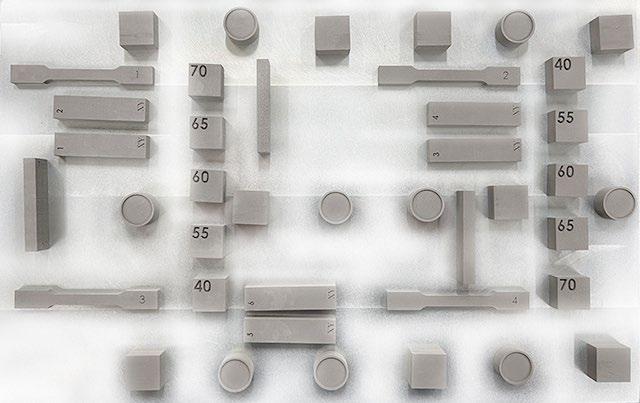
process and environmental parameters averages 4.49 +/- 0.05g/cm 3 , reportedly delivering at better than 95% confidence levels inclusive of batch-to-batch, spread, build, cure, de-powder, and sinter sources of variation, a highly uniform sintering shrinkage of 15.17% ± 0.65% in the X direction, 15.66% ± 0.65% in the Y direction and 18.18% ± 0.63% in the Z direction. This low and stable shrinkage allows the Binder Jetting of comparatively large parts, up to tens of centimetres in length.
The process stability is said to be enabled by the low-cohesion, low-porosity powder that repeatably spreads uniformly across the build bed. The high brown densities result in up to 50% reduction in linear shrinkage relative to
competitor materials and repeatably deliver 99-100% final part density. An additional benefit of low shrinkage is increased throughput due to greater use of the build volume. The flowable powder is said to further improve throughput by allowing repeatable fast layering, with a net throughput benefit of approximately 50% relative to non-Uniformity powders on comparable platforms, thereby enabling substantial cost reduction to be taken advantage of by parts manufacturers contemplating adoption of metal Additive Manufacturing at scale.
17-4 PH is a martensitic precipitation hardened stainless steel, known for its corrosion resistance and high strength and hardness levels, especially when heat treated. 17-4 PH can be heat treated to various hardness and toughness levels, allowing users to customise the post-sintering properties of the alloy to suit a wide variety of applications, such as chemical processing, manufacturing machinery, and food processing.
“The application of Uniformity17-4 PH stainless steel for BJT delivers mechanical and process excellence for our customers who require materials that perform to the highest standard across each step of the production process,” stated Adam Hopkins, Uniformity founder and CEO. “Our powders deliver superior mechanical properties, surface finish, printing yield, and process stability, allowing one machine to do the work of several.”
www.uniformitylabs.com

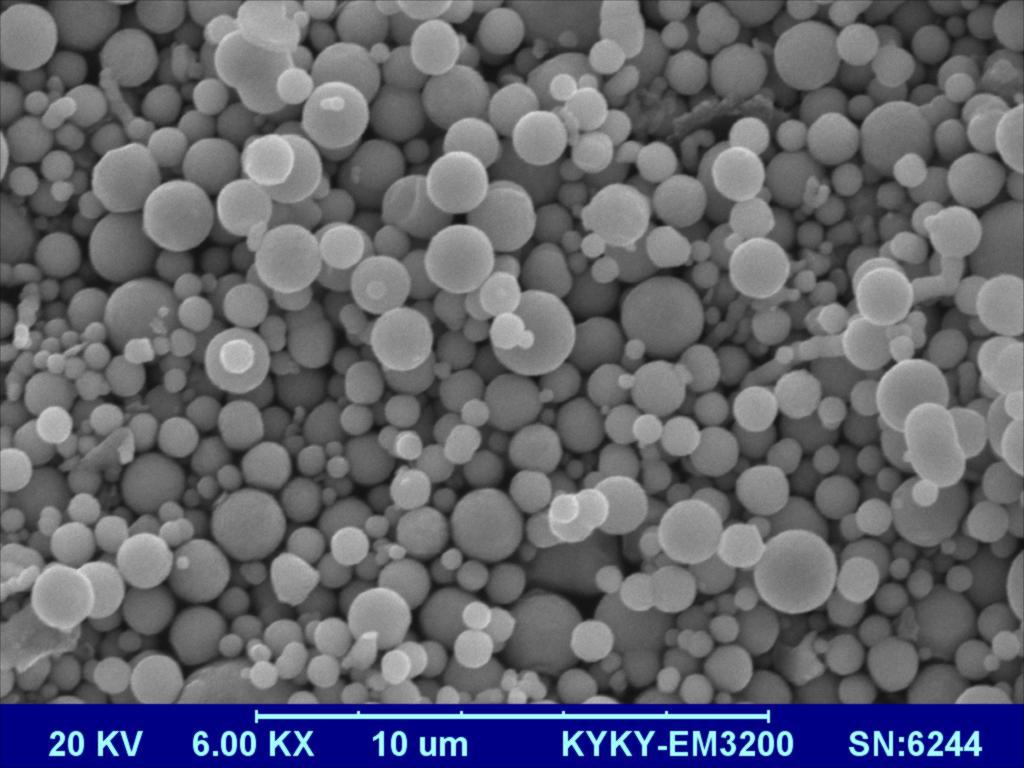
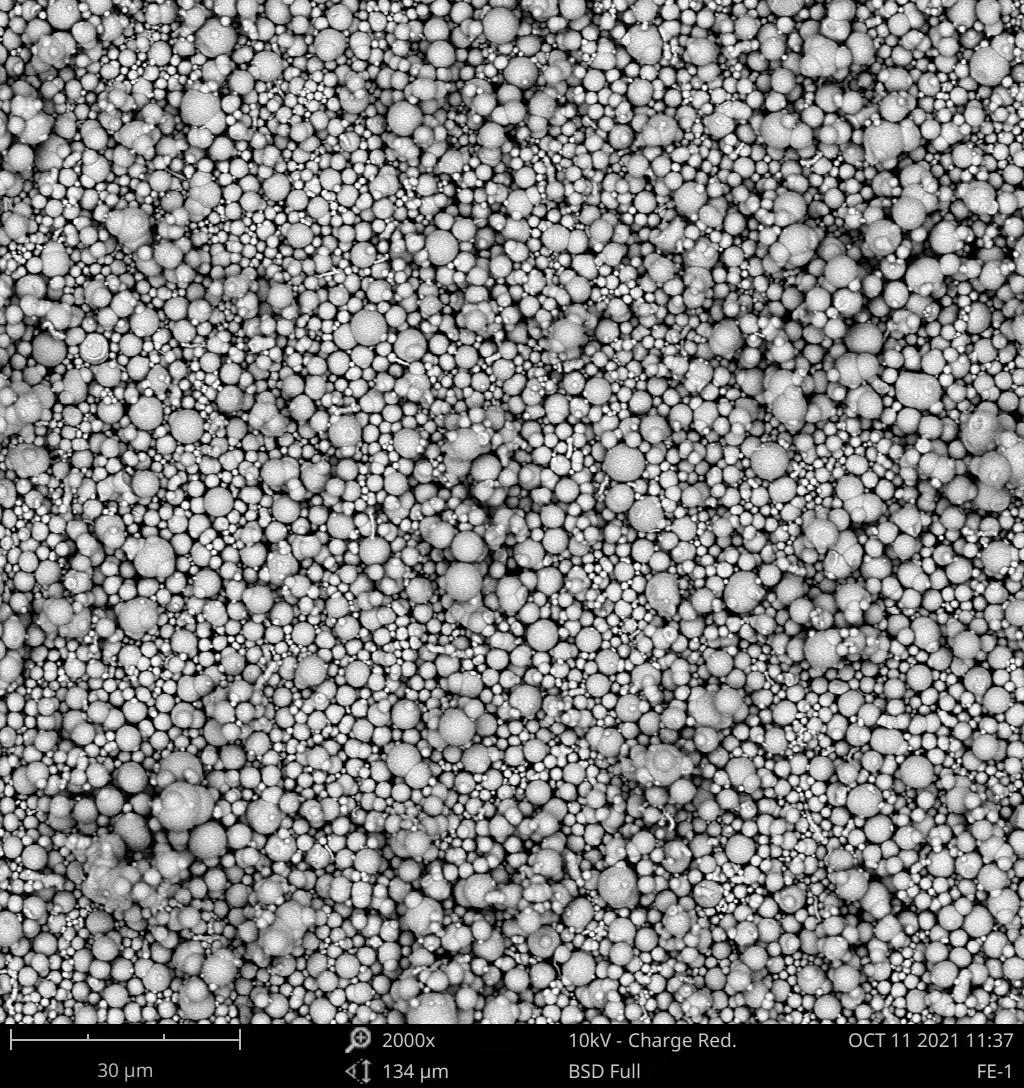
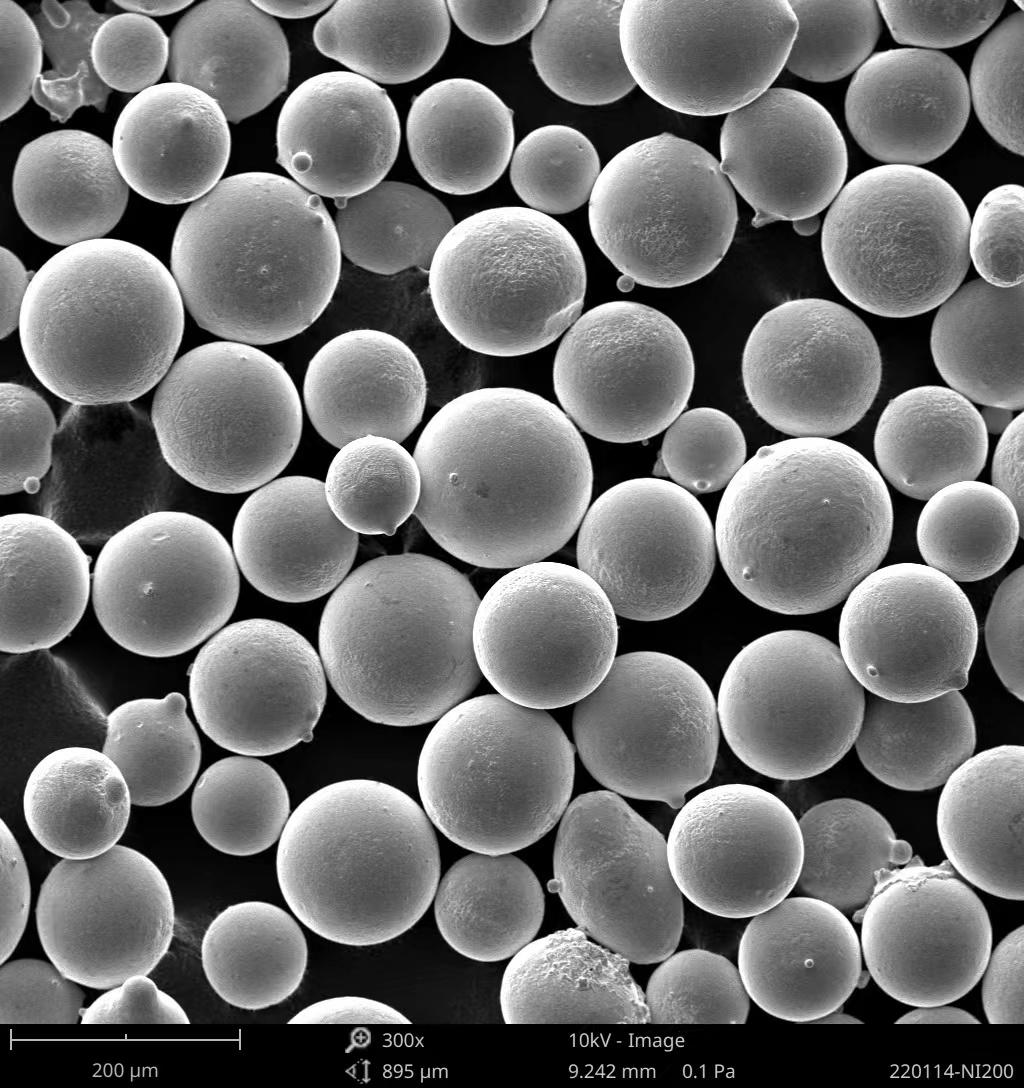
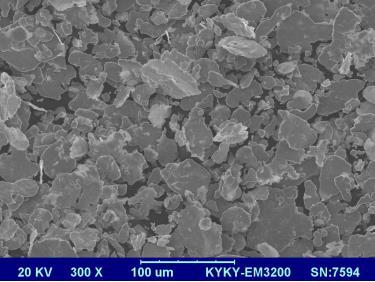
Self-lubricating porous 17-4 PH stainless steel parts produced by MIM
Powder Metallurgy has long been used to produce porous parts, such as self-lubricating bronze and iron-based bearings, by powder compacting and sintering, where the porosity can be filled with a lubricating oil to give the porous bearings a low coefficient of friction (COF) and high wear resistance in a wide range of applications. Now, researchers at the University of Eastern Finland and Karelia University of Applied Sciences, both in Joensuu, Finland, have used Metal Injection Moulding to produce porous parts from 17-4 PH stainless steel. The porous 17-4 PH parts are impregnated with paraffin wax to provide the required self-lubricating properties. The researchers – M Kultamaa, K Monkkonen, JJ Saarinen, and M Suvanto – recently presented the results of their work in a paper published in Tribology International,
Vol. 174, 2022, which indicated that new types of porous, self-lubricating stainless steel components with low COF can be produced by MIM.
The authors reported that the martensitic, precipitation-hardened polyMIM 17-4 PH stainless steel powder was mixed with sodium chloride (NaCl), with a size distribution of 200–315 μ m, as the space holder material. The amount of NaCl ranged from 10, 20 to 30 wt.%. 1 wt.%
paraffin wax was also added to the mixture to increase the flowability of the polyMIM 17-4 PH feedstock containing high added amounts of NaCl during injection moulding. Injection moulding parameters for the rectangular test pieces with NaCl content and a cylindrical pin specimen without NaCl are summarised in Table 1. As can be seen in the table, specimens with 30 wt.% NaCl required a higher moulding temperature (210°C), as well as longer moulding time and higher pressure to compensate for the higher viscosity and lower flowability of the feedstock
The Best Sintering Furnace You’ll Ever Own!
Our experienced team is ready to solve your toughest thermal processing challenges and will design, manufacture, install and maintain the Best Sintering Furnace you’ll ever own.
CONTACT US TO LEARN MORE ABOUT OUR VACUUM FURNACE SOLUTIONS

mixture. The chosen parameters ensured the complete filling of the mould cavity and, consequently, an even sample quality between the different porosities, which was controlled by the amount of NaCl in the feedstock mixtures.
Debinding of the moulded parts was first carried out in a distilled water bath at 60°C for 20 h to remove the NaCl space holder material and the water soluble part of the binder material in the original powder feedstock. The brown parts were then dried at 100°C for 2 h. Porosities based on mass loss (%) of the moulded 17-4 PH stainless steel parts before and after debinding are given in Table 2.
Any residual binder was removed from the parts during the sintering stage, which was done at up to 1350°C in a hydrogen atmosphere.
Fig. 1 shows cross-sectional SEM images of the internal pore structure of the porous sintered 17-4 PH stainless steel samples. The amount of space holder material (NaCl) with 10 wt.% (a) resulted in 23.2% porosity, with 20 wt.% (b), 38.4% porosity; and, at 30 wt.% (c), porosity of 48.2% was observed. Porosities of the sintered MIM porous parts were calculated from the densities and the average density of the non-porous, 0 wt.% samples was regarded as a reference point. Density of the used paraffin was 0.90 g/cm 3
The resulting porous sintered 17-4 PH stainless steel parts were subsequently heated to 100°C and immersed into molten paraffin wax for 15 min to allow impregnation of
NaCl (wt.%) Before debinding (g) After debinding (g) Mass loss (%)

Table 2 Porous 17-4 PH sample masses before and after debinding (Courtesy Kultamaa, M, et al., ’Self-lubrication of porous metal injection molded (MIM) 17-4 PH stainless steel by impregnated paraffin wax’, Tribology International, Vol. 174, 2022, 12 pages)
the open porosity. Excess paraffin wax on the surface of the porous, impregnated 17-4 PH samples was cleaned off using N-heptane to ensure that the lubrication resulted only from the paraffin stored in the open porosity of the samples.
Dynamic COFs of porous and non-porous 17-4 PH stainless steel specimens were measured in dry sliding and paraffin lubricated conditions. Cylindrical non-porous 17-4 PH pins with a spherical tip were used as static friction partners. Each test was carried out at least three times and on different test specimens to ensure repeatability and consistency of the results. Normal loads of 10 and 30 N were used with a sliding distance of 100 m.
The authors reported that paraffin significantly reduced the sliding friction coefficient for all sintered 17-4 PH porous samples under normal loading of 10 N. The lowest COF values were recorded for the samples with 20 wt.% and 30 wt.% NaCl. The paraffin impregnated into the open porosity of the porous 17-4 PH samples was found to be solely responsible for the reduced
sliding friction. The authors also noted that, although the amount of paraffin impregnated into the 10 wt.% porous samples was low compared to the 20 wt.% and 30 wt.% samples, it was sufficient to lower the friction significantly (COF = 0.15). The COF values for 20 wt.% and 30 wt.% samples at 10 N normal loading were at approximately 0.07. COF values with a normal load of 30 N for the sintered porous 17-4 PH specimens impregnated with paraffin were found to be similar to the results with a 10 N load.
The conclusion of this research showed that 20 wt.% porosity was the best for a balanced structural integrity of the sintered porous 17-4 PH stainless steel, with its ability to store lubrication in its porous structure and lubrication performance. The authors expect that this research will open up opportunities for the development of new types of self-lubricating stainless steels produced by metal injection moulding for high-wear applications.
www.sciencedirect.com/journal/ tribology-international

Supersolidus liquid phase sintering applied to complex MIM Ni-base superalloys with high refractory metal content
Supersolidus liquid phase sintering (SLPS) has already been successfully applied to difficult-to-sinter metal injection moulded superalloys such as IN718, reaching high sintered densities in a short sintering time. However, the successful applica -
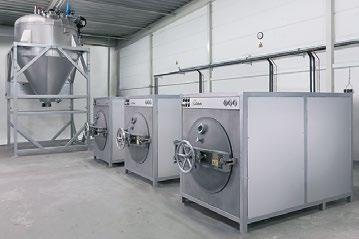
tion of SLPS requires a thorough understanding of the liquid phase behaviour with sintering time and temperature. For example, sintering a material above its solidus temperature reduces part strength and rigidity, which can lead to eventual
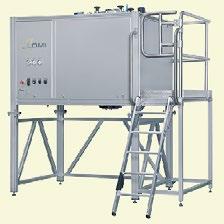
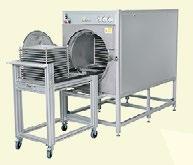


part distortion and slumping if the incorrect SLPS conditions are employed. The application of SLPS is further complicated by the fact that optimal processing windows for densification and shape retention can vary significantly for different material conditions (i.e., powder size and composition), with some materials exhibiting SLPS windows of less than 10°C. This would appear to be especially the case in more complex MIM Ni-superalloys containing higher levels of carbon and refractory metals (RM), but there is a current lack of data for the SLPS of such superalloys.
There have been numerous studies on SLPS of Ni-superalloys, which have focused on modelling SLPS to predict the material response to time and temperature. However, these models do not consider the transient liquid behaviour of Ni-superalloys with a high RM content. Researchers at the Dalhousie University, Halifax, Canada, have undertaken work on this transient liquid response using Ni-based superalloy containing Al, Co, Cr, Ta, Ti, W and minor additions of other refractory metals – designated as NiSA – and incorporating this transient liquid response into a generalised SLPS model. A paper outlining the results of research carried out by AJ Rayner and SF Corbin has been published in Metallurgical and Material Transactions A, Vol. 53A, August 2022.
The authors stated that an existing generalised model was aimed at predicting the onset of densification and distortion based on the sintering temperature, liquid fraction, and physical properties of the IN718 superalloy. They modified this model to account for time-dependent densification and distortion, then compared the results to experimental measurements using differential scanning calorimetry (DSC). The authors had reported in an earlier published paper on the use of DSC to evaluate the SLPS behaviour of a MIM NiSA and had also determined that the
MIM NiSA has a melting range 12701385°C. The modified model is also said to incorporate the influence of microstructural coarsening on the SLPS’s behaviour. Macroscopic observations of part rigidity as a function of sintering temperature and time were also completed to validate the new model predictions.
MIM plates, measuring 3.65 mm in height and approx. 3.5 x 3.5 mm square, were sectioned from green parts produced by an industrial partner, and delivered to Dalhousie University for debinding, sintering and DSC. The top and bottom faces of the MIM plates were not altered to maintain a consistent sample height and good contact with the bottom of the DSC crucible. Thermal debinding was done in a tube furnace under an argon gas atmosphere at a heating rate of 4.5 K/min followed by two isothermal debinding steps at 180°C and 850°C in an inert powder support medium. The debound samples had a theoretical density of 57% after the debinding cycle. Debound MIM NiSA samples were then heated in flowing argon gas to SLPS temperatures of 1335°C, 1340°C, 1345°C, and 1350°C. The sintered samples were isothermally held for 0, 15, 30, 60, and 120 minutes to measure the grain size over the SLPS hold time.
The authors reported that macroscale images demonstrated the extent of slumping and deformation with increasing SLPS time and temperature. The sample held for 15 minutes at 1350°C was deformed to a much larger extent than the sample held for 120 minutes at 1340°C. The sample held for 120 minutes at 1350°C exhibited the largest amount of slumping and shape loss. In contrast, the samples held at 1340°C demonstrated the ability of SLPS to achieve good shape retention below a critical liquid fraction.
Fig. 1 shows the microstructures of SLPS MIM NiSA samples sintered at 1345°C and for various hold times. It shows the time dependence of distortion, since the MIM samples retained their shape at 15 minutes, experienced edge rounding at 30 minutes and exhibited some
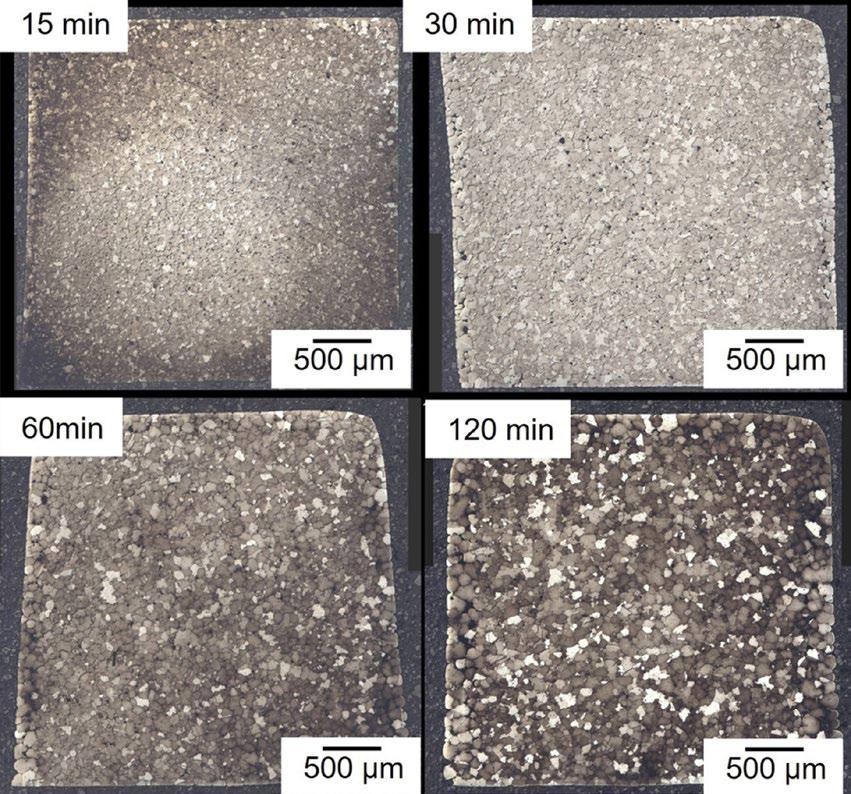
60 and 120 min hold times
Samples are oriented such that gravity is acting down (Courtesy Raynor, AJ and SF Corbin, ‘Sintering Time Dependent Supersolidus Liquid Phase Sintering Behaviour of a Metal Injection Molded Nickel-Base Superalloy’, published in Metallurgical and Material Transactions A, Vol. 53A, August 2022)
slumping and distortion at 60 and 120 minutes. The samples exhibited approximately 10% shrinkage during solid state sintering, which occurs during heating to the SLPS hold temperature. The samples are above 98% dense upon reaching 1345°C, and additional densification due to sintering shrinkage is said to be limited.
Fig. 1 also shows the grain growth, which the authors stated to be closely related to the liquid fraction, given its similar power-law relationship with hold time. Based on this observation, the grain coarsening of the MIM NiSA also exhibits a time dependency. Both the liquid fraction and grain size were found to be dependent on temperature as well as time in the case of MIM NiSA, a feature that has not been reported in the literature for other SLPS PM superalloys.
The authors stated that, when the behaviour of both the grain size

and liquid fraction over time and temperature were incorporated into the modified SLPS model, they were able to determine the instantaneous softening parameter of the material and onsets of both densification and distortion. The modelled results predicted that no deformation will occur at 1340°C for hold times under 120 minutes. The model also predicted that distortion will begin to occur after 40 minutes at 1345°C and immediately upon MC carbide dissolution at 1350°C. Macroscopic observations of shape retention support the modelled results, indicating that the modifications made to the model for this MIM NiSA are appropriate. The authors concluded that it was necessary for metallurgists to have thorough knowledge of an alloy’s behaviour above the solidus temperature when attempting to apply SLPS as a consolidation technique for geometry-critical processes such as MIM.
www.springer.com/journal/11661
Defining when filament-based MEX could replace Metal Injection Moulding



In recent years, there have been a number of advances in metal Additive Manufacturing technologies, making them attractive alternatives to both subtractive manufacturing processes as well as net- or near-net shape processes such as Powder Metallurgy and Metal Injection Moulding. This is particularly the case for metal components with higher levels of complexity, which would benefit from weight saving possibilities and require a relatively low volume of parts. It is well known that MIM is capable of producing highly complex shapes and at required production volumes using a wide range of metals and alloys to achieve the desired part performance and cost. However, MIM is considered relatively expensive in terms of energy and investment in production equipment and tooling. Competing with MIM are a number of metal AM processes, but many of these, such as Laser Beam Powder Bed Fusion (PBF-LB) are also high energy users with often lengthy production times and are not thought to be suitable for low-value parts or for high part volumes.
One metal AM process attracting the attention of producers is material extrusion (MEX), the ISO/ASTM






term for the process referred to as Metal-ME in the reviewed paper, because of its flexibility and potential for producing complex shapes with lower investment costs compared with MIM. MEX has recently been adapted for extruding metal filaments - for example, AISI 316L and 17-4 PH, with feedstock for the filaments comprising 80 wt.% stainless steel with a 20 wt.% polymer content, which allows easy printing. MEX also shares a common stage of the production chain with MIM – namely, debinding and sintering. The two processes are said to have the ability to produce complex geometries, high-density parts (98.7% for MEX and 99.2% for MIM) and the possibility to use several different metals and alloy materials.
In order to gain more information on which of the two processes has the best commercial potential, University of Bergamo, Dalmine, Italy, has carried out a study which aimed to develop a cost model for a selected part produced by MEX and MIM. The model included the evaluation of the MEX and the MIM processes production cost trends, investigating how these processes can be characterised by different
behaviour as a function of the production volume and the number of parts obtained within a single production cycle. The results of this study were included in the paper ‘Additive manufacturing of metal filament: when it can replace metal injection moulding’ published in Progress in Additive Manufacturing
The authors of the study –Mariangela Quarto and Claudio Giardini – stated that, although MIM and MEX may both be successfully used to produce a specific part, it is the economic aspects, such as the expenditure of time, money, and resources (including energy) related to the whole production chain, which must be considered. The results of their study has, therefore, made it possible to develop a model for the study of the part unit cost, the productivity rate, and the dummy time (DT). Dummy time is said to represent how many hours are theoretically necessary for producing a single part.
The process chain for the two manufacturing processes is shown in Fig. 1 and involves three stages. The first stage mainly involves costs related to the time spent on the design of the product and/or of the mould (for MIM) and for defining the tool/nozzle path (for MEX). These costs are considered hidden ones (except for the mould used in MIM,

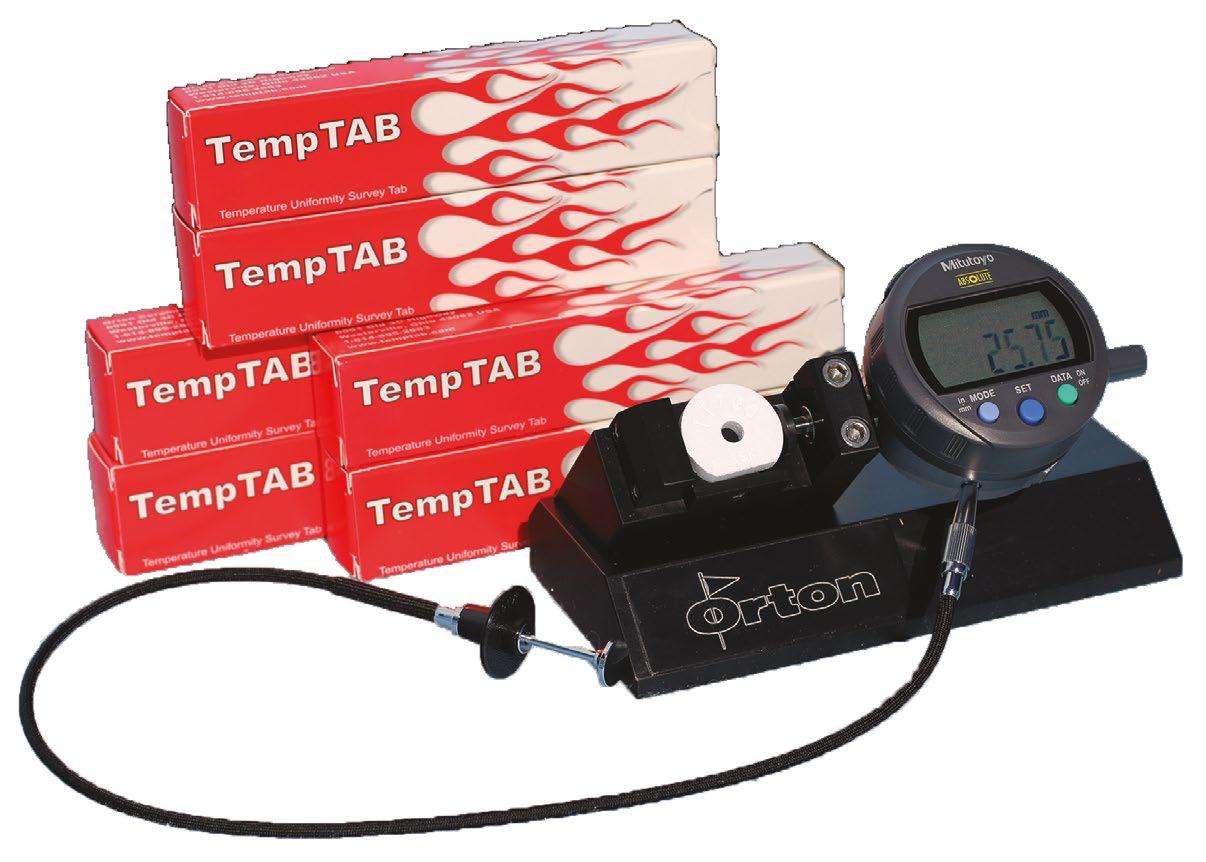
which is included in the consumable costs). The second stage involves actual part production to the green part stage and the third stage is omitted in the cost model, because
the same type of material is used and the same external company is performing the debinding and sintering and will, therefore, have the
It is evident from the first stage that the time interval from conceptualisation of the part to the start of production is significantly shorter for MEX taking 2-3 days to define the tool/nozzle path for Additive Manufacturing. For MIM, the process is longer, since the design, the optimisation (even through simulations) and the realisation of the mould are fundamental prerequisites. These activities could take between 10-15 woking days for not very complex parts, and could be longer if the complexity level of the components and, consequently, of the mould increase. The authors stated that the duration is strictly related to the requirements of the designed part.
The authors further stated that a key challenge in component design and production is weight reduction or improving the cooling of critical components. A number of researchers have used turbine blades as an example, by generating a hollow structure for weight reduction and external micro-holes for improving cooling. Both MEX and MIM are considered suitable technologies for turbine blade production. However, only MEX allows hollow turbine blade parts to be produced in a single process, whereas similar hollow features could not be realised by the MIM process and the micro-holes for improving the cooling of the parts would require additional micro-EDM machining.
The design of the 316L stainless steel turbine blade used in this study is shown in Fig. 2. The turbine blade produced with cooling holes and internal hollow structure using MEX shown in Fig. 2 (a)) resulted in a mass/volume reduction of 24%. The authors stated that it would be impossible to produce the same internal hollow features and the cooling holes in the MIM turbine blade without additional machining processes.
Table 1 shows the main data inserted into the cost model. As can be seen in Fig. 3 for both
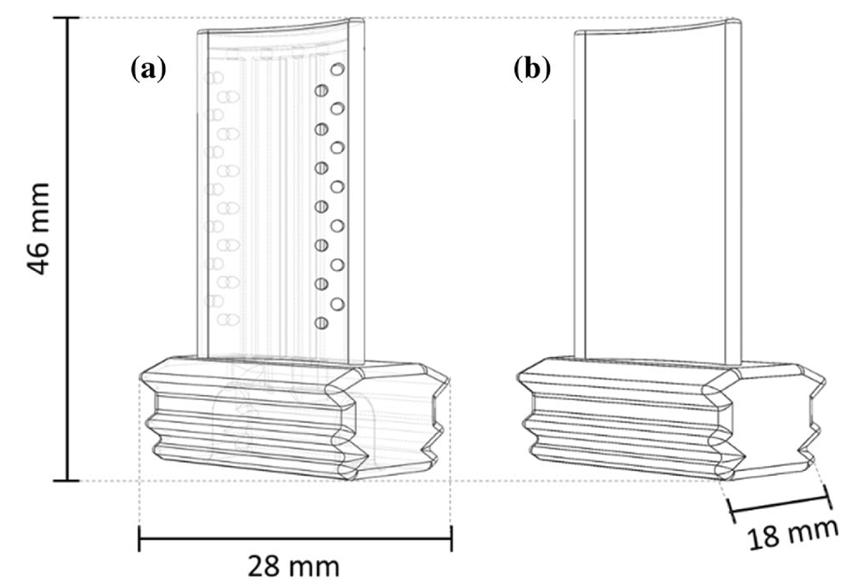
The No.1 MIM powder manufacturer in China

中国最大MIM粉末厂家,始于1996
Produc a on process: Water-gas combined atomiza a on, Gas atomiza a on
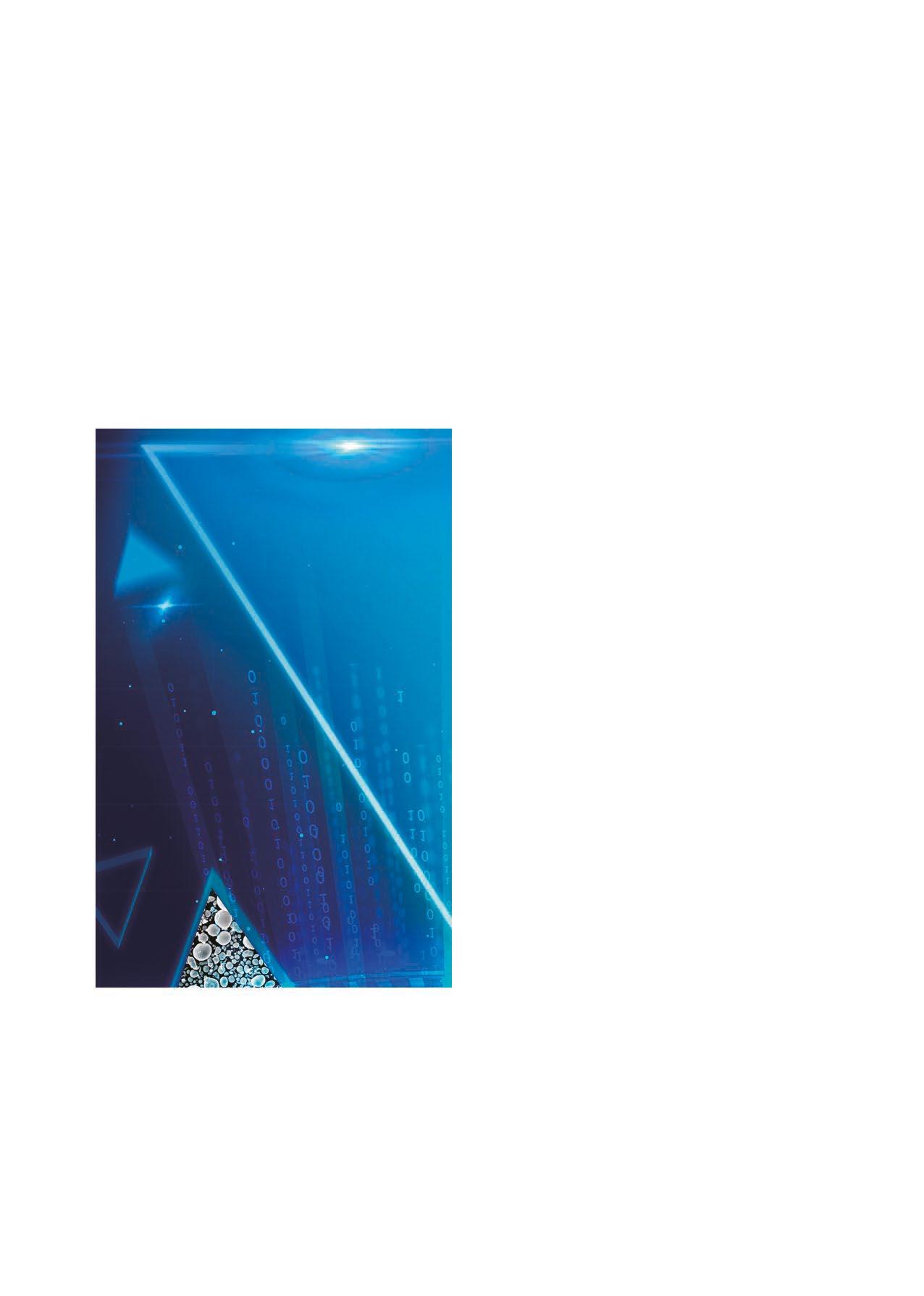
powder : 304L 316L 17-4PH and F75
Main applica a on industry: MIM, 3D prin a ng etc
MEX and MIM, the increment in N ord (defined as the size of the customer order) causes a reduction in the unit cost (UC), generating a monotonous decreasing curve. For MEX, it is evident how the first part of the curve is characterised by a rapid decrease of the cost as the production volume increases, presenting an almost horizontal asymptotic trend (i.e., the cost becomes approximately constant). The situation is different for the MIM process, which is characterised by a more slowly decreasing trend. In the zoomed area, shown
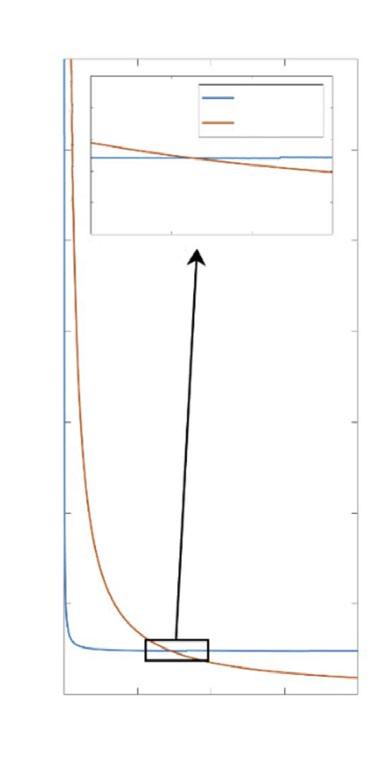

in Fig. 3(a), the inversion of the economic convenience for the two technologies is evident. A second analysis of the costs looked at the number of parts produced in a single working cycle. In MEX Additive Manufacturing, more than one part on the same plate will reduce the total time due to the set-ups, while the cost will remain constant. For MIM, increasing the number of mould cavities does not necessarily reduce production costs, but will considerably reduce production times. However, MIM turbine blades will
require further micro-EDM machining of the external cooling holes and the MIM parts cannot be produced hollow to achieve weight savings. The result is that, with the need to use the microEDM machining process for the cooling holes, the cost curve for MIM moves upward and the authors were able to draw a window defining the maximum and minimum costs of the combined process. At this point, it became evident from the cost study data that MEX becomes the less expensive solution, regardless of the production volume.
www.springer.com/journal/40964

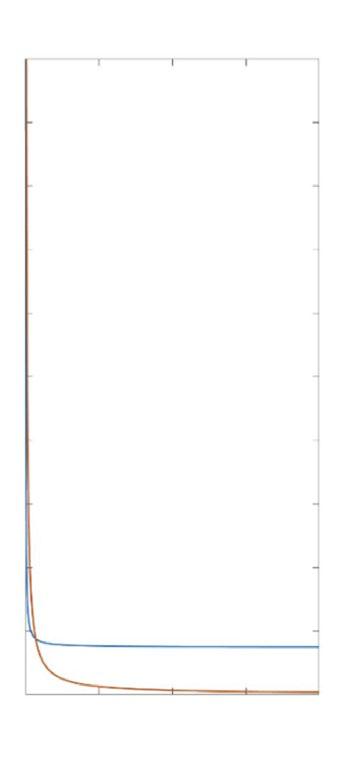
CHINA’S LEADING SUPPLIER OF MIM POWDERS

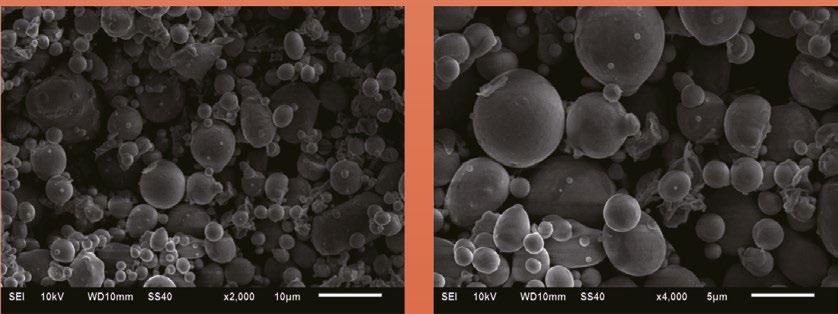

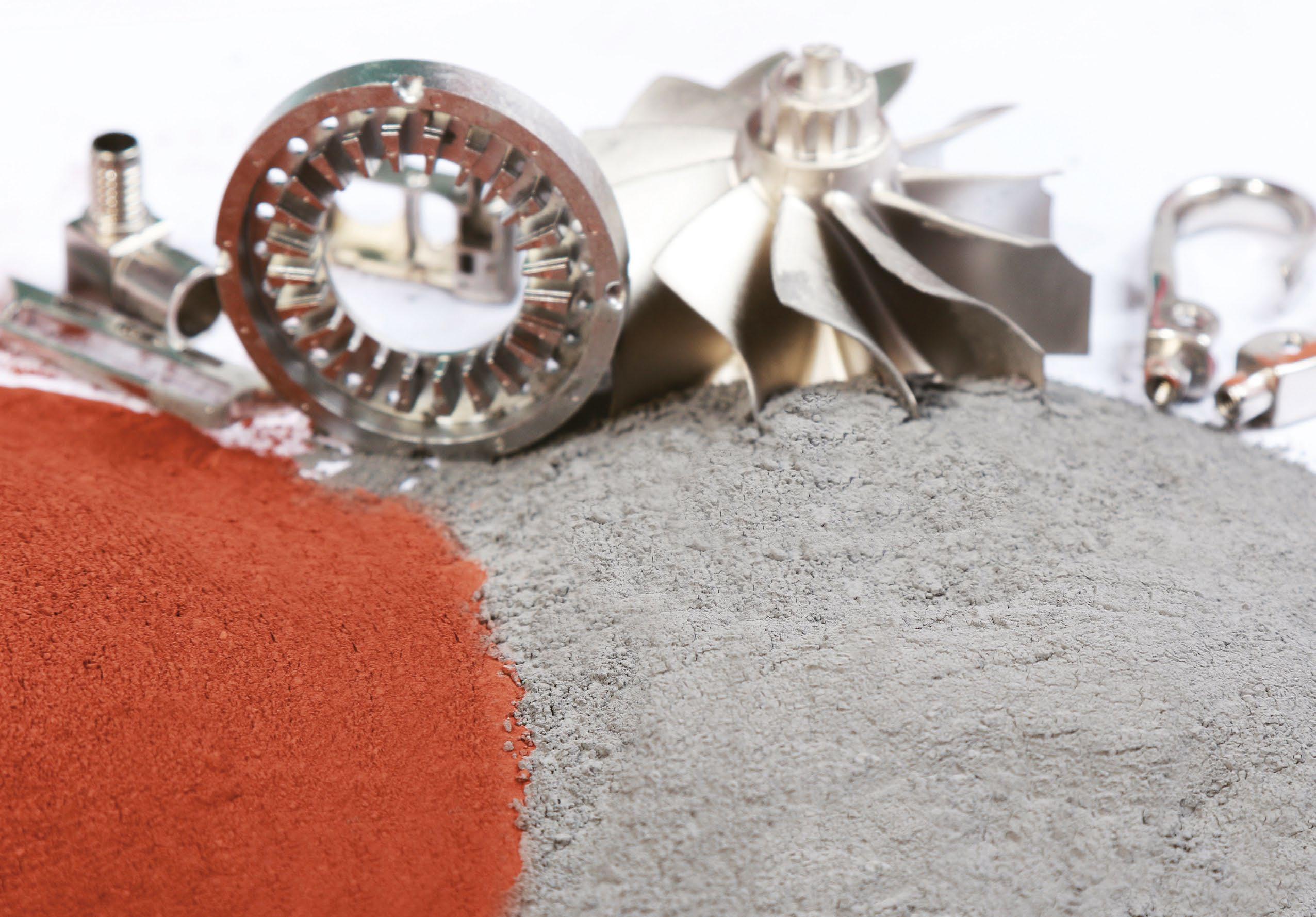
ADOPTING ADVANCED GAS AND WATER
COMBINED ATOMIZATION TECHNOLOGY
Mass production potential for PIM superhydrophilic copper surfaces
Superhydrophilicity refers to the phenomenon of excess hydrophilicity (attraction to water) and, in superhydrophilic materials, the contact angle of water is equal to zero degrees. Such materials have various advantages and can be used, for example, to defog or self-clean glass. Hydrophilic metallic surfaces have also been widely studied for use in several practical applications, including pool boiling heat transfer,
water sanitation, water harvesting, and corrosion protection. Hydrophilic metallic surfaces are usually fabricated by micromilling and laser machining processes. However, these machining processes have a low production rate and are unsuitable for mass production.

Research carried out at the Pohang University of Science and Technology (POSTECH), the Smart Manufacturing Technology R&D

Group at the Korea Institute of Industrial Technology (KITECH), and the Convergence Research Center for Flat Optics and Megaphotonics (Pohang), all based in the Republic of Korea, has been investigating using Powder Injection Moulding to produce hydrophilic micropatterned copper surfaces on a mass production basis. The results of this research have been published in the journal Powder Technology , July 2022, with the authors Hanlyun Cho, et al., and showed that superhydrophilic micropatterned copper surfaces could be produced by PIM without any defects on a mass production basis.
The authors reported that polymethylmethacrylate (PMMA) was used as the sacrificial tool insert material to achieve the desired micropatterned copper surface during injection moulding because PMMA can be readily removed by immersion in a solvent. PMMA sacrificial mould inserts can be fabricated by photolithography. The height of the final micropattern can vary depending on the thickness of the PMMA layer. The micropatterns are restricted to 2D patterns because the photolithography process is unsuitable for 3D patterning.
A spherical copper powder, having a median particle size (D50) of 4.43 μ m, was mixed with a waxpolymer-based binder for 3 h at 160°C to produce the PIM feedstock. Optimum solids loading in the feedstock was established as 56 vol.% and the feedstock was mixed three times to provide a homogeneous mixture. Feedstock – at a temperature of 160°C – was injection moulded into a square mould cavity having a length of 12.5 mm and thickness of 0.7 mm. Various sacrificial mould inserts were placed in the mould cavity to shape the micropatterns. Plain surfaces without micropatterning were also produced by injection moulding without an insert for comparison. Mould temperature was maintained at 50°C and an injection pressure of < 80 MPa was used.
The PMMA sacrificial mould insert was removed by dissolution in acetone at 50°C for 3 h and the PIM binder system was removed by solvent debinding and thermal debinding steps. The debound parts were then sintered in a tube furnace in a hydrogen atmosphere at 1030°C for 1 h to reach a sintered density of over 90%. The selected processing conditions resulted in defect-free micropatterned surfaces and the authors stated that mass production could be achieved by scaling up the debinding and sintering steps by using a continuous furnace.



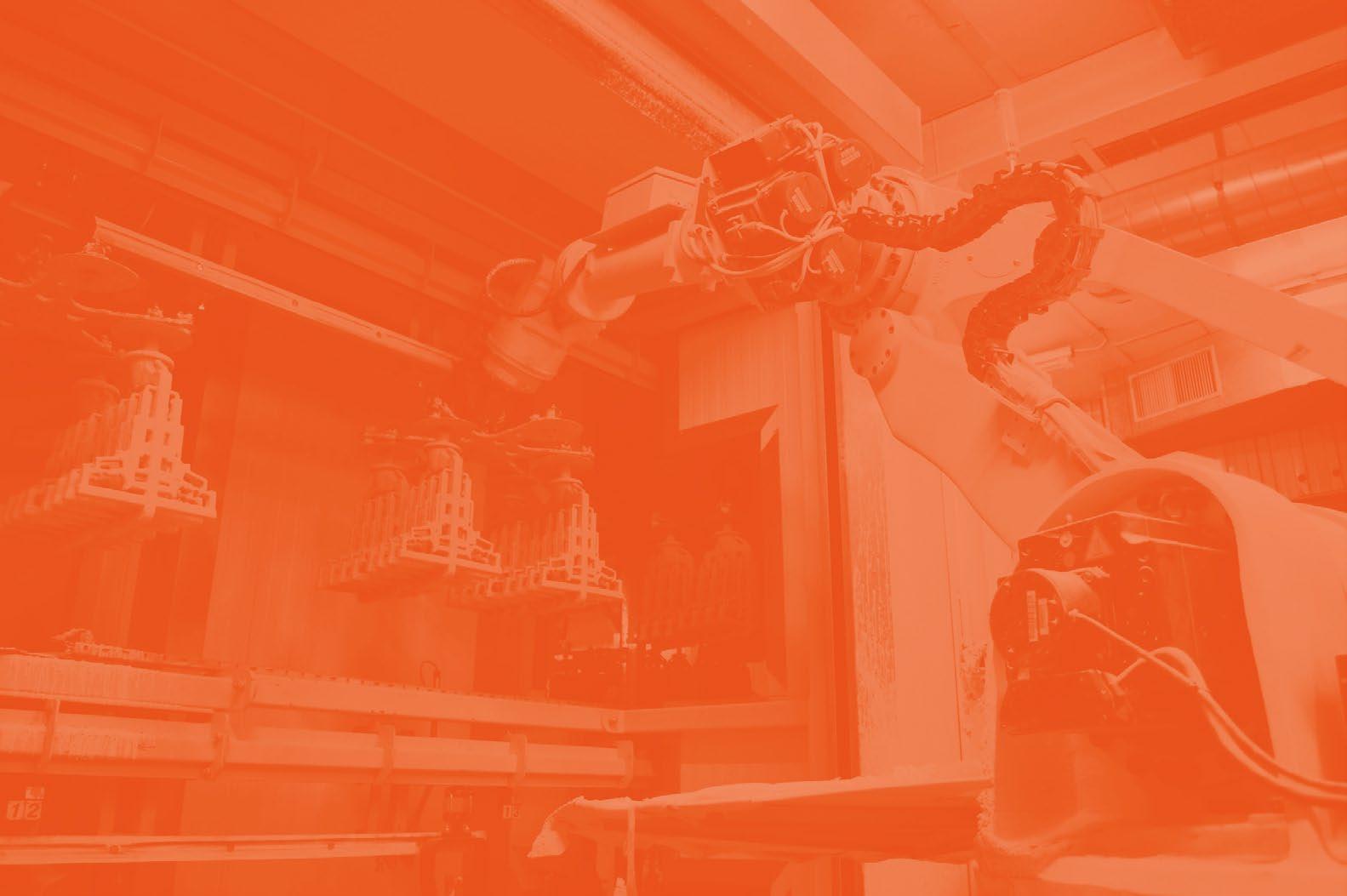
A selection of the PIM micropatterned copper surfaces are shown in Fig. 1 and the dimensions of the surfaces, as measured from SEM images, are listed in Table 1. SEM images of the superhydrophilic surfaces obtained in this research are shown in Fig. 2.
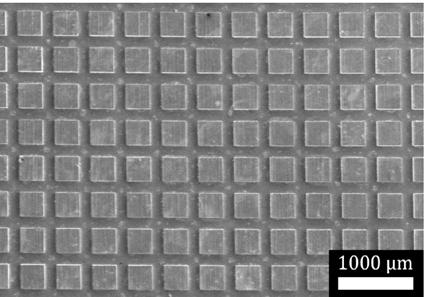

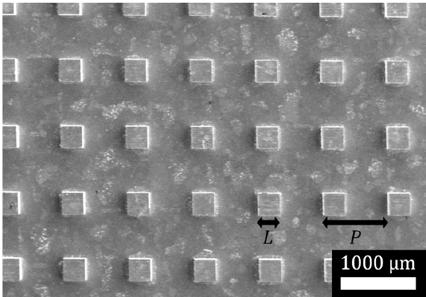
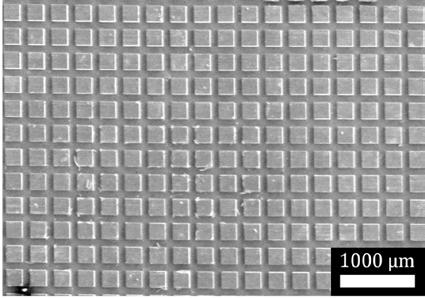
30 +1.2m 4
years of MIM experience pieces per month continuous lines for debinding and sintering
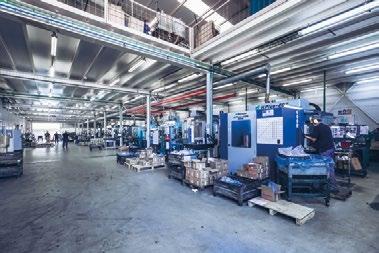

The authors also investigated the wettability of the manufactured PIM surfaces by measuring the apparent contact angle. They found that the apparent contact angle tends to decrease as the absolute value of the difference in effective surface free energy between the wet and dry states increases. When the absolute value of the difference is equal to or exceeds 150 mJ/m 2, the surface is fully wetted immediately and exhibits superhydrophilicity. Both high aspect ratio and small gap size are key to achieving superhydrophilicity of the micropatterned copper surface.
The authors are therefore confident that superhydrophilic micropatterned copper surfaces can be obtained by PIM, even though the micropatterns are restricted to 2D. Furthermore, because PIM exhibits a good material flexibility, it may also be possible to manufacture the superhydrophilic micropatterned surfaces using other materials, such as stainless steel.

www.sciencedirect.com/journal/ powder-technology
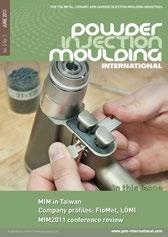
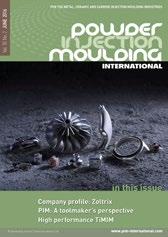


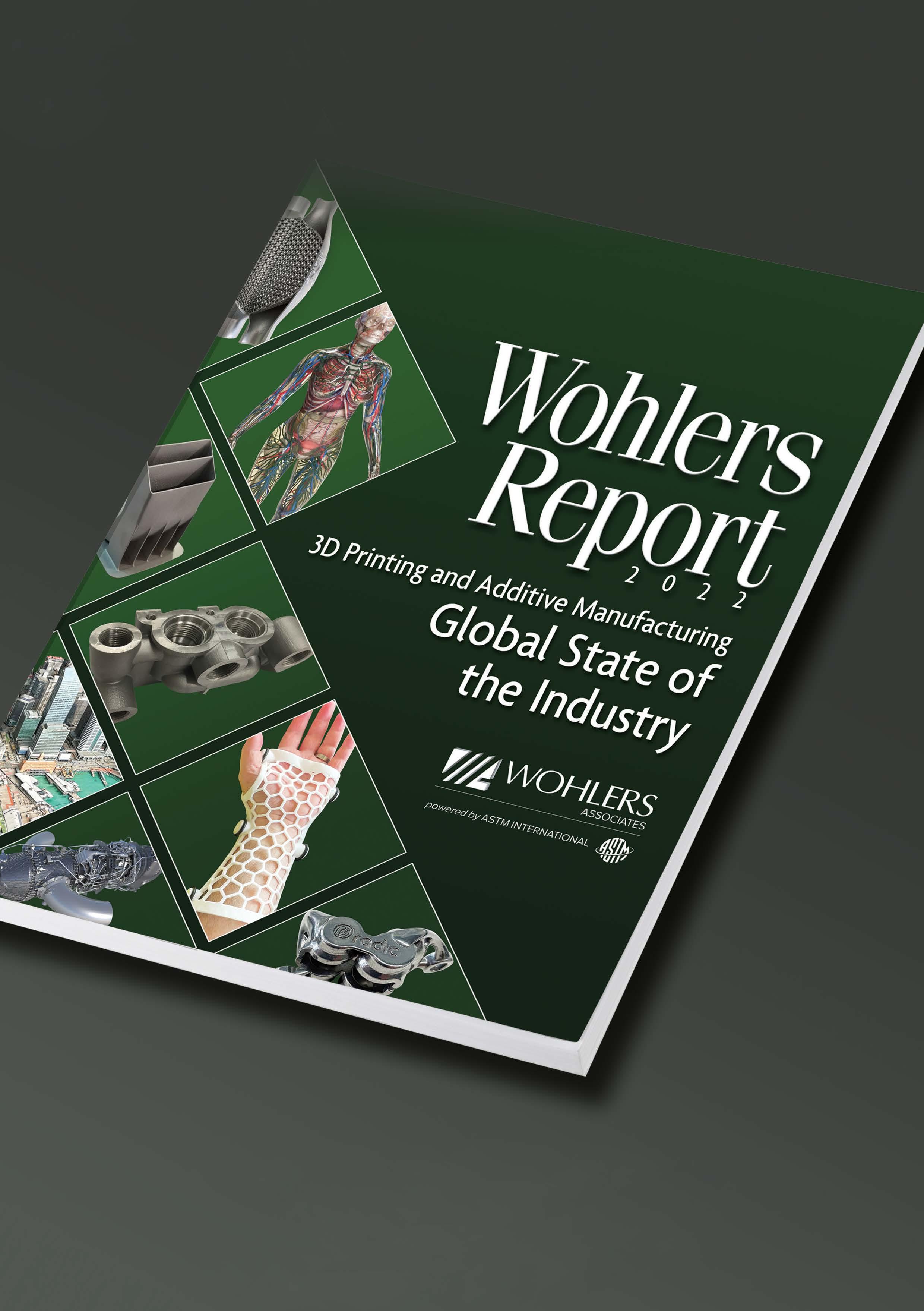





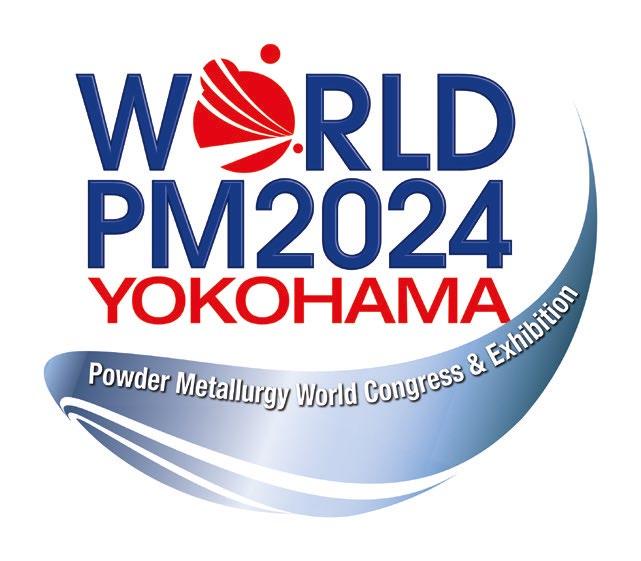
Global Markets for Metal Injection Moulding: Data and insight from World PM2022 and beyond
How has the global Metal Injection Moulding industry weathered the most turbulent years in recent history, and what has the impact been on MIM’s key markets worldwide? In this overview, PIM International ’s Nick Williams reports on market data presented at World PM2022, the first Powder Metallurgy World Congress since the COVID pandemic, held in Lyon, France from October 9-13. This is supplemented by other available data sources and insight from conversations with industry leaders at the event.
The PM World Congress series has, for many years, presented a rare opportunity to speak face to face with a significant number of Metal Injection Moulding industry suppliers and part producers from around the world, to get a feel for the direction the industry is going in, and to understand the opportunities that companies are seeing as well as the challenges that they are facing. Combined with some usually hard to come by data from the congress’s ‘State of the PM Industry’ presentations from different world regions, combined with insight from Special Interest Seminars, a picture can emerge of the health and prosperity of the MIM industry.
The 2022 World PM Congress & Exhibition, organised by the European Powder Metallurgy Association (EPMA), was the latest event in this series, bringing over 1,000 visitors from the Powder Metallurgy industry to Lyon. Unfortunately, COVID restrictions in China prevented attendance from the world’s largest MIM part producing nation, and a more general reluctance to travel from other parts of
Asia and North America – be it for health concerns or reduced travel budgets – resulted in a gathering that felt significantly more regional than past world congresses. Nevertheless, despite the majority of attendees coming from within Europe, the organisers reported that fifty-six countries were represented.
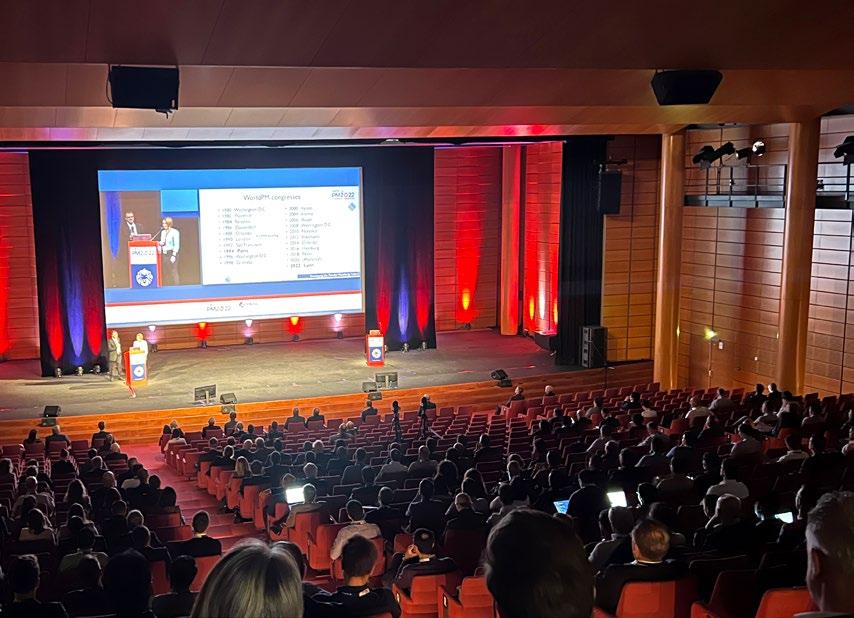
Ahead of arriving at the congress, and in light of a global economy rocked by COVID and, later, Russia’s invasion of Ukraine, I had limited expectations about how upbeat conversations with MIM producers would be, and what industry statistics would reveal. Once on site, however, it became clear that the

sales in Europe 2010-2021
MIM industry had not only bounced back from the hit to production that COVID triggered in 2020, but that it was thriving.
The status of MIM in Europe
Fig. 2 shows that MIM sales in Europe bounced back in 2021 from a COVID-related dip, showing a sales increase of 22% from 2020 and breaking the €500 million mark for the first time in the technology’s history. Expectation is that 2022 will show continued growth on 2021.
Europe's MIM markets 2021
There are multiple reasons for such a positive current position. One European industry professional explained that it had been a “remarkable year” for MIM in the region, with new entrants in the market, but more importantly, with MIM “enjoying increased recognition in the automotive sector as a new generation of vehicles are designed and parts are becoming ever more complex.”
This is especially the case for electric vehicles, where entirely new vehicle platforms offer the chance to design for MIM from the start, reducing part weight, increasing functionality and complexity, and potentially combining what would have been multiple components into one. Other sources also confirmed that Tier 1 and Tier 2 suppliers are taking a serious look at MIM for numerous new applications, again primarily for next-generation automotive applications.
Of course, the hard reality of the past two years is that, whilst potential new applications exist, those MIM producers most closely tied to the automotive industry faced the biggest challenges as COVID and the supply chain crisis impacted automotive production. But the above reports bode well for the future of a sector that is crucial for the European MIM industry.
What could be interpreted as an increasing interest in MIM from the automotive industry coincides with increased confidence of MIM producers in their own process capa
bilities. One European MIM producer explained that, in recent years, it has been able to successfully produce complex parts in high volumes that not so long ago would have been regarded as too challenging - thanks to advances in the quality and capability of MIM feedstocks, processing technology and simulation software.

Another factor behind the upbeat mood of European MIM producers is reshoring. One MIM producer stated that “reshoring is having a visible and very positive effect on MIM production in Europe, with parts coming back to Europe from China and India.” There were also suggestions that MIM’s end-users went through a restocking programme in 2021 –perhaps even overstocking – as they tried to anticipate future consumer demand.

Within Europe, a key market for parts made by MIM and Ceramic Injection Moulding is luxury products – including components for high-end watches and leather goods. “Right now, people are buying luxe, and demand for PIM parts is extraordinary,” stated one producer.
Fig. 3 shows a breakdown of the European MIM market by sector based on sales. Automotive, firearms and medical remain the largest markets – however, as Fig. 4 clearly shows, 2021 recorded a drop in the value of the automotive sector, whilst the value of the medical sector increased. Whether this is a sign of more permanent changes in the market for MIM parts in Europe remains to be seen, as supply chain challenges such as the semiconductor crisis were largely responsible for reducing automotive volumes in the period. The market for internal combustion engines (ICEs) continues to decline, however, with diesel’s share of the market falling from 27.9% to 19.6% in 2021, and petrol from 47.6% to 40%. Currently, MIM parts are used for both powertrain applications and other automotive applications such as suspension systems, sensors, thermal management and interior fittings, so the impact of the switch to vehicle electrification remains to be seen.
Putting European MIM into context in his World PM2022 plenary presentation, Ralf Carlström, EPMA president, stated that the value of MIM parts accounted for 4% of PM-related parts production in Europe in 2021 by sales. The most valuable PM product segment was hard materials, accounting for 30% of the total market value of PM parts due to the high price of raw materials, followed by PM structural parts/bearings at 25%, diamond tools at 16%, sintered magnets (12%), PM semi parts (8%), HIP parts (3%) and AM parts (2%). However, the growth in value of MIM part sales in 2021,
at 22% over 2020, outstripped PM structural parts production (11.4%), HIP (20%), and AM (15%) in 2021.
What is not fully apparent in these charts is the growing value of the aerospace industry for MIM in Europe. As reported in PIM International , Vol. 13 No. 3, September 2019, Schunk Sintermetalltechnik GmbH is one example of a European MIM producer that has found success in manufacturing a new generation of high-performance MIM components that are now flying in Rolls-Royce aero engines, with an example being IN713LC superalloy stator vanes
“MIM parts are used for both powertrain applications and other automotive applications such as suspension systems, sensors, thermal management and interior fittings, so the impact of the switch to vehicle electrification remains to be seen.”Fig. 5 An example of MIM’s success in the aerospace sector. These IN713LC superalloy stator vanes produced by Schunk Sintermetalltechnik GmbH are now flying in Rolls-Royce aero engines. Parts shown after injection moulding (right), debinding (centre) and sintering (left) (Courtesy Schunk Sintermetalltechnik GmbH)
China's MIM markets 2021
China and Taiwan, with the latter accounting for around $300 million of sales.
As seen in Fig. 6, in 2021 the vast majority of China’s MIM parts went to the electronics sector, with the remainder delivered to automotive (4%), medical (4%), hardware (7%), and other industries (9%). Smartphone parts made up the majority of applications at 56%, followed by wearable electronics such as smartwatches at 12%, other applications at 9%, and computer components at 8%. In all, more than 75% of all MIM applications were for the consumer electronics industry.
The future for MIM in the crucial smartphone sector is somewhat unclear. Apple recently announced that it would be ending its use of the Lightning connector (Fig. 7) in favour of USB-C, a move that will result in the loss of an extremely high volume of MIM parts. However, the growing use of MIM components in elsewhere in smartphones, in tablets, laptops, smartwatches, headphones and headphone cases should offset these losses. Other MIM components that may also be at risk as smartphone designs evolve include volume buttons and SIM card trays. Opportunities for MIM hinges in any future folding devices could be significant. This would, however, depend on the continued growth in foldable device sales.
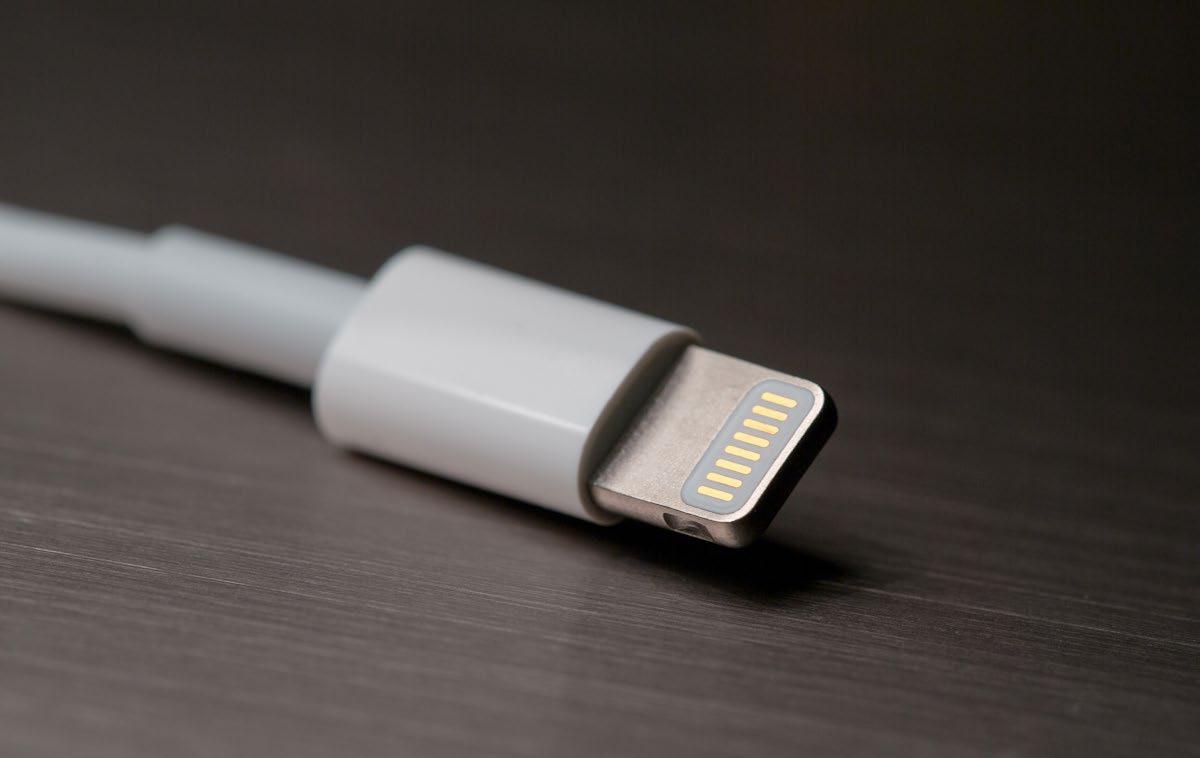
(Fig. 5). Alliance-MIM, a French MIM producer, is also reporting success in this area, with rotating MIM aero engine parts accounting for 25% of its MIM sales.
MIM in Asia
A picture of MIM in Asia was presented by Chiu-Lung Chu, president of the Asian Powder Metallurgy Association (APMA). The APMA is made up of the Japan Powder Metallurgy Association (JPMA), Japan Society of Powder and Powder Metallurgy (JSPM),
Korean Powder Metallurgy Association (KPMA), Korean Powder Metallurgy & Materials Institute (KPMI), Taiwan Powder Metallurgy Association (TPMA), China Powder Metallurgy Alliance (CPMA), China Powder Metallurgy Society, Powder Metallurgy Association of India (PMAI), and Thailand Powder Metallurgy Association (ThaiPMA).
The statistics presented in Chu’s overview were provided, separately, by these associations.
China and
Taiwan
Around half of global MIM production, about $1.5 billion, comes from
It was reported by Chu that the majority of MIM parts produced in Taiwan were also consumed by the consumer electronics sector (60%), while 17% went to transportation, 16% to industrial and 7% to other sectors.
Japan
The most comprehensive information on MIM in Japan was presented by Kenji Doi, Osaka Yakin Kogyo Co., Ltd, Japan, in a World PM 2022 Special Interest Seminar. His reporting was largely based on the JPMA’s 2021 Report for MIM Market . Doi stated that annual total MIM sales in Japan in 2021 were JPY 13.69 billion (approx $100 million) and he stated that sales volume had increased
over the previous year (Fig. 8). The JPMA collects what are believed to be the most detailed MIM industry statistics available, generated each year through a questionnaire sent to nineteen companies, including members and non-members. 2021’s figures are from data provided by all nineteen companies.
The value of Japan’s MIM sales in 2021 represents a 35.5% increase from the previous year. This, it was stated, was the result of the recovery demands in all markets following COVID-19, but especially in the strongly increasing demand for components for semiconductor manufacturing equipment. This is the first time since 2008 that MIM sales have passed the JPY 13 billion mark. “We have forecast that the strong demand of semiconductor manufacturing equipment parts will continue until the end of 2022, and the sales amount equal to or more than that in 2021 can be expected,” noted the JPMA report authors.
In terms of market breakdown, industrial machine parts accounted for 34.8% of sales (previous year: 29.3%), medical appliance parts accounted for 17.2% of sales (previous year: 18.2%) and automotive parts accounted for 13.1% of sales (previous year: 14.6%).
Highlighted growth areas included industrial robot parts, with high demand expected as a result of the drive to automate global production lines. The JPMA’s MIM report also stated that a reshoring of MIM production was being experienced in Japan, with COVID-19 and geopolitical issues driving a return to domestic production. Fig. 9 shows a detailed breakdown of the MIM market in Japan in 2021.
In terms of material usage, stainless steels accounted for 74.4% of production (previous year: 73.2%). Stainless steels, Fe-Ni materials and magnetic materials accounted for over 85% of production. The value of stainless steel MIM parts sales in 2021 was stated as JPY 10,193 million, a 36.4% increase from the previous year.
Japanese MIM sales 2015-2021
Japanese MIM materials 2021

Fig. 10 shows a detailed breakdown of MIM materials usage in Japan in 2021.
Whilst titanium MIM appears to be slow to develop in Japan, it was reported that developments relating to heat-resistant steels and spring steels are progressing. Concluding, the report stated that areas of highest concern were metal powder price increases and lead times.
India, Korea and Thailand
Application data was presented for these countries during the ‘MIM in Asia’ plenary presentation. India saw a fairly even split across the various MIM application fields, with electronics holding a market share of 30% followed by transportation and other industries at 25% each, and industrial at 20%. It is estimated that in 2021 India generated MIM sales of around $300 million, with Indo-MIM accounting for a significant proportion of this.
For Korea, the majority of MIM parts went to the automotive/ transportation sector (80%), and the remainder to industrial (15%) and electrical (5%). In Thailand, the majority of MIM use was in industrial applications (60%), 20% in electronics, and 20% in other fields.
The MIM industry in North America
Metal Powder Industries Federation (MPIF) President Rodney Brennen gave delegates a detailed overview of the state of the North American Powder Metallurgy industry during the World PM2022 plenary session. The North American Powder Metallurgy industry, he reported, had not been immune from the challenges facing the global supply‐chain, and continues to feel the negative effects of the COVID‐19 pandemic.
Speaking about the broad PM industry, including MIM, he stated that new production output levels are being achieved thanks to changes and innovations made because of the pandemic, and many companies report reductions in energy consump -
tion, furnace atmosphere gases, scrap, and waste that is sent to landfills as a direct result of operating more efficiently. He also stated that some companies have also replaced older equipment with the latest computer controlled Industry 4.0 technology. This ‘Internet of Things’ approach allows equipment to ‘talk’ to each other and learn the best parameters for the process, and automation within the industry continues to grow as a solution to the overall shortage of skilled workers. From pick‐and‐place robots to 100% vision system inspections, automation is expected to continue to increase.
By value, the MPIF has reported that US MIM sales reached $520 million in 2021 (Fig. 11). In terms of markets, the firearms sector continues to dominate US MIM parts production, at 41%, by weight, of parts shipped. This is followed by medical devices at 24% by weight.
Fig. 12 shows a full breakdown of US markets for MIM, based on an MPIF PM Industry Pulse Survey undertaken in August 2021. It should be noted that these US figures differ from those for Europe, China and Japan, where the market breakdowns are by sales value rather than weight.
Total 2021 North American metal powder shipments to the MIM and AM industries increased by an estimated 5–10% to between 3,934,767 and 4,202,178 kg. Of this amount, an estimated 360,000 kg is dedicated to AM. MIM and AM powder producers were reported to be seeing strong demands for materials. Generally, the materials of choice are stainless and low-alloy steels, but there is considerable developmental work being performed on aluminium, titanium, and an array of other metal powders and alloys. Fig. 13 gives a breakdown of North American MIM materials usage.
In his presentation on the North American MIM market in the Special Interest Seminar on Global MIM markets at World PM2022, Stefan Joens, Elnik Systems, stated that growth in the North American MIM industry was mirrored by growth in production equipment sales. He also
stated that new entrants were setting up MIM facilities in the US, and that many producers were now offering both MIM and Additive Manufacturing – with Binder Jetting being the most adopted AM process by MIM producers thanks to its potential for series production.
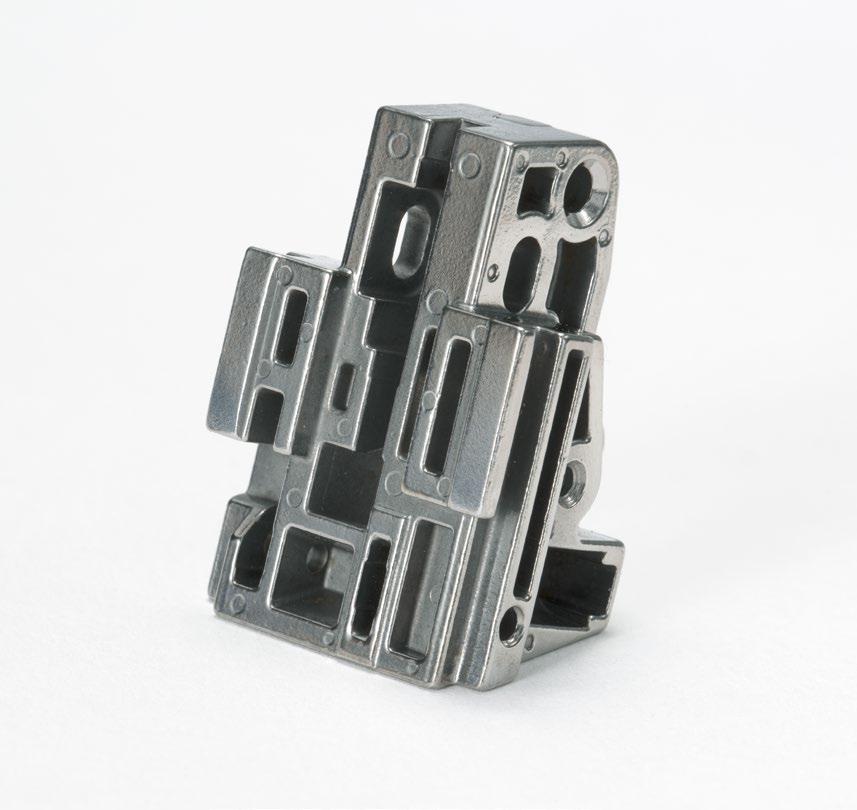
MIM materials insight

During his presentation on the European MIM industry in the World PM2022 Special Interest Seminar on Global MIM markets, comments by Paul Davies, Sandvik, UK, a leading supplier of gas atomised MIM-grade powders, mirrored the market data presented in terms of a global COVIDrelated dip in MIM production. He stated, however, that MIM powder shipments to Asia from Sandvik had reduced the most in 2020 and
2021 – during the COVID period – compared to the other regions. He added that, whilst Europe had benefitted with an increased share of MIM powder shipments, North America also rebounded strongly, with MIM powder shipments now levelling off to pre-pandemic levels.
Davies also explained that purchasing trends for metal powders have also changed since the pandemic, with customers looking to secure longer term contracts for stability of metal powder supply. MIM powder sales, he stated, continue to be dominated by stainless steels, in particular 316L and 17-4 PH.
Powder prices continue to be a concern for the MIM industry, with the gains brought by a more competitive marketplace offset by higher raw material costs, higher
energy prices and the high costs of the gases used during atomisation.
In terms of MIM feedstock developments, BASF SE, Ludwigshafen, Germany, promoted its new Catamold® THOR feedstock at World PM2022; a maraging ultra-high strength steel suited for parts that require the combination of strength and ductility/toughness. Target applications include MIM hinges and other high-performance structural applications. MIM hinges are seeing widespread adoption in the consumer electronics industry, in particular for laptops and folding smartphones, where the unique combination of component complexity, high production volumes and demanding tolerances play into MIM technology’s strengths.
There were also indications at World PM2022 that new entrants to the MIM feedstock market are on the horizon, including from companies based in Europe and Asia.
Outlook
This review covers a large proportion of the global MIM industry; however, sales figures for many MIM producing countries in Asia, South America and elsewhere are not included. The data for China, Taiwan, Japan, India, Europe and North America alone, though, suggest an industry with annual sales in excess of $3 billion.
The global MIM industry is in a strong position for continued growth. Whilst there is inevitably uncertainty due in large part as a result of war in Ukraine companies around the world are investing in production capacity. The most recent EPMA survey of MIM producers, the results of which are confidential but were presented during the EuroMIM meeting at World PM2022, provided evidence of investment in the European MIM industry to increase sintering capacity and for new injection moulding equipment.
Future growth is expected to come from both new applications as well as an expansion of existing markets. Additionally, MIM has never been in the headlines as much as it has with the rise of metal Additive Manufacturing, especially Binder Jetting. Has this heightened awareness driven business to the doors of MIM producers? Some believe so. Right now, MIM is far more capable of delivering parts to the necessary standards and volumes than any upcoming metal AM process. The reality is, however, that MIM remains a technology that is unknown to far too many designers and engineers and a concerted effort by the industry is required to improve this situation.
But what is certain is that the boundaries between MIM and sinter-based AM continue to blur. A significant percentage of MIM companies are seeing AM’s potential and diversifying into sinter-based metal
AM. Here, Binder Jetting leads as previously suggested, but filamentor pellet-based Material Extrusion (MEX) and a number of viable process variants are also being commercialised. The motivation is clear – these technologies allow MIM firms to leverage installed sintering capacity and expertise, and take on parts that would previously have been turned away.
Author Nick Williams Managing Director and Editor PIM Internationalnick@inovar-communications.com
Primary sources of data
Asian Powder Metallurgy Association (APMA)
www.apma.asia
European Powder Metallurgy Association (EPMA)
www.epma.com
Japan Powder Metallurgy Association (JPMA) www.jpma.gr.jp
Metal Powder Industries Federation (MPIF) and its Metal Injection Molding Association (MIMA) www.mpif.org | www.mimaweb.org
“Right now, MIM is far more capable of delivering parts to the necessary standards and volumes than any upcoming metal AM process. The reality is, however, that MIM remains a technology that is unknown to far too many designers and engineers and a concerted effort by the industry is required to improve this situation.”
FROM OUR ARCHIVE
CATAMOLD® MOTION 8620: BASF’S NEW LOW ALLOY FEEDSTOCK BASED ON PREALLOYED METAL POWDERS
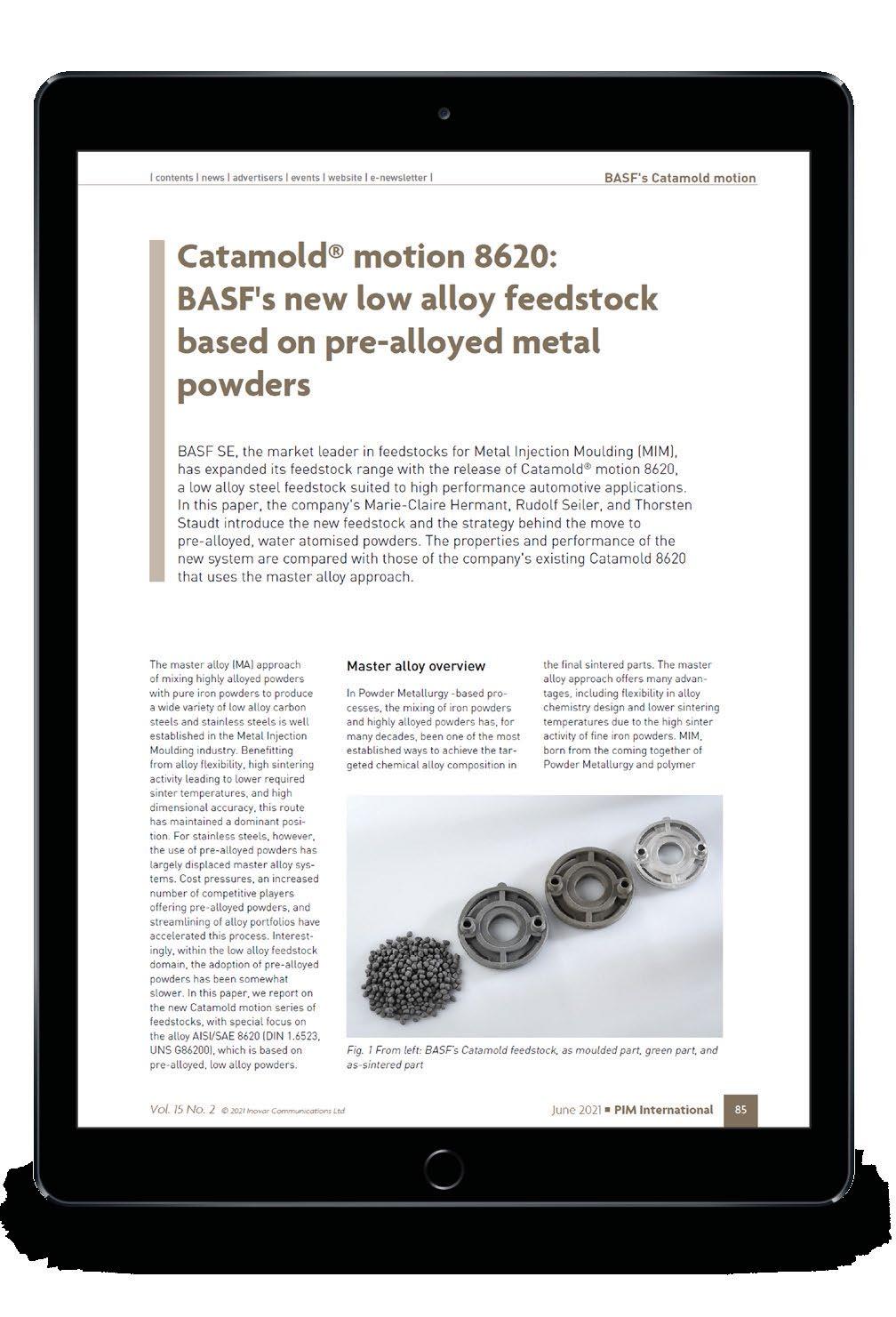

BASF SE, the market leader in feedstocks for Metal Injection Moulding, has expanded its feedstock range with the release of Catamold® motion 8620, a low alloy steel feedstock suited to high performance automotive applications.
In this paper, the company’s Marie-Claire Hermant, Rudolf Seiler, and Thorsten Staudt introduce the new feedstock and the strategy behind the move to pre-alloyed, water atomised powders. The properties and performance of the new system are compared with those of the company’s existing Catamold 8620 that uses the master alloy approach.


FROM THE JUNE 2021 ISSUE OF PIM INTERNATIONAL
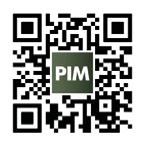
NORTH AMERICA’S LARGEST AND MOST INFLUENTIAL ADDITIVE MANUFACTURING EVENT. EXPERIENCE THE NEXT LEVEL OF ADDITIVE MANUFACTURING IN CHICAGO.

Witness groundbreaking product announcements, experience hands-on equipment demos, learn real-world additive manufacturing applications from the most respected experts, and network with thousands of industry peers.

MAY 2-4, 2023

McCormick Place | Chicago
REGISTRATION IS OPEN rapid3devent.com
HP Metal Jet: Growing momentum and new applications as Binder Jetting comes of age
HP’s Metal Jet has undergone significant refinement in the years since it was first unveiled in 2018. Now, by incorporating nearly the whole Binder Jetting workflow in one solution, HP hopes that the Metal Jet S100 – commercially launched at IMTS 2022 and showcased at Formnext 2022 – will tempt the wider manufacturing community into the world of AM. As Binder Jetting’s evolution moves from the intricacies of process optimisation to real application development and growth, Emily-Jo Hopson-VandenBos reports on a recent visit to HP’s Barcelona 3D Printing campus and the company’s progress and growing momentum since 2018.
On the opening day of the International Manufacturing Technology Show (IMTS) in Chicago, Illinois, USA, September 12, 2022, the long-awaited HP Metal Jet finally got its commercial launch. First teased in 2017 and unveiled in 2018, the Metal Jet was originally scheduled for commercial launch in 2021, but – like so many projects over the past twenty-four months – faced pandemic- and supply chain-related delays, as well as structural changes at HP 3D Printing, which pushed the release back to 2022.
Perhaps this delay was a blessing in disguise for the company, whose development team has spent the intervening period ironing out creases and working with beta and alpha customers, as well as devising what they believe is a truly scalable metal Binder Jetting (BJT) workflow and a sales model to accelerate its adoption by industry. When the release finally came, it was not the HP Metal Jet, as seen in 2018, that was unveiled to the industry, but the HP Metal Jet S100: a scalable, modular Binder Jetting system, already installed at the facilities of twenty alpha customers, said to offer

industrial-grade uptime and end-toend control of the workflow. Among the company’s customers to date are Volkswagen, Cobra Golf, Lumenium, Schneider Electric, the US Marine Corps, Legor Group, Domin Digital Motion and John Deere.
In 2019, I was among the first group of press and analysts invited to the opening of HP’s 3D Printing
and Digital Manufacturing Center of Excellence at its campus in Barcelona, Spain, where we were able, for the first time, to see Metal Jet machines in action in HP’s Process and Applications Development Lab. At the time, the machine was in beta and HP’s Metal Jet strategy development ongoing; a long road still lay ahead before

2018 - 2019 2020 - 2021 Today
• HP announces Metal Jet technology in September at IMTS with manufacturing partners Parmatech and GKN
• Volkswagen announced strategic roadmap to use HP Metal Jet 3D Printing for mass production
commercialisation, and the big-name case studies we would later come to associate with HP’s BJT technology (Volkswagen and Cobra Golf, covered later in this article) had yet to be announced. In short: it was early days, and while the technology appeared promising, the metal AM industry is no stranger to the hype machine, and nobody could quite be sure that this strategy would pay off.
In July this year, I was invited back to HP’s Barcelona campus for an update on the Metal Jet and HP’s Binder Jetting progress since 2019. Here, I heard from members of the company’s senior management and applications development team, toured the expanded Metal Jet facilities, viewed a varied selection of Metal Jet parts and working machines, and had the opportunity to see the full workflow in-situ within the company’s production laboratory. Through the course of the presentations and discussions during this event, it was clear that HP was ramping up for big things; an
• Metal Jet production service launched
• Expanding early access program to select customers
• Production for Volkswagen by GKN
• Cobra Golf production by Parmatech
• Global HP 3D Covid-19 support of medical shortages
idea only enhanced by the commercial launch at IMTS and full-force marketing effort at Formnext 2022 in Frankfurt, Germany, this November. During both events, the focus was on customer success stories and scalability.
I spoke to Ramon Pastor soon after Formnext, and here report on the progress and outlook for HP’s Metal Jet technology, with takeaways from Barcelona, IMTS and Formnext.
HP’s history in AM
Historically focused on computing and 2D printing solutions, HP first announced its intention to move into the Additive Manufacturing space in 2015, launching its first Multi Jet Fusion machine for polymer AM the following year and establishing its HP 3D Printing brand in 2017. By 2018, the company was ready to expand its portfolio of polymer AM machines and, in 2019, the focus was accelerating and verticalising this
• Serial production planning with key partners
• Next Gen Solution for near-term introduction
portion of the business. The wealth of experience and customer trust HP has built up in the plastic 3D printing space is significant, and, per its most recent announcement at Formnext in November, the company stated that its Multi Jet Fusion machines have printed more than 170 million plastic parts since their commercialisation, with 50 million parts printed in the last year alone.
Once HP was in the polymer AM sphere, it didn’t take long for speculation to begin on whether the 2D printing giant would ever make the leap into metal Additive Manufacturing. In October 2017, two years after entering the AM market, Stephen Nigro, then HP’s president of 3D Printing, revealed the development of a metal AM approach which he called “a major step for HP 3D printing aspiration.” This approach was the Metal Jet, HP’s take on an industrially scalable metal Binder Jetting solution.
The first Metal Jet machine saw its official launch less than a year later in September 2018, at IMTS in Chicago, Illinois, USA. At that time, HP also announced partnerships with GKN Powder Metallurgy, the world’s largest Powder Metallurgy components producer, and US-based MIM pioneer Parmatech. These were the first companies to integrate the new machines at their facilities for parts production, enabling their customers to benefit from the capabilities and production volumes offered by Binder Jetting, and providing the feedback that would,
“The wealth of experience and customer trust HP has built up in the plastic 3D printing space is significant ... its Multi Jet Fusion machines have printed a total of 170 million plastic parts since their commercialisation.”Fig. 2 The HP Metal Jet’s journey from announcement to serial production planning
in turn, enable HP to develop and finalise its product. The next year, Volkswagen announced a strategic roadmap to use HP Metal Jet AM for the mass production of automotive components.
Developments since 2019
It is no exaggeration to say that the world has changed in the intervening years since the Metal Jet’s 2018 unveiling. In the landscape we find ourselves in following COVID-19, semi-conductor shortages, Russia’s invasion of Ukraine (translating to higher energy costs and supply chain disruptions), volatility is the new normal, making it necessary to achieve operational and financial agility to deal with supply chain complexity and disruptions. HP has seen this change reflected across its businesses, in the changing purchasing models of its customers: the primary concern for everyone –from decision makers to engineers – is no longer just the cost of a new solution or partner, but its agility, responsibility, and resilience.
Against this backdrop, the company claims to be readier than ever to respond to the needs of a global manufacturing landscape under pressure. Among the key tools in this response kit is metal Additive Manufacturing, explained Ramon Pastor. While the company’s polymer AM solutions have seen impressive adoption rates and part output, metal AM, he said, has the potential to address a significantly bigger pain point than polymer AM, which competes directly with plastic manufacturing processes that are already fairly efficient, and face few of the material, economic and geographical challenges that the metal manufacturing supply chain faces.
In 2020, though progress was unavoidably slowed by the COVID-19 pandemic that brought global industry to a near standstill, the company launched its Metal Jet production service, enabling customers to submit part designs for Additive Manufacturing by a

Metal Jet service provider via an online portal, and expanded its early access programme to include select customers. 2020 also saw the announcement of two key application success stories for the Metal Jet: GKN began serially producing parts for Volkswagen using Metal Jet technology, and Parmatech produced a limited-edition Cobra Golf club using the Metal Jet. A summary of the HP Metal Jet’s journey from its first announcement to today is shown in Fig. 2.
New leadership for a changing market
HP itself has also undergone significant changes since 2018. In November 2019, Group CEO Dion Weisler stepped down from his role and was succeeded by company
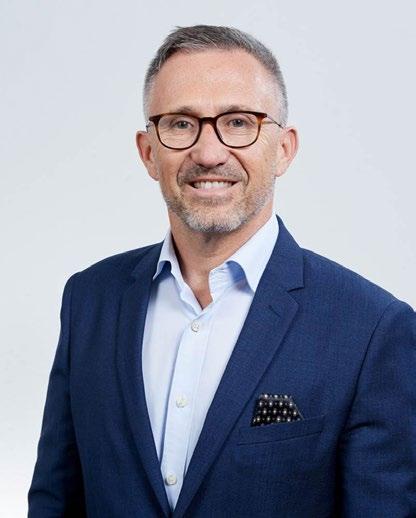
veteran Enrique Lores. The same month, HP abandoned its regional structure comprising Americas, EMEA and Asia-Pacific Japan, and adopted a single commercial organisation with ten geographical markets. Each of these markets was led by a managing director reporting to HP’s first-ever Chief Commercial Officer, Christoph Schell, who had previously served as President of 3D Printing and Digital Manufacturing and has since joined Intel; he was succeeded in this role by Dave McQuarrie. In 2019, Ramon Pastor (Fig. 3) made the move from VP and General Manager of HP’s 3D Printing Business, a role which he had held since 2015, to President of 3D Printing and Digital Manufacturing. In 2021, he was appointed Global Head and General Manager of 3D Metals, with responsibility for the HP Metal Jet.

“The company claims to be readier than ever to respond to the needs of a global manufacturing landscape under pressure. Among the key tools in this response kit is metal Additive Manufacturing.”
Also in 2021, Didier Deltort (Fig. 4) was named as HP’s President of Personalization & 3D Printing, reporting to Sarabjit Singh (Savi) Baveja, Chief Strategy & Incubation Officer. Joining at the tail end of the pandemic and in a time of major global business and manufacturing disruption, Deltort, based in Barcelona, is responsible for the global end-to-end business management of this segment, focused on driving growth, creating new business and ‘disrupting industries’ with HP’s AM technology and intellectual property.
Deltort joined the company from Zimmer Biomet, where he had served as President of the Europe, Middle East and Africa business. With thirty years in the manufacturing industry, specifically in the realm of healthcare solutions, Deltort considers himself a “hardcore engineer.”
Previously employed at HP in the ‘90s, he left when the group spun out its Healthcare business – if it had not, he told visitors in Barcelona, he might have been happy to spend his whole career at HP, a company whose management he speaks very highly of – “hard with ambitions, soft with
its people.”
After leaving HP, Deltort joined GE, leaving in 2016. Before joining Zimmer Biomet, he also worked with Boston Scientific; both companies are innovation-driven healthcare solutions providers whose implantbased business would suffer during COVID-19, when elective surgeries were postponed on a global scale. After remaining with Zimmer Biomet through this crisis period, he rejoined HP.
Having worked in healthcare innovation for thirty years, Deltort was familiar with the concept of Additive Manufacturing as advertised to the manufacturing market: a ground-breaking manufacturing solution set to change the world and make billions doing it. On joining HP 3D Printing, the biggest surprise he faced was to find that the market hype didn’t match the reality: while HP’s 3D Printing business was growing faster than the margins, the AM industry, as a whole, wasn’t making money. To the outside world, market reports and forecasts suggested a period of frenetic growth and big bucks, but the reality was quite different.
What was more, the industries that seemed to represent some of the biggest opportunities for AM at scale (e.g., consumer goods and automotive) were proving extremely tough to crack for a high-cost implementation technology like metal AM; discussions with businesses in these industries tend to be purely about cost, he explained. Of course, the outlay to acquire, install and train staff in using a fleet of metal AM machines, no matter how efficient the technology, is significant, and tends to be feasible for only the highest-value applications, where return on investment (ROI) is all but guaranteed.
Identifying the applications where ROI was guaranteed and strategising the right business model to take advantage of them quickly became Deltort’s top priority. “I didn’t come to HP to sell one or two more printers per quarter,” he stated. Since taking on his current role, he has impressed one strategy upon his staff almost

“... the industries that seemed to represent some of the biggest opportunities for AM at scale (e.g., consumer goods and automotive) were proving extremely tough to crack for a high-cost implementation technology like metal AM.”
every day: “Identify where to win, how to win, and where to make money.”

While detail on some of the lucrative ‘where’s and ‘how’s being pursued for HP’s Metal Jet technology is, in many cases, veiled in secrecy, it was shared that the company sees the ‘big opportunity’ for Binder Jetting as industrial manufacturing. This was evidenced later in the year by the reveal of one of the company’s new industrial customers: John Deere and Schneider Electric.
Like many developers of sinterbased AM technology, HP has an ongoing strategy to highlight and pursue industrial manufacturing applications that are currently served by Metal Injection Moulding (MIM), where manufacturers are already equipped with the sintering capacity and expertise to leverage Binder Jetting, including massively lucrative 3C opportunities supplying companies such as Apple – but Deltort sees huge scope beyond MIM-served applications. As a veteran of an industry hit hard when the pandemic cut off demand for its leading products, perhaps he has every reason to be wary of allowing too narrow a focus.
While machine sales are, of course, a key metric for understanding the uptake of HP Metal Jet, Deltort sees little value in a hardware salesfocused business and believes the best possible strategy for any AM machine maker is to adopt a combined hardware sales and service model. It is Deltort’s belief that, if a business is focused on selling machines, “it loses the ability to grow into a multi-billiondollar company,” and, instead, enables others to take advantage of the opportunities it has highlighted and do just that. The AM industry, he stated, can maximise its earnings potential by providing not just hardware, but a value-adding service.
The Metal Jet S100
The technology behind the HP Metal Jet S100 (Fig. 5) is built on the workflows and technologies that HP developed for its polymer AM workflow, incorporating new functional agents, processes, and hardware for metal manufacturing while reportedly delivering quality, productivity, and cost beyond the capabilities of existing metal AM technologies.
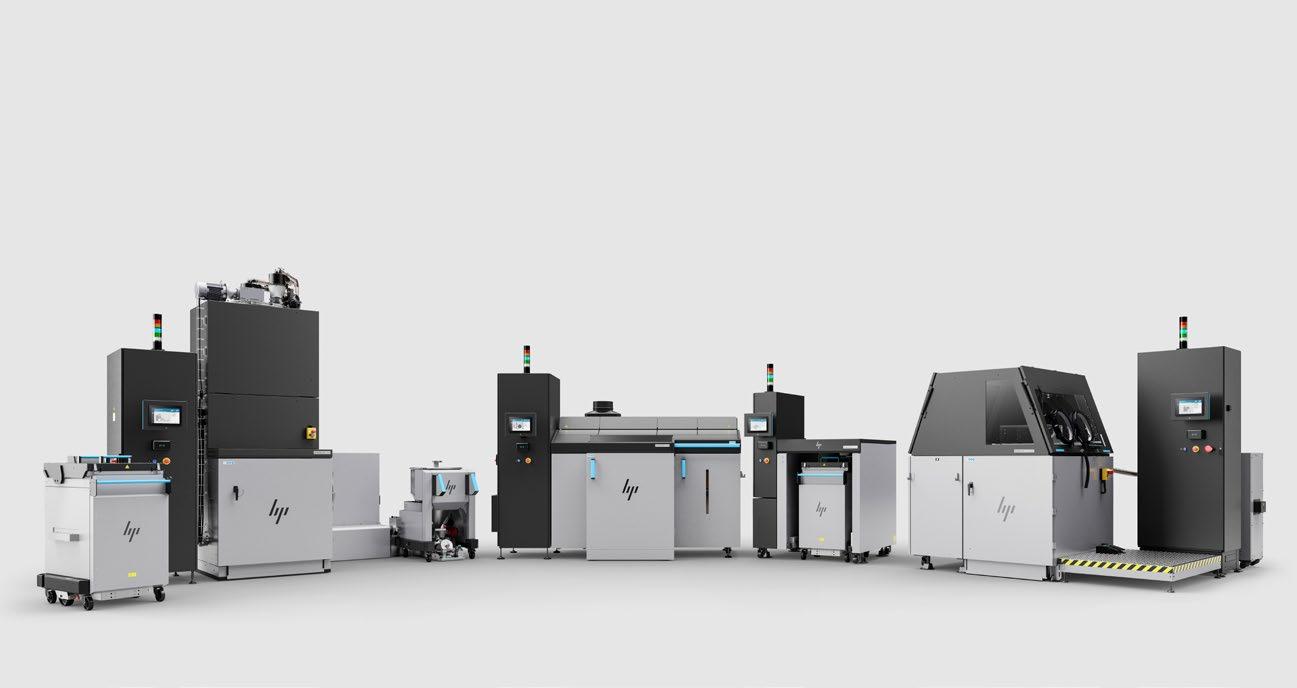
Metal Jet works by using HP Thermal Inkjet printheads to precisely deliver the company’s proprietary HP Binding Agent onto a bed of MIM industry-standard metal powders, with each layer measuring 50–100 μ m. The powder bed in a Metal Jet S100 measures 430 x 320 x 200 mm (16.9 x 12.6 x 7.9 in), and parts may be manufactured in batches – arranged freely in multiple levels in the powder bed to optimise packing density, productivity, and cost – or individually for larger parts (though this is not the most efficient use of the Metal Jet’s capabilities). The average time to complete a Metal Jet build is between ten and eleven hours.
Workflow and equipment
The Metal Jet S100 workflow comprises an initial powder management step, Binder Jetting (in the S100 machine), curing of the binder to remove excess water and solids, powder removal, and sintering. A powder management, curing and powder removal station are available to purchase with the Metal Jet as standard, each optimised by HP’s Metal Jet engineers
to function as part of a seamless, semi-automated Binder Jetting workflow. Equipment comprising the full Metal Jet workflow offering is shown in Fig. 6.
Throughout the workflow, HP’s proprietary Device API tracks and connects builds to automate the scheduling, routing, and monitoring of jobs. For the final step, sintering equipment can be installed in house by the Metal Jet user, or parts may be shipped to third-party service providers for toll sintering.
Varying Metal Jet configurations are available for purchase based on customer requirements, with serial production set ups expected to require one curing, powder management (Fig. 7), and powder removal station (Fig. 8) to every six Metal Jet S100 machines. A serial production set up is shown in Fig. 9. Because of the curing requirement of HP’s binder, the minimum purchase is that of an S100 BJT machine with a curing station.
“The modularity of the new Metal Jet S100 Solution is definitely a result of our close partnership and iteration across the product life-cycle over the past four years. We believe it is a tremendous advantage,” Pastor told PIM International . “We have come to learn the pain points along the entire customer journey, from HP Metal Jet adoption up to full-scale production. The HP Metal Jet S100 Printing Solution helps customers address these existing issues, with a focus on efficiencies in the development process, reducing manual labour, and improving operational efficiency with automated and physical digital solutions, industrial-grade machines to enable non-stop manufacturing, and a comprehensive set of proactive, preventative, and responsive maintenance through HP Metal Jet Solution Services.”

Decades of hardware and binder expertise
As a manufacturer of digital (2D) printers, HP is number one or two globally in almost every price category, from $100 to $10 million. As of 2019, the company was building 25 million 2D printers a year, and using the same printhead technology in every product, meaning that it could make them quickly and at incredibly low cost. This technology was applied to the Multi Jet Fusion line of polymer printers, and, later, to the Metal Jet: decades of design optimisation and the low-cost of installing multiple, high-density inkjet nozzles per machine enabled the Metal Jet S100’s developers to achieve jetting speeds the company claims are around fifty times faster than HP’s competitors, with an individual printhead resolution of 1200 dpi, high-speed calibration and compensation, and a nozzle redundancy feature capable of detecting and replacing up to four failed nozzles during a build. Failed nozzles are also completely user replaceable, reducing service needs and increasing machine uptime.
The advanced latex chemistries developed by HP’s graphics printing business also lend some benefits to the Metal Jet process. Originally
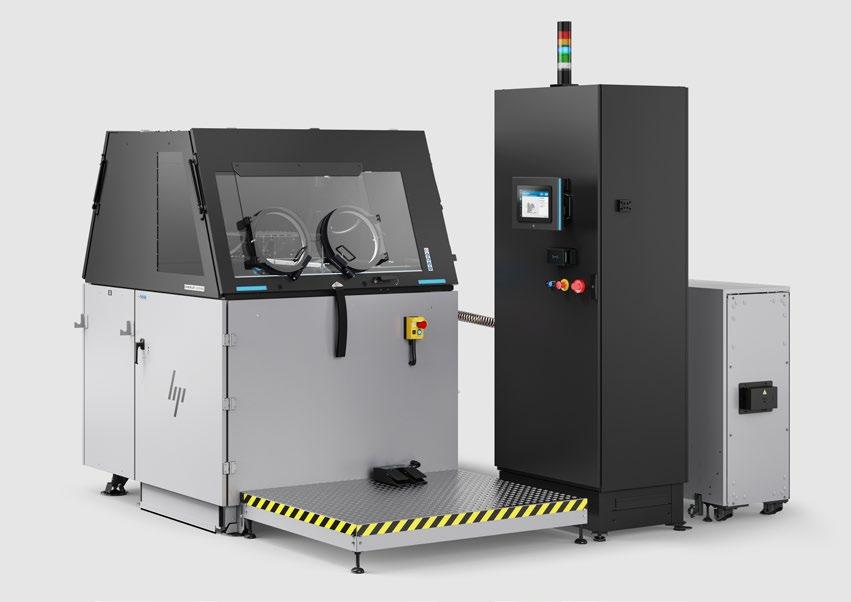
developed for use in signage and having the ability to adhere to glass, vinyl, or metal, HP has described its proprietary long-chain polymer latex glue as “the world’s best binder for gluing metal powder together.” With this proprietary latex glue serving as the binder, HP is reportedly able to use twenty times less binder than typically employed in MIM, resulting in a green part chemistry of < 1% binder by weight. The high strength of the binder after curing also makes the transportation of green parts for sintering simpler than with some conventional binders, and enables the production of larger parts of up to 7 kg (though Pastor noted that the production of larger parts is not the most efficient use of Binder Jetting technology).
HP prioritised vertical integration as far back as its roots in the 1990s. From a business perspective, and especially as it relates to AM, I asked Ramon Pastor why vertical integration has been such a key goal of HP’s since its beginnings, and what advantages this brings in the Additive Manufacturing space?
“Whether you look at the traditional print space, industrial printing, innovative personal systems, or any aspect of what HP Inc. does, we are always focused on delivering a breakthrough value proposition that can disrupt the market,” he explained. “Vertical integration allows for companies to streamline operations by taking direct ownership of the various stages of the production process, implying a certain and robust degree of control. That applies to HP as well. Vertical integration can help optimise performance and cost.
At HP, vertical integration in the core assets of printing is key to optimise performance and cost. In the case of 3D printing, both the core inkjet technology and the agent chemistry and formulations differentiate HP from the rest of the market.”
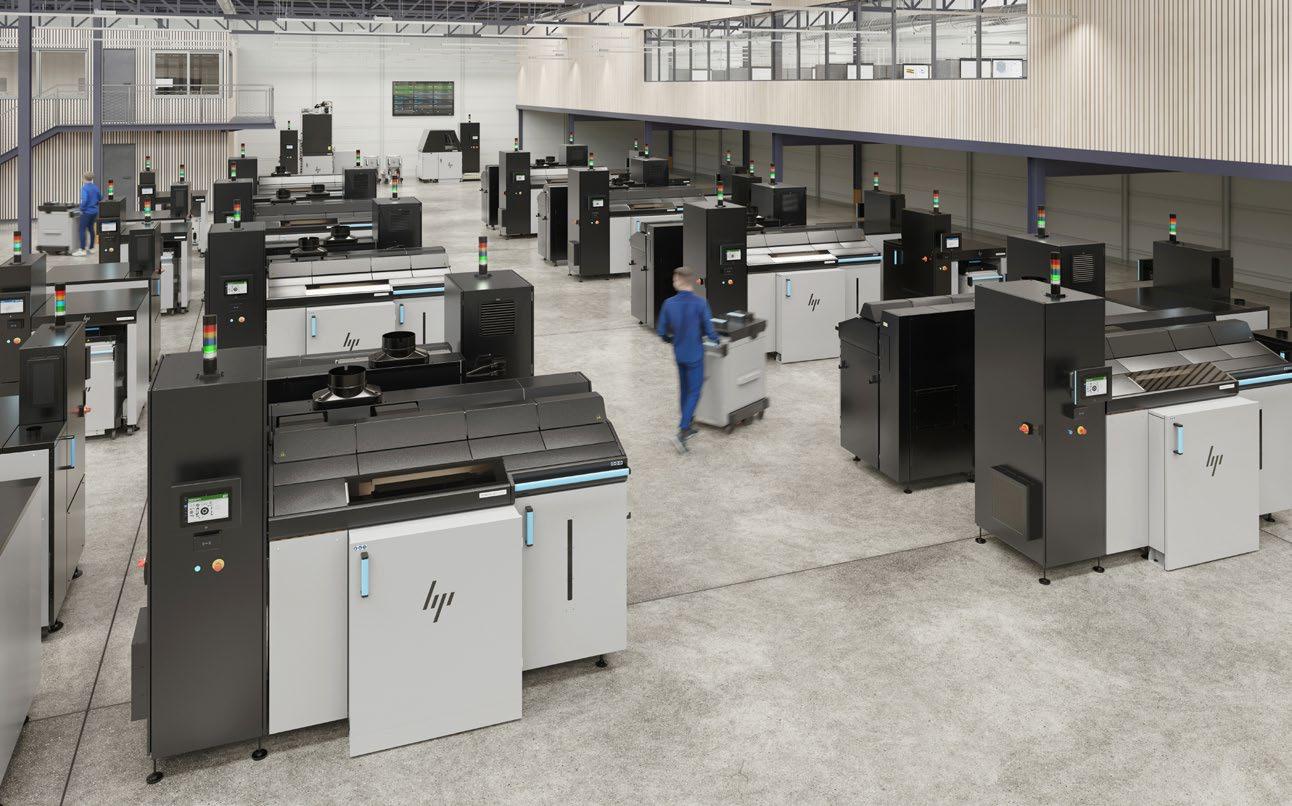

A service-focused business
Since 2019, HP has invested enormously in its professional services offering for metal BJT, developing a set of processes to help guide
“Whether you look at the traditional print space, industrial printing, innovative personal systems, or any aspect of what HP Inc. does, we are always focused on delivering a breakthrough value proposition” – Ramon Pastor
customers through the transition from conventional manufacturing to metal AM, with dedicated support on hand. HP Service Solutions now has the capability to aid customers from the point of application identification to the ongoing maintenance of its machines in customer facilities. The business considers its service offering one of the main differentiators between HP and its competitors in the AM technology space; “the most common customer feedback across the board,”
Deltort commented, “is that HP 3D Printing’s adopters love the quality of the people they deal with.”
Recognising the value its service team can add, HP has, since 2019, rethought its Metal Jet strategy. While the machine’s initial unveiling focused on the hardware for sale, following their commercial launch at IMTS, Metal Jet S100 machines are now available both to buy outright and to purchase as part of as a paid subscription service. This custom -
isable, subscription-based sales model divides customers into three bands: silver, gold, and platinum, each band offering a different level of service for a set monthly cost. While the basic parameters of each ‘band’ will be defined by price, Ramon Pastor noted that HP expects each kind of customer will be served by a tailored purchase model, depending on its individual application and needs. It will be interesting to see whether this subscription-based model will become more widespread across the metal Additive Manufacturing market, rather than just at HP; certainly, it is becoming the predominant sales model in a number of other markets, with even some automotive manufacturers now selling optional ‘extras’ on a subscription basis. It is worth remembering that HP’s 2D printing business has long promoted a subscription-based model, even for small-scale home office printers.
Market readiness
While HP is open to a wide range of markets, the target customer for the HP Metal Jet S100 is the vertically integrated OEM: a manufacturer keen to bring metal part making in house, with an eye to improving the sustainability, flexibility and responsiveness of its workflows. Sintering experience naturally provides a significant initial advantage. Metal Jet is optimised for mass production of low-cost, high-quality final parts by each individual machine on the factory floor. Based on testing and alpha production programmes, the Metal Jet S100 team believes that the process and its associated workflow has a high technology readiness level (TRL) for this kind of application. HP Metal Jet green parts are shown during close-up inspection in Fig. 10.
Finished parts tested by HP and its partners have been found to have isotropic properties that meet or exceed ASTM and MPIF Standards, and a MIM-like postsintering density of greater than 96%. In addition, the high reusability of its materials makes it possible to reduce material cost and waste, increasing sustainability without compromising part quality. According to Pastor, this is partly thanks to the steep learning curve climbed by HP in the development of its Multi Jet Fusion polymer AM machines; the technological learning and process development involved in metal BJT, he said, has been much easier and less complex for HP than the leap in technical and scientific knowledge needed to understand and create a plastic AM technology. In his opinion, the lack of adoption of metal AM in the wider industry is not due to its inherent complexity or cost, but because too much of the industry “tries to do too much, not well.” By comparison, he said, HP has focused on doing a few things to ‘five-sigma’ confidence, in the hope that its technology will perform as promised in the wider
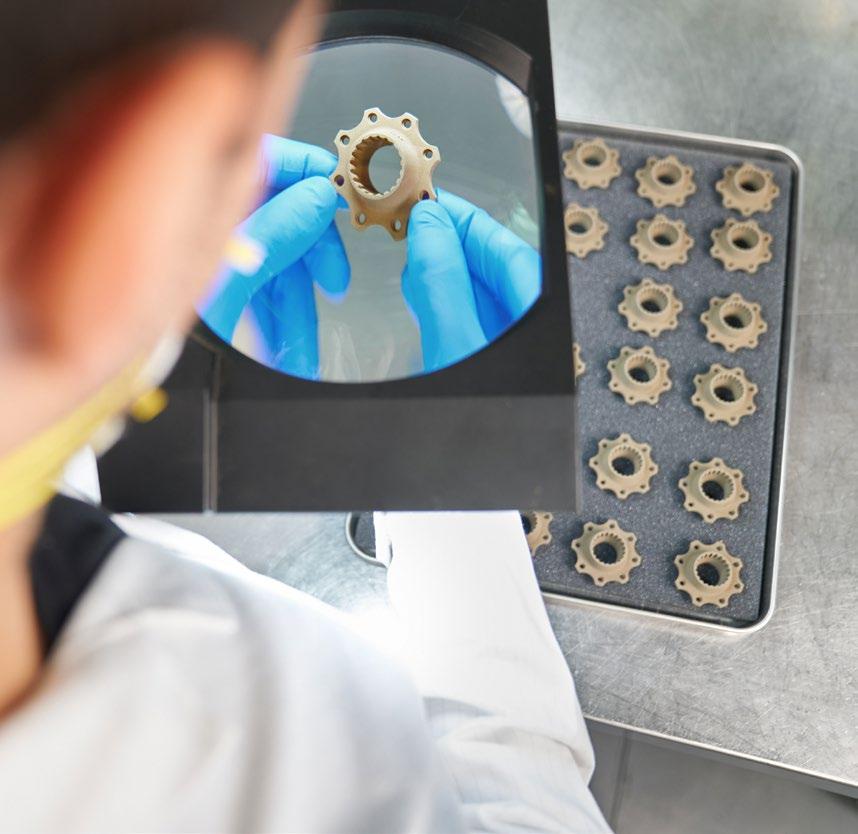
commercial market, bringing scalable metal Binder Jetting to the wider marketplace.
“What HP Multi Jet Fusion unlocked for customers with polymers, we knew we could do for customers looking for the same design freedoms, speed, and quality in metals,” he explained. “We saw an opportunity with Metal Jet to uphold that mission, and we are going after it. Speed, personalisation, repeatability, quality, reliability, scale, and cost are all key components that make the Metal Jet technology so exciting, defining new levels of part quality, part functionality, productivity, and production scale. Metal Jet users can now integrate digital manufacturing into existing processes for large- or smallscale runs without sacrificing complexity or a competitive cost per part.”
On achieving that five-sigma confidence that HP values so highly, Pastor told PIM International , “We’ve spent a long time characterising the Metal Jet offering in order to offer the most in demand materials with five-sigma confidence. Both materials [qualified to date] offer a broad range of uses for applications across industries and have been certified for optimal quality. Repeatability is another key factor – to ensure that every part has the same tolerances, especially for production at mass scale. We also leverage automation and the modularity of the new S100 to optimise productivity.”
“Based on our progress in metals, we are now more confident than ever in HP’s strategic approach across digital manufacturing,” he added. “Having this level of confidence is so important as it enables us to go into conversations with our customers, regardless of what they’re wanting to achieve, with the assurance that we can partner together to identify scalable applications that deliver value to their business.”
Metal Jet applications to date
Since its launch, Metal Jet technology has been used in a number of production use cases that fit these criteria – some highly publicised, some top secret. Among the publicly announced applications to date (and the lessons learned from them), Pastor highlighted several products and partners as having been especially valuable, from a development point of view.
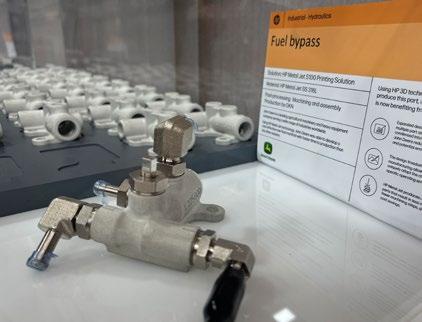
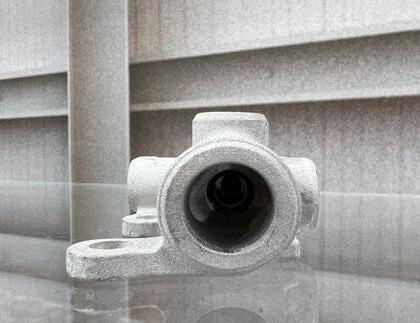

“GKN Additive (Forecast 3D)’s DNA and expertise in powder production and metal part processing using digitally networked systems has enabled it to drive industrialisation across the whole Additive Manufacturing value stream,” he stated. “By combining the forces of HP and GKN Additive (Forecast 3D), we’ve pushed productivity and capability of our customers
to unprecedented levels based on the economic and technical advantages of HP Metal Jet technology. Not to mention GKN’s leadership in producing functional metal auto and industrial parts. Another partner, Parmatech, is a world leader in MIM, and has been a metals manufacturing pioneer for more than thirty years. The company’s HP Metal Jet printed parts, such as surgical scissors and endoscopic surgical jaws, have opened our eyes to new applications and geometries, impossible to produce via conventional metal fabrication technologies.”
“HP is also working with a number of leading industrial companies, collaborating on new mass metals production opportunities,” he added.
“For example, John Deere, the world’s leading provider of agricultural industrial equipment, is using Metal Jet technology for the

production of a valve in its tractor fuel system (Fig. 11). In addition to significant productivity gains and environmental benefits, the high-quality part is functional in extreme weather conditions. Schneider Electric is the global leader in the digital transformation of energy management and automation, and, together with GKN, is using HP Metal Jet to 3D print new components for its low voltage switchboards (Figs. 12–14), extending the design freedom and achieving increased technical performance and function integrations on its products in a robust and cost-effective way.”

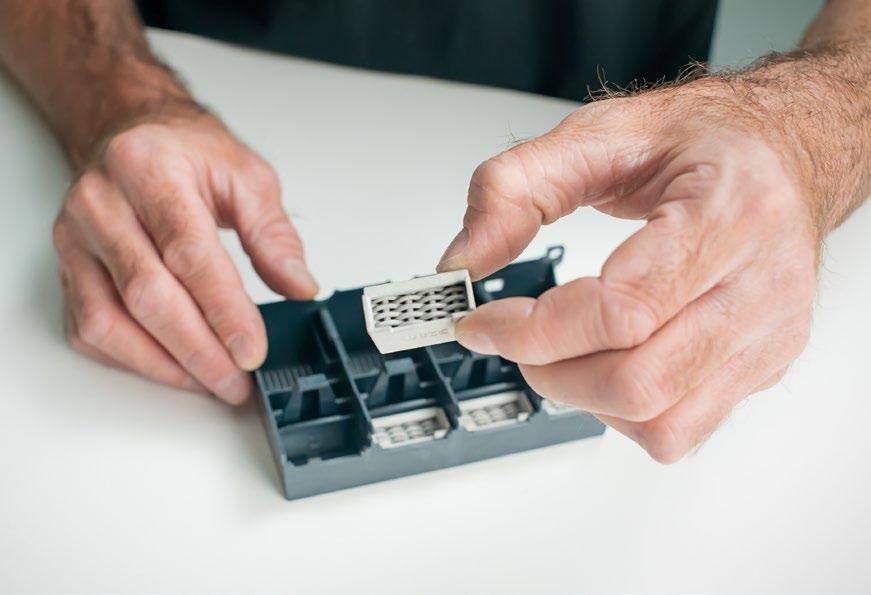
Other customers of the HP Metal Jet include Domin Digital Motion (industrial hydraulic systems and valves), Lumenium (a startup developer of advanced rotational engines; engine assembly components, Fig. 15), Volkswagen (the widely reported on T-Roc A pillar), Cobra Golf (the King Supersport-35 putter), and Legor (a jewellery maker; rings and pendants, Fig. 16).
The potential of Metal Jet
While HP is confident of its ability to grow and take advantage of the opportunities for Metal Jet BJT, Pastor is clear that the dynamics of the metal parts manufacturing market are very different to those of the plastics market, and HP cannot expect the same speed of uptake as it saw with the Multi Jet Fusion. The sales cycle for a metal BJT technology is much longer than for a plastic 3D printing technology; as this is not a rapid prototyping solution, customers must have a serial production strategy in place in order to take advantage of the Metal Jet S100’s capabilities – there is almost no opportunity for single machine sales to research institutes or universities, so the target customer is strictly commercial. As more customers make it through the lengthy sales cycle, however, Pastor expects the number of machines sold to increase sharply, as Metal Jet S100 units are installed in factories in fleets, ready to produce parts in industrial quantities.
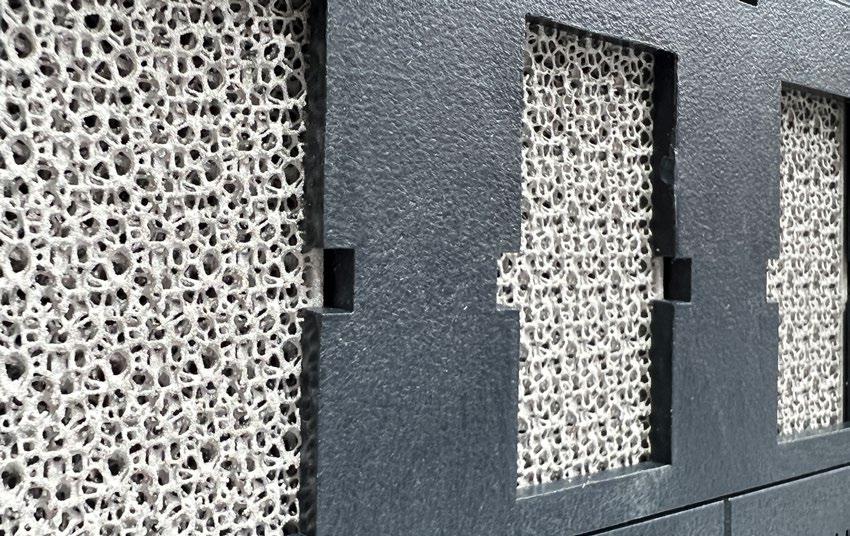
“Today, if you look at market sizing and trajectory, metals is growing the most of any 3D printing segment,” Pastor told PIM International “Successful AM for metals requires different skills and different strategies than for plastics – but metal AM has an advantage in that often the traditional metal part production technologies are not very efficient, and many of them must be combined to produce a final part. Metal 3D printing can win in many cases, with Binder Jetting offering greater volumes and a unique economical value proposition. More and more of our customers are rewarded with the ability to print millions of parts per year, moving to millions of parts every month. And another trend that fits into the Binder Jetting wheelhouse is the blending of personalisation with performance; a great example of this is HP’s work with Cobra Golf, enabling performance-enhancing features for golf clubs. Furthermore, with the focus on sustainability, many organisations are looking at ways to reduce inventory and costs and extend the life of products.”
In an industry in which it is often difficult to penetrate the hype and get to the real story, HP is dedicated to proving its Metal Jet technology in real, industrial settings. Where perfecting the process required support from external partners (e.g., those with sintering expertise), those partnerships have been in place from the start, enabling the development of a scalable, manageable workflow, from powder preparation to sintering. The company has further sought to prove workflow and its associated technologies through the completion of a successful alpha programme with more than twenty OEMs.
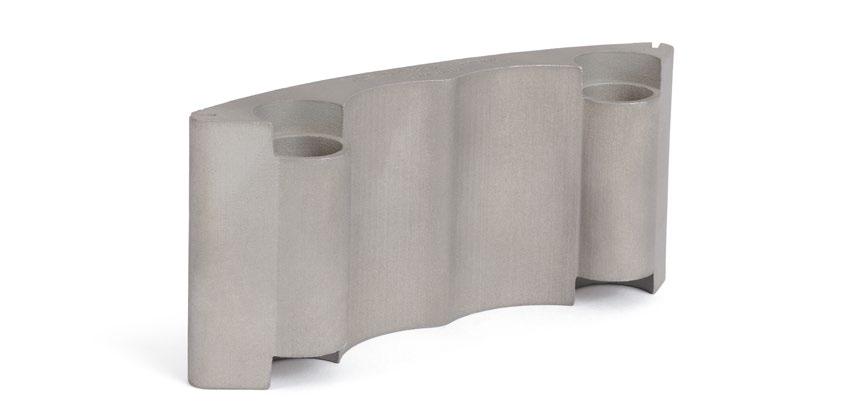
“We are witnessing entire industries, from industrial to consumer, and healthcare to automotive, looking to digitally transform their manufacturing processes and supply chains in a world where volatility is the new normal,” said Didier Deltort. “As the promise of Additive Manufacturing takes hold, HP has become a trusted partner to help speed the path to production.”
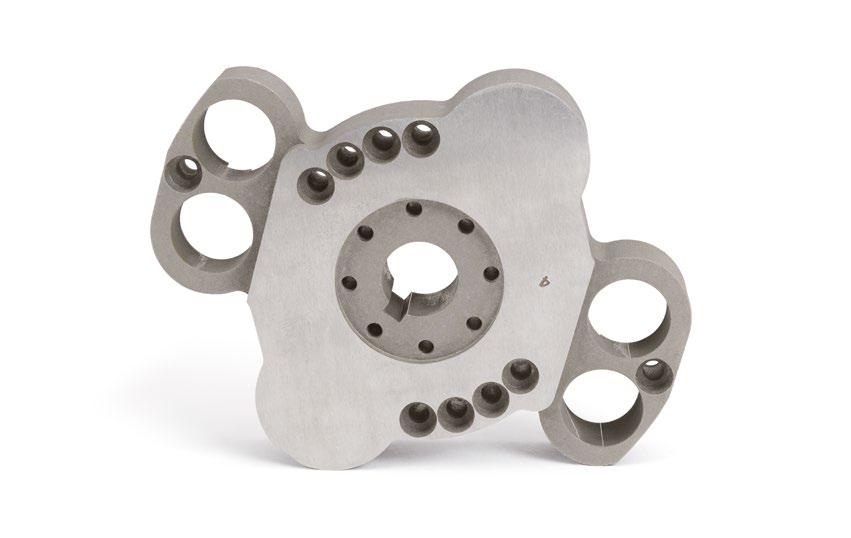
As volatility has become the new normal in the world economy, the concern for HP’s customers is no longer just cost: it is also agility, responsibility, and resilience. Speaking on how this trend was impacting its AM business and customers, Pastor elaborated, “As we live through a world that is continuing to go through numerous insecurities
– whether it’s a pandemic, supply chain challenges, climate crisis or economic recession – we are experiencing a profound impact on many industries worldwide. In the wake of these insecurities, companies are starting to develop new supply chain strategies to guard against future disruption, including volatile global economic trade cycles.”

“As volatility has become the new normal in the world economy, the concern for HP’s customers is no longer just cost: it is also agility, responsibility, and resilience.”Fig. 15 Engine components produced using HP Metal Jet technology by Lumenium (Courtesy Lumenium)
“Advanced 3D printing solutions can help them accelerate this transformation,” he noted. “We are seeing more and more industries turning to 3D printing to disrupt their traditional supply chains and make them more efficient and flexible. In addition to new applications, entirely new ecosystems and alliances are emerging as companies look to deliver more value to end customers.
When looking at our wider 3D printing business, across both Additive Manufacturing and metals, we’re already seeing this trend take hold in industries including automotive, consumer, healthcare and industrial.”
“On the metals side, we are seeing our partners GKN Additive (Forecast 3D), Parmatech, and Legor, as well
as our new industrial customers John Deere and Schneider Electric, put business agility and supply chain resiliency front and centre as we explore production applications that not only address economics and scale, but flexibility, mass-customisation, and added value that may not be measured simply by cost per part.”
While the AM market is unpredictable, and none of us can know for sure which technologies or companies will ‘win’ in the race to the top, the current results advertised by HP suggest that Metal Jet technology could offer MIM-equipped customers the opportunity to take advantage of Additive Manufacturing’s benefits at an industrial scale. For those without this knowledge or equipment available in house, perhaps HP’s service
offerings will enable a new path into industrial sinter-based Additive Manufacturing from outside its traditional user base, without the need to spend years on small-scale, researchlevel test cases.



“Metal Binder Jetting provides better throughput and lower running costs than other AM processes,” Pastor concluded. “Due to the need for less melting and the use of lowercost materials — a third to a fifth of the cost for Binder Jetting materials than for AM powders — the potential to scale is much greater than with laser powder bed fusion and other processes. All in all, as more and more manufacturers across the globe recognise the benefits to Binder Jetting AM, we expect market demand to grow.”
Author Emily-Jo Hopson-VandenBos Group Deputy Editor Inovar Communications Ltdemily-jo@inovar-communications.com
Further information
For more information, please visit www.hp.com/go/3DMetalsContactus

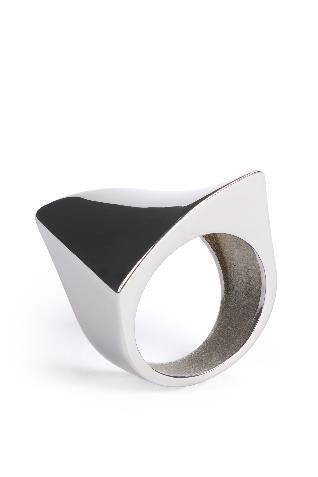




“... the current results advertised by HP suggest that Metal Jet technology could offer MIM-equipped customers the opportunity to take advantage of Additive Manufacturing’s benefits at an industrial scale.”Fig. 16 A trio of rings produced for jewellery maker Legor using the HP Metal Jet (Courtesy Legor)
WHERE IDEAS TAKE SHAPE.
Make
We know that additive manufacturing offers undreamed of potential. In addition to the printer, however you also need the upstream and downstream processes plus the experts, who have mastered the technology. You’ll only find all this at the AM highlight Formnext in November.
For knowledge transfer, industry news and connecting with the AM community all year round visit formnext.com Be
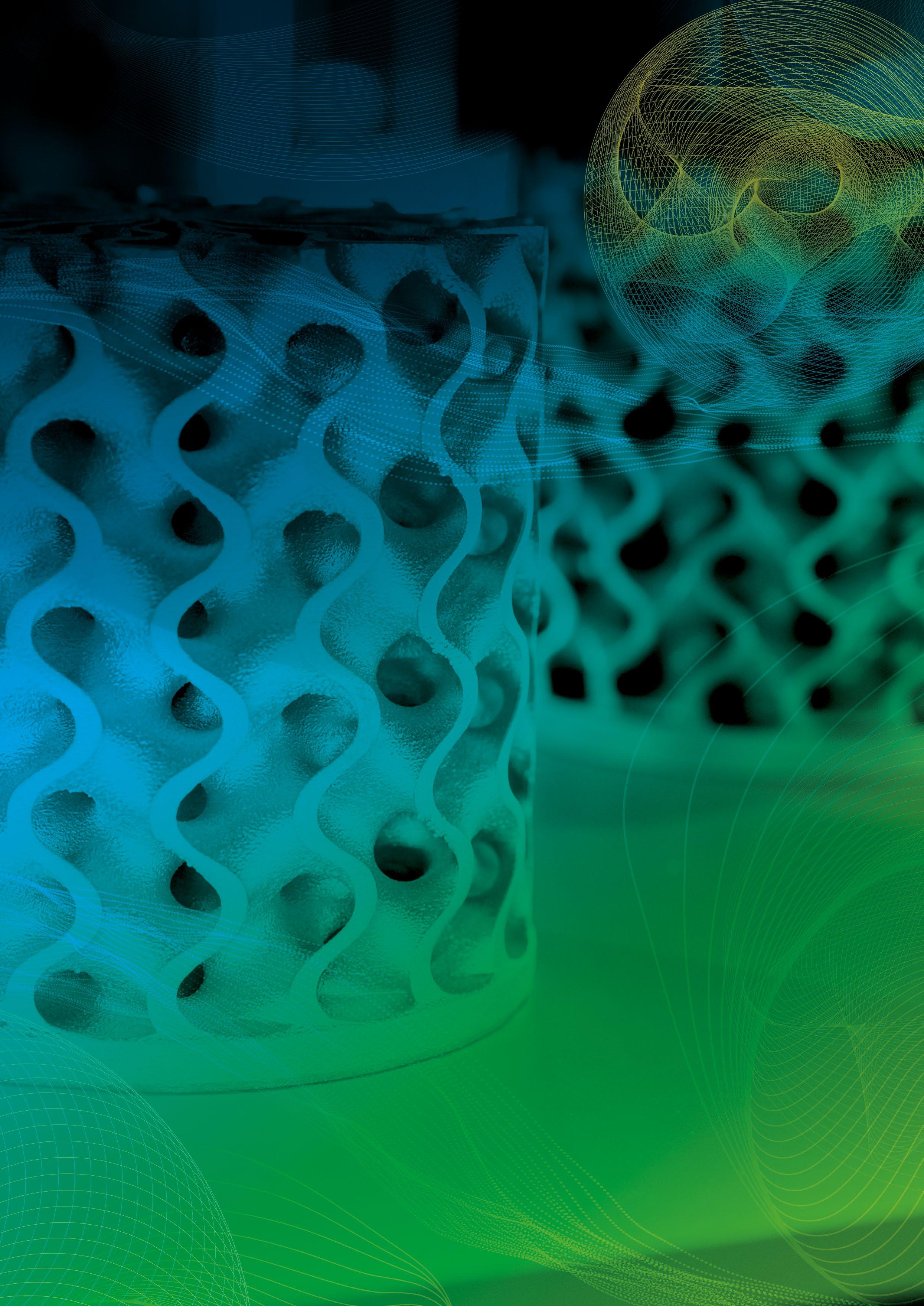
DDMC 2023 | BERLIN | MARCH 15-16, 2023

FRAUNHOFER DIRECT DIGITAL MANUFACTURING CONFERENCE 2023
The Fraunhofer Direct Digital Manufacturing Conference (DDMC) is a cuttingedge forum for discussion on Additive Manufacturing in Berlin, Germany, and brings together researchers, educators and practitioners from around the world.


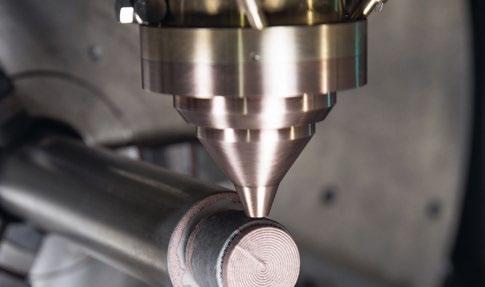
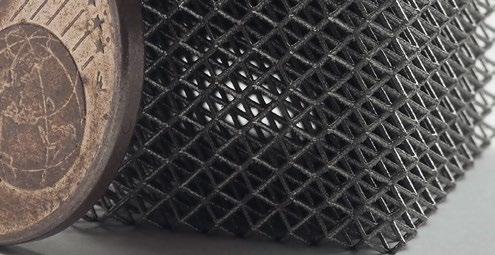

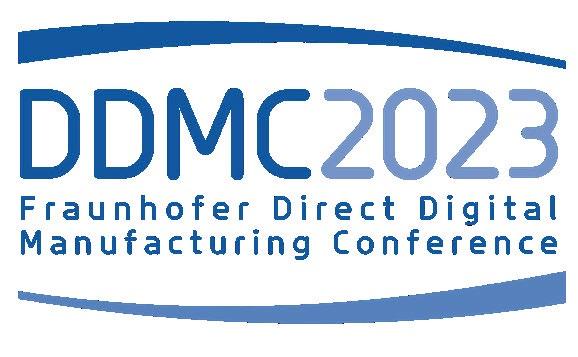
Highlights of our biennial conference are:
More than 50 paper and poster presentations, including Best Paper and Best Poster award

Latest trends from industry

Evening networking event in a historic location
Accompanying exhibition

Full conference proceedings and special issue of Springer journal „Progress in Additive Manufacturing“ (PIAM)
Our high profile keynote speakers are

For more information visit the DDMC website:

Sintex: Exploring the full flexibility of metal powderbased processes for corrosion-resistant applications
Founded as a press and sinter PM parts maker, Denmark’s Sintex has proactivity in its DNA. Having establishing itself in this field, the company initially expanded into MIM in order to meet customer demand for more complex geometries. In recent years, to be able to meet the need for mass customisation, it has explored metal Binder Jetting. In addition, custom alloys have been optimised for applications that require excellent corrosion resistance. Peter Kjeldsteen, Peter Valler and Poul Søgaard offer insight into the history and future of innovation within the company.
Sintex, based in the Danish city of Hobro, celebrated its 25 th anniversary in 2022. The name ‘Sintex’ is a contraction of ‘sintering experts’, and the company has specialised in advanced alloys such as stainless steels, high-temperature alloys and both soft and hard magnetics. Today, Sintex employs 170 staff and processes around 1,000 tons of stainless steel powder annually.

The process experts and metallurgists at Sintex have specialised in producing complex components and have, over the years, developed their own alloys, placing the company at the forefront of corrosion-resistance solutions. Often, development within the company is driven by high demand from customers and its parent company, Grundfos. Grundfos, also based in Denmark, is the largest pump manufacturer in the world, with more than 19,000 employees globally. More than 16 million pump units are produced annually, including circulator pumps, submersible pumps, and centrifugal pumps.
To a man with a hammer, everything looks like a nail
Sintex was founded as a provider of press and sinter Powder Metallurgy parts, made using traditional uniaxial compaction of
metal powder in mechanical presses. In the beginning, all customer requests were either solved with a press and sinter solution, or, where this was not possible, the business was turned down and sent to other companies to be produced using a different technology.

An example of a conventional PM component produced by Sintex is a seal shaft produced for Grundfos CR pumps, which is shown in Fig. 2. This design made it possible to integrate several functions into one component, and, because of its application in harsh environments, its corrosion resistance had to be equal to or better than sheet-formed 316L stainless steel.

This requirement led to the development of a new alloy by metallurgists from both Grundfos and Sintex in an open innovation project. The aim was to fulfil the needs regarding both corrosion resistance, mechanical properties, weldability, and tight tolerances. The alloy was named STX2000 and became a differentiator that enabled PM components to enter highly corrosive environments.
Proactivity in the DNA
In recent years, the market’s increasing focus on sustainability and the need for reduced consumption of alloying elements on the scarcity list has been a major driver for improvement within Sintex. Therefore, the company initiated development of duplex stainless steel alloys using PM. This resulted in two new alloys where the majority of nickel was substituted with nitrogen, causing a reduction of nickel in STX2000 from 19% to 5% in a duplex 2205 alloy with similar or even better corrosion properties. These new alloys are now being tested together with the customer with a great cost reduction potential on one hand and a strong increase in the mechanical properties on the other.
Metal Injection Moulding at Sintex
In 2006, Sintex started a project to introduce MIM technology. The first samples were sintered in our standard press and sinter furnaces, but shortly after, an investment in debinding and hightemperature sintering equipment was initiated. Fig. 3 shows some of the first components made by MIM at Sintex. They were made in existing composite tools in order to obtain the most learning at the lowest possible cost.
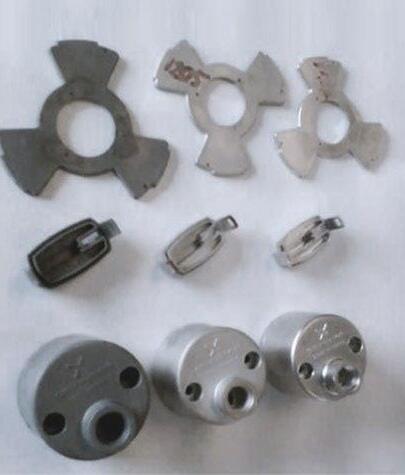
In 2006, many people saw MIM as a competing technology to press and sinter PM, but a deeper analysis of the cost versus performance proved otherwise. Fig. 4 shows that the overlap between Press and Sinter and MIM is very limited as MIM has the possibility for higher part complexity at an elevated cost.
The majority of MIM parts produced at Sintex are for pump applications. A good example of this can be seen in Fig. 5 (front right), which shows a standard MIM component for a power inlet in a submersible pump. This component was developed in both AISI 316L, as well as a duplex 2507 version for highly corrosive environments. Our metallurgists needed to develop a proper
“In recent years, the market’s increasing focus on sustainability and the need for reduced consumption of alloying elements on the scarcity list has been a major driver for improvement within Sintex.”Fig. 2 Seal shaft for Grundfos CR pumps made with PM components Fig. 3 The first MIM prototypes made at Sintex in 2006
sintering process to ensure a corrosion resistance that would enable the components to survive in a 6% ferric chloride solution at temperatures up to 40°C, with very low weight losses according to the ASTM G48 critical pitting temperature test.
A shift to Binder Jetting enables mass customisation

Occasionally, customer needs vary for specific applications, so production of more subtypes of a part is required. The creation of several variants using MIM, especially in low quantities, is very costly due to tooling costs. Therefore, to fulfil this need, Sintex has investigated the possibilities of different metal Additive Manufacturing technologies that could give similar part properties to those achieved using MIM.
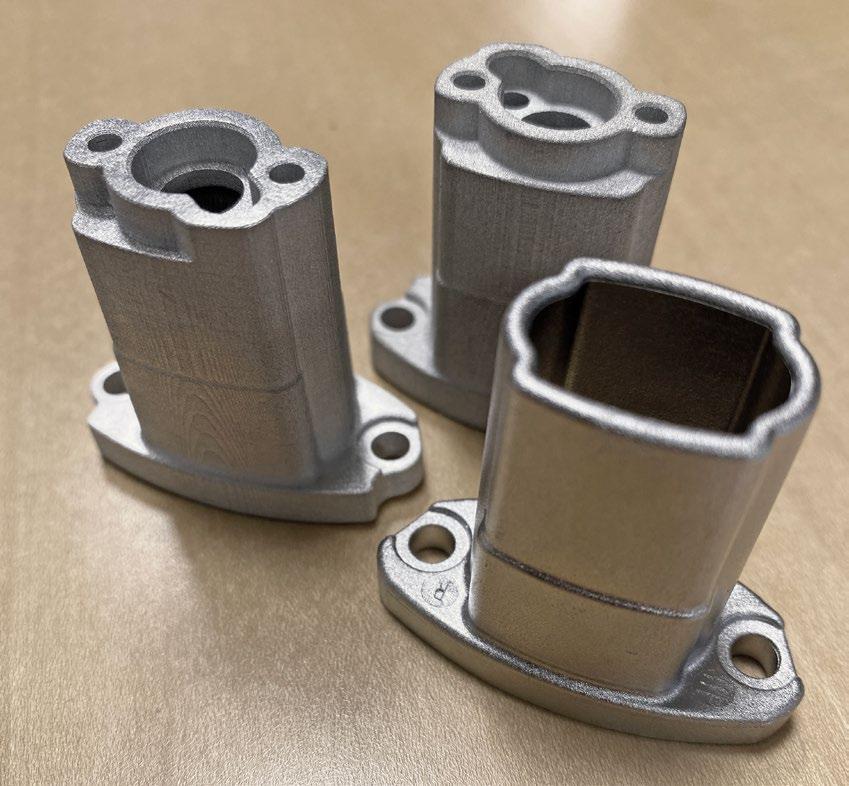
The choice fell on Binder Jetting (BJT), as the powders, and thereby the properties, are similar to those of MIM, and BJT technology has a good process output and cost point compared to other AM processes. The two components at the rear of Fig. 5 show variants of the standard MIM component, wherein the top of the part has been changed to fulfil a specific customer request.
This case is a perfect example of how Sintex is working to expand its flexibility as a manufacturer and ensure that the customer gets the right part, in the right material, with the required properties, and in the ideal geometry for the application.
Future potential
At the EURO PM2012 conference Sintex presented what is called Metal Powder Extrusion (MPE) for the first time, with the first products being complex-shaped filters. The process involves the extrusion of metal powders mixed with a binder into profiles. The technology originates from the ceramic industry and has similarities to MIM.
“The choice fell on Binder Jetting (BJT), as the powders, and thereby the properties, are similar to those of MIM, and BJT technology has a good process output and cost point compared to other AM processes.”
Recently, Sintex has developed special alloys for functional materials and MPE applications covering high-temperature alloys, as well as a new TWIP formulation for high energy absorption. A decade after first presenting the technology, Sintex gave an update on its progress with MPE at World PM2022 Congress in Lyon, France. Examples of powder extruded components can be seen in Fig. 6, where an internal honeycomb structure was used to give the parts a high mechanical integrity, as well as a very high surface area.
The use of simulation in both alloy design and process development has made new opportunities available to Sintex over recent years. Entirely new alloys have been developed, and the lead time from design phase to the first part with the right dimensions has been decreased significantly. This is expected to have a major positive impact on innovation in the years to come.
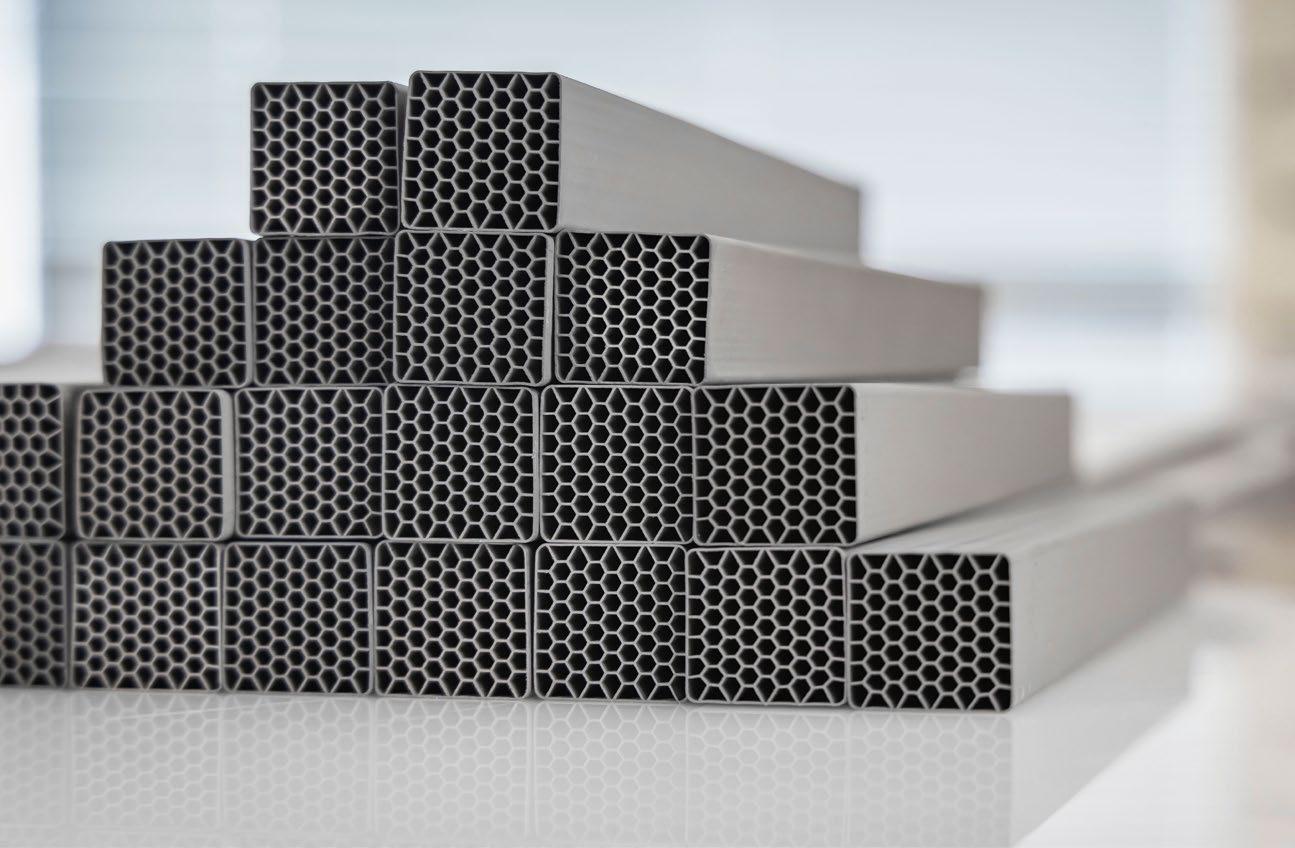
“In developing its expertise from traditional press and sinter PM to encompass MIM, AM, and now MPE, Sintex aims to position itself as one of the leading companies for flexible metal powder-based manufacturing solutions.”
The freedom to choose
In developing its expertise from traditional press and sinter PM to encompass MIM, AM, and now MPE, Sintex aims to position itself as one of the leading companies for flexible metal powder-based manufacturing solutions, able to offer its customers not only the right choice of process, but also the right choice of material for their applications.

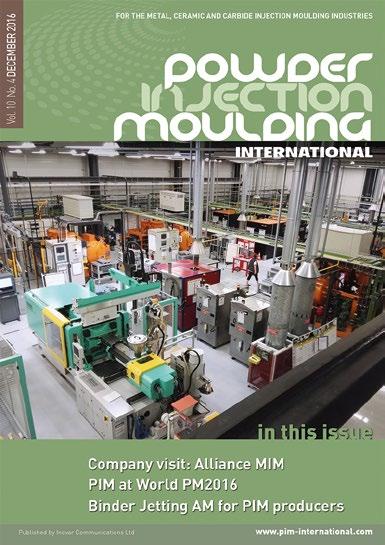
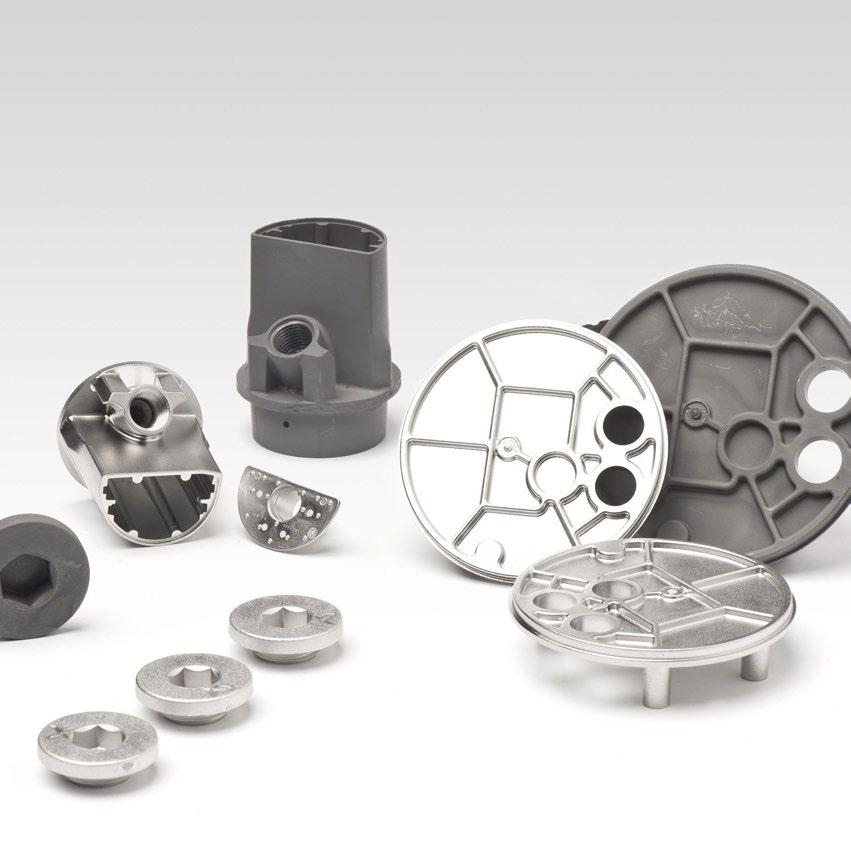
Fig. 7 shows the distribution of the different powder metal processes employed by Sintex as a function of complexity and yearly part quantity. As shown, both AM and MPE ‘break the chart’, as they enable the user to produce geometries that would not be possible with traditional manufacturing technologies. Today, the Sintex team has more than just a hammer in its toolbox, and can help its customers to solve problems larger than just nails.
Authors & contact


Peter Kjeldsteen, Chief of Innovation & Marketing
Peter Valler, Head of Development & Projects
Poul Søgaard, Senior Process Specialist, MIM
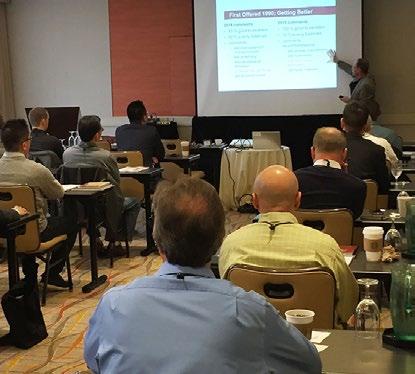
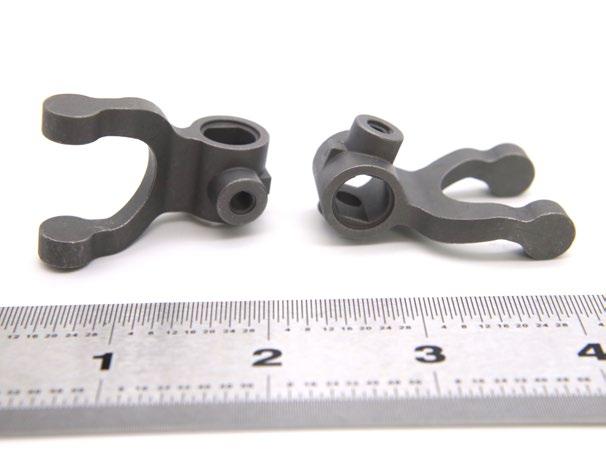
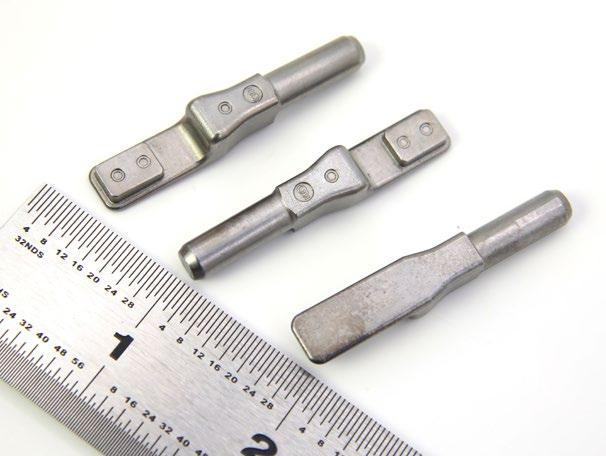
Tritone’s MoldJet: The definitiondefying AM technology advancing steadily toward commercialisation
Tritone’s MoldJet is unique as an Additive Manufacturing process – not Binder Jetting, Material Extrusion, nor Material Jetting, the MoldJet process involves a number of steps that share features with common sinter-based AM technologies, but don’t quite fall under their definitions. But this isn’t simply a novel fringe technology: Tritone’s founders have drawn on extensive experience within Israel’s 2D and 3D printing ecosystem to build a robust AM platform that is very simple, yet highly sophisticated. Joseph Kowen visited Tritone and here reports on the MoldJet process and its potential applications.
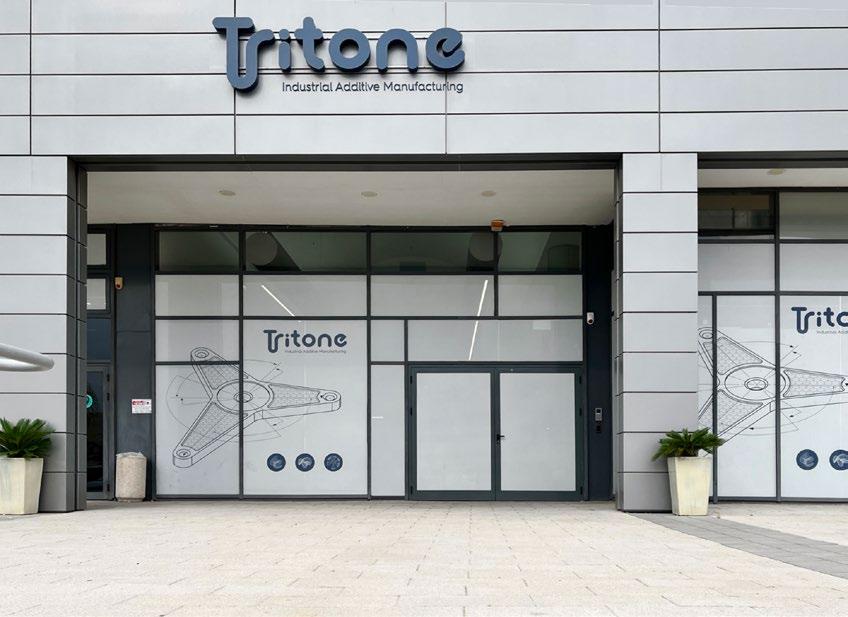
After making my first visit to Tritone a few years back, as the company was just starting out, I grappled with an intriguing thought about how exactly to categorise the process I had just learned about. The standards people drill into us the need to define an AM process as belonging to one of seven categories defined in ISO/ASTM 52900 that, we are told, cover every imaginable way that objects can be additively manufactured layer-by-layer.
I came away with the feeling that the process I had just seen did not quite fit into one of those neatly parsed definitions. After all, it was not exactly ‘Material Jetting’, since the part itself was not jetted, although the process did involve jetting of mould material; nor was it Binder Jetting, since no binder was jetted onto a powder, even though the initial green production parts looked similar to binder jetted parts and involved a form of binding of a powder feedstock. Could it be that this process belonged, all alone, in a new category of Additive Manufacturing processes?
Far be it for me to judge if, in fact, the process broke new definitional grounds. There are standards experts that do that sort of analysis. Clearly, though, I had just seen an innovative new process for making AM parts, at the same time striking in its simplicity and intrigu -

ingly and quietly impressive in its sophistication.
At the heart of the innovation was a concept that avoided directly forming a three-dimensional object layer-by-layer, and focused on additively manufacturing a mould; a negative image of the part being
made. The build cavity is filled with a feedstock in the form of a paste, or a high-viscosity slurry. The feedstock could be metal, or it could be ceramic, and, at the end of the day, the green part that emerges from the built mould requires sintering. The central principle is that the part itself is not jetted, nor is it composed of a powder that is infiltrated or bound or glued together by a binder. We shall describe the process in more detail below.
Fast forward four years. I had followed from afar with interest the development of the early platform I had first seen in 2018. A product had been launched, first beta machines installed, initial sales made, and commercial channels of distribution established. It was time for a peek behind the curtain at Tritone to see what the experience of the past four years had taught it, and more importantly, where the company was headed. I visited Tritone in October 2022, and I can report on a vibrant, yet modest, growing young company, wary of over-promising, and levelheaded about the challenges of taking their innovative platform forward in a managed and realistic way.
Origins
The team that founded Tritone draws its experience from deep within Israel’s 2D and 3D printing ecosystem. The founder, Ofer Ben-Zur, is a mechanical engineer who gained his first printing industry experience with Scitex, one of the country’s earliest technology success stories. He went on to found Kornit Digital, a digital printing company that specialises in printing on textiles using industrial inkjet technology. The roots of the company in an inkjet-driven industrial success story is not just a curious background fact. As we shall see, this experience has imbued the company with the industrial mindset to understand what is needed to build a robust printing platform – this time in three dimensions.


“The roots of the company in an inkjetdriven industrial success story is not just a curious background fact. As we shall see, this experience has imbued the company with the industrial mindset to understand what is needed to build a robust AM platform.”Fig. 2 Tritone’s Dominant MoldJet system Fig. 3 The carousel mechanism of the Dominant AM machine showing the six stations
MoldJet
Tritone MoldJet
How it works

Technology
Forming:
forms cavities of geometry.
The Tritone process in its full version comprises six different processes all encapsulated in a single platform. The output from this process is an ink jetted mould filled with metal (or ceramic) paste. The company called the process MoldJet, a simple name which describes exactly what it does. The flagship machine of the company is called Dominant (Fig. 2). MoldJet and Dominant is a factory in a box. The machine encompasses the building of the mould, inspecting it, and filling it – all in a single enclosure. It is designed in the form of a carousel (Fig. 3). Each build plate revolves through six different stations, each performing a distinct function.
Deposition:
MoldJet
Layer-by-Layer
Build Process
Station 1: Additively manufacturing the mould
forced into all layer.
A negative image of a part, or a setup of multiple parts, is additively manufactured layer-by-layer by jetting a variable layer (25 - 200 μm) of a proprietary waxlike material onto a build plate. Industrial inkjet is a robust and accurate technology that is used in material jetting AM processes, such as Polyjet (Stratasys) and Nano Particle Jetting (XJet), as well as the jetting of binders in all Binder Jetting processes.
Hardening: Inspection:
and hardened, analysis followed by removal if required.
Station 2: Paste filling station
A wiper fills the cavity created in the printed wax layer from Station 1 with a paste containing metallic or ceramic powder. The materials will be described in more detail later.
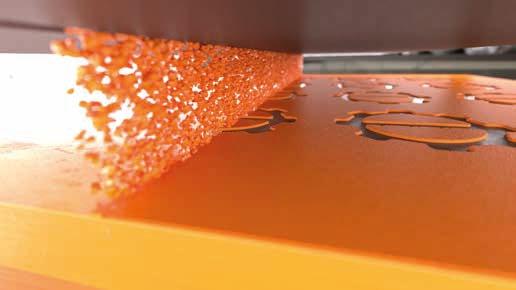
2 4

Station 3: Drying
Since the paste contains a waterbased binder that facilitates its spreadability, it needs to be well dried to form a strong green part.
Station 4: Additional drying
Since drying is the longest process, two stations are dedicated to this function.
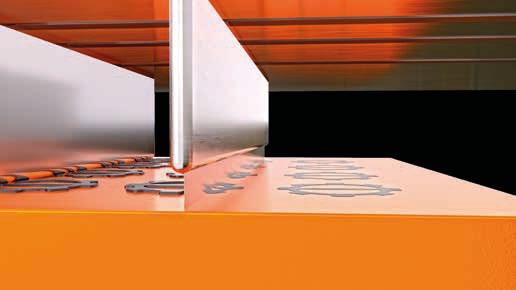
MoldJet Step-by-Step Post Processing
MoldJet Step-by-Step Post Processing

Station 5: Hardening
A vacuum is applied to harden the green layer and prepare it for the next layer.
Station 6: Inspection
The layer is inspected by an AI-driven optical inspection system on the fly to verify that the cavity
has been built and filled according to the layer parameters of the part being additively manufactured. If a layer fails to meet the desired quality standard, it can be mechanically removed by a milling function integrated in Station 2 and a new layer built at Station 1 in the next cycle of the process.
Finished Build Tray:
When removed from the system the tray contains robust green parts embedded in stable hard mold material.
Stainless Steel
Typical Mechanical Properties

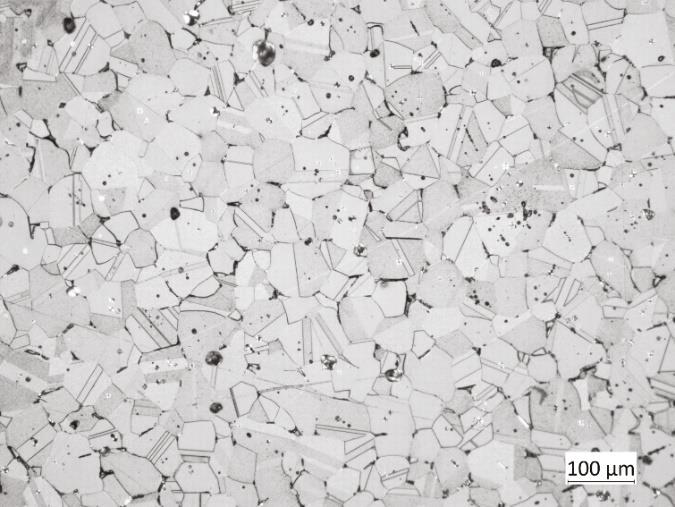
The output
The finished operation produces a build plate containing dried, green parts of metal or ceramic material, encapsulated in the proprietary, waxlike mould material. A key point to understand about the productivity of the machine is that although each build plate must pass through all six stations to produce each layer of the additively manufactured and filled mould, there are up to six build trays in operation at any given time. In addition, if a particular tray is completed, it can be removed from the machine and sent to postprocessing without interrupting the build plates that are still in process, offering flexibility and variability of the contents of each build plate.
Post-processing
A build plate containing the metal or ceramic green parts must undergo processing to remove the wax-like shell. Demoulding is a hands-free process. The first step of the process is the placement of the entire build plate in a standard lab oven heated to 120ºC for around 2-5 hours. The melted mould material is collected in a tray and can be partially reused as a base material on which future moulds can be jetted. At this stage,
“...if a particular tray is completed, it can be removed from the machine and sent to post-processing without interrupting the build plates that are still in process, offering flexibility and variability of the contents of each build plate.”
the material cannot be reused in the inkjet machine. The green parts that emerge from this process are hardened, which makes their handling easier and less prone to breakage, comparable to green MIM or binder jet parts. This is an important consideration in achieving high yields, and for the future implementation of automation systems, such as pick-and-place robots.
The next stage is the cleaning of the parts in a solvent recirculation tank to remove small residues of the mould material. The solvent can be Isopar, a locally sourced material that can be reused until saturated and then recycled. The process could take up to three hours, depending on the size of the build and the geometry of the parts. The parts are then dried in a standard oven for 30 minutes to prepare them for sintering.
Sintering is similar to the process that is used for all sinter-based AM processes (Binder Jetting, Material Extrusion, Material Jetting and Vat Photopolymerisation). However, unlike many other metal AM processes which require a separate debinding stage, MoldJet parts can undergo debinding and sintering in the same process due the low binder content of less than 2% of the green part.
Materials
The MoldJet process supports an extraordinary number of materials considering its young age. That said, not all of the materials should be considered fully commercialised and available at this stage. There are at least thirteen materials that have been approved and are, in principle, available for use with the platform. They are listed in the materials table.
So how can such an impressive range of materials be available for a machine that was first shown publicly at Formnext in November 2019, and for which first beta machines arrived at customer locations starting only in 2021? The answer lies in the simplicity of the process, and the ease with which the basic platform can be converted to use new materials.
Machine specifications
Tritone produces two machines. The Dominant is the full process machine with six processing stations. The Dim machine is a reduced-footprint machine that uses only four processing stations and is therefore considerably
slower than the Dominant. The Dim is generally more suitable for smaller parts, lower quantities or development work. Processes developed for the Dim can be upscaled to the Dominant, as the basic process is identical.

220 cm 3/h
Density Up to 99% Up to 99%
Nominal Layer thickness Variable between 50-100 μ m
Variable between 50-100 μ m
Machine footprint 3,200 x 2,200 x 1,900 mm (L x W x H) 2,150 x 1,960 x 1,800 mm (L x W x H)
Weight 2,300 kg 1,300 kg
Table 2 Machine specifications
Perhaps it might be more instructive to describe what problematic pain points the machine does not have:
• There is no laser or electron beam
• There are no inkjet heads that jet the part itself (although the inkjets do print wax to build the mould)
• There is no jetting of binder that interacts with flowable dry powder
• There is no loose powder of any kind, just cartridgeborne pastes
• There are no specially engineered metal or ceramic powders required for use in the machine
• There is no significant heat or inert gas needed to create the part
• There is no lengthy process required to change materials
The innovation of the material system could be generically
“The MoldJet process supports an extraordinary number of materials considering its young age. That said, not all of the materials should be considered fully commercialised and available at this stage.”
Green Parts
Business development
If simplicity is the word that could be used to describe the MoldJet process, then the same term could be used to describe the company’s business development path and marketing strategy. The company has been fortunate to be supported by a seasoned investor, Fortissimo Capital, with which the founders of Tritone have successfully worked in the past. The experienced management team and investor group are knowledgeable enough to know that the development of reliable mechanical systems, especially those involving new processes and advanced materials, takes time, and no amount of aggressive product development will be able to shorten that process. By all accounts, sufficient resources have been allocated in advance to ensure that the company will be able to bring the product to market in the right way. Not all startups are privileged enough to enjoy such nurturing conditions, and Tritone is fortunate to be one of them. Even so, the company runs a tight ship, and only recently moved to a more spacious office in a suburb of Tel Aviv.
described as follows: MoldJet uses standard off-the-shelf industrial powders, such as those supplied to the MIM industry today, mixed with a water-based binder material, to create a highviscosity, mechanically spreadable paste to create robust green parts in a powder free Additive Manufacturing environment. Green parts produced on the machine are surprisingly strong, as anyone who tried to manually break them at the company’s stand at Formnext 2022 will attest.
No successful metal Additive Manufacturing technology ever succeeded without good metallurgy. All data from testing of the materials and comparing them to the properties of traditional MIM processes seem to show at least close performance to what one would expect from metal injection moulded parts. One of the company’s first customers, Fraunhofer IFAM, conducted tests on the materials with good results (Table 3).
The first machine was supplied to a service provider in Israel with which the company worked closely. In fact, Tritone’s in-house sintering capability is located at the customer’s site, such that the company was able to learn and grow through the supplying of real production parts to industrial customers in Israel. Listening to the market has been a central principle as the company sought to have the platform meet industry’s needs. After gathering initial feedback and conclusions close to home, the company’s second machine was installed at Fraunhofer IFAM in Dresden, Germany Fig. 7).
The Fraunhofer’s brief is to collaborate with industry, and, through this installation, Tritone was able to gather yet more input from real customers.
To date the company has installed machines in Israel, Europe and the US. Its first US installation

was delivered in September 2022 to Alpha Precision Group (APG) in Pennsylvania. The company has also been quietly assembling distributors in key markets, generally companies with experience in other additive technologies, and with the knowledge and connections to locate successful early adopters. In November 2022 the company announced the establishment of its first overseas subsidiary, located in the United States.
So who are – or might be – the early adopters of the Tritone platform? In general, one might say that the typical early customer of the machine would be service providers already invested in, and knowledgeable about, Powder Metallurgy and sintering, looking for new processes and materials to offer tool-less production at short notice of small to medium lot sizes, of relatively small parts, many of which are desirous to take advantage of the design complexity that AM is able to offer. Quite a mouthful, but one which appears to touch, in one complex sentence, on all of the key elements that MoldJet is able to address.

Does that description sound familiar to many readers of this magazine? I suspect it does. Which is not to say that customers of the Dominant will not want to use it for other applications as well, such as larger parts, or even larger runs. Or that customers of the Dominant will be OEMs and not only service providers. Tritone displays impressive larger parts too, even larger than what is generally accepted to be in the sweet spot of metal Binder Jetting. But we think that what is described above is most likely the place where it will first take root.
With such a glowing prognosis, our conclusions might be suspected of being an overly optimistic, rosy-eyed view of the company. So let me quickly add that many of the usual suspects around the business and technological cases for Additive Manufacturing apply here too. The Tritone platform is not immune from questions of cost, time, properties, yield, reliability, lack of automation, when comparing to traditional manufacturing, which all
AM technologies share. But it seems that when compared to quite a number of competing technologies, Tritone’s technology may have successfully been able to address many of the ills or challenges inherent in more mature metal AM processes.
One challenge that Tritone will have to meet is to ensure machine uptime in an environment where six independent processes are occurring in one space at the same time. But this is an engineering challenge that is likely to be met, and not an inherent limitation of one (or a number) of the processes running in the machine. There may be a complex interrelationship between the tasks that each station is required to perform, but each of those tasks, when examined separately, is not more
complex than anything that the AM industry has had to deal with until now. And with a team experienced in bringing robust industrial systems to market, Tritone is better positioned than most to ensure that the technology will not sputter because of failures of engineering.
Applications and business model
The company displays a wide range of possibilities for the kinds of parts that can be successfully made by the machine. The figures in this article do a better job at showing the types of parts
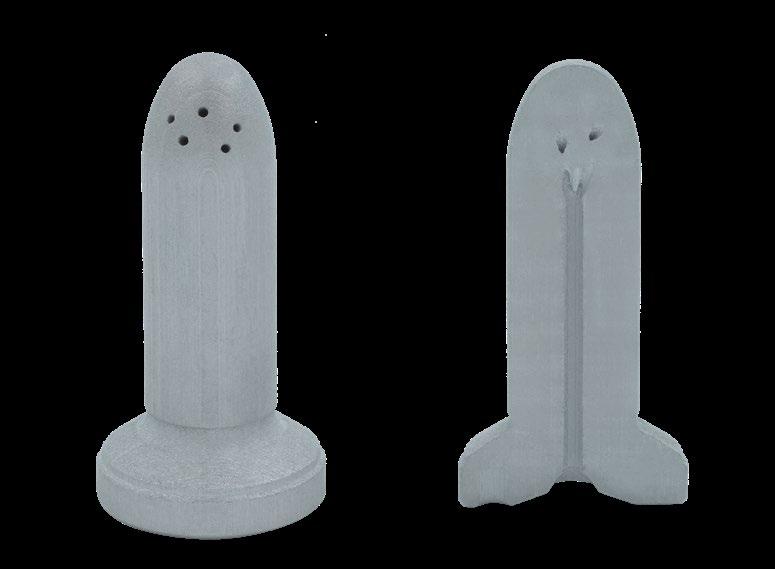
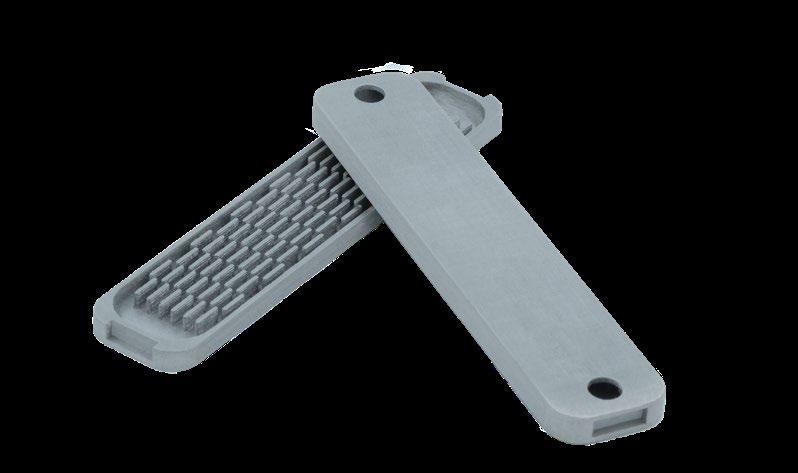
that make sense. If we assume for a moment that ‘anything’ can be additively manufactured, and that ‘almost any materials’ can be efficiently developed to run on the machine, then it all comes down to the business case for a particular part. As the machine makes its way to market, we can expect more applications to find their way to the platform.
Materials are supplied in cartridges by the machine supplier. No third-party materials will be available at this stage out of concern that failure to meet the minimum requirements for the machine could lead to poor results and potential damage to the machine. Tritone has expressed its willingness to work with customers to qualify new materials for use with machine, but this would clearly only make sense if the potential for the application was sufficient to justify the development. The company claims that the amount of effort needed to qualify new materials is very reasonable, since the starting point is standard MIM powders.
Looking ahead
So what should we expect from Tritone in the months and years ahead? At a minimum, we can expect more steady development, more materials put through the machine, and more interesting parts. The challenge will be to find interesting production applications that will showcase the ability of the platform to transition from a machine that can do many things to a platform that can excel at shortrun manufacturing and beyond. That might not happen tomorrow morning, but Tritone appears to be making all the right moves as it journeys towards a more industrial destiny.
The key to MoldJet’s potential lies in the innovative nature of its process. The spreading of a paste containing MIM powder mixed with a water-based binder into a additively manufactured mould has apparent advantages in many facets of the process, from the avoidance of the challenges of powder,

through low binder content and easy debinding, to robust green parts.
It seems that Tritone is betting on the power of paste over the pain of powder.
Author Joseph Kowen is an industry analyst and consultant who has been involved in rapid prototyping and Additive Manufacturing since 1999. He is an Associate Consultant at Wohlers Associates, part of ASTM International’s AM Center of Excellence.
Tel: +972 54 531 1547
www.linkedin.com/in/ joseph-kowen-a5129b3/ Contact
INTERNATONAL CONFERENCE ON POWDER METTALURGY & PARTICULATE MATERIALS (PM 23) & EXHIBITION

Why attend PM 23?
Powder Metallurgy (PM) is a technique in which particulate materials are blended, compacted and sintered to the desired end-use product Few of the advantages the PM offers over other metal forming technologies such as forging and metal casting are advantages in material utilization, shape complexity, near-net-shape dimensional control, etc Over the past few years, PM has been widely recognized as a preferred process for producing high-quality parts for diversified applications The development of lifestyle & health devices, VVT, hybrid vehicles, electric vehicles, fuel cells, catalytic converters, composite electrical contacts, advanced sensors, light weight components and thermoelectric devices have been made possible by the use of several technologies that comprise the science & practice of PM This conference addresses these and related developments by way of presentations made by experts in each field The conference attendees will have access to more than 100 technical presentations from worldwide experts presenting the latest technology developments in this fast-growing field Also, they will have a golden opportunity to get their research published in renowned international journals. The concurrent 48th Annual Technical Meet of PMAI provides a platform for industrialists, researchers and students from scientific establishments & academia to present their work
Important Dates:
2023
2023
Submit your abstract at EASYCHAIR
Publication Partners:
PMAI
TRANSACTIONS OF POWDER METALLURGY ASSOCIATION OF INDIA

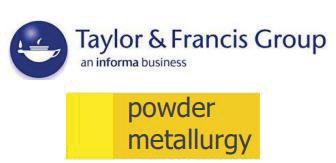
Topics:
❖ Industrial PM (press & sinter) technology forauto, electrical and machine parts
❖ Powder Injection Molding (MIM &CIM)
❖ Additive Manufacturing(AM)
❖ Hard Metals & Diamond Tools
❖ Development of materials & alloys for emerging applications
❖ Technical Ceramics &Composites

❖ Vehicle weight reduction
❖ Porous materials
❖ PM in Electric Vehicles(EVs)
❖ PM in bio-medical apps &devices
❖ Powder production & characterization
❖ Compaction & other forming processes
❖ Binder & feedstock development
❖ Hot Isostatic Pressing(HIP)
Venue:
HOTEL LALIT MUMBAI Sahar Airport, Navpada Marol Andheri East, Mumbai Maharashtra India 400059
❖ Laser sintering, cladding and coating
❖ Testing & data mining
❖ Sintering & post sintering processes
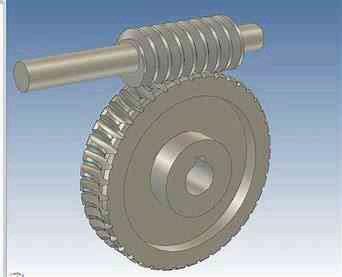
❖ Spark plasma & hot press sintering
❖ Dimensional control
❖ Heat treatment & surface engineering
❖ Aluminum sintering
❖ Refractory metals
❖ Magnetic materials
❖ Materials for aerospace, defense & nuclearapps
❖ Materials for energy generation & storage
❖ Functionally gradient materials
❖ Ceramics & composites
Conference Secretariat
Mr. Swapnil Sable (+91 9096943327)
Mr. K.S.Samant (+91 9820951180)
convener@pmai.in
PowderMet2023
International Conference on Powder Metallurgy & Particulate Materials
CAESARS PALACE
AMPM2023
Additive Manufacturing with Powder Metallurgy
technical program

Attendees will have access to hundreds of technical presentations from worldwide experts on the latest research and development.

June 18–21, 2023 • Caesars Palace, Las Vegas JUNE
TRADE EXHIBIT
The largest annual American exhibit showcasing leading suppliers of powder metallurgy and metal additive manufacturing powders, equipment, and products.
The metal powder-based processing of titanium: MIM and AM-related highlights from the PMTi2022 conference


Since the very first PM Titanium conference in Brisbane, Australia, in 2011, the PMTi series has been the essential meeting point where technical and commercial advances in the powder-based production of titanium parts are discussed. Encompassing production technologies from Metal Injection Moulding to Additive Manufacturing, this year’s event was no different. As Dr Thomas Ebel reports, the technologies involved have moved significantly towards production readiness, but with the ever-present playoff of non-negotiable performance goals against the drive to reduce cost.
After six successful PMTi conferences, one might consider the event’s evolution by comparing the first meeting in 2011 in Brisbane and the most recent edition, held this year at McGill University in Montréal, Canada, from August 29–31. The conference was chaired by LouisPhilippe Lefebvre, National Research Council Canada; Mathieu Brochu, McGill University, and Vladimir Brailovski, ETS Montréal. Due to the ongoing pandemic, the meeting was organised as a hybrid online/ in-person event; despite this, eighty participants attended in person. In total, 130 participants from twelve countries attended, illustrating the high level of interest in this conference.


Since its beginnings in 2011, originator Ma Qian intended the conference to bring together those in the titanium Powder Metallurgy industry to form a ‘task force’ for accelerating both research and industrial application of the market and, indeed, this is still a common goal of the attendees travelling long distances to take part. At the first conference in Brisbane, Australia, most of the presentations given were
rather scientific in nature, but even a talk showing the ductile behaviour of a Ti-6Al-4V alloy processed by Metal Injection Moulding resulted in high levels of interest. More attendees have joined the conference with each edition, creating the excellent platform that it is today
for knowledge exchange between researchers and the industry. Today, for the properties of sintered or melted titanium alloys to match those of wrought material is standard; even high fatigue properties are achieved. The number of shaping technologies, however,
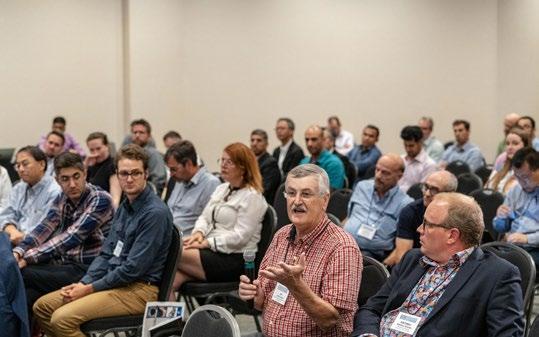
has increased significantly. Now, Additive Manufacturing is the main technology covered at the event, with the chief focus being on sinter-based techniques and Laser or Electron Beam Powder Bed Fusion (PBF-LB or -EB). The reality is that titanium MIM seems to be well established, with only smaller levels of research still necessary. At this year’s event in Montréal, Canada, talks given concerning MIM served mostly as a reference for AM techniques, and MIM itself was rarely the subject of further developments discussed.
In 2011, one topic was already at the forefront: cost reduction of titanium parts. By 2022, this goal was not only present at, but dominated the entire conference, with the
phrase ‘low-cost’ present in almost all presentations. The most common cost-cutting strategy remains the use of ‘cheap’ powders in technologies running at the lowest costs possible. For mass production, this still means using MIM; for mid-range production volumes, Binder Jetting (BJT) is probably best suited and, for small volumes, other AM technologies may be applicable.
In Brisbane, one approach presented for cost reduction was the use of cheaper powders for noncritical applications with reduced demands for ductility; it appears that this approach has not been successful. Today’s demand is for low-cost powders which retain good mechanical properties, typically
at least fulfilling ASTM standards requirements. This was the clear position of Zak Fang, of the University of Utah, who gave the first talk at the PMTi2022 conference [1]. At the start of his presentation on a holistic approach to low-cost titanium he stated, ‘Performance is non-negotiable.’
A holistic approach to low-cost titanium
In his presentation, Fang pointed out the importance of cost reduction at every step, from powder production to the finished component. From the reducing agent for Ti-sponge production, cost reduction can be enacted by using Mg rather than the much more expensive Na or Ca. The current processes from Ti containing ore or slag are still too complicated and expensive; a generally promising way is extracting TiO 2 by alkaline roasting and solution hydrolysis followed by direct reduction to powder using Mg. The thermodynamical challenge for the reduction is that MgO is only more stable than TiO down to 2 wt.% oxygen – still too high of a level compared to typical standards.
With this in mind, Fang added hydrogen to the titanium oxide forming TiOH, thus increasing the oxygen potential (see Fig. 2), which becomes higher than that of MgO even for low oxygen levels. Mg can break up the titanium oxide and extract the oxygen, producing a porous, low-oxygen (< 2 wt.%, dissolved) containing titaniumhydride. In a second step, dissolved oxygen content is reduced further by the usage of molten salt (containing MgCl 2) to values below 0.2 wt.% (typically below 0.12 wt.%). Now, the titanium hydride can be used directly or turned into titanium via a dehydriding process. Fang referred to the process as Hydrogen Assisted Magnesiothermic Reduction (HAMR). This process also works with Ca in place of Mg.
The costs for HAMR are significantly lower than for conventional

“In 2011, one topic was already at the forefront: cost reduction of titanium parts. By 2022, this goal was not only present at, but dominated the entire conference, with the phrase ‘low-cost’ present in almost all presentations.”
production using the Kroll or other processes and the HAMR process is easily scalable. It is expected that the process can be made cost equivalent to titanium sponge and –in combination with a Granulation, Sintering, Deoxygenation process (GSD) – it can be used to produce spherical powders from any raw material, including scrap. Comparisons with commercially available powders have shown equivalent properties of parts produced. As Fang stated, this is only one step to cost reduction. To manufacture a low-price component, these powders have to be processed by cost effective processes. Here, MIM and AM techniques might be appropriate, depending on geometry and number of parts required. The drawback is that all powder-based processes have issues with respect to impurities, building defects, porosity, microstructure and, in particular, fatigue behaviour, which is strongly influenced by defects and microstructure size. The goal is to achieve the same dense microstructure that is found in wrought material. In the case of Ti-6Al-4V, fine globular or bimodal structures are the most common, while typical
sintered material shows a coarse lamellar structure. Fang showed that, via the Hydrogen Sintering and Phase Transformation (HSPT) process, it is possible to create basically the same microstructure as in wrought material.



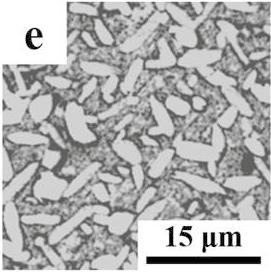

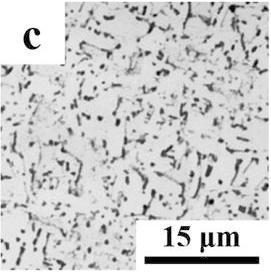
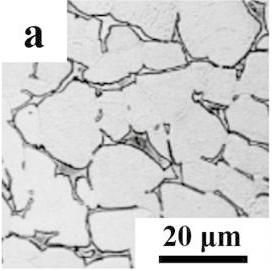
The alloy is loaded with hydrogen, leading to a phase diagram containing an eutectoid reaction point. This allows for similar changes in the microstructure by heat treatments (as is done in steel refining). In the case of (Ti-6Al-4V)-H, the utilisation of the six different phase regions facilitates the fine tuning of the microstructure via smart heat treatment. Fig. 3 displays a comparison between typical microstructures

of wrought material and powders processed by HSPT. Fatigue tests proved equivalent properties. The static properties meet the requirements in ASTM B348 for wrought material.

HDH Ti-6Al-4V for Laser Beam Powder Bed Fusion
In many presentations at this year’s PMTi, HydrogenationDehydrogenation (HDH) was a topic referenced either as it relates to the production or processing of low-cost powders. Muktesh Paliwal, from Kymera International, reported on usage of HDH powder in PBF-LB [2].
“The drawback is that all powderbased processes have issues with respect to impurities, building defects, porosity, microstructure and, in particular, fatigue behaviour, which is strongly influenced by defects and microstructure size.”
According to his calculations, material represents the second largest cost in the production of a component by PBF-LB, so a reduction in this respect would clearly be beneficial.
HDH powders are commonly irregular in shape, while spherical powders are preferred for Powder Bed Fusion processes in order to provide uniform spreadability. It is possible to apply plasma spheroidisation to the HDH powders to transform their shape, but this involves an additional process and, thus, higher costs. In the study presented, Ti-6Al-4V HDH powder with a d90 of 89 μ m was used, and the optimal process parameters were determined by systematic variation of scan speed,
laser power, hatch distance, stripe width and layer thickness. The fabricated samples were partly annealed at 704°C for 2 h, HIPed, or both. The oxygen content of the as-built parts resulted in 0.17 wt.%, thus meeting grade 5 requirements.
Fig. 4 shows the resulting microstructure. As shown, the HIP process closed the pores in the material and the annealing process removed the α ’-martensite (dark black lines in the left image). After these processes, the tensile tests revealed a yield strength of 1039 MPa and a maximum strain of 16.1%. These values are equivalent to those of wrought material and PBF-LB specimens manufactured using spherical powders. At the end
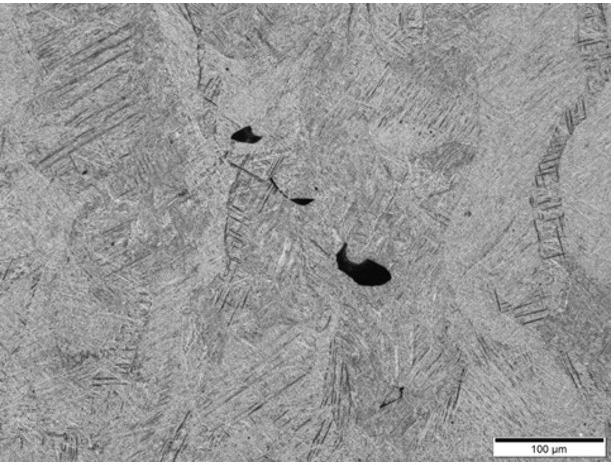
of his talk, Paliwal showed pictures of an electronic box and a topological optimised bracket – both intended for use in aerospace – which could be successfully manufactured from the irregular HDH powders.
Quasi-spherical unalloyed Ti powders from HDH powders by gas-solid fluidisation
Gang Chen, from the University of Science and Technology, Beijing, China, presented a study on quasi-spherical unalloyed titanium powders produced from HDH powders by gas-solid fluidisation [3]. The process is outlined schematically in Fig. 5. Chen estimated
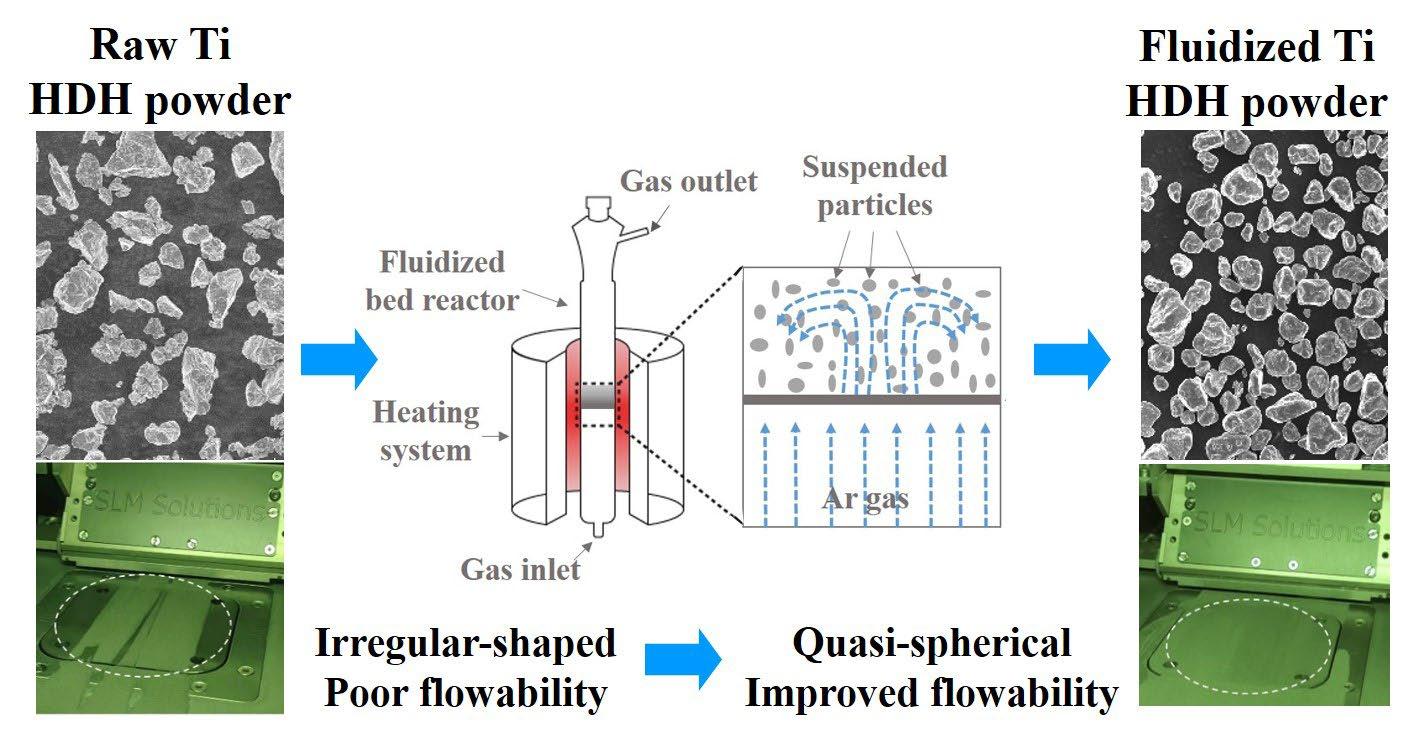
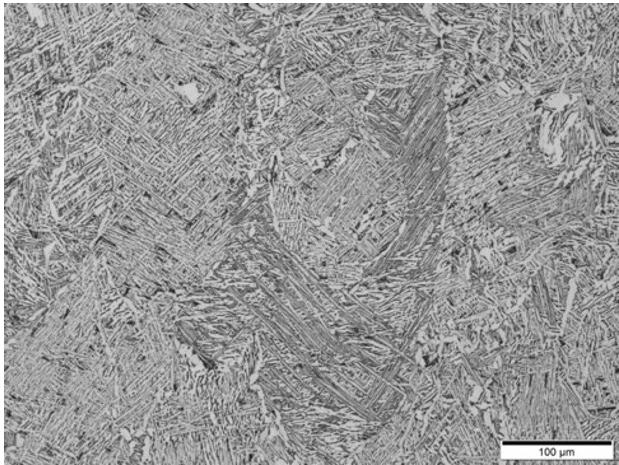
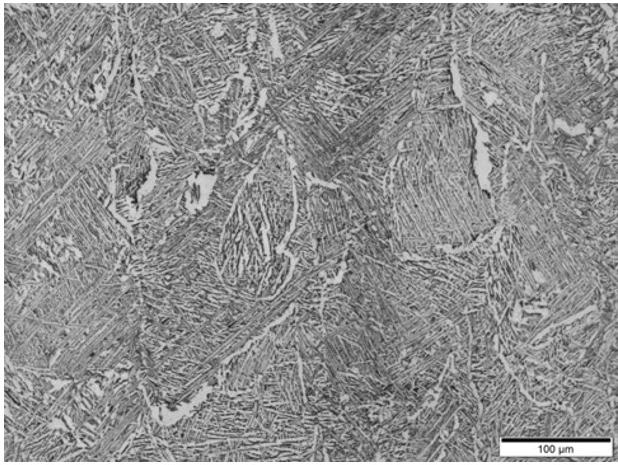
that the cost for these quasi-spherical powders is less than 50% of the cost of atomised ones. Depending on processing temperature and time, the d50 value can be fine-tuned between about 28–34 μ m due to interparticle adhesion, which also allows adjustments in flowability. Processing at 450°C for 10 min led to a Hall flowability below 40 sec/50 g, comparable to those of typical plasma and gas atomised powders. The oxygen content was determined to be 0.16 wt.%, compared to 0.13 wt.% of the raw powder. The apparent density was increased from 2.04 to 2.48 g/ cm 3. To evaluate the suitability of powders for Additive Manufacturing, three different PBF-LB machines were used to produce different shaped specimens and parts successfully. The tensile properties of the as-built Ti parts using the fluidised HDH powders were comparable to those of more expensive atomised powders.

Improving densities of titanium alloys using the CHAD method

At PMTi 2019, Chengshang Zhou, from Central South University, Changsha, China, showed that hydrogen treatments can be used for the densification of powders or porous sintered parts, similar to HIP. In Montréal, he presented further promising results using the CHAD (Constrained Hydrogenation Assisted Densification) method [4].
Using the CHAD method, the powder or sintered part is enclosed in a rigid cell and subjected to heat treatment under hydrogen. The hydrogen uptake allows the part to expand, which leads to high compressive stress in its confined state. The result is a densification of the initially porous material. Fig. 6 shows the process chain of sintering, hydrogenation and dehydrogenation. It is important to ensure that the relationship between the hydrogen content and temperature is such that the material is ductile (repre -

sented by the green area in the phase diagram), meaning that the hydrogen has to be in solution and without a TiH 2 phase.
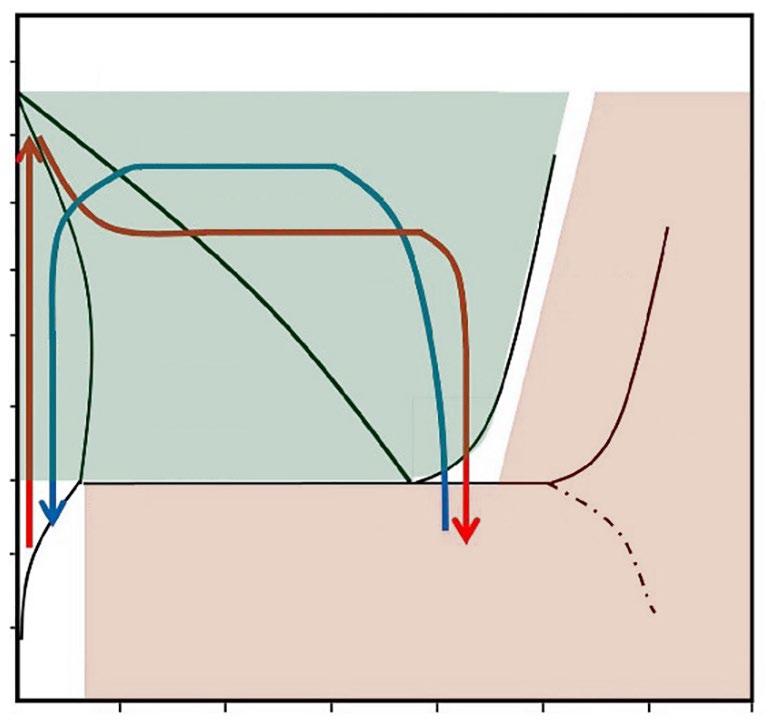
In his study, Zhou looked at the effects of the CHAD process on CP-Ti and Ti-6Al-4V powders. Fig. 7 shows
the microstructure of the as-sintered CP-Ti and that, after CHAD, porosity analysis by microscopy and μ CT revealed the closure of most pores. The remaining ones were reduced in size and uniformly distributed, revealing the isotropic type of
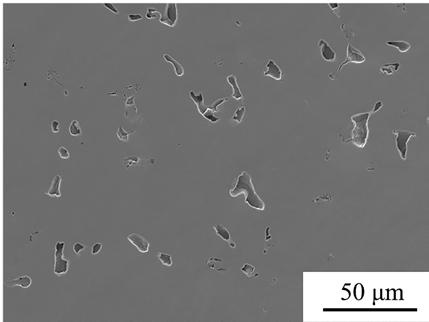
compressive process. Processing of Ti-6Al-4V led to a similar result. Tensile tests, in particular, showed a significant improvement in ductility. CP-Ti achieved a 451 MPa yield strength and 17% elongation after sintering at 1200°C and subsequent CHAD processing, while Ti-6Al-4V reached 959 MPa and 12%, respectively.

The powder-based processing of TiNi alloys
At prior events, Efraín CarreñoMorelli from the University of Applied Sciences and Arts Western Switzerland has pointed out the benefits of TiH 2 for sintering. At the PMTi conference in Montréal, he summarised the previous work on the processing of Ti-Ni alloys and added some more interesting information on recent successes [5]. Ti-Ni alloys are of interest because of their shape memory capability and superelastic behaviour; in the medical industry,
they have already seen extensive use in components like stents.
In his talk, Carreño-Morelli presented the materials physics explanation of these special properties – basically a transformation between a martensitic and an austenitic phase by both mechanical and thermal load. He pointed out the importance of alloy composition on the efficiency of the effects and the transformation temperatures. Typically, the materials are conventionally processed in a rather elaborate way by hot and cold working, machining, and a final thermal treatment. Powder Metallurgy could reduce the costs by net-shape production and reduction of scrap, but it is difficult to purchase appropriate pre-alloyed powders, while usage of elemental powders needs careful monitoring during sintering.
In all cases, possible contamination is an issue accompanying the whole processing chain and can influence the final properties of the
sintered part. According to the ASTM F2063-05 standard for wrought TiNi, the content of oxygen and nitrogen must not exceed 0.05 wt.% in total, which is a very low value with respect to sintered titanium alloys.
Carreño-Morelli evaluated previous studies on the choice of base powders used to form the alloy: Pre-alloyed powders lead to good results, but are very expensive, while blending Ni and Ti powders leads to reactions that are difficult to control. Elemental TiH 2 and Ni powders, however, have appeared as a promising alternative.
The powders used had a d50 value of 9.8 μ m for TiH 2 and 6.9 μ m for Ni carbonyl. They were blended with polyethylene, paraffin wax and stearic acid to form a PIM feedstock. The sintered density of ‘dog bone’ tensile test specimens was 97.5%, with transformation heat and peak temperatures similar to the values of comparable melt-cast alloys. The shape memory behaviour is shown in Fig. 8, where a recoverable strain of about 4% under 100 MPa tensile stress is visible, illustrating the positive results when manufacturing with the powder mixture.
In an analogous manner, the utilisation of pre-alloyed powders for PIM feedstock led to good shape memory properties, too, even if the content of oxygen was 0.12 wt.%. By improving the debinding process, carbide formation was reduced, and a heat treatment involving quenching made it possible to avoid precipitation of the Ni 4Ti 3 phase, which is detrimental to the material’s shape memory properties.
Carreño-Morelli also showed examples for the processing of pre-alloyed and elemental powders by SG-Additive Manufacturing (Solvent on Granules Additive Manufacturing, a sinter-based technique using locally applied solvents on granulated powder and binder), and Binder Jetting. In all cases, basic shape memory properties could be achieved.
The highlighted research shown was Ni-Ti as processed via PBF-LB. Here, pre-alloyed powder with d50 of
40.3 μ m was successfully processed to different demonstration geometries (e.g., stents and files). In contrast to other studies, test specimens were examined under tensile load. Fig. 9 shows the very good results with respect to the superelastic properties of as-built and heat-treated material.
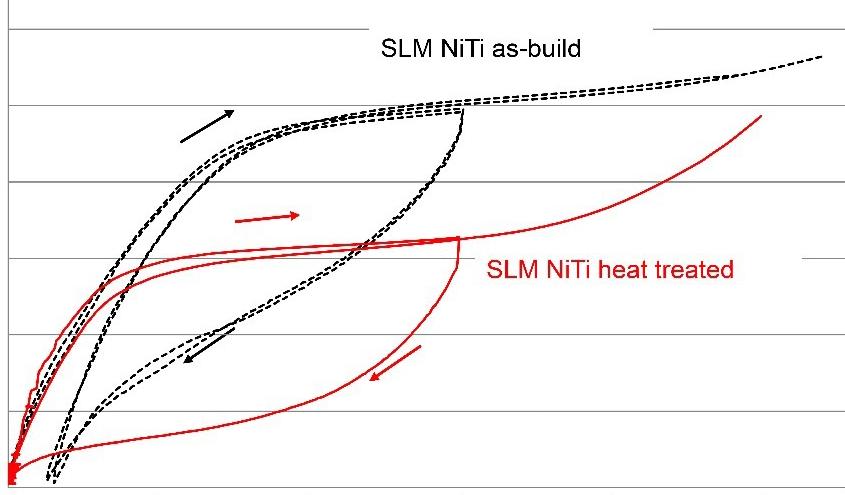
Overall, the presentation showed that Ti-Ni can be processed from different powders and by various PM technologies to achieve sound properties, though costs, contamination and processing details are still important issues. Carreño-Morelli announced that more research on SG-AM and Binder Jetting is in progress. He closed his presentation noting that Ti-Ni samples made by PBF-LB will be part of an investigation about materials ageing under space conditions, which will take place within the ESA/CNES funded project Euro Material Ageing (Fig. 10).
Evaluation of nitinol produced via powder-based forming routes
PM fabrication using Ni-Ti powders was also the topic of a talk by Paul Sheffields, Praxis Technology, USA [6]. As mentioned above, the processing is possible, but difficult
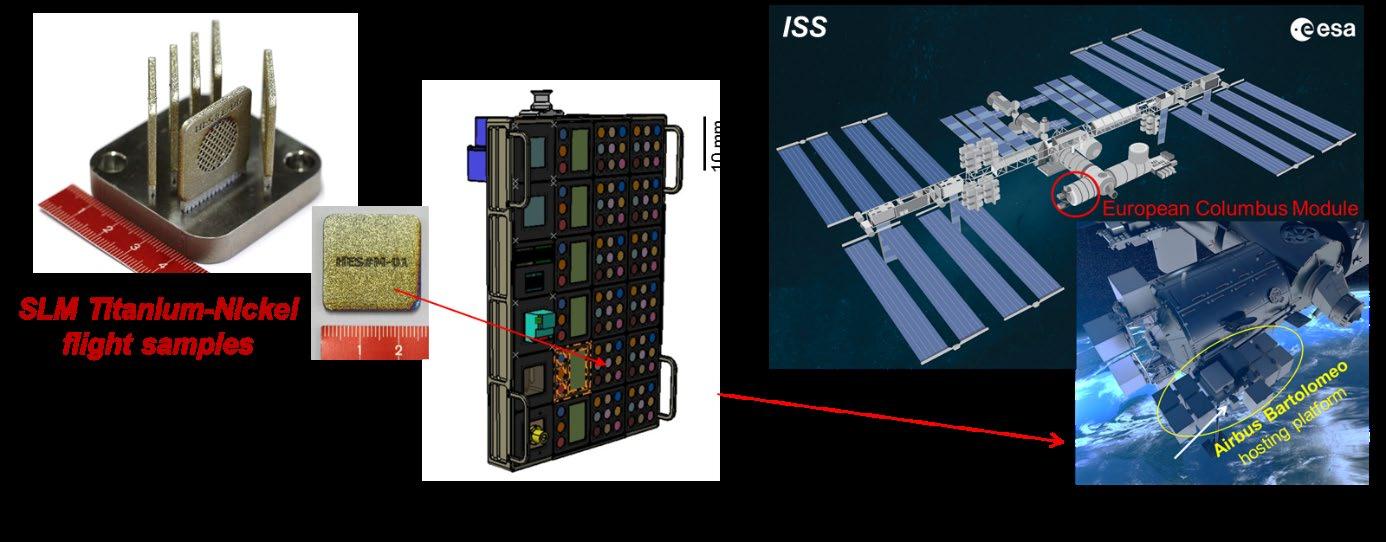
– and not all challenges have been mastered. In particular, the shape memory effect is difficult to control – the focus of Sheffields’ presentation was on superelasticity.

The Austenite Finishing transition temperature Af must be exceeded to achieve superelasticity, but this can be difficult, as it is affected by interstitial level, Ni content, density and microstructure. As previously described, the elemental approach is connected to hardly controllable reactions between the powders, which results in unwanted phases and other drawbacks like Kirkendall porosity
and eutectic melting.
Pre-alloyed gas atomised powders with a d50 of 20 μ m were produced for the study and processed by PBF-LB, MIM and Binder Jetting. For PBF-LB, the powder size was 15–53 μ m. In the case of the specimens made by BJT, it turned out that sintering under argon did not lead to sufficient density; sintering under a pure hydrogen atmosphere, however, worked well, and a density of 95% could be achieved. In the case of MIM – after optimisation of the sintering parameters to 1260°C / 6 h – a density of 78% was achieved in an argon atmosphere.
Processing by PBF-LB yielded the highest density, at 98%. Despite sintering in hydrogen, the interstital levels in the BJT samples (O: 0.381 wt.%; C: 0.124 wt.%) were significantly higher than in the MIM material (O: 0.17 wt.%; C: 0.036 wt.%). The hydrogen level was low in all samples.
According to different interstial content and density, the evaluation of the A f transition temperature revealed different values. While PBF-LB led to an Af of 57°C, MIM and BJT resulted in 92°C and 97°C, respectively. These values are well above room temperature, so superelastic properties must also be tested at these elevated temperatures.
A simulation of an additional HIP treatment by applying a heat treatment (1050°C / 3 h) under vacuum lowered the Af value in the case of MIM and BJT (sintered in Ar), while increasing it for PBF-LB specimens. In the latter case, this effect was possibly due to grain coarsening, but further research wasn’t able to be undertaken in this study due to geometric restrictions and testing issues. Sheffields announced his intended future work in achieving higher densification in MIM and BJT specimens, HIP processing and adjustment of the debinding step in order to reduce the interstial content. This – and a possible
addition of Ni – should lower the Af transition temperature to room temperature.
Opportunities for titanium in hydrogen technologies: The case of bipolar plates
Carlos Romero, from University Carlos III in Madrid, Spain, showed that hydrogen cannot only be used for facilitating the processing of titanium, but also to produce hydrogen [7]. He reported on results gathered from the EU project PERMEABLE’s work on the production of titanium Bipolar Plates (BP) for electrolysers. These plates are part of the Proton Exchange Membrane (PEM) cells used for the separation of oxygen and hydrogen from water molecules by application of an electric field. PM production of these plates and the connected porous transport layers (PTL) could significantly reduce their costs.
Aside from the mechanical and geometrical properties, two other characteristics are essential for the performance of the BPs: corrosion resistance and interface contact resistance (ICR) between BP and PTL. Pure oxygen and hydrogen are highly reactive, thus titanium requires a coating to reduce the corrosion rate – coatings that might
increase the ICR, which would be detrimental to the BP’s performances. As a solution, a nitriding process was chosen, resulting in a TiN coating. Because TiN is conductive, the ICR decreases compared to Ti alone, whilst also improving the corrosion resistance.
In the work presented by Romero, he produced porous Ti structures from TiH 2 mixed with space holders from NH 4HCO 3. Different sizes of space holders were used, up to 500 μ m, and porosity levels between 49–62% were realised. Sintering took place under argon at 1000°C for 2 h and, subsequently, a nitriding process was applied under a pressure of 1 bar of pure nitrogen at 1000°C for 2 h. This process showed that a one-step sintering and nitriding process was beneficial with regard to the achieved properties. XPS analysis of the surface revealed a composition of 31 at.% TiN and 69 at.% Ti(O,N)/TiO 2. The thickness of the layer amounted to several hundreds of nm.
Fig. 11 shows the differences in ICR depending on the treatment. Nitriding lowered the value significantly; this held true even after corrosion. While these are promising results, Romero reported that recent studies suggest the corrosion conditions in PEMEC may be less aggressive than expected. This means that coated steel might be a viable option, so it isn’t clear if the results from this study will facilitate practical application of PM of titanium in future.
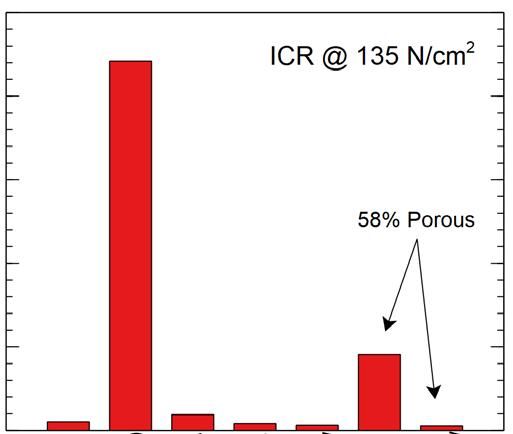
Titanium MIM and Binder Jetting
Robert Swenson, from TriTech Titanium Parts, USA, compared his company’s experience with Binder Jetting with its experience of MIM [8]. Even if most of the processing chain is identical, he stated, a big difference exists in the time needed to start production. For MIM, the bottleneck is the manufacturing of the mould, which typically lasts two-to-five months before the final
geometry is fixed. In BJT, however, the evaluation of a design and management of possible shrinkage and deformation from sintering only takes two-to-five days.
Swenson pointed out some of the typical differences of MIM and BJT leading to different shrinkage behaviour. In MIM, because of the high solid load of the feedstock and the isotropic injection moulding process, the powder packing of the green part is uniform and shrinkage can be assumed to be almost the same in all directions. In contrast, BJT produces a lower green density, which might lead to different shrinkage in the x, y and z directions.
Swensen presented three ways in which manufacturers can counter deformation during sintering, some of which are also used in MIM:
1. Use of ceramic setters the part can land on

2. ‘Live setters,’ which are auxiliary parts additively manufactured together with the component and thus shrink in the same way
3. The use of a simulation software (like Desktop Metal’s Live Sinter, which is delivered together with its BJT machines). After calibrating the software to the deformation of a sample part, the geometry of the green part is adjusted with respect to the expected distortion
Table 1 compares the typical properties of Ti-6Al-4V processed by BJT and MIM. As shown, MIM achieved slightly better properties – while binder jetted material meets the requirements of the ASTM MIM standard F2885, there is still room for optimisation with respect to powder size distribution, binder and processing parameters. Which technique is the best choice depends on production volume and complexity, as well as the necessary precision, surface quality and further parameters.
Ti-6Al-2Sn-4Zr-2Mo alloy rods fabricated using Cold Spray, HIP and Spark Plasma Sintering
A promising technology to create larger preforms or parts with high mechanical properties in comparably short time is Cold Spray. Christian Doblin from CSIRO in Melbourne, Australia, presented a comparative study of a Ti6242 (Ti-6Al-2Sn-4Zr2Mo-0.8Si) alloy processed by three different Powder Metallurgy techniques: Cold Spray, HIP and Spark Plasma Sintering (SPS) [9]. All results were compared to the properties of wrought material. The study was specifically geared towards
reducing the production cost of netshape preforms for high-temperature applications.
Pre-alloyed powder in a size range of 15–45 μ m served as raw material for the three techniques. All specimens produced were characterised with regard to chemical and mechanical properties, as well as to porosity and microstructure. Cylinders with a diameter of almost 30 mm and a height of 85 mm were produced by CS using nitrogen gas at 900°C and 6 MPa pressure. The powder feed was 480 g/h. After Cold Spray, the rods were machined to 25 mm diameter and 76 mm length. Some rods were additionally HIPed at 900 °C, 200 MPa, for 4 h, reducing the porosity from 6.5 to 0.3%. The CS process increased
the oxygen content from 0.08 to 0.17 wt.% and the nitrogen level from less than 0.01 to 0.02 wt.%; the additional HIP process did not change these values. Thus, the amount of O and N is within the corresponding specification.
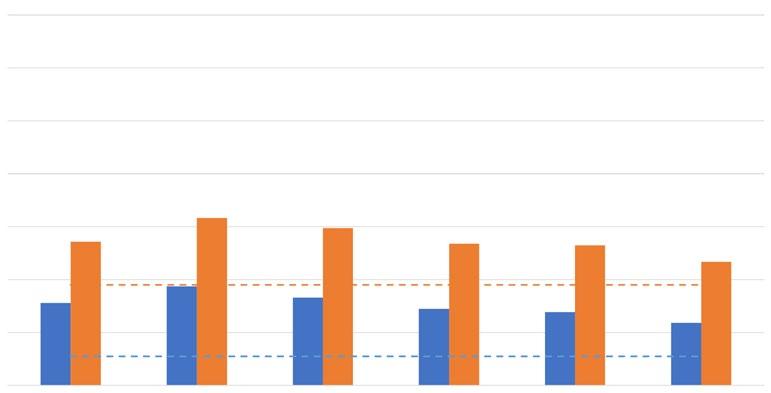
SPS and HIP of the powders as alternative routes were performed
within the α / β -regime of the alloy. All materials were subjected to rotary swaging as a thermal-mechanicalprocessing step (TMP) and to a final duplex annealing. A comparison of the microstructures revealed freedom from defects and equivalence to the wrought material. Tensile tests were performed at room temperature, at
316°C and at 538°C. All PM materials showed similar or better strength and ductility than the wrought material. Fig. 12 showcases the results for UTS and YS at 538°C.
In his summary, Doblin highlighted the fact that Cold Spray proved as a promising method for net shape preform production in connection to potential cost reduction.
Cold Spray AM: CP titanium breakthroughs
This was also the thesis of Alex Finch from Titomic USA, a company focused on Cold Spray Additive Manufacturing. His presentation aimed in pointing out the benefits of this technology with respect to performance and economics [10]. Titomic’s facilities enable a build rate of up to 45 kg/h with a resultant maximum part size of about 9 x 3 x 1.5 m. Finch discussed the economic and environmental advantages of using HDH Ti powders instead of gas atomised Ti-6Al-4V for the Cold Spray process. Because HDH Ti powders
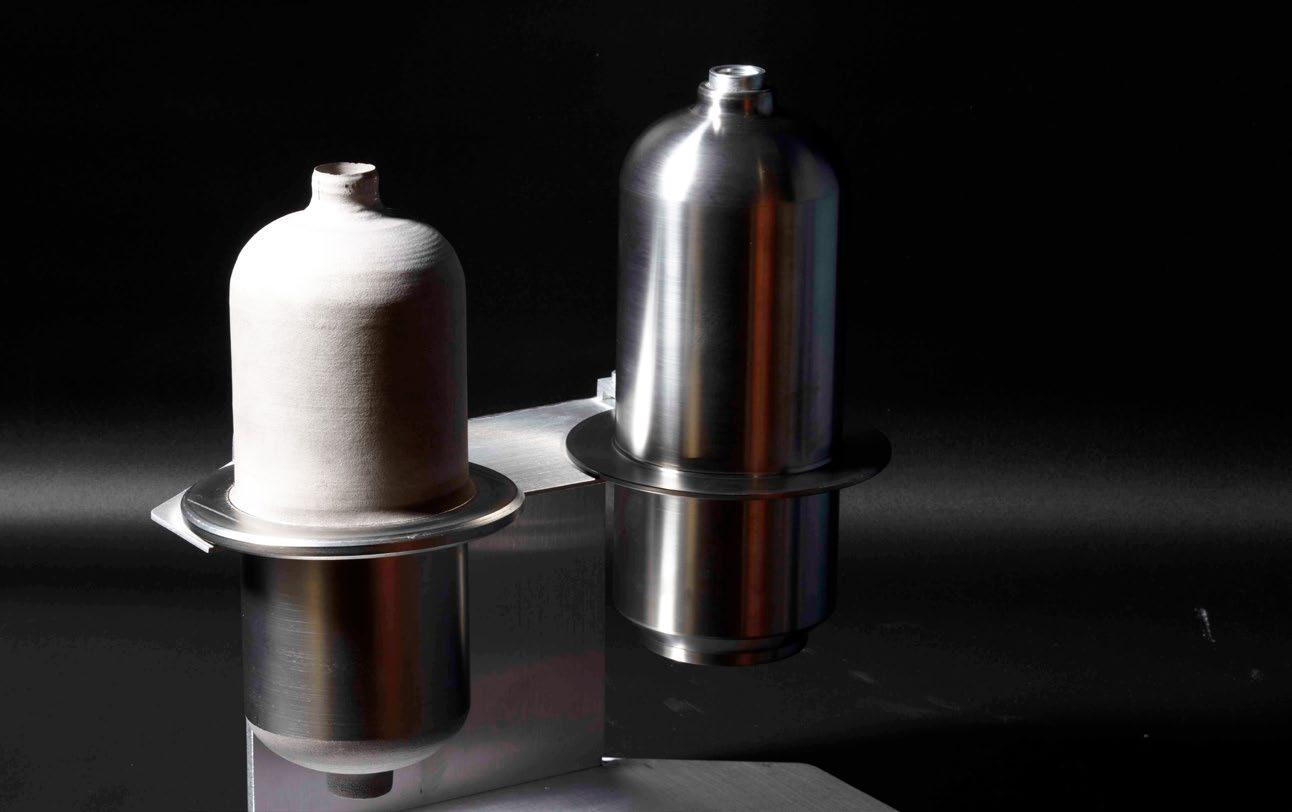
are extracted directly from the Ti sponge, expensive steps preparing the raw material for gas atomisation can be avoided. Moreover, only one fourth of the energy for gas atomisation is needed in the case of HDH production.
Finch showed that mechanical properties like strength and elongation to fracture of the Cold Spray material can be tuned to the requirements of the application by oxygen content and processing parameters – for example, a UTS of 727 MPa combined with 10% elongation is one of the possible specifications which is sufficient for many applications. In his last slides, Finch showed some pictures of products produced by Cold Spray from HDH Ti powders. One example was a deployable satellite antenna hub of 60 kg weight and 1.3 m diameter, which was produced for about half the costs of conventional production from billet because of Cold Spray’s near-net shape production. Finch showcased a thin-walled propellant/chemical processing tank of about 35 cm length and 18 cm diameter (Fig. 13). The thickness is customisable. The component was built in less than one hour and no joining areas or
heat affected zones – both of which could be critical for failure of the tank – were needed.

Cold rolling and annealing of Ti-6Al-4V and Ti-5Al2.5Fe roll compacted strips
While Cold Spray has been a feature of PMTi since its beginning, Shannon Clemens, from Dalhousie University, Nova Scotia, Canada, presented her work on another technique which is only rarely referenced: Direct Powder Roll (DPR) [11]. Her work on the DPR compaction of titanium alloy strips
was motivated by a potential cost reduction, because the energyintensive issue of ingot production and processing can be avoided. For her investigation, Clemens used two different powder mixtures with the compositions Ti-6Al-4V and Ti-5Al2.5Fe, both well-known α / β -alloys. The aim was to optimise their processing with respect to density, microstructure and mechanical properties.
Roughly, the powders were roll compacted to strips, sintered, and then cold rolled. For the study, four different rolling paths were developed (as shown in Fig. 14).
“Finch showed that mechanical properties like strength and elongation to fracture of the Cold Spray material can be tuned to the requirements of the application by oxygen content and processing parameters...”
The evaluation of the chemical composition revealed a large scattering of Al, V and Fe content, respectively. It appears that there is a loss of these elements during processing, which cannot be distinctly allocated to the rolling path itself, though the reason for this scattering is not yet clear. The oxygen contents of the final parts were in the range between 0.25-0.36 wt.%. UTS and ductility achieved values between 570-860 MPa and from 2 to 11%, respectively. The scattered composition and oxygen levels made it difficult to make a clear correlation. Clemens was able to determine the relationships between titanium content and oxygen as well as oxygen content and UTS, though no clear effect of oxygen on ductility was visible. A general result from this study was that the DPR facilities were able to produce high-density strips using all four paths. With respect to wrought material, it was possible to achieve comparable strength and ductility.
Scaling sinter-based titanium AM technologies
Once more, PMTi2022 showed how many different technologies based on powders exist. This is especially the case when it comes to Additive
Manufacturing technologies which involve binder and require debinding and sintering steps. In two talks, Matthias Scharvogel [12] and Johannes Schaper [13] from Element 22, Germany, gave an overview of some of these techniques, as well as of their commercial applications and performance.
The two presentations showed that, in general, the mechanical properties of sintered titanium alloy parts are equivalent to those of specimens manufactured by PBF-LB or PBF-EB, if adequate powders, binders and sintering processes are used. This result is basically independent of the shaping technology applied. As long as the fabrication process does not introduce specific critical defects, the sintering process results in similar properties.
Scharvogel reported on a comprehensive study using spherical Ti-6Al-4V powders under 20 μ m, produced by Element 22’s ‘SBS’ sintering process, which lends itself to fine microstructures and low porosity (typically between 0.5 and 2%). While keeping powder and sintering process constant, the researchers applied a number of different shaping techniques including MIM, filament- and pelletbased Material Extrusion (MEX), Cold Metal Fusion (CMF) and Tritone’s MoldJet technology.
Filament-based MEX utilises metal-filled filaments, while pelletbased MEX is based on normal MIM feedstock granules. CMF processes granules made from a binder/metal powder mixture in a conventional polymer PBF-LB machine. MoldJet is a rather novel technique, in which a polymeric mould is built, layer by layer, each of which is filled with a paste of binder and metal powder. The technique is relatively fast, precise and particularly well-suited for larger parts. In all cases, a debinding step was added to the shaping process, followed by an identical sintering process.
As is visible in Fig. 15, MIM processing achieved the highest strength and ductility, though the AM techniques resulted in similar properties. In all cases, the specification of ASTM F1472 was exceeded significantly. Furthermore, a comparison against PBF-LB and PBF-EB revealed equivalent properties. Thus, sinterbased Additive Manufacturing of titanium alloys can be taken as a serious alternative to melting technologies based on laser and electron beam.
The two presentations pointed out the importance of powder, binder, equipment and processing details when working to achieve

TP: Thermoplastic | TS: Thermoset | H: High | M: Medium | L: Low | OK for certain applications

high mechanical properties. In his talk, Schaper focused on the influence of the binder. On the one hand, this is the main source of contamination by oxygen and carbon, but, on the other, binder is needed for shaping and green part stability. Each shaping technology requires specific binder properties – in all cases, the best compromise must be found.
There are some basic rules for binders. First, the amount of binder should be as small as possible (especially during the thermal debinding step). Second, solvent and heat treatment should be as environmentally friendly (using water-based solvents) and the level of residuals as small as possible. For fulfilling the latter demand, thermoplastics are beneficial, while thermosets are more difficult to remove. Schaper emphasised the importance of knowing exactly how the polymers are composed and how their decomposition takes place. Only then can the thermal debinding step be optimised to minimise contamination.
Schaper summarised his talk in a table shown in Table 2 comparing different sinter-based technologies with respect to the kind and amount of binder used, speed of production, resolution, technological readiness level (TRL), contamination, density and properties of the sintered part.
Comparing the fatigue properties of Ti-6Al-4V, processed by MIM and pellet-based MEX
A further comparison of MIM and sinter-based AM was presented by Wolfgang Limberg from HelmholtzZentrum Hereon, Germany [14]. His topic of choice was filament-based MEX, in this case referred to as Fused Granular Fabrication (FGF).
He used plasma atomised Ti-6Al-4V powders with a size < 20 μ m and produced fatigue specimens by MIM and pellet-based MEX. The motivation of the work was to determine if prototypes made by MEX can mirror the dynamic properties of parts made by MIM. If so, this would make MEX an ideal additional technique for a
MIM producer because the identical feedstock granules and the same debinding and sintering equipment are used by both applications.
Limberg used a binder composed of paraffin wax, PE-EVA copolymer and stearic acid; the metal powder content was 33.5 vol.%. Solvent debinding was done in hexane, sintering was performed in vacuum at 1300°C for one hour. The fatigue samples were fabricated as 44 mm length bars and tested via a four-point bending test, R = - 0.2. To avoid crack initiation at the surface, the bars were shot peened using zirconia beads. The oxygen content of the powder was relatively high (0.21 wt.%), but, because of rather low oxygen uptake during processing, the sintered MIM and MEX specimens kept a value of 0.24 wt.% – well below the commonly accepted limit for embrittlement around 0.33 wt.%. The residual porosity of MIM and MEX material was 1.7% and 1.9%, respectively. Limberg attributed this small difference to manufacturing defects like pore strings he found between layers and between infill and perimeter. These defects also affect the fatigue properties.
Fig. 16 shows the fatigue curves of MIM and MEX fabricated samples. For comparison, the results of MIM specimens made from powder with a size < 45 μ m are also included. The main difference between the curves is the high scatter of the test results of the MEX samples. Some of the specimens were equivalent to the MIM fabricated ones, while
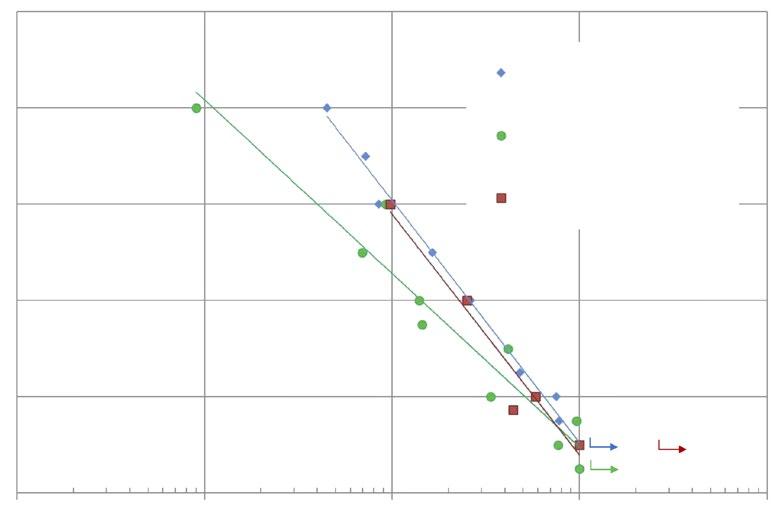
others show significantly lower fatigue resistance. This is a typical sign of irregularly occurring defects of different locations, geometries and sizes. In addition to the defects between layers, Limberg identified connected pores at the surface, also originating from a non-optimal build process. As a result of this study, one can conclude that the material itself
is equivalent to MIM material, but the manufacturing quality has to be optimised in order to achieve reliable properties – a statement true for all AM technologies.
Assessing metal powder spreading behaviour for powder bed-based AM applications
Defects can also result from sources other than the Additive Manufacturing process itself. For example, it can be related to inhomogeneous distribution of powder particles. In Powder Bed Fusion processes, spreadability of the powders is an important issue. Spreadability can change from powder batch to batch, however, so a defined determination of this property is necessary. Salah Eddine Brika from École de technologie supérieure, Montréal, Canada, presented a running project on a novel testing bench of the spreading behaviour of powders, in particular aiming at PBF-LB machines [15].

Brika started his talk with a general description of the spreading process, which takes 30-50% of the total build time. The powder itself determines the rheological behaviour, the characteristics of the resulting powder bed and the spreading forces. Thus, the goal was both to determine the spreadability of a given powder and to develop a guideline for the selection of suitable powders. This guideline is intended to be adaptable to any given powder, if the relationships mentioned are known.
The powder bed should have maximum density, the best uniformity and spreading forces should be minimal. Brika listed a number of techniques for flowability characterisation of a powder, most of which already boast standards. While there are also established powder spreadability testers, the problem is that in-situ investigations inside of typical Additive Manufacturing machines are difficult because of their closed architecture and harsh environment. Furthermore, there is a lack of characterisation methods
to determine simultaneously the aforementioned metrics of powder bed density, uniformity and spreading forces. Thus, Brika developed a versatile testing bench for assessment of these parameters, while the controlled variables are layer thickness, spreading speed, powder characteristics (e.g., size distribution and morphology) and the delivery system characteristics (type, material, etc). The proposed design of the test bench – replicating the coating elements of a PBF-LB machine – is shown in Fig. 17.
In order to monitor the necessary metrics, the test bench is equipped with load cells under the build plate as a weighing system to measure the powder bed density, an imaging system to assess the powder bed uniformity and a torque sensor connected to the recoater arm to determine the spreading forces. Some details in the construction avoid influence of friction on the load cells. Determination of powder bed uniformity is done via a photometric stereo method.
Currently, the first case study is in progress, with very promising results. As an example, Fig. 18 shows the resulting powder bed density in relation to recoating speed for three different layer thicknesses. It can be seen clearly that the dependence of density on recoating speed increases with increasing layer thickness. At the end of his talk, Brika pointed out that other sub-systems could be added like a gas shielding chamber, different spreading mechanism types and blade shapes, heating units and thermal sensors, etc.
Small batch atomisation of specialised spherical Ti-based powders
Ti-6Al-4V is well known as the most widely used titanium alloy, providing well balanced properties for most application fields. But Ti-6Al-4V, of course, isn’t appropriate in all cases (e.g., high-temperature applications). The development of novel alloys, however, is hindered by a lack of

Fig. 18 First results on powder bed density measured on the novel test bench [15]
availability of pre-alloyed powders. Blending elemental powders might be an option, but often the sintering process suffers and porosity increases. Fortunately, some powder producers offer atomisation of small batches of specialised titanium alloys for specific applications.
As one example, Karin Ratschbacher from GfE Metalle und Materialien GmbH, Germany, a subsection of AMG (Advanced Metallurgical Group), outlined the production of specialised powders for medical applications [16]. Apart from Ti-6Al-4V as a standard material, β -titanium alloys are used and under development. For these alloys
Mo, Nb and Ta are typical alloying elements, making the preparation of the alloy and its atomisation more difficult because of very different melting points. Ratschbacher applied the well-known EIGA technology and, by adjustment of the atomisation process, it was possible to adjust the particle size distribution depending on the technology applied (e.g. MIM, PBF-LB, PBF-EB) as shown in Fig. 19. If the melting points of the alloying elements are not too high, specific alloys can be produced using Induction Skull Melting (ISM) for casting of smaller rods as shown in Fig. 20. For titanium combined with components of higher melting
“Beta-titanium alloys are especially interesting for biomedical applications because they can consist of exclusively biocompatible alloying elements like Ti, Nb and Zr. In contrast, Al and V in the Ti-6Al-4V are known to induce possible negative effects on the human body.”
points – like Ti-Mo-Zr-Fe – powder can be produced through a Powder Metallurgical feedstock production route or via a three-step process involving electron beam melting, ISM and EIGA.
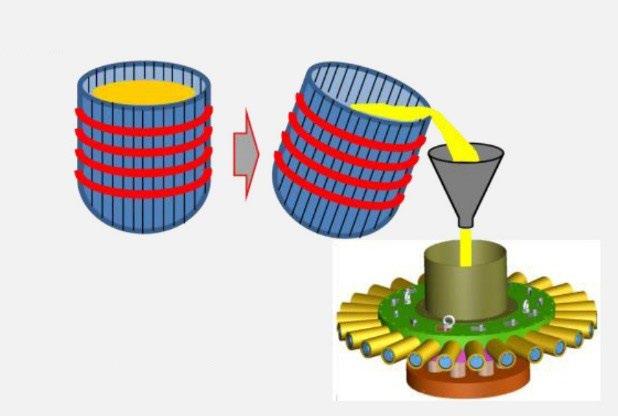
Fatigue behaviour and failure mechanisms of MIM beta titanium alloys
β -titanium alloys are especially interesting for biomedical applications because they can consist of
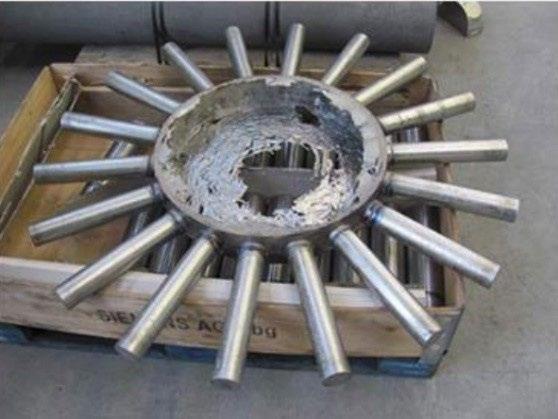
exclusively biocompatible alloying elements like Ti, Nb and Zr. In contrast, Al and V in the Ti-6Al-4V are known to induce possible negative effects on the human body. A study on a comparison between β -titanium alloys and α / β -alloys with respect to the effect of defects on the mechanical properties of MIM produced specimens was presented by the author of this review [17].
At the beginning of my talk, I emphasised the importance of fatigue behaviour, as it is estimated that fatigue accounts for 90% of mechan -
ical engineering failures. Past work on the effect of porosity and contamination by oxygen and carbon on the fatigue resistance of α / β alloys like Ti-6Al-4V and Ti-6Al-7Nb was presented. In this alloy class, a clear decrease of fatigue endurance limit with increasing oxygen content can be observed, while residual porosity plays a minor role compared to grain size. Grain refinement improves the endurance limit significantly in Ti-6Al-4V. The question of the study presented in Montréal was how β -alloys compare with these results
Bearing strength of TiC
C: 600 µ g/g TiC: 0.55%
C: 1670 µ g/g TiC: 2.14%

β Ti-Nb-Zr (O: 3900 µ g/g)
α-β Ti-64 (O: 1900 µ g/g)
α-β Ti-67 (O: 1500 µ g/g)
with respect to the typical three MIM defects: residual porosity, impurities and coarse microstructure.
For this investigation, a Ti20Nb10Zr alloy was formed by blending spherical gas atomised powders and processing them via MIM. Cuboids with a size of 44 x 5 x 3 mm were produced for a four-point bending test as fatigue specimens and shot-peened with zirconia beads after sintering to avoid surface cracks. I pointed out that more than 90% of the fatigue lifespan is taken up at the crack initiation stage, while crack propagation is comparably fast. Thus, the goal of development of a fatigue resistant titanium alloy is to hinder crack initiation.
Microstructural investigations revealed that in β- titanium alloys porosity appears to play the major role for crack initiation, in contrast to the findings in α / β -alloys. On the other hand, oxygen appears beneficial: in β- titanium alloys oxygen increases the strength without significantly deteriorating the ductility. The role of carbon remained unclear within the study that I reported on. Because of rather low carbon solubility of the β phase, the Ti-20Nb-10Zr formed carbides; a high amount of carbides can lead to a bimodal behaviour of the fatigue curves at high stress levels (Fig. 21), connected to a
possible fracture of the carbides. The endurance limit, however, appeared not to be influenced.
In summary, the study discovered a rather complex mechanism of crack initiation consisting of an interplay of pores, fishbone-like alpha platelets at grain boundaries and titanium carbides. However, with respect to grain size and impurity, the fatigue behaviour of β -titanium alloys appears to be more robust than α / β alloys. Fig. 22 shows the measured fatigue curve in comparison of Ti-6Al-4V and Ti-6Al-7Nb and Ti-20Nb10Zr. Although grain size and oxygen content were much higher, the Ti-20Nb-10Zr alloy shows a significantly higher fatigue resistance.
The potential of eutectoid β stabilising elements to develop new PMTi alloy compositions
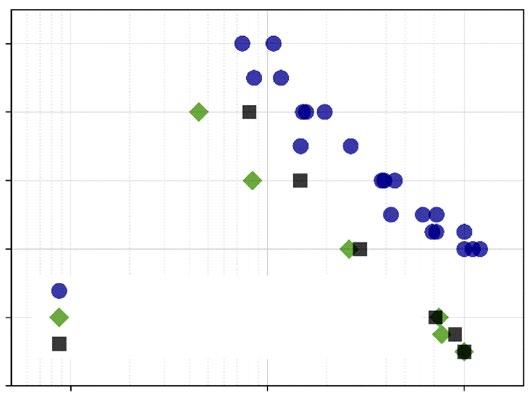
At earlier PMTi meetings, Leandro Bolzoni from the University of Waikato, New Zealand, presented studies on low-cost α / β -titanium alloys. In Montréal, he reported on an investigation on alloy systems of the form Ti-2X-2Z, where ‘X’ means an isomorphous β -stabilising alloying element (e.g., Nb) and ‘Z’, a eutectoid one (e.g., Cu, Mn or Fe) [18]. In
doing so, Bolzoni tried to combine both effects in order to minimise the necessary amount of alloying elements – and the rather expensive Nb in particular.
As before, Bolzoni applied the blended elemental approach, mixed the powders in the desired ratio, compacted them by uniaxial pressing with 600 MPa and finally sintered under vacuum at 1300°C for 2 h with subsequent furnace cooling. He characterised all specimens by XRD and microscopy, as well as hardness and tensile testing, and determined density, porosity and densification. Alloy compositions of Ti-2Nb-2Cu, Ti-2Nb-2Mn, Ti-2Nb-2Fe, Ti-2Fe-2Cu and Ti-2Fe-2Mn were chosen and compared with unalloyed Ti, with powder shape ranging from spherical to irregular.
Bolzoni observed some general rules related to the alloying elements and their effect on densification: Generally, Nb hinders densification, while Fe and Mn favour it. Moreover, within the Nb-based alloys, Cu shows the lowest positive effect on densification and Fe the highest. Within the Fe-based alloys, Nb revealed the weakest effect and Mn the strongest. In all cases, XRD detected no intermetallic phases. In

addition, Cu-bearing alloys revealed no β -phase by XRD, though this was visible in the micrographs as part of a lamellar α / β structure. Generally, in Nb-based alloys, the lamellae were refined by the additional alloying elements in the order Cu->Fe->Mn, while in Fe-based types the order of
effect was Cu->Nb->Mn. Bolzoni emphasised that the classification of the alloys according to the Molybdenum-Equivalent approach did not match the microstructural results in all cases, and that this theory needs more specificity to be able to take into account the
effect of the processing conditions (i.e., cooling rate). Mostly, the alloys of the Ti-2X-2Z type can be classified as near- α or α / β alloys. The mechanical properties tend to show higher strength and ductility compared to cast Ti-xCu and wrought Ti-xNb alloys. This is probably due to the finer microstructure of the Ti-2X-2Z alloys and the strengthening effect of the additional alloying elements.
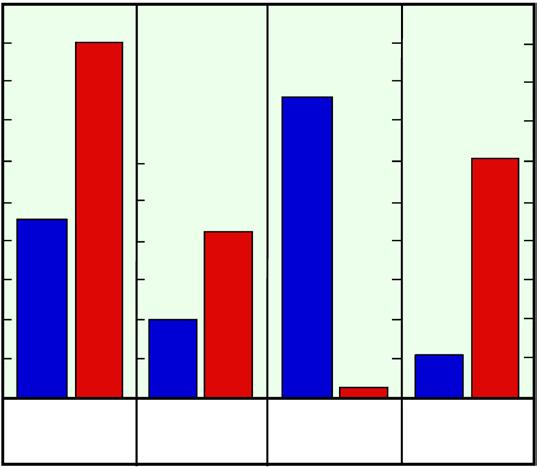
The evolution of automotive applications for powder-based titanium processes
A very comprehensive talk on development of Ti alloys was given by Tadahiko Furuta from Toyota Central R&D Labs. Inc. (TCRDL), Japan, focusing on the alloys’ application in the automobile sector [19]. TCRDL has a long history in this field; indeed, they already use special Ti materials for motor valves in passenger cars and motorbikes. Here, high performance in combination with low costs is essential, and the approach of using blended elemental powders to fabricate TiMMCs (Metal Matrix Composites) was successfully followed.
Interface
・Reactivity
Particle
・High resistance particle
・Disordered structure
・Mutual solubility
・Crystal matching
・Interface resistance Matrix
・Defectivestructure by removing elements
・High strength
・High rigidity
・High resistance(Non-periodic by a solid solution atom)
・High strength, ・Toughness
Motor valves require a high Young’s modulus of the material, high wear resistance, as well as excellent fatigue and creep properties at elevated temperatures. Furuta described the development process, starting with the choice of reinforcement particles. From a few different materials like TiC, TiN, SiC, B4C and others, he selected TiB as the best candidate because of its high Young’s modulus and hardness, a coefficient of linear expansion close to that of titanium and excellent stability in Ti alloys. Fabrication started with blending TiH 2 and 16% of Al-25Sn-25Zr-6Nb6Mo-1.2Si, resulting in the alloy Ti-6Al-4Sn-4Zr-1Nb-1Mo-0.2Si-0.3O during sintering. TiB 2 powder was added to this mixture, compacted
and vacuum sintered at 1300°C. During this process TiH 2 and TiB 2 react, forming TiB particles. The sintered billets were hot worked by extrusion and forging and final upsetting to shape the valve. Subsequent heat treatment, machining and coating led to the finished product. A further variant of development was the alloy Ti-6Al-4V-2Mo-1Fe, reinforced by 20 vol.% TiB.
TEM examinations revealed the excellent atomic bonding between the beta phase and the TiB particle, resulting in high mechanical properties at elevated temperatures. Fig. 23 shows the general improvement of the fatigue properties of the developed β TiMMCs compared to Ti-6Al-4V. The mechanical properties of these alloys can be adjusted by heat treatments and the number of reinforcing particles. Furuta showed how the properties can be fine-tuned to the demands from application and production (e.g., with respect to durability and productivity).
Despite the excellent performance and low cost production approach for this type of TiMMCs, however, costs are still too high to make sense as a regular material for passenger vehicles.
Furuta also presented a second titanium alloy called Gum Metal. The composition is based on the effect of dependence of the Young’s modulus on the number of alloying elements – here, of Ta, V and Nb. A minimum of this value exists at 25 mol.%, which is found experimentally, but can also be calculated based on electron theory. The lowest value of the Young’s modulus is achieved in the case of Nb, but adding further elements can increase this effect.
The purpose of Gum Metal’s creation was to develop a highstrength alloy with a low Young’s modulus. As production method, the same blended elemental approach was used as for the TiMMCs, though with an additional cold working step after hot working.
After cold working, a non-linear elastic behaviour could be observed; this led to a high elastic strain like 2.5% in the case of a Ti-23Nb-0.7Ta-2.0Zr1.2O alloy. This alloy has a YS around 1000 MPa. Furuta showed that the amount of oxygen is essential to control this elastic behaviour: if the O content is too low, strain is high, but strength is very low. If the concentration of oxygen is too high, linear elastic behaviour is visible. Highresolution TEM investigations revealed that recoverable localised shear deformation is the basic underlying mechanism which is highly dependent on the number of oxygen atoms. The effective deformation ranges from nanometres to millimetres in Gum Metal. Application of this alloy span from highly flexible spectacle frames, screws and bolts with anti-loosening effect to orthodontics.
Furuta closed his talk with some general remarks about new titanium alloys for the automobile sector, including those which feature a level of electrical resistance in order to reduce eddy current losses. He summarised the possible approaches for alloy development as shown in Fig. 24. His talk illustrated how important it is to connect experimental evidence with theoretical knowledge.
Development of highstrength Ti alloys based on the composite approach
The development of high-strength titanium alloys based on the composite approach was also presented by Yong Liu from Central South University in Changsha, China [20]. In the beginning of his presentation, he pointed out one disadvantage of common MMCs using ceramic particles as reinforcement: common loss in ductility and risk of bonding failure between ceramics and metal matrix. In contrast, Liu’s approach was influenced by the well-known Damascus steel, which consists of a hard and a soft metal phase kneaded together and results in excellent strength and ductility.
Thus, the idea presented by Liu was to focus on strengthening via a heterogeneous structural mixture of at least two metallic phases with a high density of interfaces. To generate such structures, any possible diffusion of the alloying elements must be kept low to avoid homogenisation. Therefore, Liu chiefly applied methods like SPS and hot working, thereby minimising the processing temperature.
One example he gave was the fabrication of a Ti-Ta composite using the blended elemental approach. Because Ta diffuses slowly, only 2 μ m powder was used. The powder mixture was

“Furuta showed that the amount of oxygen is essential to control this elastic behaviour: if the O content is too low, strain is high, but strength is very low. If the concentration of oxygen is too high, linear elastic behaviour is visible.”
processed by SPS at 1200°C for 30 min, hot rolled at 700°C and finally annealed at 600°C for 30 min. The result was a very fine (< 100 nm) laminate-structured Ta-rich zone with nanoscale precipitates in the Ti-rich zone. In addition, slight diffusion occurred between these two zones.
After annealing, the UTS achieved was 1210 MPa and elongation to fracture was 20% – excellent properties.
A second example presented by Liu was a TiMo composite fabricated by blending Ti, 40Al60V and Mo powders, Cold Isostatic Pressing (CIP) at 200 MPa, sintering at 1200°C for 2 h and final hot swaging at 950°C. The result was a compositional gradient in the microstructure, causing inhomogeneous precipitation of α -phase as visible in Fig. 25. The Mo-enriched zone consists of β -phase, the
Ti-enriched zones feature α and β The resulting strength of this composite was very high, with a UTS of 1634 MPa. The elongation was 8%, which is a an acceptable value for most applications and significantly better than for alloys with comparable strength.
In the second half of his talk, Liu discussed the underlying physical mechanisms for strengthening based on the example of the Ti-Ta composites. It is quite obvious that a combination of strengthening factors such as the solid solution, grain boundary, dislocation and precipitation is responsible for the high UTS and YS values. However, when Liu applied the classical strengthening models, summing up all single contributions, the calculated YS value was about 200 MPa lower than the measured one. Liu suggested this missing contribution to be attributed to the HeterogeneousDeformation-Induced (HDI) strengthening effect. This effect results from the interface between the soft Ta and the hard Ti-enriched phases.
After a tension load is applied, the dislocation density in the Ta-rich zone is higher than in the Ti-rich zone. This effect is even enhanced by the rolling process introducing more additional dislocations in the Ta-rich regions due to the higher strain gradient caused by existing nanoprecipitates. Interestingly, as an in-situ tensile test on nano-machined pillars of the different zones showed, the soft Ta-rich zone is strengthened by the HDI effect to values similar to the strength of the Ti-rich zone.

Liu tried to calculate the HDI induced strength on the basis of a traditional back stress model, but failed; the calculated value was much too high compared to the 200 MPa difference assessed experimentally. Thus, he developed a new model considering the residual plastic strain energy. As experimental input, the result of a loading - unloading - loop tensile test is suitable. With this updated model, the results of the experimentation can be visualised in Fig. 26.
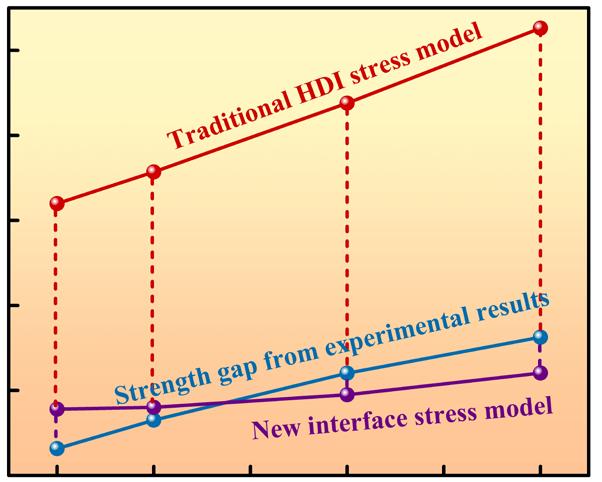
Conclusion
To conclude, the PMTi2022 conference proved that there is still high interest in titanium – and as many questions remain open as ever. Will viable novel solutions become cost effective? Will the importance of alloy development grow beyond thermomechanical processing? Will standards hinder the development of application-specific AM alloys?
Regarding that last point, there was an interesting podium discussion organised during the conference on the question of whether it is actually necessary to fulfil the chemical requirements of standards if the mechanical ones are achieved perfectly well – in particular, this is an issue with oxygen content. There was no clear result of the discussion – too many aspects have to be considered – but this discussion could be the start of a fundamental change in standards.
To date, many different manufacturing techniques exist, and the processing of the same raw material can lead to identical high mechanical properties even if microstructure and impurity content differ. Should there actually be a standard for each technique, or is there a different way of handling this situation? Maybe this discussion will be concluded at PMTi2023 – or maybe not. Attend the conference at the University Carlos III in Madrid, Spain, in the first week of September to be part of the conversation!
Author Dr Thomas Ebel Helmholtz-Zentrum Hereon Powder-Based Materials Development Institute of Metallic Biomaterials GeesthachtGermany
thomas.ebel@hereon.de www.hereon.de
References
[1] Zhigang Zak Fang, A Holistic approach to Low-Cost Titanium
[2] Muktesh Paliwal et al., HDH Ti-6Al-4V Alloy for Laser Powder Bed Fusion
[3] Gang Chen et al., Cost Down and Lean Design of High- Performance CP-Ti Via Additive Manufacturing
[4] Chengshang Zhou et al., Improving Densities of Titanium Alloys Using Constrained Hydrogenation Assisted Densification (CHAD) Method
[5] Efraín Carreño-Morelli, Powder Metallurgy of Titanium-Nickel Alloys: An Overview
[6] Paul Sheffield et al., Evaluation of Nitinol Produced via Multiple PM Forming Routes
[7] Carlos Romero et al., Opportunities of Powder Metallurgy Titanium in the Hydrogen Technologies: The Case of Bipolar Plates

[8] Robert Swenson, Titanium Metal Injection Molding and 3D Binderjet Printing
[9] Christian Doblin et al., Comparative assessment of wrought & PM Ti-6242 (Ti-6Al-2Sn4Zr-2Mo-0.8Si) alloy rods fabricated using cold spray, hot isostatic pressing, and spark plasma sintering
[10] Alex Finch, Cold Spray Additive Manufacturing: Breakthrough Performance and Economics in Titanium Additive Manufacturing
[11] Shannon Clemens, Examination of Cold Rolling and Annealing Processes for Ti-6Al-4V and Ti-5Al2.5Fe Roll Compacted Strips
[12] Matthias Scharvogel, Scaling Sinter Based 3D Printing Technologies for Titanium and Its Alloys
[13] Johannes Schaper, Sinter Based Additive Manufacturing of Titanium, Binder, and Processing Technology
[14] Wolfgang Limberg et al., Comparison of Fatigue Properties of Ti- 6Al-4V, Processed by Metal Injection Molding and Fused Granular Fabrication
[15] Salah Eddine Brika et al., A Novel Testing Bench for the Assessment of Metal Powder Spreading Behavior for Powder Bed-Based AM Applications
[16] Karin Ratschbacher, Production Routes for Specialized, Spherical, Biocompatible Ti-Based Powders
[17] Thomas Ebel, Fatigue Behavior and Failure Mechanisms of MetalInjection-Molded Beta Titanium Alloys
[18] Leandro Bolzoni, On the potential of Eutectoid β Stabilizing Elements to Develop New PM Ti Alloy Compositions
[19] Tadahiko Furuta, Titanium Products via Powder Metallurgy Process
[20] Yong Liu et al., Mechanical Behavior of Heterogeneous Ti MetalMetal Composites
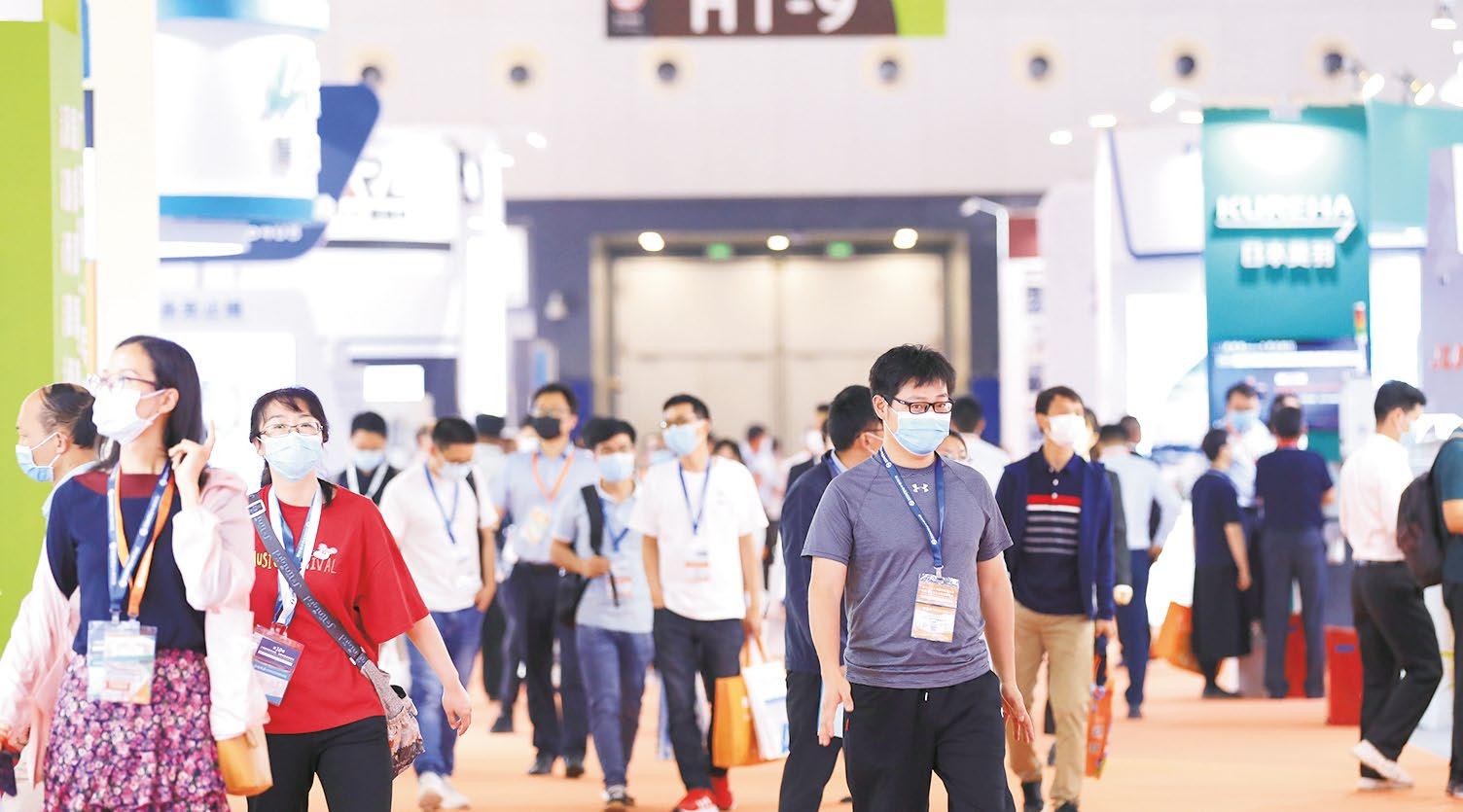

Opening the door to MIM parts: A case study on the conversion of die cast door hinges
Die casting is a widely used process for the production of Metal Injection
Moulding-sized parts, but its application is typically for components with lower strength requirements. When the mechanical performance specifications for a die cast component increase, opportunities arise for alternative processes such as MIM to step in. In this case study, Ecrimesa's Manuel Caballero reviews such a conversion process in which a zinc die cast hinge set is redesigned for production by MIM in 316L stainless steel in order to significantly improve mechanical properties.

Founded in 1964 in Santander, Spain, the family-owned Ecrimesa Group began life as an industrial casting foundry. The name Ecrimesa is a compound of the Spanish Electro Crisol Metal S.A., translating as ‘Electric Metal Melting Crucible.’
The company was originally established for the production of steel and aluminium investment castings, but by 1994, Metal Injection Moulding was being developed at the location using the world's first MIM-Master continuous furnaces for catalytic debinding and sintering, in collaboration with feedstock supplier BASF SE and the furnace's manufacturer, Cremer Thermoprozessanlagen GmbH. MIM now comprises a major portion of the group’s offering.
By 1997, Ecrimesa’s MIM operation had gown to such an extent that the company’s management took the decision to establish the independent company Mimecrisa, which would be responsible for the group’s MIM production facilities and workforce.
In 2005, Ecrimesa Group bought out one of its machining suppliers in order to increase the added value of its production in investment casting
and MIM. In summer 2015, this machining plant was moved to its own building.
Today, Ecrimesa is comprised of three companies: its investment casting segment, Ecrimesa; the MIM company Mimecrisa; and machining company Mecansa. The companies are located across seven loca -
tions in Santander, on the northern Spanish coast. The three companies work closely together, benefitting from one another’s capabilities and expertise; for example, the tool shop at Ecrimesa provides toolmaking and tool maintenance services to Mimecrisa, along with access to its metallurgical and measuring

labs, while Mecansa carries out finishing operations for Ecrimesa and Mimecrisa as required, and both Mimecrisa and Mecansa make use of Ecrimesa’s heat treatment facilities.
Converting a die cast part to MIM: a case study
In many instances, a design developed for a conventional manufacturing process may be better suited for production by MIM. For example, a part previously produced by plastic injection moulding or die casting may no longer offer the required strength as the demands of the application increase. In cases such as these, Mimecrisa is able to offer increased value to the customer and increase MIM’s market share by employing its expertise to transition suitable parts made by competing technologies to MIM.
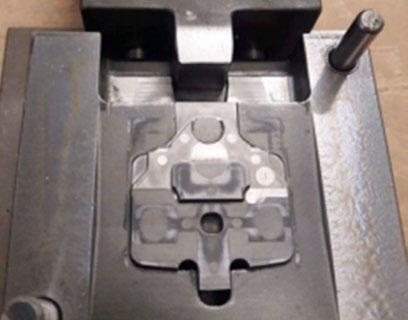
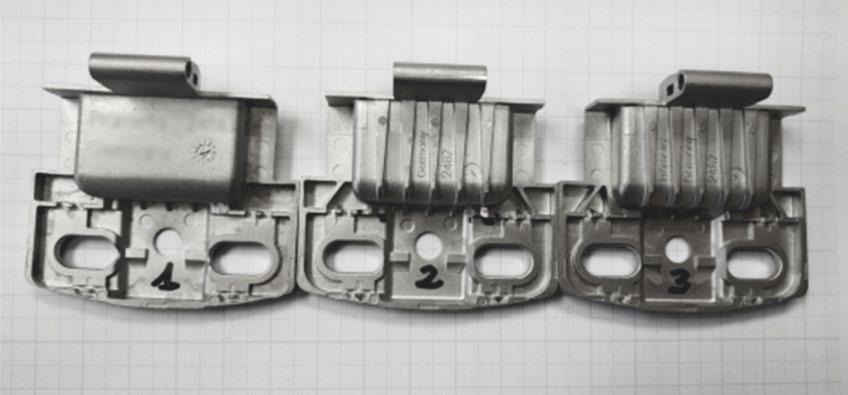
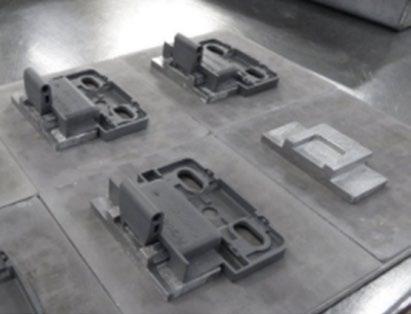
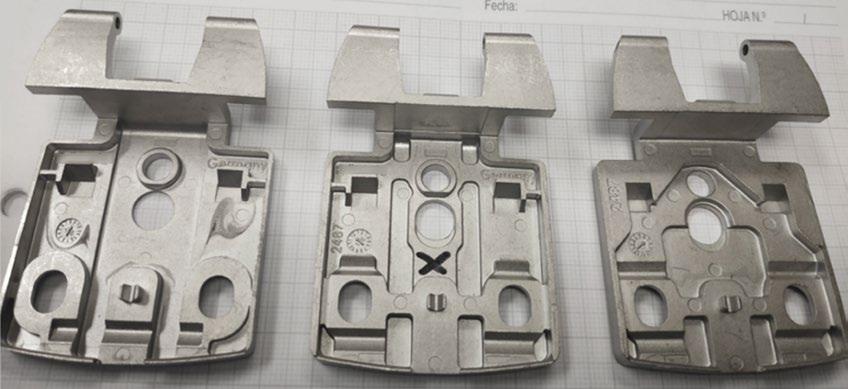
In this case study, Mimecrisa was tasked with transitioning a pair of door hinges from die casting to MIM. These corrosion-resistant hinges were originally manufactured from a zinc alloy. For safety reasons, the hinges must be able to open at up to 270° and, for cosmetic reasons, they need to be polished to a mirror finish.
For higher-weight glass doors requiring a stronger hinge, a stainless steel version was developed for production by MIM (Figs. 2 and 3). A number of changes were made to adapt the design to MIM, focusing on the internal faces of the parts, which would not be visible to the user. These hinges are at the upper range of MIM’s size capabilities, with a typical weight of 50–80 g, and have very thin walls with a large surface area.
Both the customer and Mimecrisa knew when this product was highlighted for transitioning to MIM that some work would be needed to optimise the part for the MIM process. Initially, the lack of obvious injection points was a particular challenge. Another consideration in the design's adaption was the addition

of ribs in place of some of the thin walls featured in the original design in order to lightweight the component and reduce material costs.
For better shape retention during sintering, the parts were produced using feedstock based on 316L master alloy powder. After considering the results of mechanical and dimensional trials on the first sintered samples with the customer, MIM moulds were modified in house to meet the part specifications. Throughout this process, cosmetic and assembly limitations were identified and noted for the next modification of the MIM parts.
The first versions of the MIM part that were injected and sintered showed some flow lines as a result of high binder levels. Some changes were needed following this first trial run to improve feedstock flow and avoid phase demixing, mainly at the injection areas with thin walls. Penetrant tests, used internally at Ecrimesa as a process control step during development, identified porosity areas in the first iteration of the part due to demixing and sintering deformation, pointing to the need to improve the strength of the green part using some additional ribs and extra wall thickness (Fig. 4).
The external face of the part was not changed during these modifications. The first iteration, with a 4 g weight increase from the original part, was good enough to be functional, but the customer ultimately preferred a bigger fatigue margin. The final iteration, taking into account the necessary changes, saw a weight increase of 2 g, necessary to avoid defects in the thin walls, increasing the fatigue life of the product whilst remaining compatible with the hinge’s function.
Some preliminary ceramic setters were also used to support the green part during sintering (Fig. 5). Coining – the final operation to ensure flatness – was carried out on internally developed coining devices (Fig. 6). This step is necessary, even if sintering setters are optimised, to achieve narrow
Overview of MIM production at Mimecrisa
Mimecrisa’s MIM plant operates fourteen injection moulding machines of different sizes, most of them electrical; four continuous MIM-Master debinding and sintering furnaces; and two batch vacuum furnaces and CIM furnaces. The facility also includes a fully equipped metallurgical and dimensional laboratory, and the principles of LEAN manufacturing and Industry 4.0 are evident throughout the business’s workflows.
Almost exclusively commercially available feedstocks, designed for catalytic debinding, are used, avoiding the need to invest in and maintain equipment for feedstock preparation, or the specific knowledge and expertise that goes along with this. All incoming feedstock deliveries are checked for compliance with specifications in the company’s materials laboratory, where chemical composition is analysed and standard samples are used to determine shrinkage. Differential thermal analysis equipment is also used to analyse binder decomposition rates and the amount of binder in the feedstock.
The production floorspace at Mimecrisa is about 6,000 m 2 , staffed by around fifty employees, and all injection moulding machines are equipped with pick-and-place systems, some robotic. Using these pick-andplace systems, green parts are transferred to trays that fit into sinter boxes specifically designed for MIM-Master furnaces, meaning that green parts do not have to be handled until they exit the sintering furnace. In some cases, parts are placed on specially shaped ceramic supports, or setters, for improved dimensional stability. These supports are manufactured in-house.
The typical sintering conditions in Mimecrisa’s furnaces are
suited to low-alloy steels, lowcarbon FN08, low-alloy steel with elevated carbon 4605, 42CrMo4, 100Cr6, 17-4 PH and 316L stainless steel. A large proportion of its products are made from heat treated steels that require a higher carbon content; the production of these carbonaceous sintered steels poses a special challenge for many MIM manufacturers, as these materials require very precise control of the sintering atmosphere. In many cases, components made from these materials are hardened and tempered following sintering – an area in which Mimecrisa has a large deal of experience. Three carburising furnaces are available for case hardening and quenchand-temper heat treatments, with fine-tuned programs for MIM materials and small parts.

In 2020, Ecrimesa added Additive Manufacturing to its available technologies, enabling customers to manufacture wax prototypes for investment casting with short lead times, or additively manufacture parts using Fused Deposition Modelling (FDM), a form of Material Extrusion (MEX). The resulting parts can be sintered in Ecrimesa furnaces.
In 2021, in response to increasing demand for its MIM parts, the group invested €2 million in the commissioning of a new continuous MIM production line as part of its 2021/22 investment plan, to include a new continuous debinding and sintering furnace from Cremer, and injection moulding machines from Arburg, bringing its total installed MIM capacity to fourteen machines across four continuous lines and two vacuum sintering lines. The new line was scheduled to go into operation in the first quarter of 2022 and would allow Mimecrisa to process over 250 tons of MIM feedstock per year.
Choosing between MIM and investment casting
Ecrimesa is one of the few companies to be able to offer its customers a choice of between investment casting, machining and MIM. This brings the opportunity to truly find the best process for an application, or to offer a wider choice of solutions as a part's specifications evolve.
Compared to investment casting, which represents one of the oldest applied metal forming processes, Metal Injection Moulding is a relatively new technology, first commercialised in the 1980s and seeing wider adoption in the 1990s. To this day, investment casting is still one of the most widely used precision forming technologies, with MIM remaining far less known and, where it is applied, primarily being used for the manufacture of small parts.
Both technologies are applied to manufacture small parts that are generally more complex in design and, therefore, processes such as forging cannot be used. One of the main differences between investment casting and MIM is the range of materials that can be processed. In general, investment casting allows for a wider variety of materials, as the MIM process can only be performed with alloys of a higher melting temperature. Materials such as aluminium, for example, do not work efficiently with MIM.
Aside from the choice of materials you want to work with, the decision between investment casting and MIM depends on other primary factors: the size of the part, the complexity of the part and the tolerances required, as well as the number of parts you want to manufacture. The ideal part for the MIM process has a length of less than 100 mm and is produced in batches of more than 5,000 pieces.
In general, most parts with a final weight of less than 15 g produced by Ecrimesa are –depending on the material – produced by MIM, since this technology allows thinner structures and is more material and energy efficient. However, there are still designers who, even for smaller parts, have a preference for investment casting.
Traditionally, 90% of parts weighing more than 100 g at Ecrimesa Group are manufactured by investment casting, since, at that size, the cost of the fine powders used in the MIM process is high, as well as the energy/ time required to sinter them. However, due to the experience the group has accumulated in MIM, and the performance of the materials used, more and more parts weighing more than 100 g are being produced by MIM. The supply of the tooling required for MIM has also improved, allowing the technology to be used in wider range of cases. There are, of course, limits: using investment casting, parts weighing up to 25 kg can be produced, whereas, with MIM, the maximum realistic weight of a part is around 250 g.
Finally, there are some additional criteria for deciding between investment casting and MIM. In general, it can be said that the development and production process of new parts is shorter with MIM, since there is no obligation to make multiple moulds and prototypes before starting production, which may be necessary when working with investment casting. In addition, the part design that a user begins with in the MIM process is generally closer to the final part, and machining processes are saved. Typically, parts manufactured by MIM have a very high surface quality without the need for finishing processes.
tolerances and avoid machining. Ecrimesa’s experience, gained from investment casting, helped the team to develop this coining device in house.
While the original parts weighed around 100 g, and the MIM part close to 130 g, the cosmetic and mechanical properties achieved by transition to MIM allowed the customer to bring the product to higher quality markets. By cooperating closely with the customer, Mimecrisa was able to bring together the part’s necessary functionality with the required expertise in designing for MIM, and achieve the common goals of both parties. Where customer requirements can be fully agreed upon during the design phase, time to market and iteration cost can be reduced compared to collaboration carried out during the sampling process. The final assembled hinge set is shown in Fig. 7.
Conclusions and future opportunities
In this case study, a part produced via die casting, typically produced with low-melting point alloys, was highlighted as a potential MIM candidate thanks to the customer’s need for higher mechanical and aesthetic properties. In order to transition the part successfully, a high degree of design work and process expertise was required in order to take full advantage of MIM’s capabilities and satisfy all of the customer’s requirements.
Ecrimesa Group, with facilities for both investment casting and MIM, used this expertise to fully understand the limitations and advantages of each process during the design transition, and bring this expertise to the customer. By taking advantage of the synergies between its different manufacturing capabilities, the group was able to accompany and support the customer across the full redesign and manufacturing process, from conception to finishing.
The use of Additive Manufacturing technologies for prototyping, such as metal MEX or metal Binder Jetting, is expected to help further speed up the development of such complex parts. While filament-based MEX techniques are not accurate enough to accurately replicate the finest design features, they can be of help in carrying out sintering tests prior to production. Binder Jetting can more closely match the MIM design as a
‘brown part’ with just a ‘backbone’ binder (though potential demixing or 'injection memory' issues will not be highlighted in such prototypes). In future, Ecrimesa plans to utilise these techniques for prototyping new MIM parts. Simulation techniques can also offer some capability to predict the injection path inside the mould, but some other important aspects are not covered by these techniques.
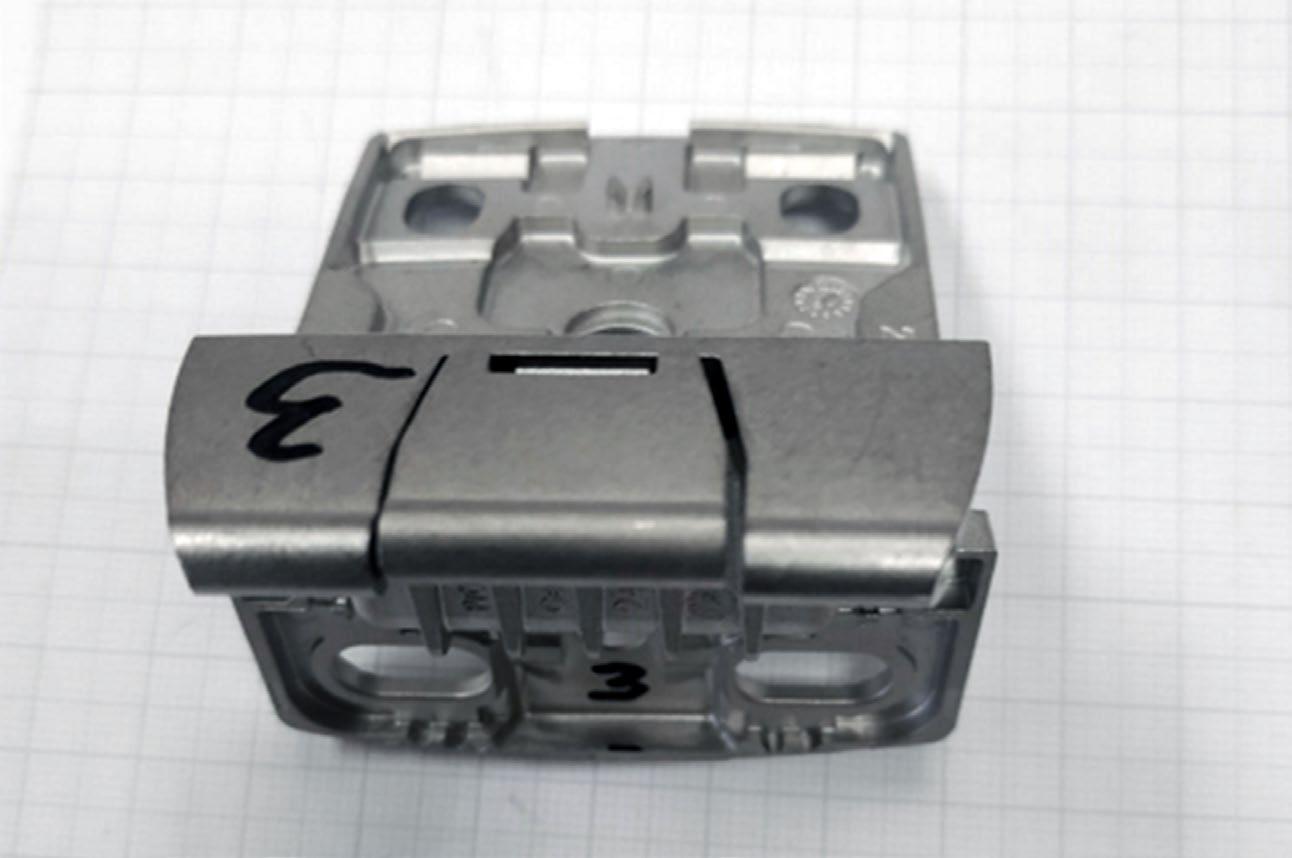
 Manuel Caballero Technical Director Ecrimesa Group Santander Spain
Manuel Caballero Technical Director Ecrimesa Group Santander Spain
mcaballero@ecrimesa.es
www.ecrimesa.es
“By taking advantage of the synergies between its different manufacturing capabilities, the group was able to accompany and support the customer across the full redesign and manufacturing process, from conception to finishing.”Fig. 7 The final assembled MIM hinge set Author and contact
www.twitter.com/PIMMagazine
www.linkedin.com/company/ piminternationalmagazine/

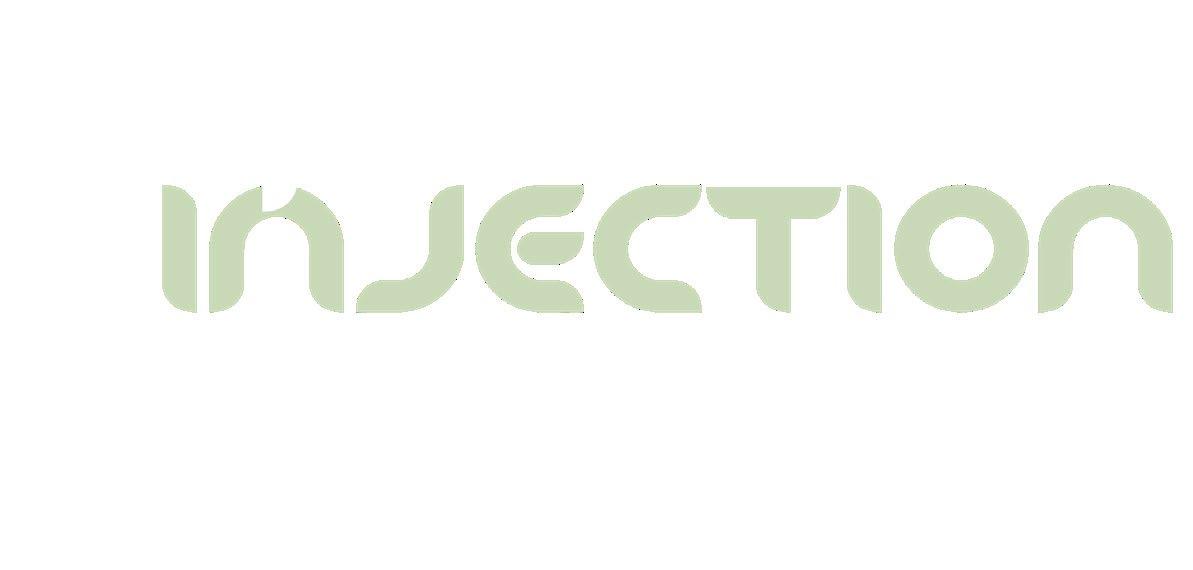


As the usage patterns of PIM International magazine’s audience develop and change, we have expanded our social media activities, enabling us to connect with our global audience on multiple levels.

COMMUNICATIONS INOVAR

Advertisers’ index & buyer’s guide

PIM International is the only business-to-business publication dedicated to reporting on the technical and commercial advances in the MIM, CIM, and sinter-based Additive Manufacturing industries.
Available in both digital and print formats, PIM International is the perfect platform to promote your company to a global audience.
Metal powders
Powder atomisers
MIM, CIM & AM parts producers
Advertise with us...
Combining digital and print publishing for maximum
PIM International is the only business-to-business publication dedicated to reporting on the technical and commercial advances in the MIM, CIM, and sinter-based metal Additive Manufacturing industries. Available in both digital and print formats, PIM International is the perfect platform to promote your company to a global audience.
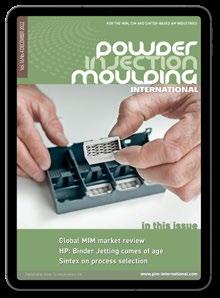
moulding
For more information contact Jon Craxford, Advertising Sales Director Tel: +44 207 1939 749 jon@inovar-communications.com

Industry events
PIM International is dedicated to driving awareness and development of the MIM, CIM and sinter-based AM industries and their related technologies. Key to this aim is our support of a range of international partner conferences. View our complete events listing on www.pim-international.com
PM China 2023
May 31–June 2, 2023
Shanghai, China
en.pmexchina.com
World Titanium Conference 2023 (Ti-2023)
June 12–16, 2023
Edinburgh, Scotland
www.iom3.org/events-awards/ world-titanium-conference-2023
PowderMet2023 / AMPM2023
June 18–21, 2023
Las Vegas, NV, USA
MIM2023
February 27–March 1, 2023
Costa Mesa, CA, USA
www.mim2023.org
PM23 International Conference on Powder Metallurgy & Particulate Materials

March 13–15, 2023
Mumbai, India
www.pmai.in
Fraunhofer Direct Digital Manufacturing Conference (DDMC)
March 15–16, 2023
Berlin, Germany
www.ddmc-fraunhofer.de
AMUG
March 19–23, 2023
Chicago, IL, USA
www.amug.com
Hannover Messe 2023
April 17–21, 2023
Hannover, Germany
www.hannovermesse.de
Ceramics Expo 2023
May 1–3, 2023
Novi, MI, USA
www.ceramicsexpousa.com
RAPID + TCT
May 2–4, 2023
Detroit, MI, USA
www.rapid3devent.com
www.powdermet2023.org / www.ampm2023.org
MAPP Second International Conference
June 28–29, 2023
Sheffield, UK
www.mapp.ac.uk/events/ mapp-2nd-international-conference
EPMA Powder Metallurgy Summer School
July 17–21, 2023
Dresden, Germany www.summerschool.epma.com
EMO Hannover 2023
September 18–23, 2023 Hannover, Germany www.deutschemesse.co.uk/emo
Euro PM2023
October 1–4, 2023
Lisbon, Portugal www.europm2023.com
Formnext
2023 2024
November 7–10, 2023
Frankfurt, Germany www.formnext.com
World PM2024
October 13–17, 2024
Yokohama, Japan
www.worldpm2024.com
Event listings and media partners
If you would like to see your CIM, MIM or sinter-based AM related event listed in this magazine and on our websites, please contact Jo Sheffield: jo@inovar-communications.com
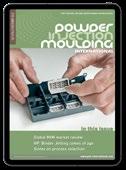
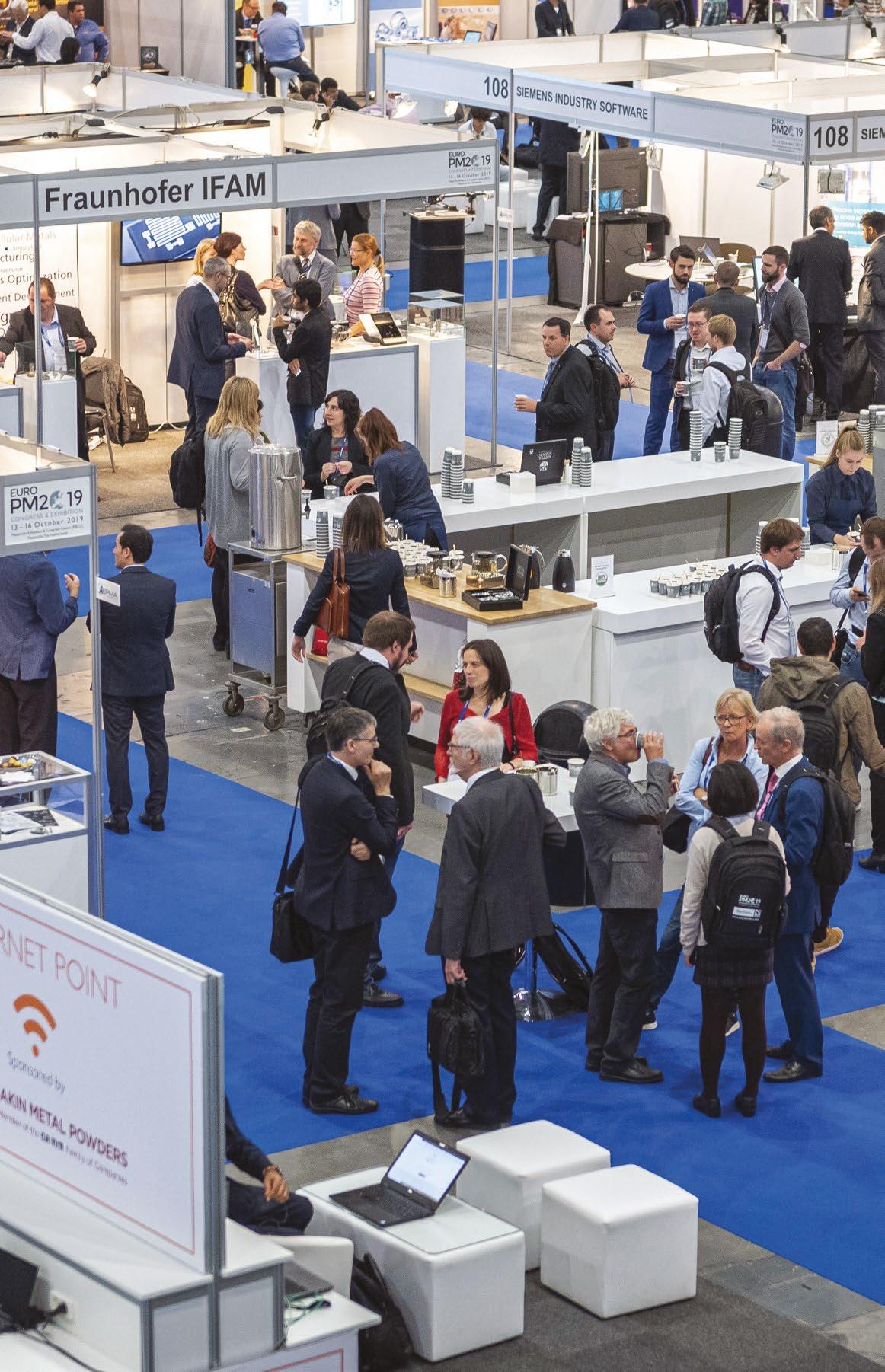
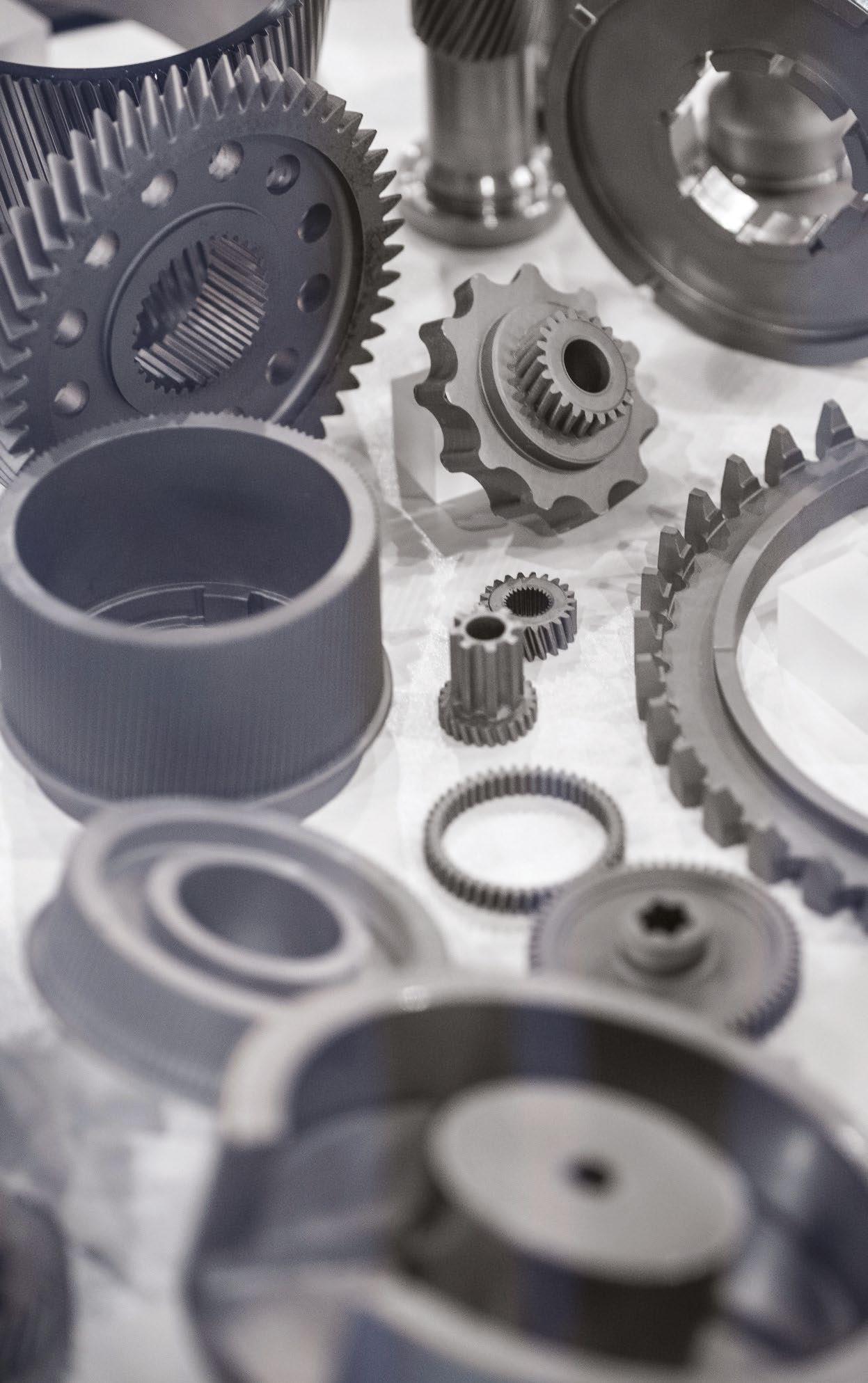
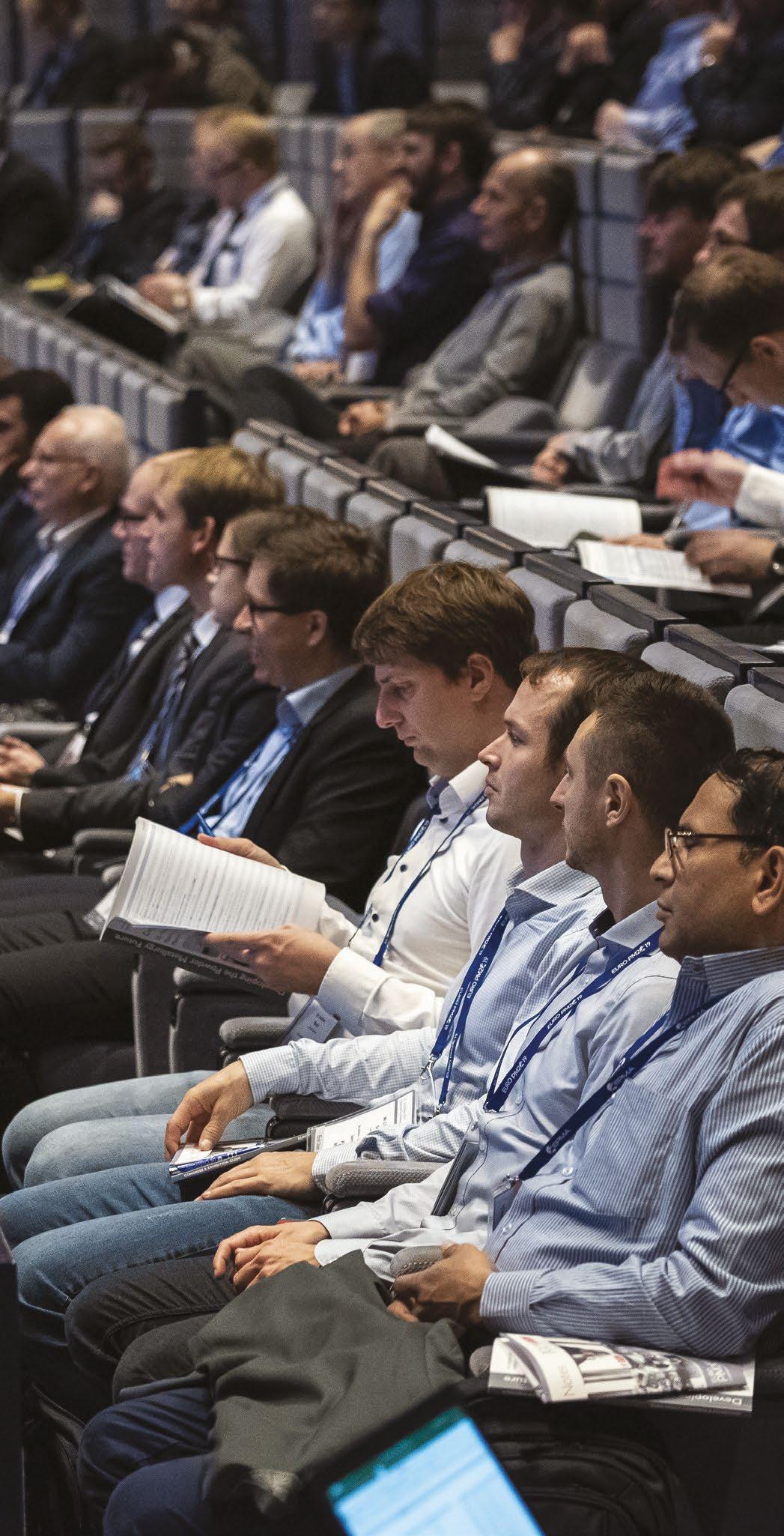


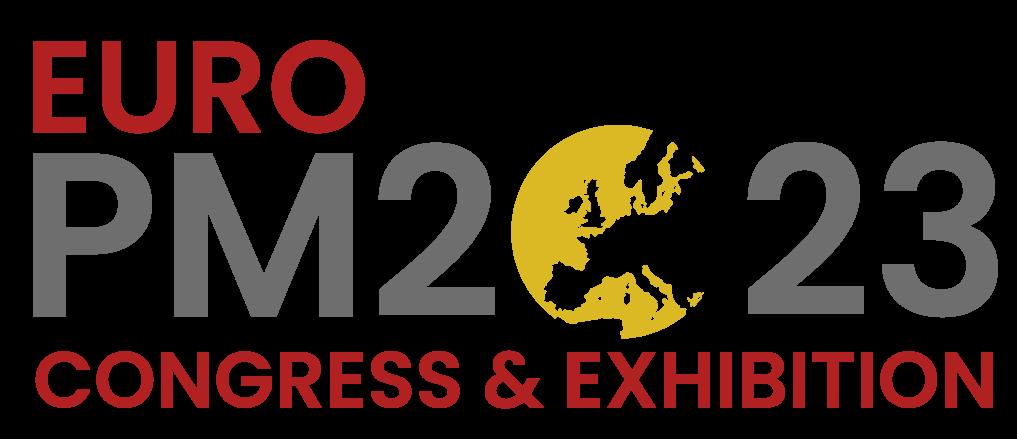


LOW-CONSUMPTION
OPERATES ELECTRICALLY

HIGHLY VERSATILE IDEAL FOR ROUTINE TASKS


SAVES MONEY AND GIVES EVERYTHING IS FAST
PERFORMS WELL
Your entry into the world of electric injection moulding: the GOLDEN ELECTRIC combines the unbeatable quality of our hydraulic GOLDEN EDITION with the efficiency of the electric drive. To the benefit of your customers and your controller.

www.arburg.com/info/pim

